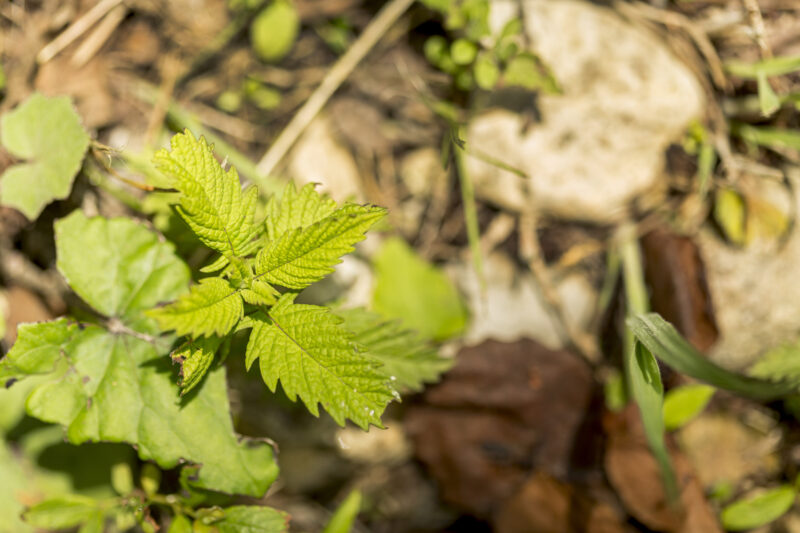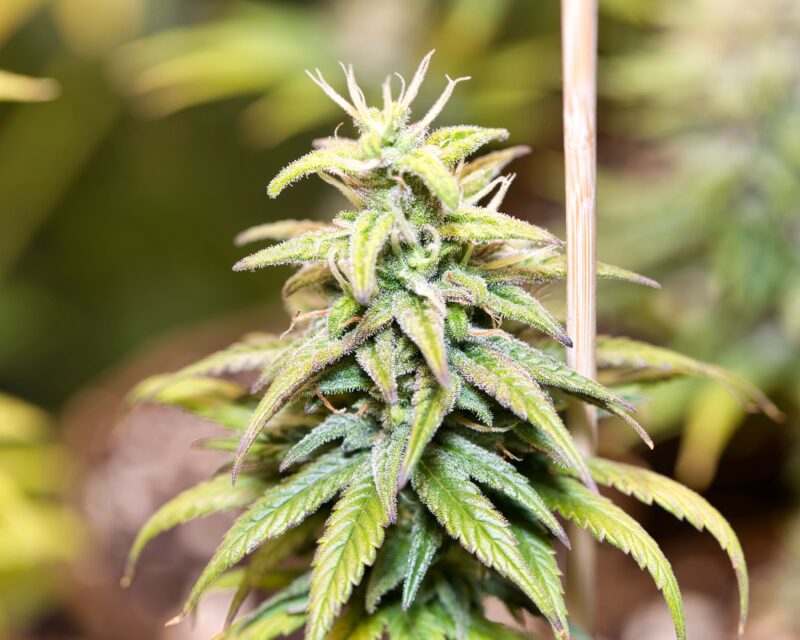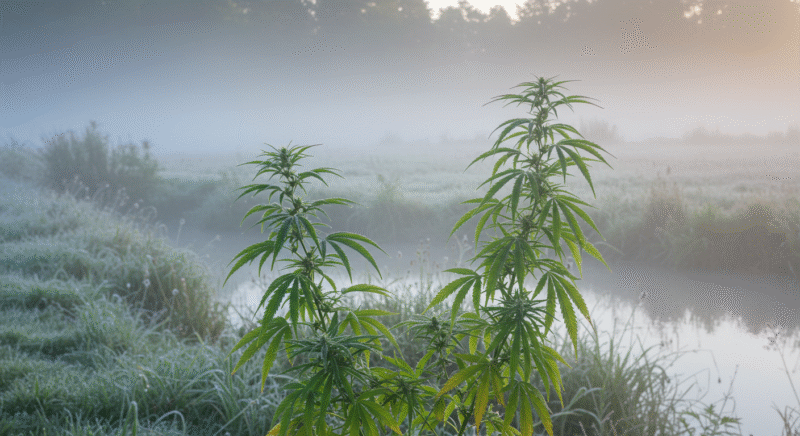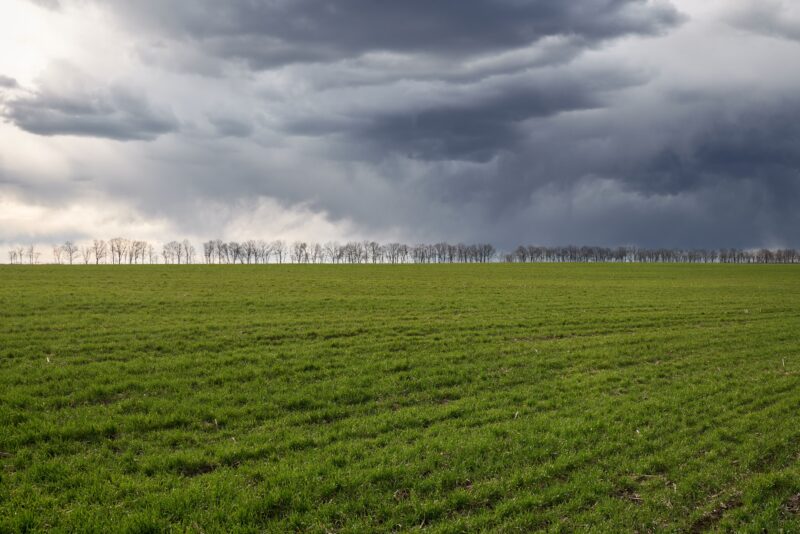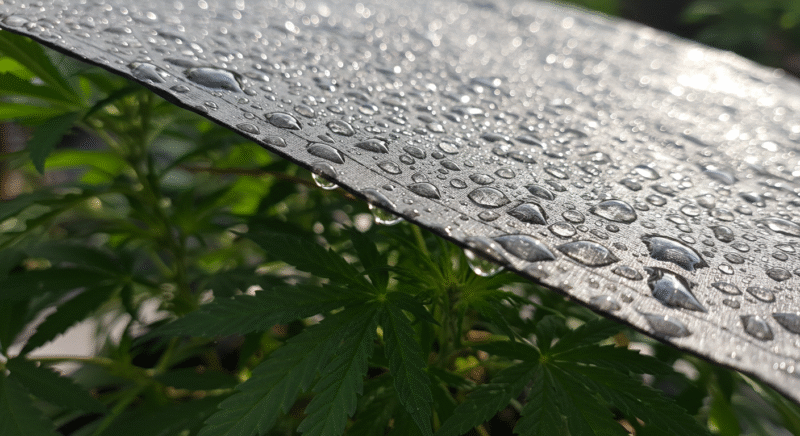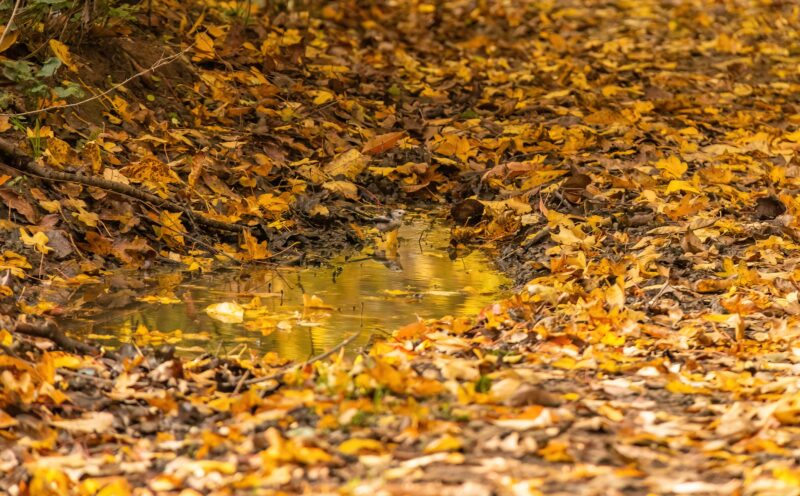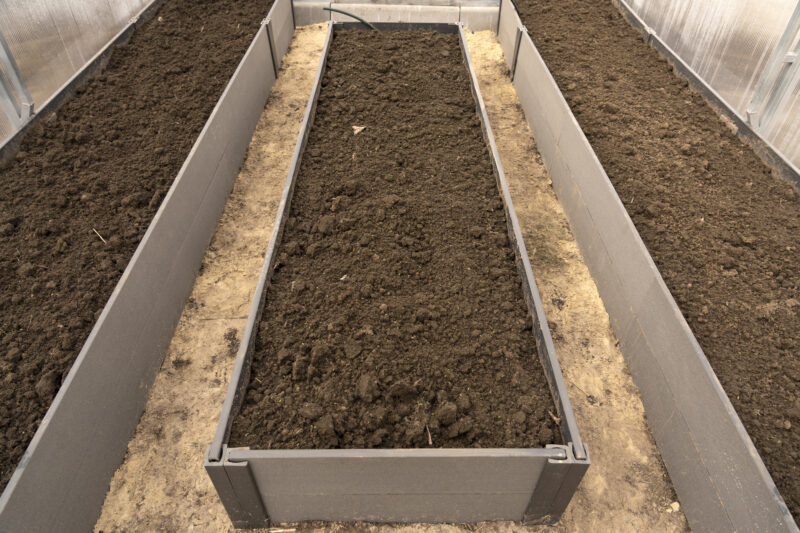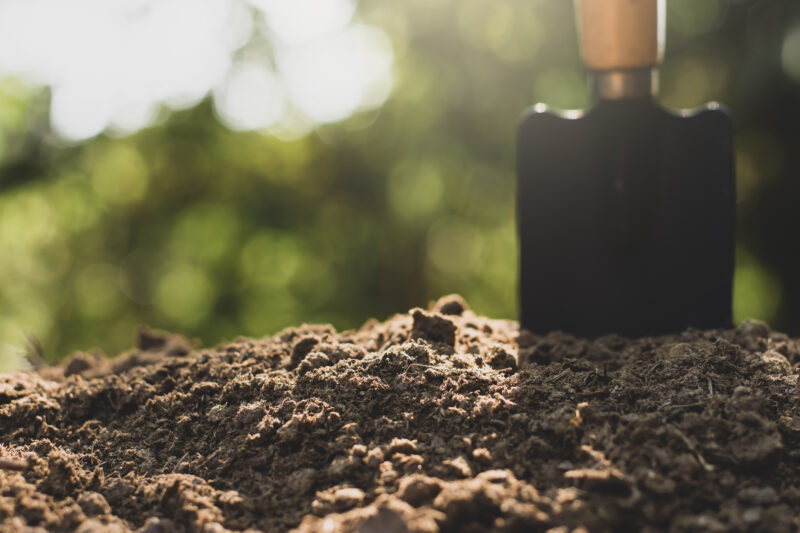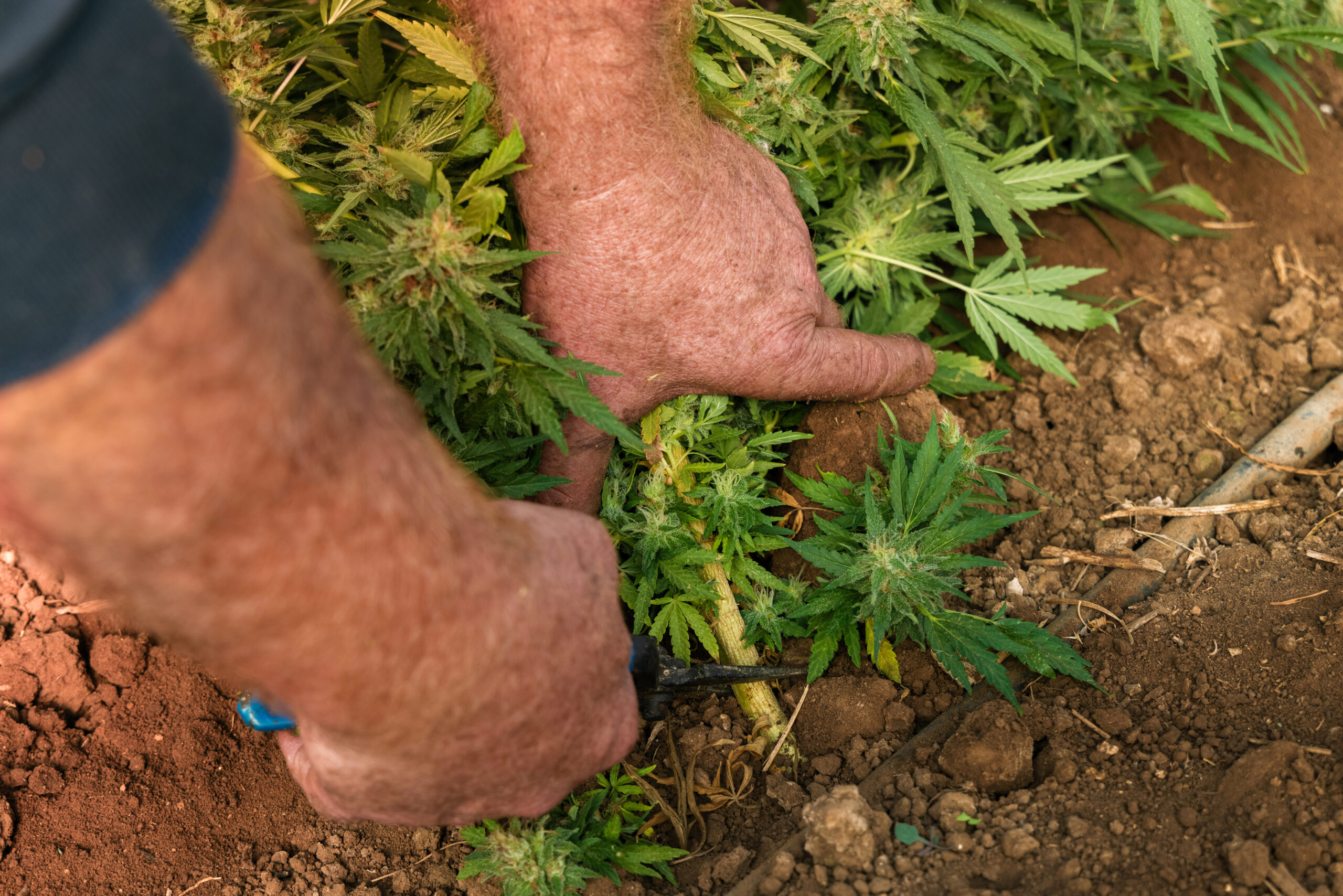- Growing Cannabis Outdoors
- Planning Your Outdoor Grow
- Choosing the Location
- Light Exposure
- Frost and Cannabis Grow Outdoors
- Humidity and Moisture: Your Allies Against Frost
- Location, Location, Location
- Soil Matters
- Plants’ Frost Tolerance
- Preparing for Frost
- Wind
- Security: Protecting Against Thieves, Animals, and Fire
- Drainage and Soil
- What is Soil Composition?
- Building the Perfect Growing Medium
- What Makes Loam Soil Ideal for Cannabis?
- Soil Types
- Preparing Your Soil Step-by-Step
- Amending Soil for Outdoor Cannabis: Creating the Perfect Growing Medium
- Why Soil Amendments Are Important
- Key Soil Amendments
- Balancing Soil pH for cannabis (6.0-7.0)
- How to Test Soil pH
- Cannabis Plant Biology: Indica, Sativa, and Hybrids
- Indica
- Sativa
- Hybrids
- Differences Between Male, Female, and Hermaphrodite Plants
- Choosing Strains Based on Climate
- Specialized Strains for Challenging Conditions
- Tips for Selecting the Right Strain for Your Garden
- THC vs. CBD in Cannabis
- THC (Tetrahydrocannabinol)
- CBD (Cannabidiol)
- Strain Selection Based on Cannabinoid Profile
- Medical vs. Recreational Purposes
- Tips for Decide Strain Selection Your Needs
- Germination and Seedling Care
- Starting Indoors
- Transitioning Your Seedlings
- Setting the Depth and Planting the Seedling
- Common Mistakes to Avoid
- The Vegetative Stage of Outdoor Grow
- Transition to the Vegetative Stage
- Importance of the Vegetative Stage
- Signs of a Healthy Vegetative Stage
- What to Monitor During the Vegetative Stage
- Maintaining Plant Health in the Vegetative Stage
- Nutrient Requirements for Vegetative Plants
- Nitrogen-Heavy Feeding Schedules
- Organic Fertilizers vs. Synthetic Fertilizers: Pros and Cons
- Pruning and Training Techniques
- The Flowering Stage
- Recognizing the Start of the Flowering Stage
- Phases of Flower Development
- Factors Influencing the Flowering Process Outdoors
- Feeding Cannabis During the Flowering Stage in Outdoor Growing
- Nutrient Transition from Vegetative to Flowering Stage
- Importance of Phosphorus and Potassium in Flowering
- Avoiding Nitrogen Late in the Flowering Stage
- Common Flowering Stage Nutrient Ratios
- Supporting Heavy Buds in Outdoor Cannabis Cultivation
- Why Support Is Essential During Flowering
- Techniques for Supporting Heavy Buds
- Harvesting Cannabis
- When to Harvest
- Harvesting Methods
- Drying and Curing Cannabis
- Drying Techniques
- The Importance of Curing Cannabis
- Troubleshooting Drying and Curing Problems
- Water
Growing Cannabis Outdoors
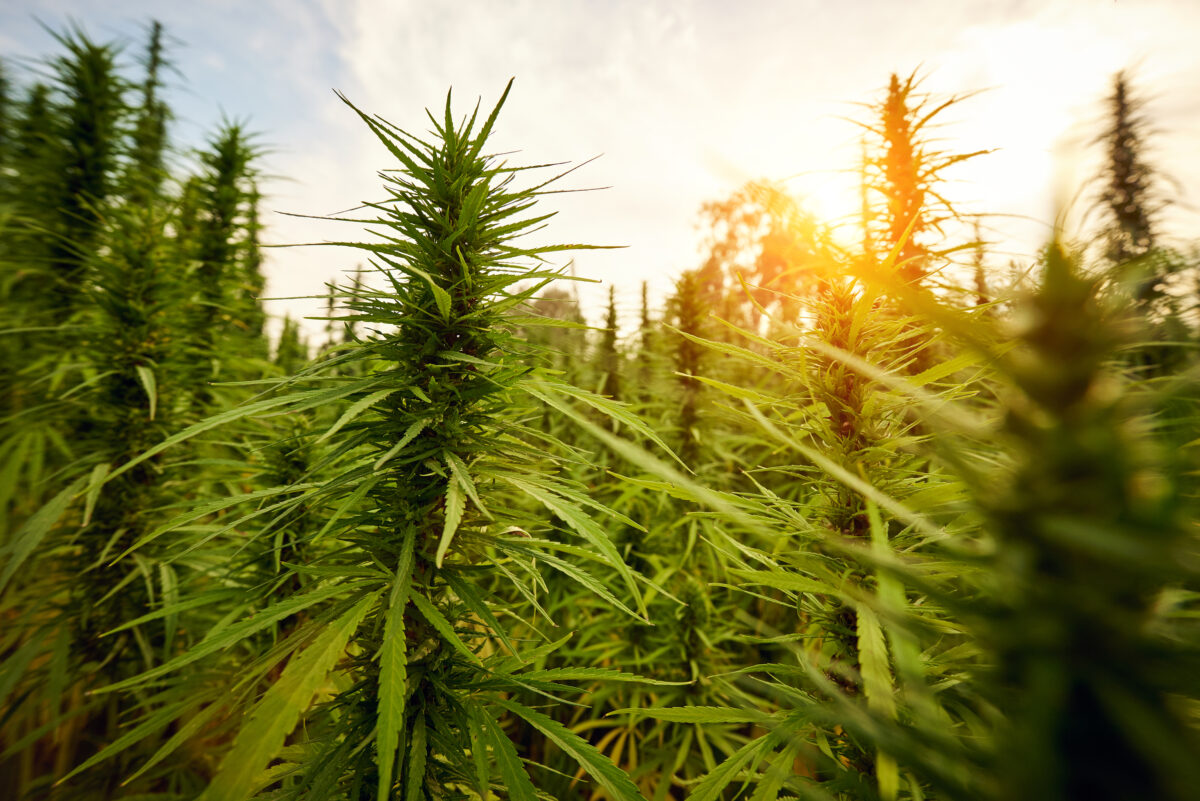
Growing marijuana outdoors can yield incredibly impressive, with some plants growing up to 20 feet tall! Outdoor cultivation lets you take advantage of natural sunlight and fresh air, which does wonders for cannabis plants. While growing outdoors comes with risks such as pests and thieves, It also offers the advantage of being much more affordable because it doesn’t require costly grow lights or ventilation systems. With a bit of planning and maintenance, outdoor grows can produce strong, robust plants.
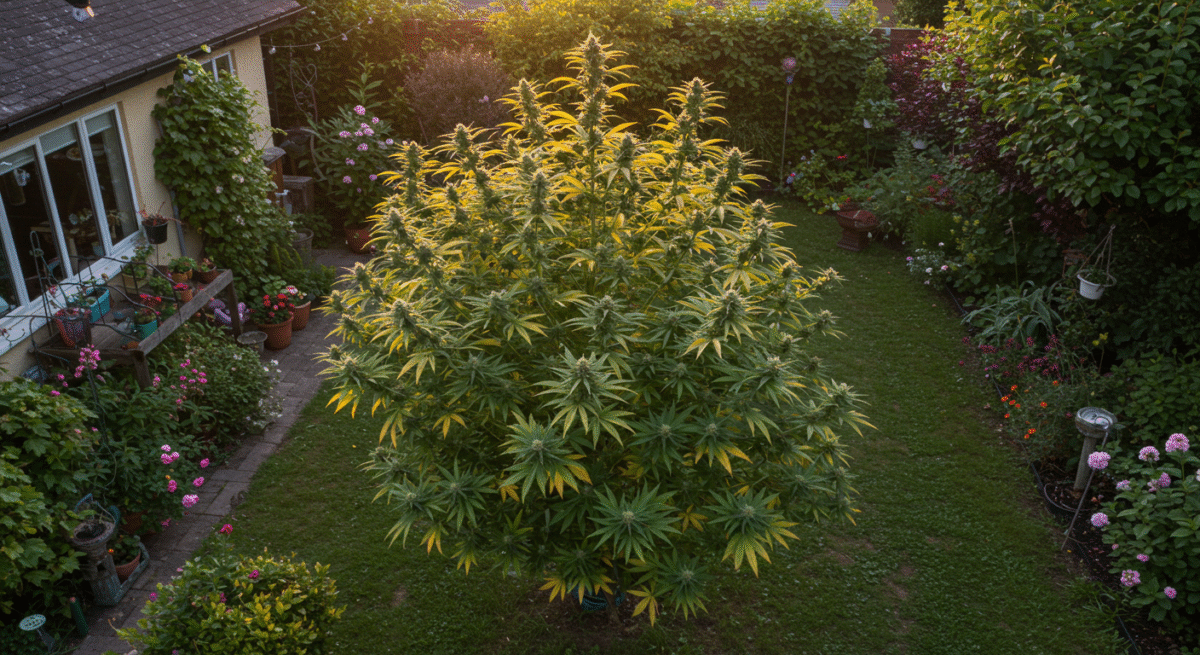
The best part of growing outdoors is the free sunlight! With no need for artificial lighting, cannabis plants can soak up full-spectrum light all day long, resulting in stronger plants and higher yields. Male plants tend to die around the 12th week of growth, while female plants can keep going for an additional 3 to 5 weeks. Mature female plants can weigh twice as much as their male counterparts; that’s why proper care and patience are key.
Outdoor plants don’t need costly ventilation systems since they naturally get all the fresh air they need. Despite this, the wild environment also means outdoor growers must be ready to face challenges like unpredictable weather, pests, and even thieves. Keeping your grow safe is a major priority, so secure your grow area well and maintain privacy.
Overview of the Cannabis Plant
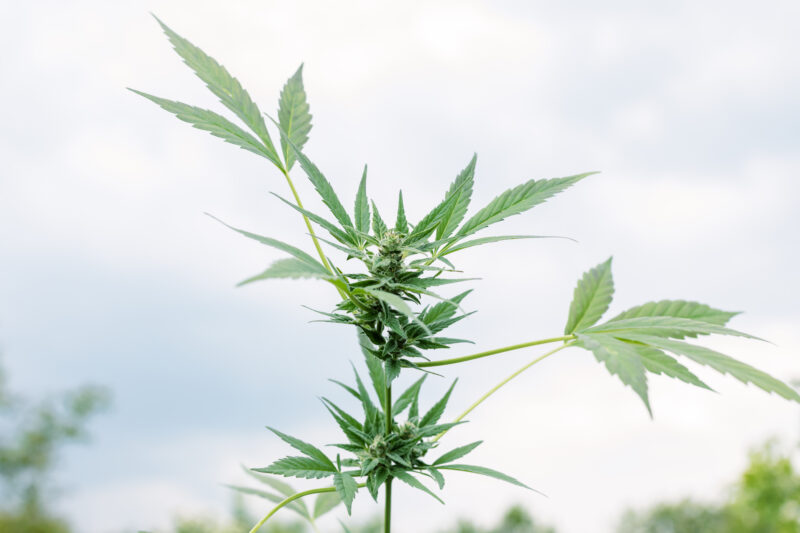
The cannabis plant is as ancient as agriculture itself. For thousands of years, humans have cultivated it for a variety of uses: medicine, fiber, food, and more recently, for its psychoactive properties. Over time, cannabis has evolved under human care, developing into a diverse family of plants with unique characteristics. To grow cannabis successfully, whether for personal use or on a larger scale, understanding its rich history, biology, and the differences between its various forms—Indica, Sativa, and hybrids—is essential.
Two Outdoor Growing Methods
There are two primary methods of outdoor growing: traditional outdoor growing and guerrilla growing. Traditional outdoor growing is when you plant on your own property, while guerrilla growing involves planting on someone else’s land or public property. Each method has its pros and cons.
1. Outdoor Growing
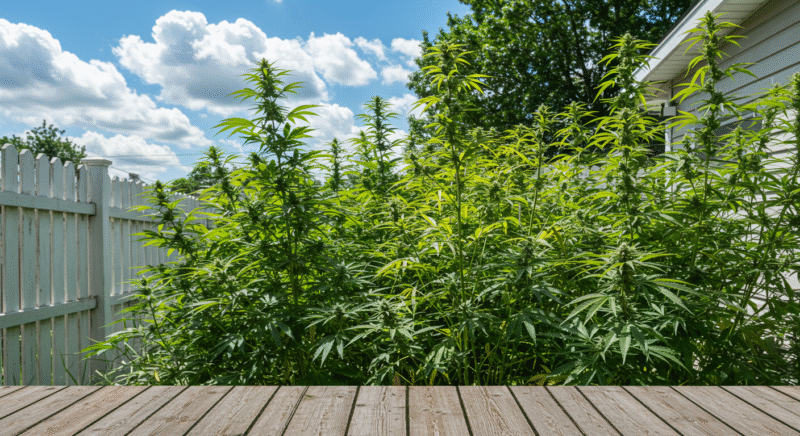
If you have access to your own plot of land, outdoor growing is the best option. It allows you to monitor and care for your plants without the hassle of sneaking around. You have full control over the environment, and the risks are lower since you won’t need to hide your activity.
2. Guerrilla Growing
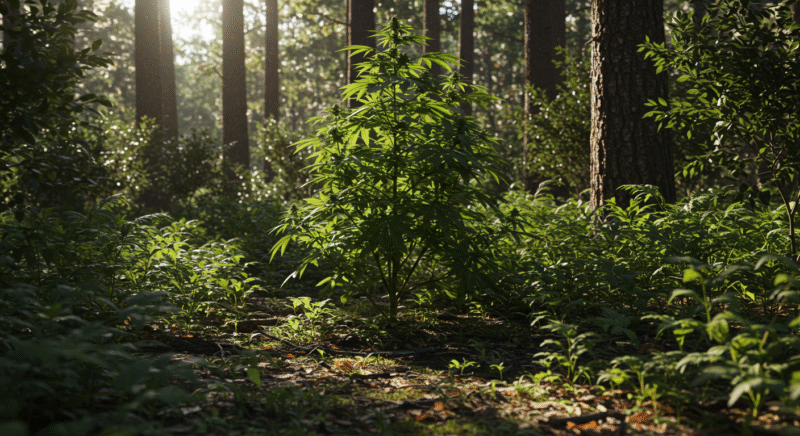
Guerrilla growing involves planting cannabis on land that isn’t yours, typically in remote and wild areas. While this method offers anonymity and reduces the risk of being tied to the plants, it comes with its own set of challenges. You’ll need to blend in with the surroundings, making it look like you’re engaging in another activity. Carrying a birdwatching book, binoculars, or fishing gear can help create a cover story if you’re spotted.
Note: If you think you can simply plant your seeds and come back in a few months to harvest, you’re mistaken. Proper maintenance is essential if you want to get the best yields from your crop.
Advantages of Growing Outdoors
Cannabis grown outdoors tends to be much stronger, largely due to the abundant light it receives. Sunlight penetrates deep into the plant, encouraging growth throughout the entire structure. This means that outdoor plants can develop uniformly from the top down, unlike indoor plants, where the lower parts of the plant often receive less light.
There’s also the advantage of not needing to worry about light leaks or high electricity bills, which can be an issue when growing indoors. With sunlight as your grow light, nature handles everything.
Risks of Outdoor Cultivation
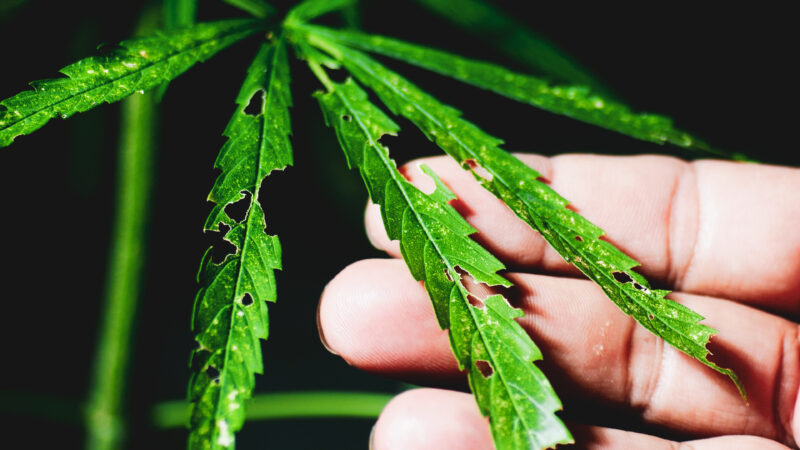
While outdoor growing has its benefits, it does come with several risks. Wildlife like deer and rodents may try to snack on your plants, while bugs can infest and destroy crops if left unchecked. Weather conditions like strong winds, heavy rain, or storms can also tear apart your plants and cause damage. These are some of the reasons many outdoor growers opt for a greenhouse or decide to grow indoors where the environment can be controlled.
Choosing the Right Seeds for Outdoors
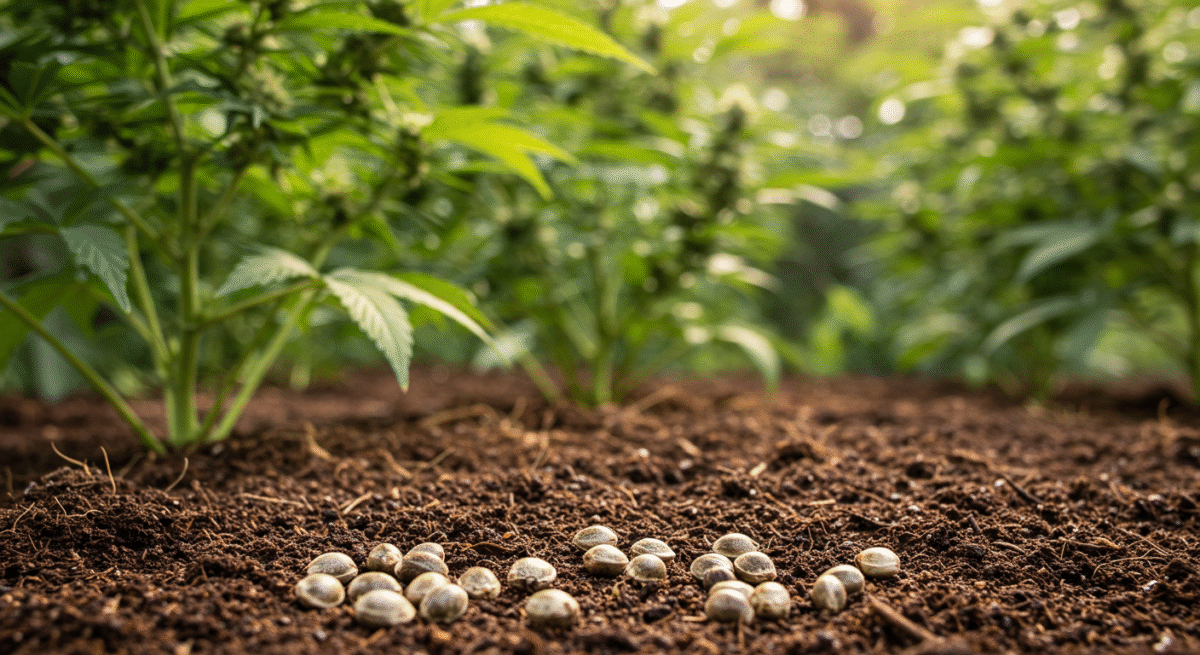
If you’re committed to growing outdoors, make sure you start with the right seeds. Outdoor strains are bred to handle difficult conditions like varying weather patterns, pests, and other challenges. High-yielding strains, especially those resistant to pests and cooler temperatures, are ideal if you plan to plant early in the season.
Experimenting with different outdoor strains during your first grow season is also smart. Try a few varieties and take notes on their growing patterns, yields, and resistance to pests and diseases. This will help you determine the best strain for your specific environment and security needs. If you’re growing in your backyard, avoid tall Sativa strains that could peek over the fence and attract unwanted attention.
Starting Seeds Indoors

For better germination success, don’t plant seeds directly into the soil. Instead, germinate them indoors using the paper towel method. Once you see white roots sprouting, transplant the seedlings into small pots and let them grow indoors until they develop at least two adult leaves. Once they’re strong enough, carefully move them outside, being mindful to avoid temperature shock from the indoor-to-outdoor transition.
Using Soil for Outdoor Growing
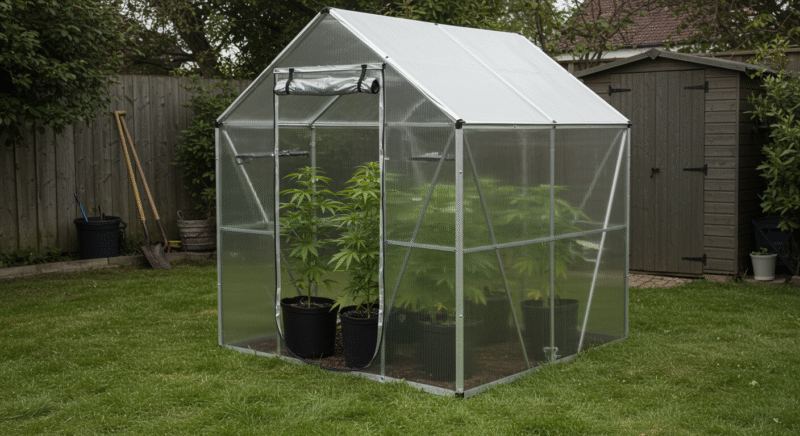
If you’re not growing in a greenhouse, soil is the best growing medium for outdoor cannabis. Hydroponic systems are less reliable in outdoor environments due to factors like evaporation and unpredictable weather, so sticking to the soil will give your plants a better chance of thriving.
Managing Your Outdoor Grow
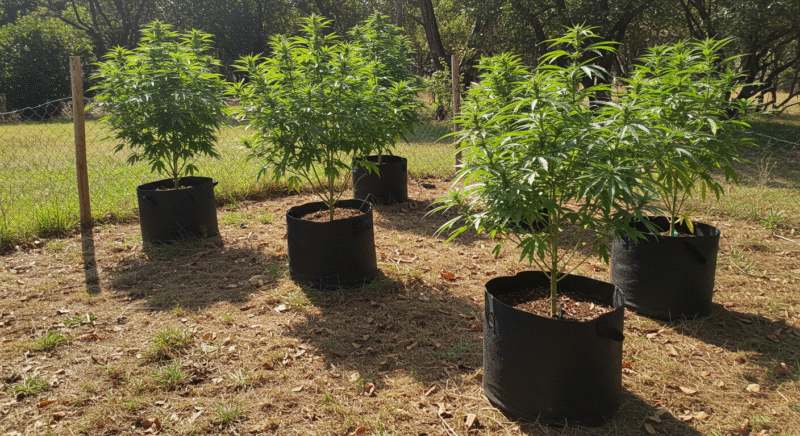
Once your plants are outdoors, regular maintenance is a must. Ideally, visit your grow site every two weeks to check on your plants, although more frequent visits may be necessary if your plants have higher water needs. Using large pots for your plants is a good idea, so you can easily move them if necessary. If you’re worried about privacy, you can dig a hole and place the pot inside to reduce the plant’s height and keep it out of sight.
A fence around your grow area is crucial to keep out larger pests like deer, and if you’re growing near a home, make sure your plants aren’t visible to neighbors or passersby.
Legal Considerations
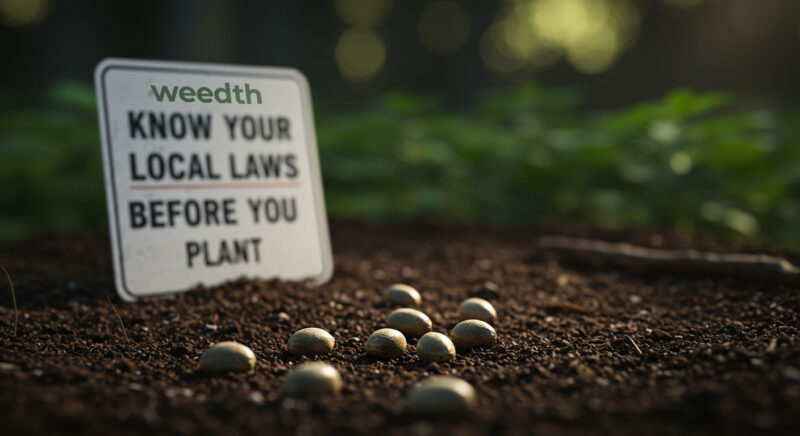
When growing cannabis especially outdoors, it is important to understand the legal landscape you’re operating in. Laws governing cannabis cultivation vary significantly from country to country, state to state, and even county to county. Depending on where you live, growing cannabis may be fully legal, decriminalized, or completely prohibited. Even in places where it is legal, there are often strict rules governing how and where you can grow. This section will guide you through the basics of understanding regional laws, responsible growing practices in legal areas, and the importance of security and privacy.
Regional Laws and Regulations

Before you even think about planting seeds, take the time to research your region’s specific laws on cannabis cultivation. While cannabis is legal for recreational or medicinal purposes in some areas, others have very strict regulations or prohibit it entirely.
In regions where cannabis cultivation is allowed, there are typically limitations on the number of plants you can grow. For example, many places only allow adults to grow a certain number of plants, often six or fewer, for personal use. Exceeding this limit can result in fines, confiscation of plants, or even criminal charges, so it’s crucial to stay within legal limits.
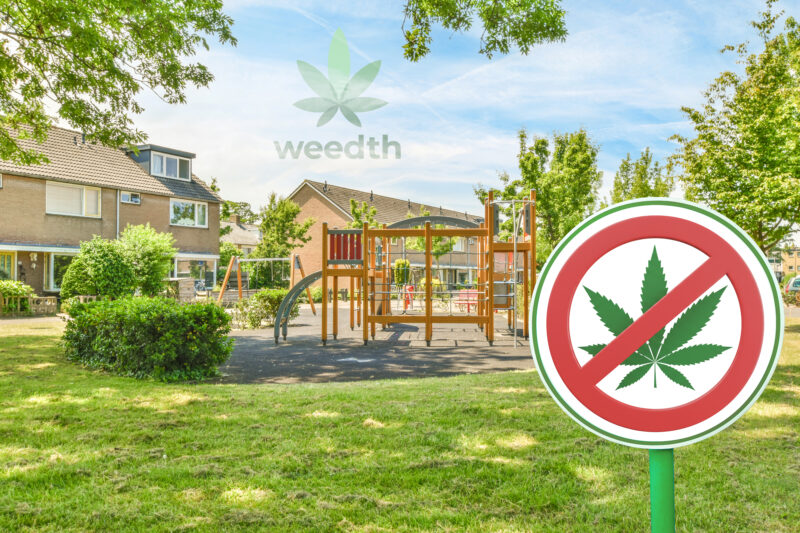
Additionally, some areas have specific zoning laws regarding where you can grow cannabis. Even if growing is legal in your country or state, you may be prohibited from cultivating plants in certain types of residential areas near schools, parks, or other public facilities. Be aware of any distance requirements and how local zoning codes may affect your grow site.
For growers in regions where cannabis cultivation is illegal or restricted, the risks are significantly higher. Cultivation in such areas can lead to severe penalties, including imprisonment. If you decide to grow in an area where it is not legal, you must weigh the potential consequences carefully and be extremely discreet in your practices.
Responsible Growing Practices in Legal Areas

Even in places where cannabis cultivation is fully legal, there is responsible growing practices are essential. Legalization comes with regulations planned to protect not just growers but also the public, the environment, and neighboring properties.
Adherence to Plant Limits: Always stay within the legal plant limits set by your jurisdiction. Keeping your plant numbers low ensures you stay within legal bounds and makes your operation easier to manage and more sustainable.
Odor Control: Cannabis plants have a strong, distinctive odor when flowering stage. In legal grow areas, you’ll still want to be respectful of your neighbors. Failing to control odors could lead to complaints, which could attract unwanted attention from law enforcement or municipal authorities. Invest in proper odor control solutions, such as carbon filters or odor-blocking compounds if you have a green house, especially for outdoor grows where the wind can carry the smell.
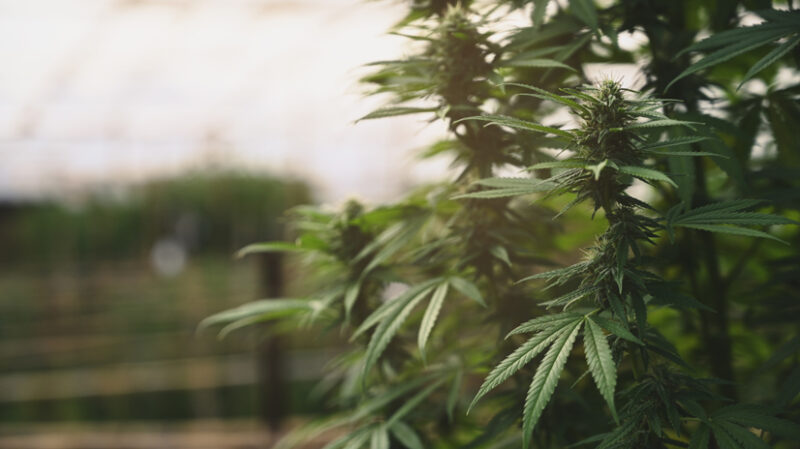
Environmental Impact: Responsible growers also take environmental considerations into account. Ensure that your growing methods are sustainable and do not harm the surrounding ecosystem. Use organic fertilizers and pest control methods to avoid chemical runoff into local water sources. In areas prone to drought, consider water-efficient growing techniques, such as drip irrigation or rainwater harvesting, to minimize your environmental footprint.
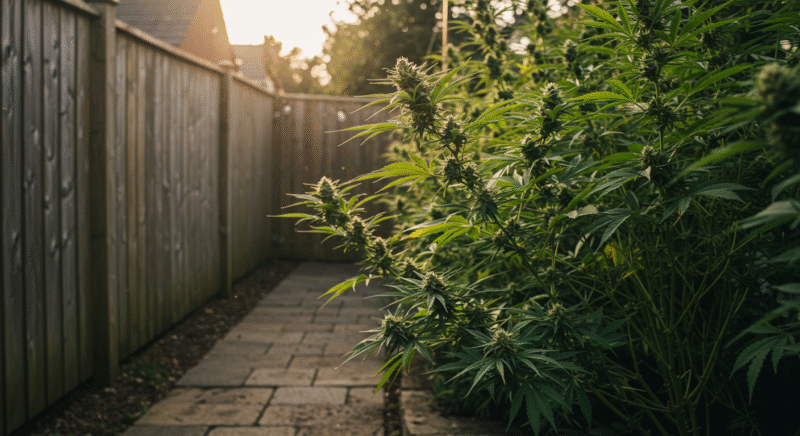
Respect for Privacy and Property: Even if you have permission to grow, keep your plants within the bounds of your own property. Overstepping onto a neighbor’s land or encroaching on public space can cause legal issues. Always ask permission if your plants are near someone else’s property, and ensure that your grow operation isn’t negatively impacting others.
Security and Privacy Concerns
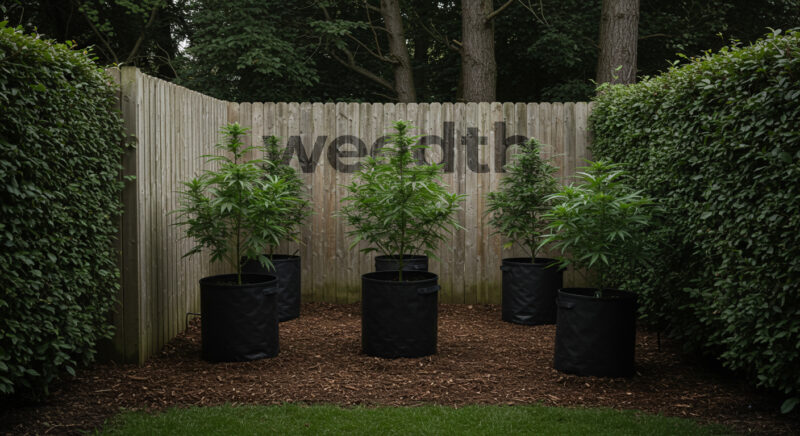
Security and privacy are important concerns. The value of cannabis plants makes them attractive to thieves, and a lack of privacy can lead to unwanted attention from both law enforcement and other people.
Physical Security: Outdoor grows are particularly vulnerable to theft. The open environment makes it easier for people to discover your plants, and if someone stumbles upon your grow operation, they may try to steal your crop. To deter theft, use fencing or natural barriers like hedges and trees to hide your plants from view. In more remote areas, game cameras or motion-activated lights can help you monitor the area without having to be physically present. If growing on private property, keep the garden hidden from street view as much as possible.
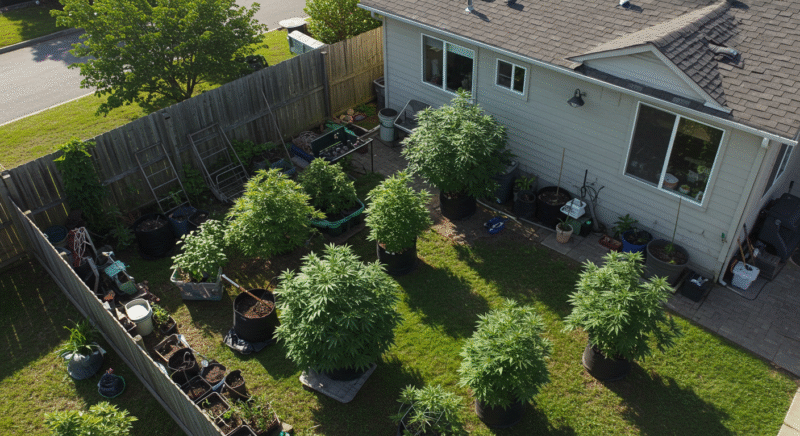
Discreet Growing Techniques: Privacy is just as important as security. Even in legal growing areas, you may not want the entire neighborhood knowing about your grow. Guerrilla growing techniques, such as planting among other vegetation or using low-visibility strains that stay short and bushy, can help conceal your crop. For backyard grows, placing plants near taller garden plants or using trellises can obscure their presence from casual onlookers.
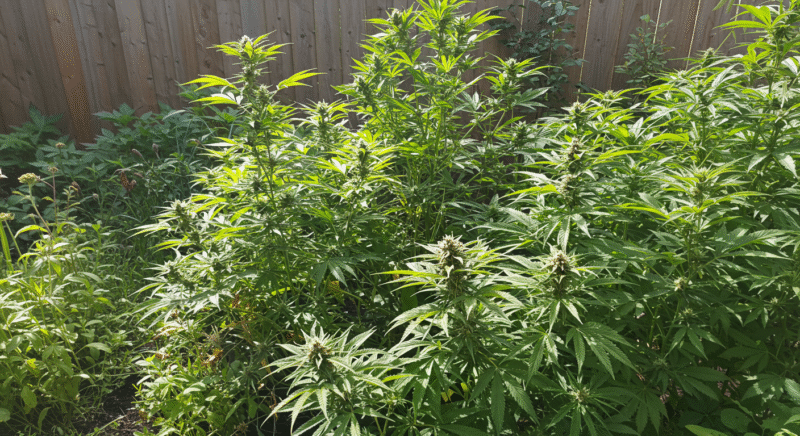
Digital Privacy: With the increasing use of technology in grow operations, maintaining digital privacy is also essential. If you’re documenting your grow on social media or other online platforms, be careful about what information you share. Avoid giving away details about the location of your grow site or showing identifiable landmarks that could reveal where your operation is. Law enforcement agencies and opportunistic thieves alike can use the internet to track down grow operations.
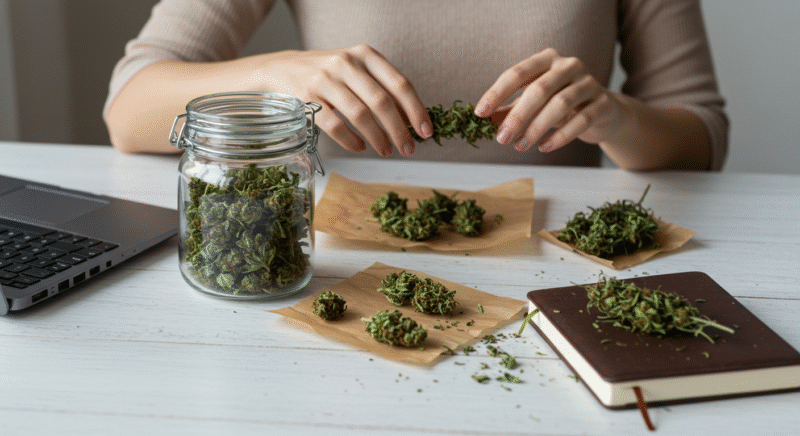
Security in Storage: Once harvested, your cannabis must also be stored securely. Many growers store dried cannabis in airtight containers, often in cool, dark spaces like basements or closets. However, it’s important to make sure these storage areas are also secure from theft. Consider investing in a lockable cabinet or safe for long-term storage, especially if you live with other people who may not be aware of your grow operation.

Security Signage and Visual Deterrents: Visible security measures can significantly reduce the likelihood of theft or unwanted intrusion into your cannabis garden. Posting signs around the perimeter of your grow area is a simple yet effective deterrent. Signs that indicate the presence of security cameras, alarms, guard dogs, or private property notices can discourage potential thieves from approaching your grow operation. Even if you don’t actually have a security camera or a dog, these signs alone often serve as psychological deterrents. For growers who prefer subtlety, discreet yet clear signs—such as "Private Property," "Protected by Surveillance," or "Guard Dog on Duty"—can provide an additional layer of protection without explicitly revealing the presence of cannabis plants. Always ensure that any signage you choose complies with local laws and regulations regarding property warnings and notifications.
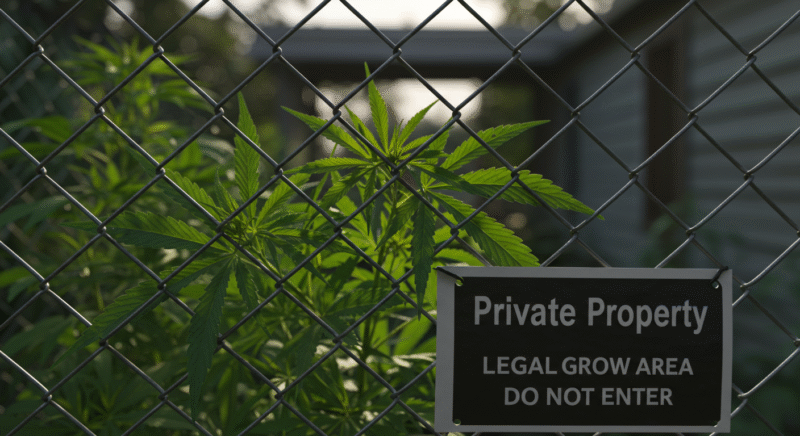
Protective Dogs as Security Measures:
In addition to signs and visual deterrents, many growers find protective dogs to be highly effective in enhancing security. Dogs are naturally alert to unusual noises or movements, providing early warning if someone approaches your grow area. Breeds traditionally known for their guarding abilities, such as German Shepherds, Rottweilers, or Dobermans, can be especially effective in deterring intruders. Beyond security, dogs can also provide companionship and peace of mind for growers working in remote areas or isolated locations. However, keep in mind that owning a protective dog comes with significant responsibility and commitment, including proper training, care, and ensuring your dog does not inadvertently draw attention to your operation. Always ensure your choice aligns with your personal situation, local regulations, and ability to responsibly care for the animal.
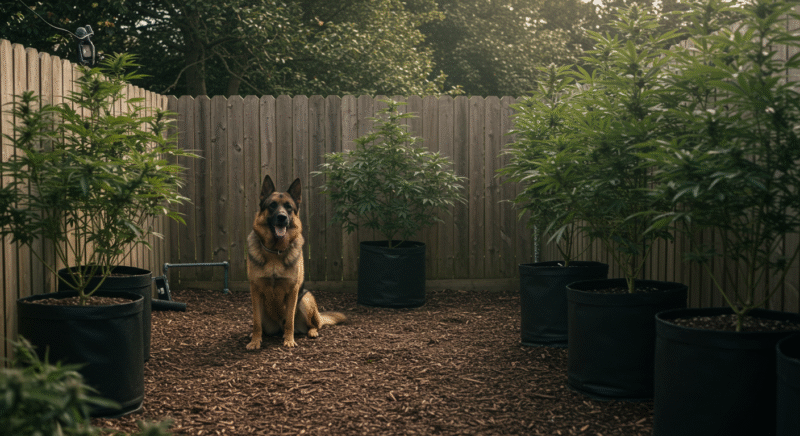
Planning Your Outdoor Grow
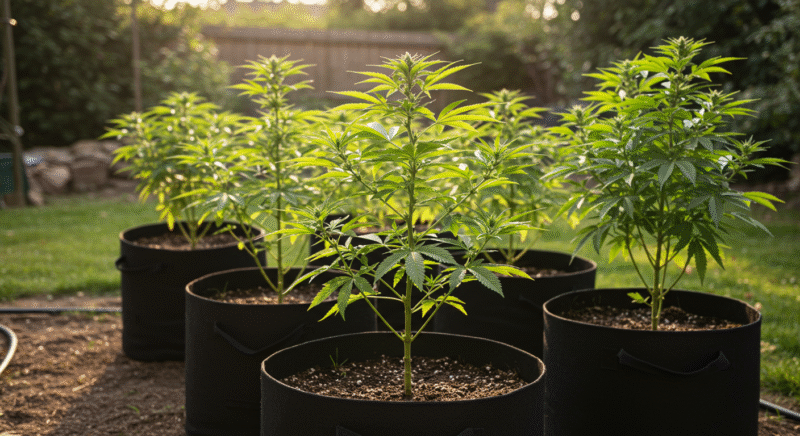
Choosing the Location
Selecting the right location is the foundation of a successful outdoor cannabis grow. Your plants need a spot where they can grow under natural conditions, especially sunlight and protection from the elements. Your chosen location will determine your plants’ health, yield, and security. Factors like light exposure, soil quality, accessibility to water, and privacy must all be considered when picking the perfect grow site. You’re setting the stage for a healthy, productive harvest by carefully planning where you grow.
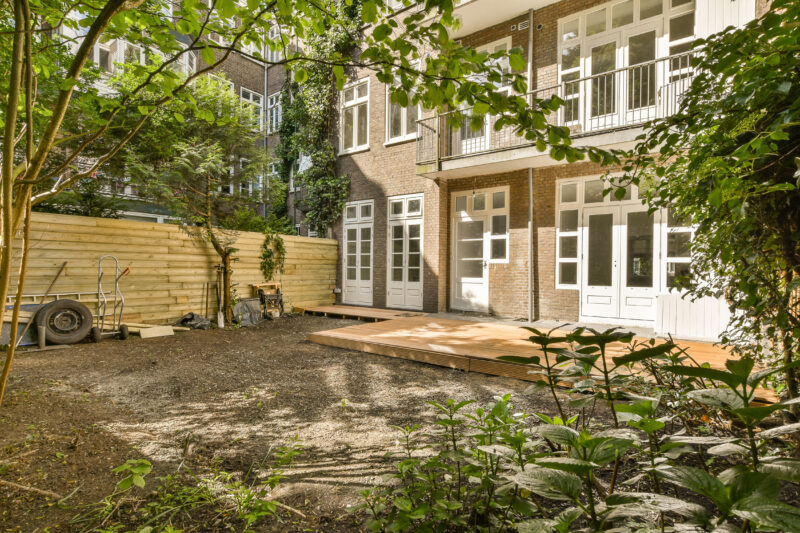
Light Exposure
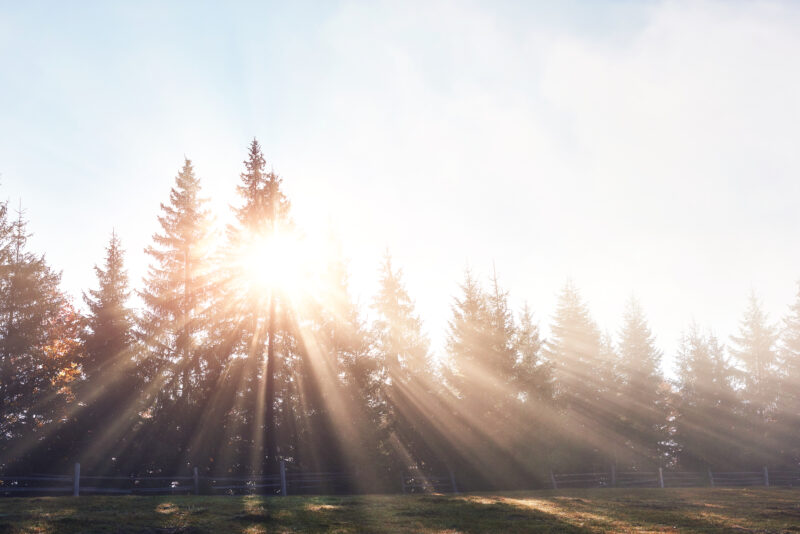
When growing cannabis outdoors, one of the most important factors to consider is light exposure. Sunlight is the primary source of energy for cannabis plants, driving the process of photosynthesis and contributing to their overall health, growth, and potency. Planning for proper light exposure is a crucial step to ensure a successful outdoor grow. Whether you’re growing in your backyard or in a more remote location, understanding how sunlight interacts with your plants throughout the growing season is essential for achieving robust, high-yielding crops.
The Importance of Sunlight
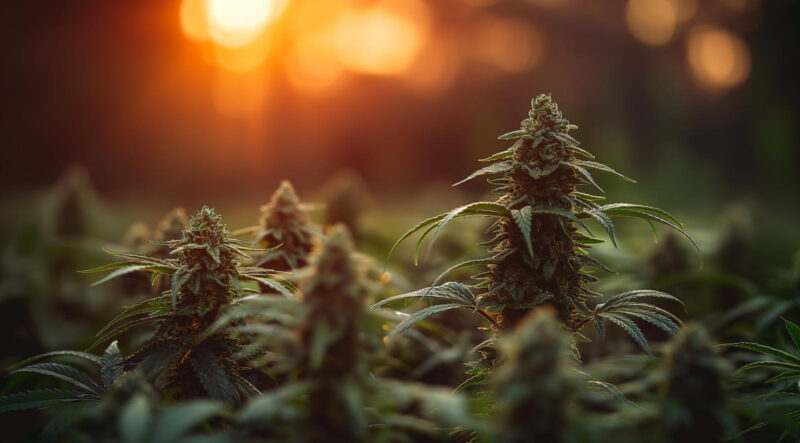
Cannabis is a light-hungry plant. It uses sunlight to drive the process of photosynthesis, turning light energy into food that fuels its growth and flower production. The more light your plants receive, the better they will perform. For outdoor cannabis cultivation, sunlight exposure directly impacts plant size, potency, and yield.
Cannabis requires a minimum of five hours of direct midday sun each day to grow well, but 8-10 hours of sunlight daily is ideal. Planning your grow site to maximize sun exposure is crucial if you want to grow robust plants that yield dense, resinous buds. Simply put, the more sunlight your plants get, the more energy they have for producing cannabinoids like THC and CBD, which translates to higher potency and better overall quality.
Sunlight and Seasonal Changes
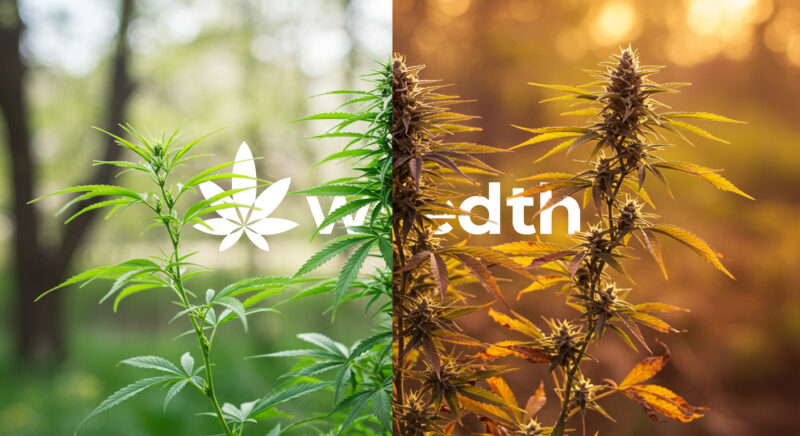
Before planting your seeds or seedlings, the first step is to thoroughly assess your grow site’s light exposure. A good time to do this is in the spring, as the angle and intensity of the sun in early spring will give you a clear indication of the light conditions your plants will experience throughout the growing season.
Cannabis needs plenty of direct sunlight from mid-morning to mid-afternoon. The ideal window for exposure is between 10 a.m. and 4 p.m., though an 8 a.m. to 5 p.m. range is even better. This direct sun will provide the light intensity needed to drive photosynthesis and encourage your plants to grow rapidly and healthily.
The sun’s position in the sky changes with the seasons due to the earth’s rotation, so it’s important to factor this in when choosing a location. The sun’s path will vary from spring to fall, and the height of summer brings the most direct sunlight. Go out to your grow site early in the growing season and track the sun’s path throughout the day. Make sure no large structures, trees, or other obstacles will cast shadows over your plants during the critical midday hours. Even something that might seem like a small obstruction can significantly limit the potential of your plants if it blocks the sunlight for long periods.
Tip: Start by observing the sun’s movement across your grow site. Imagine the sun’s path as a 360-degree arc that moves from east to west over your growing area. Try to imagine how this path will change in the summer, fall, and early spring.
Sunlight Exposure Based on Geographic Location

Cannabis can be grown successfully in a wide range of environments, but your geographic location will influence how much sunlight your plants can receive throughout the growing season.
Northern Hemisphere Growers (Above 30° Latitude)
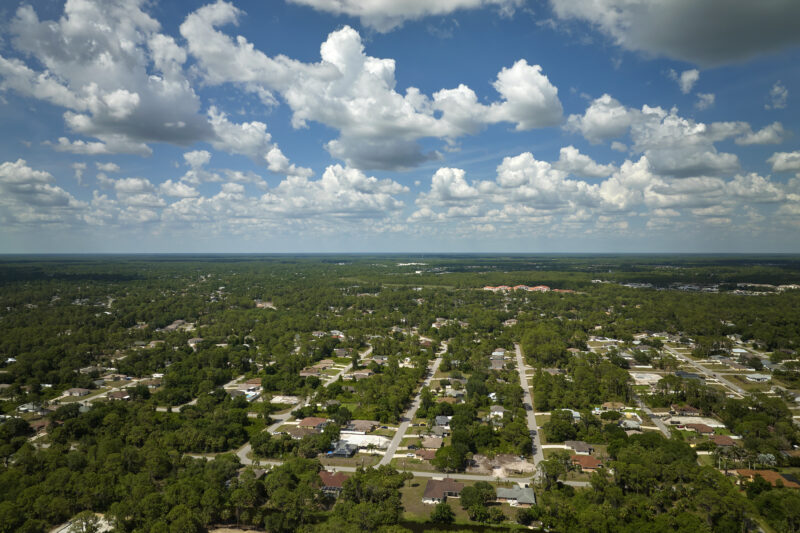
The growing season is shorter in northern regions such as Canada, northern Europe, or parts of the US, and the sun sits lower in the sky. This makes it essential to start your plants early in the year, preferably in April or May, so they can benefit from the longer daylight hours of summer. In these regions, it’s especially important to position your grow site to capture the maximum amount of sunlight during the summer months, as days will shorten significantly by late September or October. A south-facing slope or an area that receives full sun from morning until late afternoon is ideal.
Southern Hemisphere Growers (Below 30° Latitude)
In southern regions like parts of South America, Africa, or Australia, the growing season is longer, and sunlight is more consistent year-round. However, during the peak of summer, the intense heat can stress your plants, especially during the afternoon. Consider a site with full morning sun and some light afternoon shade in these climates to protect your plants from extreme heat while ensuring they get the light they need. Be sure your plants get at least 5-6 hours of direct sun each day for the best results.
Equatorial Growers (Near the Equator)
Day lengths are more consistent year-round near the equator, meaning cannabis can be grown outdoors throughout the year. However, growers in these regions need to watch out for humidity and heavy rainfall, which can affect plant health. Make sure your grow site gets plenty of sunlight to dry out the plants and prevent mold from forming. A location that receives full sun throughout the day is optimal for cannabis grown in equatorial regions.
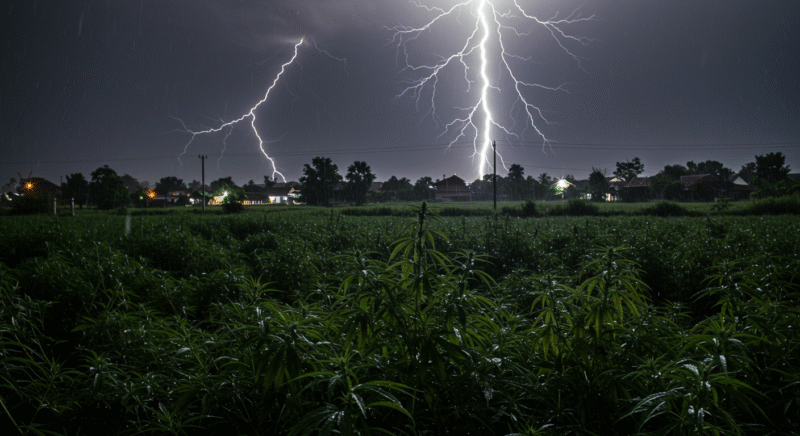
In summary, cannabis plants respond best to full, uninterrupted sunlight, and the south-facing side of a hill or slope typically offers the most consistent exposure. Large, open areas on the northern side of a property can also receive excellent southern exposure, ensuring that your plants are bathed in sunlight throughout the day. If you have limited sunlight exposure, morning light is often preferable to afternoon light. Cannabis plants that receive full morning sun will begin photosynthesis earlier in the day, leading to more vigorous growth.
Maximizing Light Reflection for Increased Yields
In addition to selecting the best location for sunlight exposure, there are some clever tricks you can use to boost light intensity. One of the easiest ways to increase your plants’ light exposure is by utilizing reflective surfaces near your grow area.

If your plants are growing near a wall or fence, painting it flat white can significantly enhance the light your plants receive. The white surface will reflect sunlight back onto your plants, effectively increasing the amount of light hitting them. This simple adjustment can lead to up to 10% higher yields without the need for any additional energy inputs. It’s an effective, low-cost way to improve your grow without adding complexity.
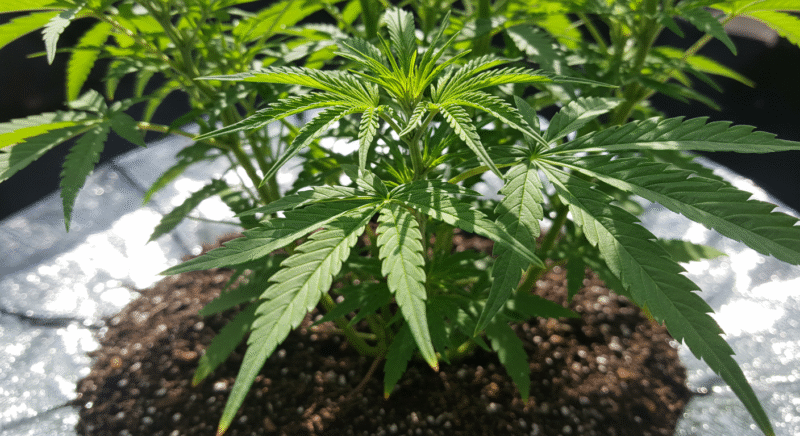
Another option is to use reflective mulches or white ground covers around the base of your plants. These materials reflect light back onto the lower parts of the plant, ensuring that even the lower branches receive sufficient light. This method is particularly useful for dense, bushy plants where the upper leaves might block sunlight from reaching the lower parts.
Avoiding Light Obstructions and Managing Shadows
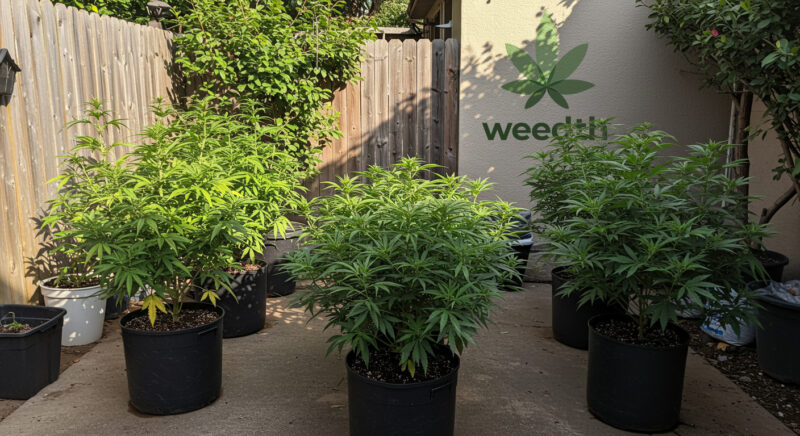
When selecting your grow site, be sure to account for potential obstructions that might cast shadows over your plants during the day. Trees, buildings, and even fences can block sunlight and limit the amount of exposure your plants receive. Remember that as the sun moves across the sky, the angle of sunlight will change, so what seems like a sunny spot in the morning could be shaded by afternoon.
In addition, as the seasons change, the sun’s path will shift. A location that gets full sun in early summer might be partially shaded by fall, when the sun is lower in the sky. If you live in an area with shorter growing seasons, make sure your grow site is positioned to capture the maximum amount of sunlight throughout the entire season.
The Importance of Full Sun for Greenhouse Growing
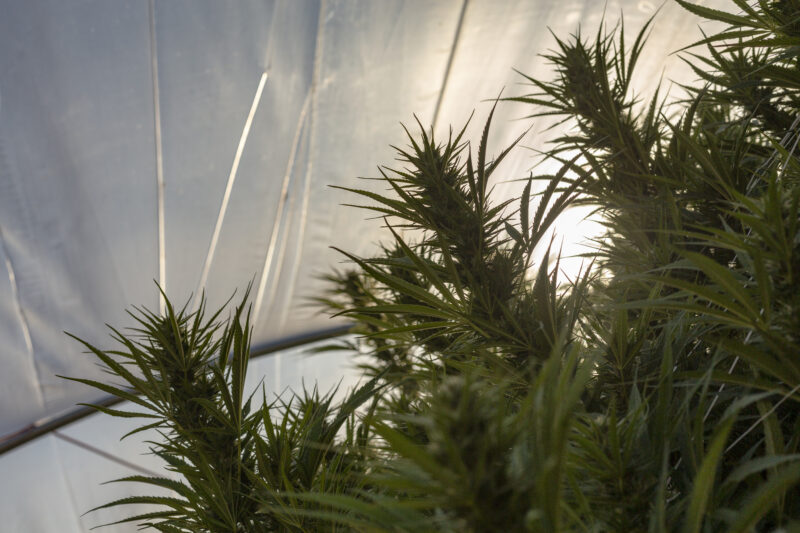
If you’re growing cannabis in a greenhouse ensuring that your plants receive full sun exposure is just as important. A greenhouse can provide protection from harsh weather conditions, pests, and other outdoor risks, but it still relies on natural sunlight to support the plants’ growth. Position your greenhouse in a location that gets at least six to eight hours of direct sunlight daily, ideally from the morning through mid-afternoon. If your greenhouse is in a spot that gets too much shade, you may need to consider supplemental lighting to ensure your plants get the light they need to thrive.
Practical Tips for Ensuring Proper Light Exposure
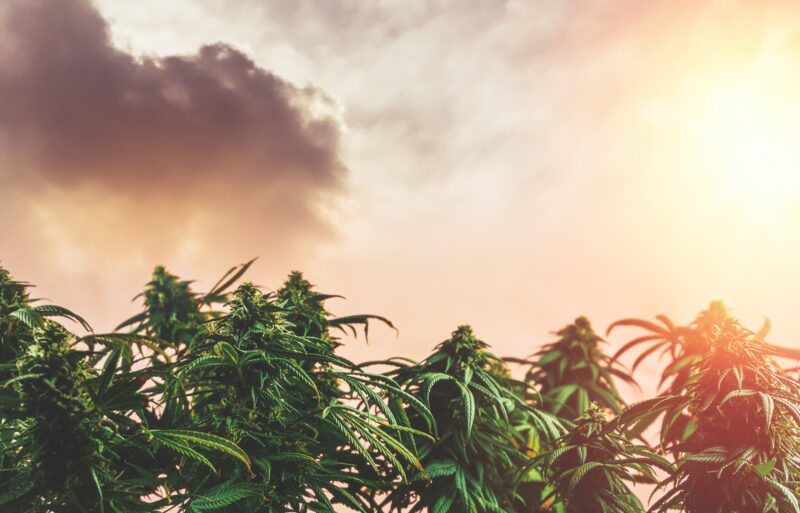
Here are a few additional tips to ensure that your outdoor cannabis plants receive the optimal amount of sunlight:
Use the Winter Sun as a Guide: Even though cannabis is typically grown during the spring and summer months, the amount of sunlight your grow site receives in the winter can be a useful indicator of how much light it will get in the growing season. By observing the winter sun, you can identify any potential obstacles that might block sunlight during the spring or fall.
Monitor Light Patterns: If you’re not sure how much sunlight your grow site will get, use a light meter to measure the amount of direct sunlight throughout the day. This can help you find the best location for your plants.
Optimize Plant Placement: If you have limited space or access to sunlight, consider planting your cannabis in pots that can be moved throughout the day to follow the sun. This is especially useful if you’re growing in a backyard or smaller area where sunlight is limited at certain times of the day.
Account for Seasonal Changes: As the seasons change, the sun’s angle will shift, so make sure to consider how sunlight will change throughout the growing season. Planning for these changes in advance can help ensure that your plants get the consistent light exposure they need.
Frost and Cannabis Grow Outdoors
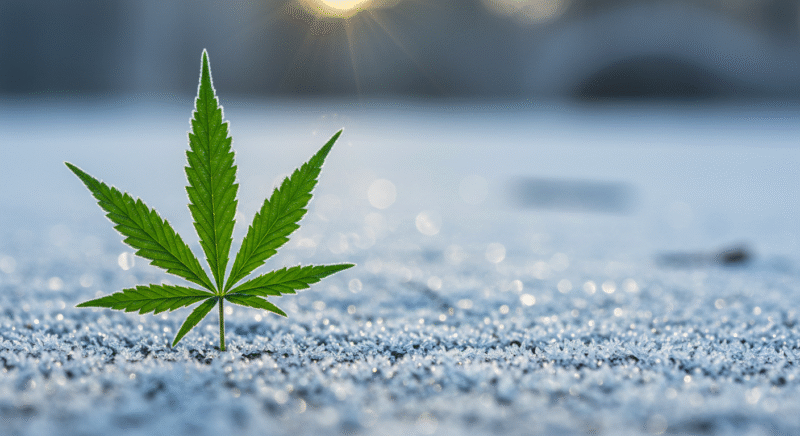
When growing cannabis outdoors, frost is one of the greatest threats to your plants, especially as the season changes and temperatures begin to dip. Frost occurs when air temperatures drop below 32°F (0°C), leading to the formation of ice crystals on leaves, which can injure or even kill your plants. For cannabis, particularly those not bred for extreme climates, frost can be devastating if you don’t take the right precautions.
Frost: Clear Skies, Wind, and Location
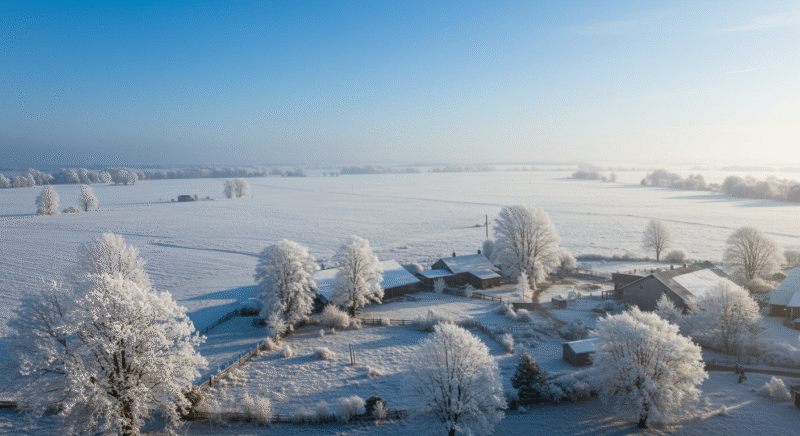
Frost typically forms on nights with clear skies and calm winds. When the afternoon temperatures start to fall rapidly under these conditions, especially with a cool breeze from the northwest, this may indicate the arrival of a cold air mass, which can lead to a hard freeze. A hard or killing frost brings temperatures that dip below freezing and can wipe out most plants except for the hardiest varieties. These types of frosts are especially dangerous for cannabis, as they can severely damage or even kill the plants overnight.
On cloudy nights, the picture is different. Clouds act as a blanket, trapping the day’s heat close to the ground, which can help protect your cannabis plants from frost. When clouds are present, they can keep the temperature from plummeting too low, offering a layer of protection for your crops. Always keep an eye on the forecast; cloudy nights are your friend when it comes to protecting your plants from frost damage.
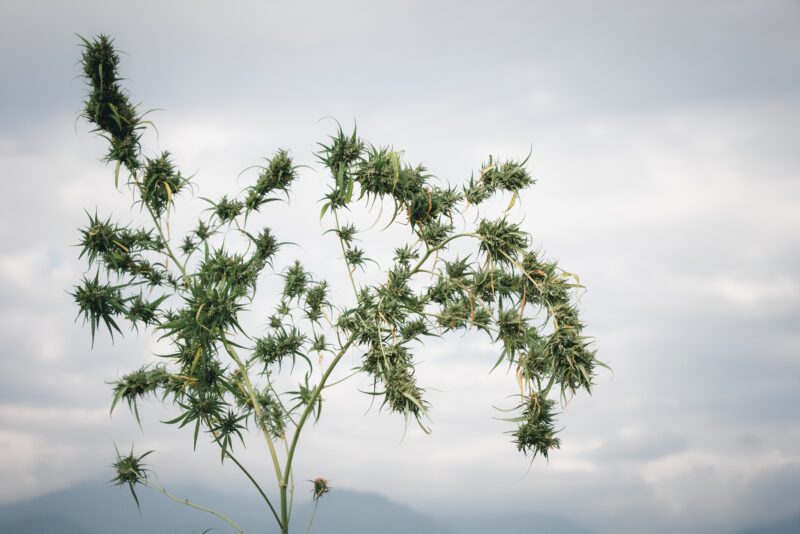
Wind plays a crucial role too. If the night is calm and still, the coldest air settles at ground level, creating the perfect conditions for frost to form, especially on your lower leaves and buds. However, a light breeze can prevent cold air from settling and keep temperatures slightly higher, which can protect your plants. But if the wind itself is freezing, it can be equally damaging, so you’ll need to watch for both wind speed and temperature.
Humidity and Moisture: Your Allies Against Frost

Humidity and moisture levels in the air can be your plant’s best defense against frost. When the air is humid, moisture condenses and releases heat, which can protect your plants from freezing. This is why mornings with dew are often not as damaging as frost. If the air is dry, on the other hand, moisture from the soil evaporates, which draws heat away from your plants. Keeping your soil moist, particularly before a predicted frost, is key to helping your plants survive. The moisture in the soil will release heat overnight, raising the temperature slightly around your plants, which could make the difference between life and death for your crop.
Location, Location, Location
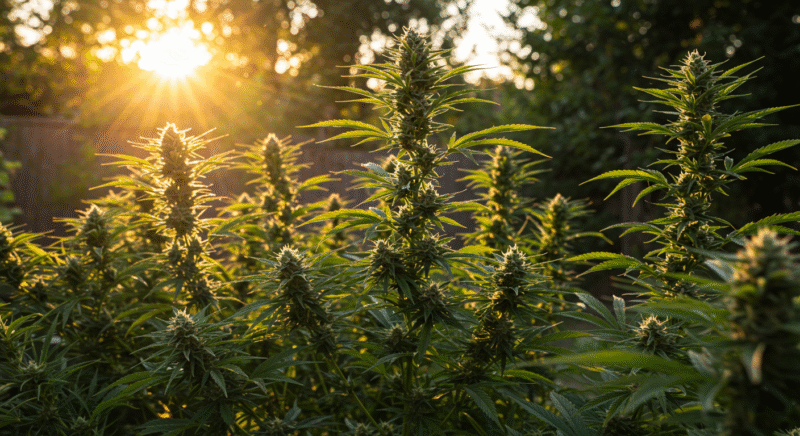
The location of your garden can make all the difference when it comes to frost. The elevation and landscape of your grow area play a significant role. In general, the temperature drops 3-5°F (-16.1 to -15°C) for every 1,000 feet of elevation. So, if your garden is located at a high altitude, it’s more likely to experience early frosts. But lower isn’t always better—cold air is denser than warm air, so it tends to sink into low-lying areas, which are often frost-prone zones.
The ideal spot for your garden is a gentle, south-facing slope that is exposed to the late-afternoon sun and sheltered from northern winds. This kind of location will absorb the maximum amount of heat during the day and hold onto it longer at night, reducing the risk of frost damage. Gardens near buildings, fences, trees, or bodies of water can also be more frost-resistant, as these features provide some shelter and help retain heat.
Soil Matters
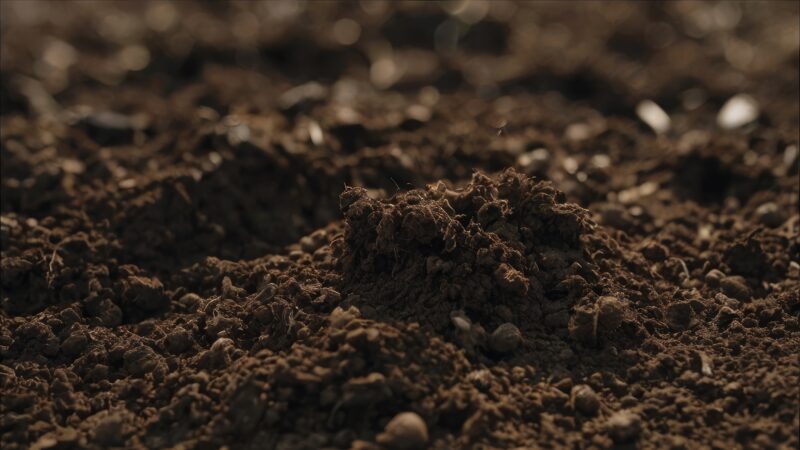
The type of soil you use can also influence frost risk. Deep, fertile, well-draining soil holds moisture better than poor, sandy soil, and this moisture releases heat during the night, protecting your plants. If your plants are growing in heavily mulched soil, though, be cautious—mulch can trap moisture and heat in the soil, reducing the amount that radiates into the air and increasing the likelihood of frost. In general, the more humid the air is the higher the dew point will be and the less likely frost is to form.
Plants’ Frost Tolerance
Some plants are naturally more resistant to frost than others. Young, actively growing cannabis plants are the most vulnerable to frost damage, especially if they are still developing tender new leaves. However, some strains of cannabis, particularly those with maroon or bronze leaves, tend to be more frost-tolerant, as these darker leaves absorb and retain heat better than lighter-colored ones. Cannabis plants with downy or hairy leaves also tend to be more resistant to frost because the tiny hairs trap heat close to the leaf surface.
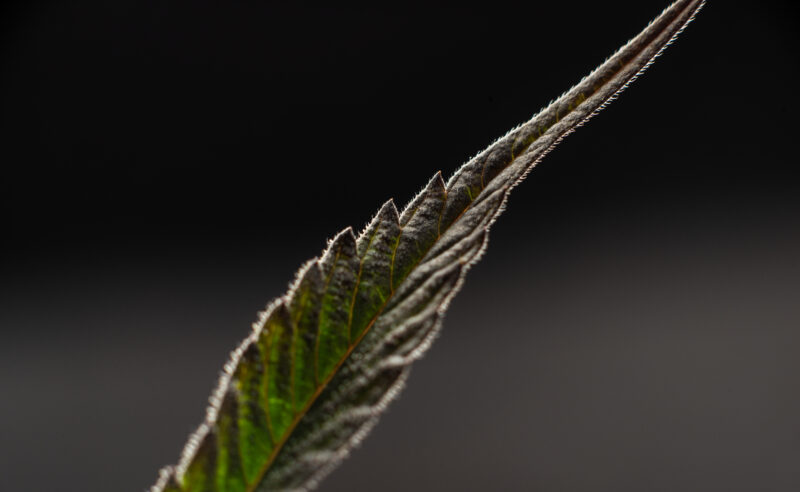
Compact, bushy plants are generally more resistant to frost damage than tall, leggy ones because they expose less surface area to cold winds. Similarly, closely spaced plants can help protect each other by forming a microclimate that retains warmth and shields individual plants from direct exposure to frost.
Preparing for Frost
If a frost is in the forecast, there are several steps you can take to protect your cannabis plants. First, cover your plants to retain as much soil heat as possible and to shield them from cold winds. You can use newspapers, tarps, blankets, or even straw—anything that traps the heat rising from the ground can help. Just make sure to cover your plants before sunset so they can retain the heat from the day. Secure any lightweight coverings so they don’t blow away if the wind picks up during the night.
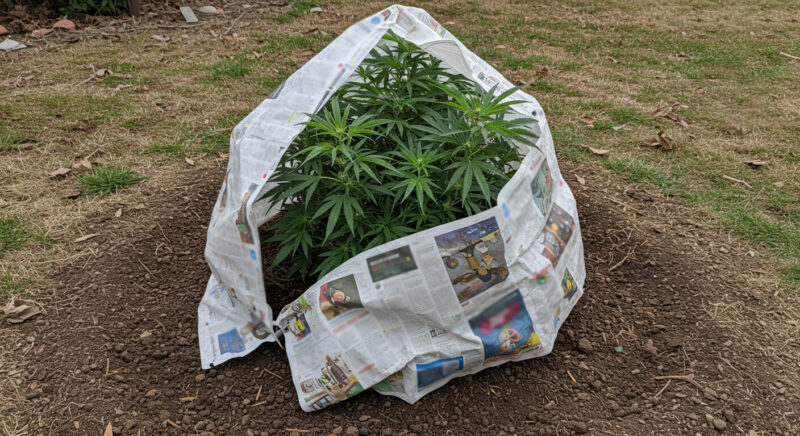
Watering your plants thoroughly before a frost can also help. Moist soil holds heat better than dry soil, and as the water evaporates overnight, it will release heat that can protect your plants. Some commercial growers even leave sprinklers running all night to coat their plants in ice—the process of water freezing actually releases heat, keeping the plants alive beneath a layer of ice. If you decide to go this route, make sure the sprinklers continue running as long as the temperatures stay below freezing; otherwise, your plants may suffer severe damage.
Frost Damage and Temperature Effects
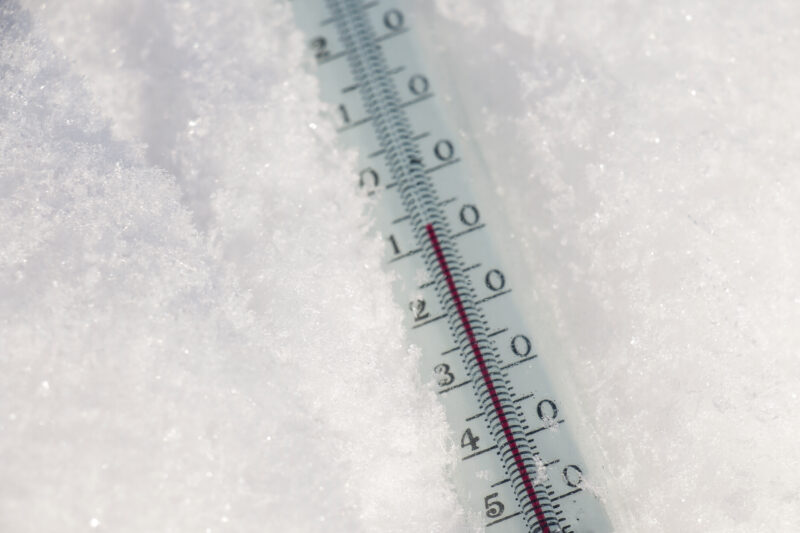
Different temperatures can have varying effects on your plants. Here’s a breakdown of what to expect:
- Light Freeze (29-32°F/-2 to 0°C): This is a mild frost, which will likely kill tender plants but leave hardier vegetation intact.
- Moderate Freeze (25-28°F/-4 to -2°C): This range causes significant damage to most plants, including fruit blossoms and semi-hardy varieties.
- Severe Freeze (24°F/-4°C or colder): At these temperatures, most vegetation, including cannabis, is heavily damaged or killed.
Cold temperatures can also change the appearance of your plants. When exposed to frost, some cannabis strains may turn purple or red, especially around the buds and leaves. While this can be a stunning visual effect, it’s usually a sign that the plant is under stress. If you see these color changes, it’s time to take immediate action to protect your crop.
When’s the Best Time to Grow?
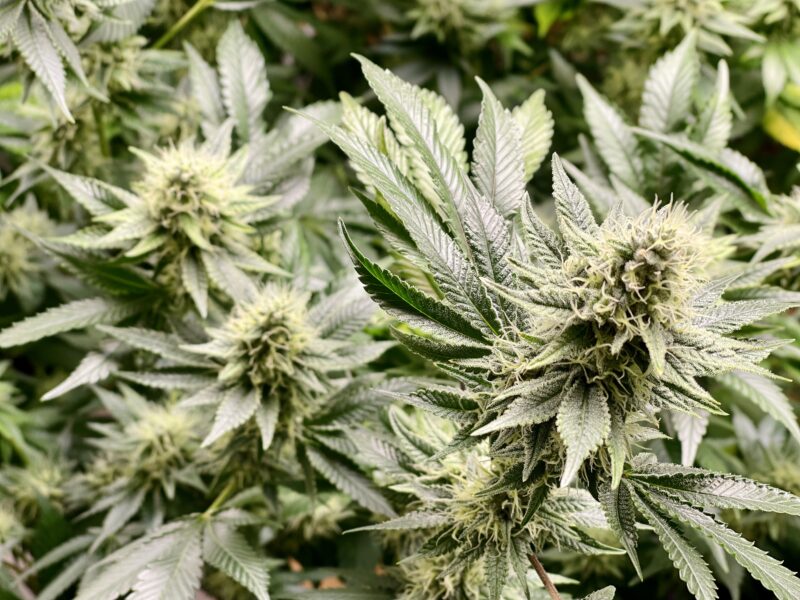
Cannabis plants are adaptable and can thrive anywhere you can grow. They need about three months from seed to harvest when grown outdoors—or just two months if you start them indoors. Experienced growers agree that the ideal time to begin your outdoor marijuana grow is in March or April, or early May at the latest. This timing allows your plants to mature and start flowering by August or September when daylight hours begin to shorten.
Paying attention to your local frost dates is critical. Talk to nearby growers or check the farmer’s almanac to determine the year’s last frost. Always plant after the last frost to avoid damage to your young plants. If you’re concerned about frost or have a colder climate, start the plants indoors and gradually move them outside during the day, bringing them back in at night. This process is called “hardening off” where you help the plants acclimate to outdoor conditions to avoid shock. Tossing indoor plants straight into outdoor conditions can lead to stunted growth or worse.
Starting your plants indoors is generally the easiest way to kick off the growing season. Indoors, you can control the environment more easily, using a CO2-enriched atmosphere and metal halide lights to boost early growth. This head start can make a huge difference, especially in climates with shorter growing seasons.
Wind
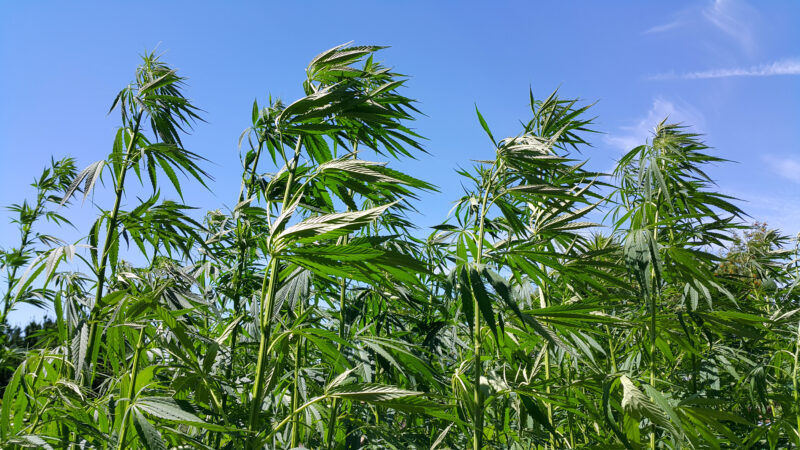
Wind is an essential environmental factor in any outdoor cannabis growing operation. It plays a crucial role in your plants’ development and overall health but wind can be both beneficial and harmful, depending on its intensity, direction, and duration. Understanding how wind affects cannabis growth is key to ensuring a successful outdoor grow and preventing stress or damage to your plants. In this section, we will explore the complex relationship between wind and cannabis, focusing on how wind influences plant physiology, growth patterns, and your garden’s microclimate.
Benefits of Wind for Cannabis Growth
In moderate amounts wind is an essential part of healthy plant development. When growing cannabis outdoors, a gentle breeze can offer numerous advantages to your plants, improving everything from structural integrity to pest and disease prevention.
Strengthening Plant Structure
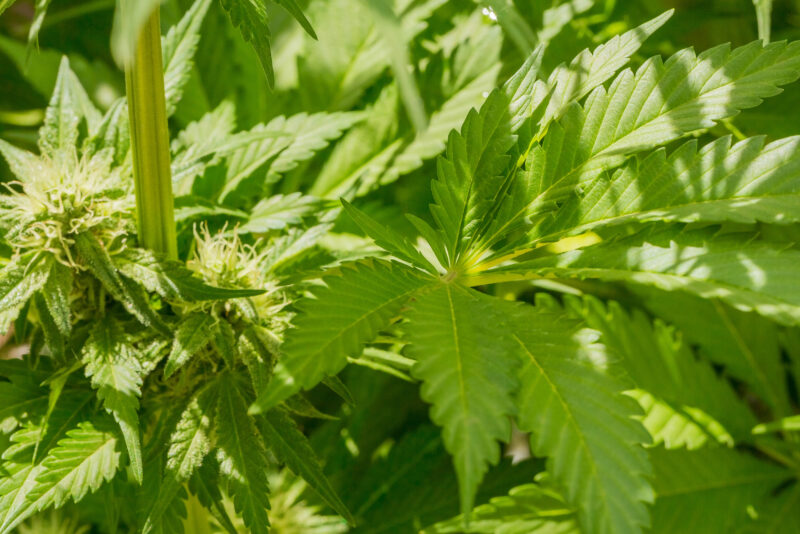
One of the most significant benefits of wind for cannabis plants is the way it helps strengthen plant stems and develop robust root systems. When exposed to a gentle breeze, cannabis plants naturally respond by fortifying their stems and branches to resist movement. This process, known as thigmomorphogenesis, refers to the physiological changes plants undergo in response to mechanical stress, such as the movement caused by wind.
- Stem Thickening: As the wind moves plants back and forth, it triggers hormonal responses that result in the thickening of the stem tissue, particularly in young plants. Thicker stems and stronger branches are essential for supporting the weight of large, dense buds during the flowering stage.
- Root Development: Wind exposure also encourages the plant to establish a stronger root system, as the roots anchor the plant more securely in the soil to prevent it from being uprooted. This deeper, more extensive root system improves the plant’s ability to absorb water and nutrients, which can directly contribute to increased vigor and yield.
Enhancing Air Circulation and Preventing Pests and Mold
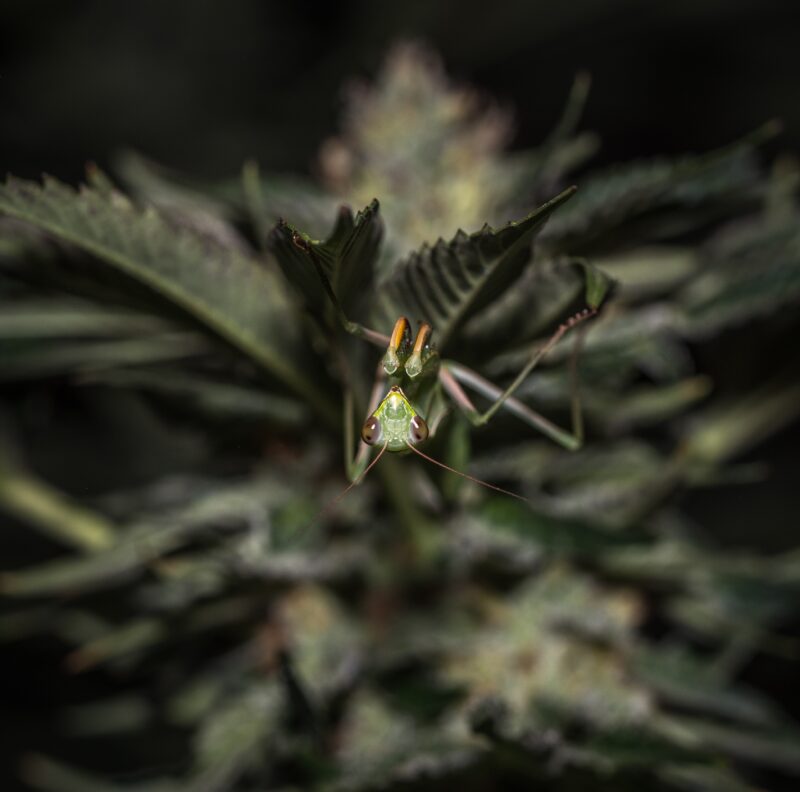
Good airflow around your cannabis plants is crucial for maintaining a healthy growing environment. Wind helps to improve air circulation, which in turn:
- Reduces humidity levels around the plant, particularly within the dense foliage. Lower humidity is vital for preventing mold and mildew, especially during the flowering stage when plants are more susceptible to these issues.
- Helps prevent pests from settling on your plants. Many pests, such as aphids, spider mites, and whiteflies, thrive in still, stagnant environments. Wind makes it harder for these pests to establish colonies, as they prefer calm areas to feed and reproduce.
- Promotes gas exchange: Cannabis plants, like all plants, rely on the process of photosynthesis to convert sunlight into energy. During this process, they absorb carbon dioxide (CO₂) from the air and release oxygen (O₂). Wind facilitates this gas exchange by constantly refreshing the air around the leaves, ensuring the plant has a steady supply of CO₂, which supports faster and healthier growth.
Pro Tip: If you live in a humid climate where mold and mildew are common problems, consistent airflow (even moderate wind) is your best defense. Be cautious with overly strong winds, as they can increase transpiration and dry out your plants too quickly.
Cooling Plants and Regulating Temperature
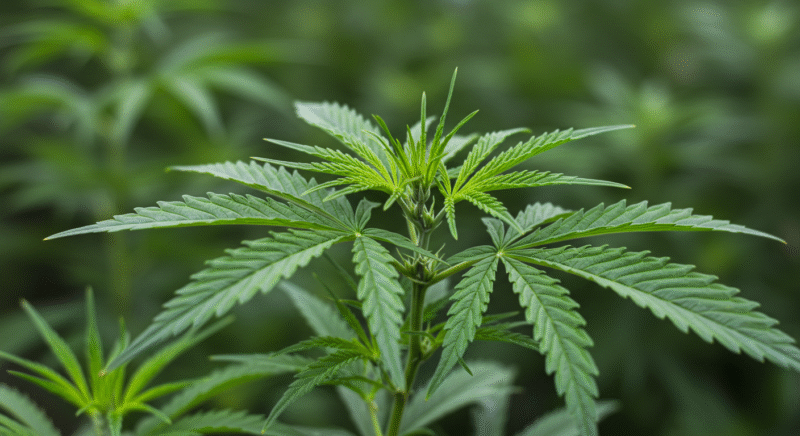
Wind helps to moderate temperatures around your cannabis plants by cooling them during hot weather. As the wind moves across the leaves, it aids in the process of evapotranspiration, where moisture is released from the plant’s stomata (tiny openings on the leaves). This process cools the plant’s surface, helping to regulate its temperature, especially during the hot summer months when temperatures can soar.
Cannabis thrives in temperatures between 70-85°F (21-29°C). While the plants can tolerate warmer conditions, extreme heat can cause stress and slow growth. In such cases, wind acts as a natural cooling mechanism, preventing heat stress and reducing the risk of wilting or leaf scorch.
Evapotranspiration also helps to pull water and nutrients up from the soil into the plant’s vascular system, ensuring that the plant remains hydrated and well-nourished, even in hot weather.
Dangers of Excessive Wind for Plants
While wind in moderation provides many benefits, excessive wind can be extremely harmful to cannabis plants, especially if it is persistent or combined with other environmental stressors like extreme temperatures or low humidity. Let’s take a closer look at how strong or constant wind can damage your plants.
Physical Damage to Plants
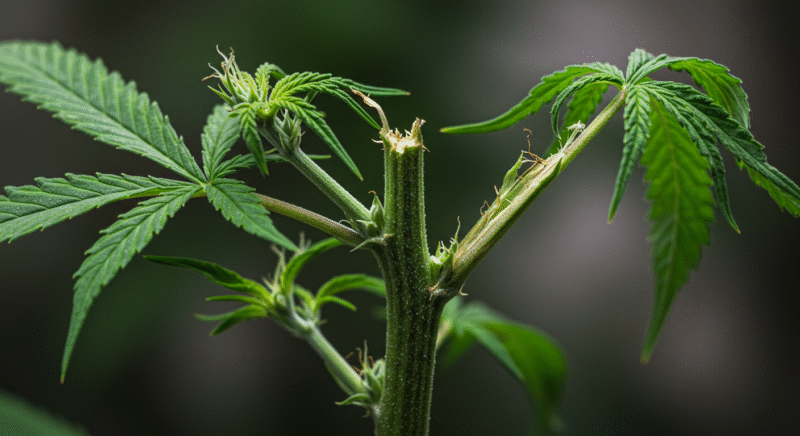
Cannabis plants are not withstand high winds for long periods. Strong gusts of wind can cause structural damage, such as:
Broken Branches: Heavy winds can snap stems and branches, especially during the flowering stage when the plants are top-heavy with resinous buds. This can reduce yields and compromise the overall health of the plant. Even if the damage is not immediately visible, continuous bending and twisting can weaken branches over time.
Pro Tip: When branches are most vulnerable during the flowering stage, consider providing additional support to prevent snapping. You can use trellises, stakes, or plant cages to reinforce your plants, ensuring they remain upright and stable in case of sudden gusts.
Windburn: Just as strong sunlight can cause leaf burn, excessive wind can cause windburn, where the edges of the leaves become dry, curled, or brittle. This occurs because strong winds cause excessive evaporation from the leaves, leading to dehydration. When the rate of moisture loss exceeds the plant’s ability to uptake water through its roots, leaves become scorched or withered.
Increased Transpiration and Dehydration
Transpiration is the process by which water evaporates from the leaves into the atmosphere, cooling the plant and enabling nutrient uptake. In moderate conditions, transpiration is an essential and beneficial process. However, transpiration rates can spike dramatically in high winds, leading to rapid moisture loss. This is particularly dangerous in environments with low humidity or during dry seasons.
Water Stress: When wind forces plants to lose water too quickly, it can lead to water stress. The roots may not be able to draw water from the soil fast enough to replace what’s lost through the leaves, resulting in wilting, stunted growth, or even plant death in extreme cases.
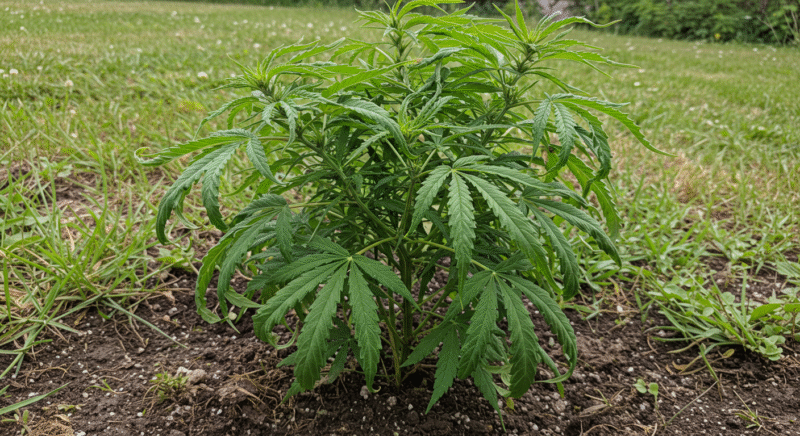
Nutrient Deficiency: Because water is the primary vehicle for transporting nutrients from the soil to the plant, excessive transpiration caused by strong wind can also lead to nutrient deficiencies. Without adequate water, plants struggle to absorb and distribute key nutrients like nitrogen, potassium, and phosphorus, which are essential for growth and flowering.
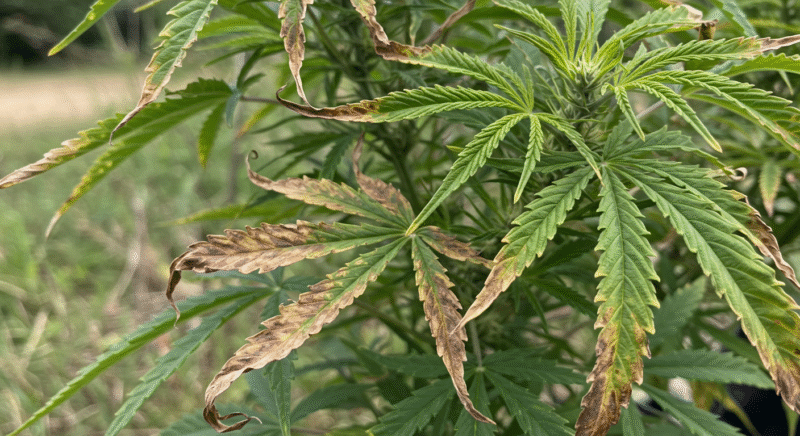
Pro Tip: During prolonged periods of high wind, increase watering frequency to help your plants cope with the increased rate of water loss. Use mulch around the base of your plants to retain moisture and protect the root zone from drying out too quickly.
Impact on Pollination and Flowering
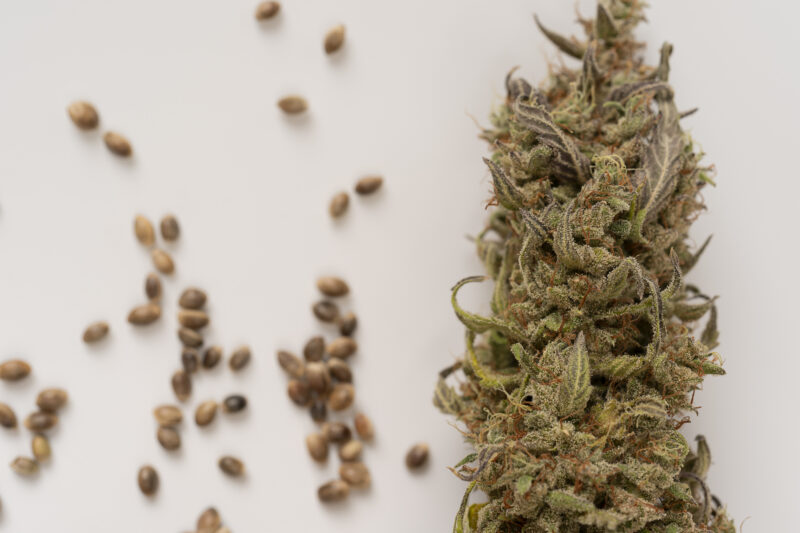
flower buds and Cannabis seeds isolated on white background. close up top view, medical use concept
For cannabis growers, the flowering stage is the most critical part of the growing cycle, as it determines the quality and yield of your harvest. During this time, excessive wind can be particularly damaging.
Disruption of Flower Formation: Constant wind can interfere with the delicate process of flower development, especially in early flowering. The physical stress from wind can cause flowers to develop unevenly or lead to fewer bud sites, reducing overall yields.
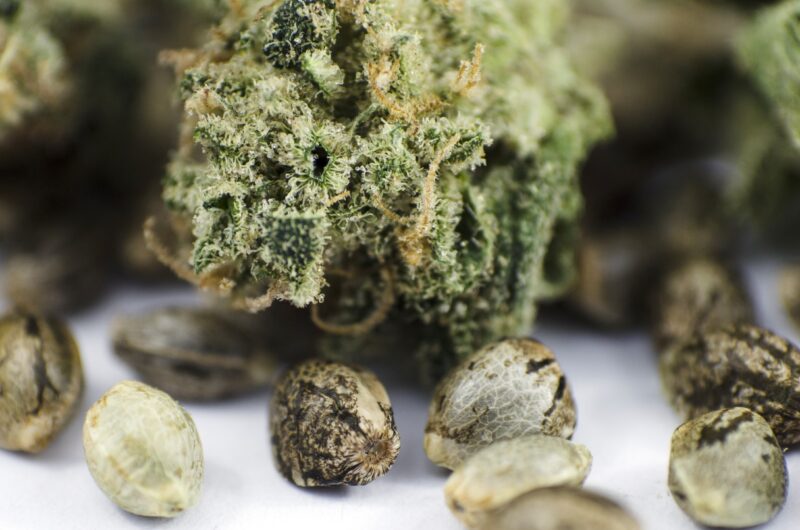
Pollination in Seed-Producing Plants: Wind can play a role in pollination for growers producing seeds. While cannabis is typically pollinated through the air (pollen is carried by wind), overly strong or erratic winds can disrupt this process, causing inefficient or incomplete pollination. In contrast, too little wind can limit pollen distribution, affecting seed development.
Pro Tip: If you are growing cannabis for seed production, monitor wind conditions closely during the pollination window to ensure optimal pollen dispersal. Avoid high-wind days by sheltering your plants or using controlled environments like greenhouses if necessary.
Microclimate Creation and Wind’s Role
One of the most subtle but important roles that wind plays in outdoor growing is its ability to influence the microclimate, the localized climate around your plants. Every garden, regardless of its size, has a unique microclimate that is shaped by factors like wind patterns, sunlight exposure, humidity, and topography.
Wind and Temperature Regulation
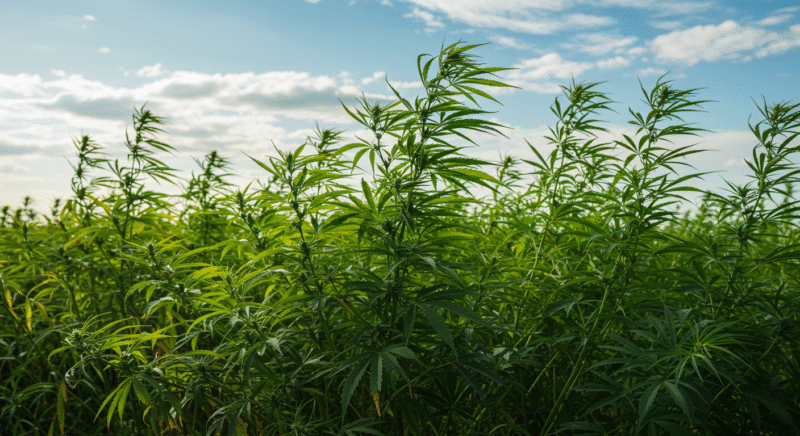
Wind acts as a moderator in your garden’s microclimate. It can cool plants during hot days, preventing heat stress, and also encourage air movement during colder nights, which helps protect against frost by mixing warm and cool air.
Frost Prevention: In colder climates, low-lying areas are often prone to frost because cold air naturally sinks and pools in valleys or depressions. Wind helps to disperse this cold air, reducing the likelihood of frost settling on your plants. Frost can damage or even kill cannabis plants by freezing the water inside their cells, causing tissue damage.
Wind and Humidity Management
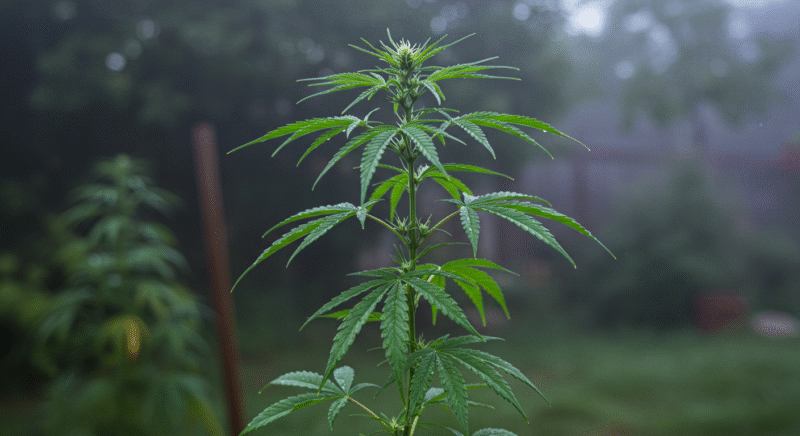
Wind also plays a vital role in managing the humidity levels around your cannabis plants. In humid climates, airflow is essential to prevent moisture buildup, especially in dense canopies where trapped humidity can lead to mold, mildew, and bud rot. Conversely, wind can exacerbate low humidity in arid climates, drying out plants faster than they can replenish moisture.
Pro Tip: In areas where humidity fluctuates drastically, it’s important to pay close attention to how wind interacts with your grow space. You may need to adjust your irrigation schedule or even create artificial wind barriers to maintain a more stable microclimate.
Windbreaks, Shelter, and Security in Outdoor Cannabis Growing
When it comes to growing cannabis outdoors, you need to think beyond just sunlight and soil. The environment can be unpredictable and challenging, subjecting your plants to a variety of potential stressors like strong winds, heavy rain, animals, and even human interference. A successful outdoor grow operation requires careful management of natural elements and robust strategies to protect your plants from external threats. That’s where windbreaks, shelter, and security come into play.
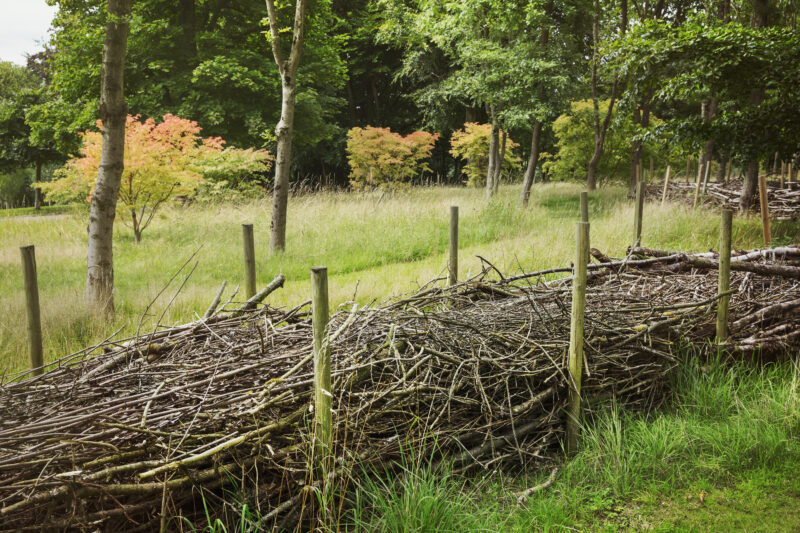
we’ll dive deep into how to protect your plants from the forces of nature and outside threats. We’ll cover everything from setting up natural and artificial windbreaks to prevent wind damage, to building shelters that shield your crop from extreme weather, as well as security strategies to protect against pests, animals, and thieves. Each section will be expanded with real-world examples, detailed techniques, and practical tips for growers at every experience level.
Designing Effective Windbreaks
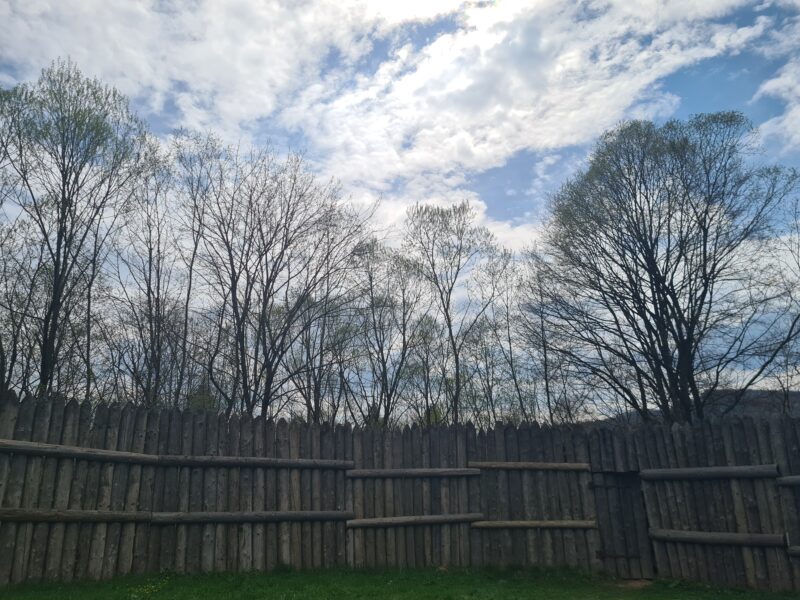
A windbreak is a barrier that reduces the wind speed over a distance, creating a more stable microclimate for your plants. Effective windbreaks protect your crop from direct damage, prevent excessive soil drying, help maintain a consistent temperature around the plants, and can even enhance humidity control.
Key Elements of a Windbreak
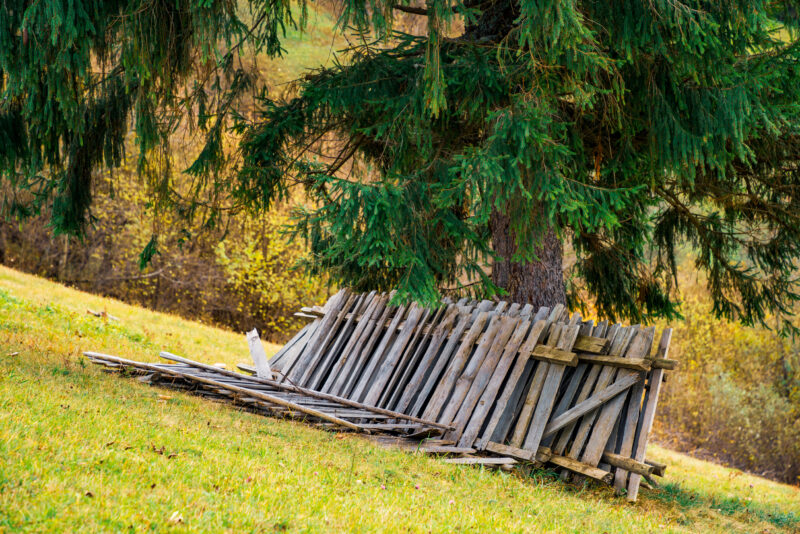
Height: The taller the windbreak, the larger the area it will protect. As a general rule, a windbreak will provide protection for a distance equal to 10 times its height. For example, a 10-foot tall windbreak can shield an area extending 100 feet beyond it. However, the most effective protection will be within the first 2-5 times the windbreak’s height.
Pro Tip: If your grow area is large, consider setting up multiple windbreaks in strategic positions to protect the entire site.
Permeability: Windbreaks should not completely block the wind. A good windbreak allows some air to pass through, which reduces the likelihood of creating turbulence or pressure zones that could actually increase wind damage in certain areas. The ideal permeability for a windbreak is around 50-60%.
Best Materials for Permeable Windbreaks:
-
- Natural hedges like shrubs or small trees.
- Slatted fences that allow wind to filter through.
- Mesh screens designed to diffuse wind without completely blocking it.
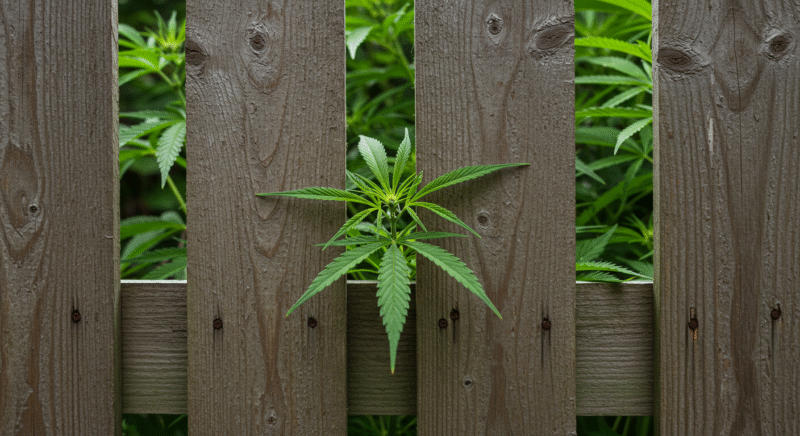
Length: The length of your windbreak is just as important as its height. For best results, the windbreak should extend beyond the edges of your grow area so that it slows the wind before it reaches your plants. Ideally, the windbreak should extend at least twice as far as the width of your grow space.
Types of Windbreaks
Natural Windbreaks (Living Barriers)
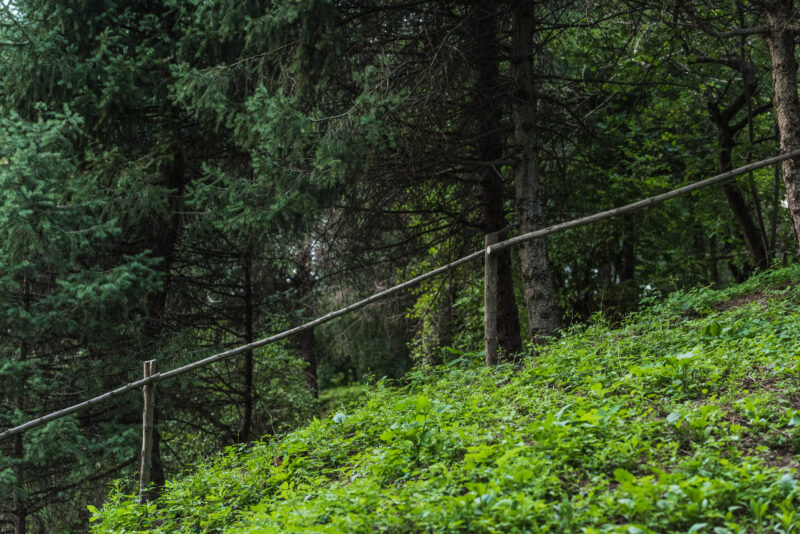
Natural windbreaks involve using plants, trees, or shrubs to create a barrier that both shields your cannabis crop from wind and blends seamlessly into your garden. These living barriers provide excellent long-term protection and offer additional benefits like increased biodiversity, shade, and support for beneficial insects.
Trees: Fast-growing species like poplars, willows, or cypress trees are great choices for long-term windbreaks. These trees can grow several feet yearly and form dense barriers once they mature. Coniferous trees like junipers or pines are also useful, as they provide year-round protection in colder climates.

Pro Tip: When planting trees for a windbreak, space them 6-10 feet apart to allow for future growth. Planting too closely can cause competition for resources while planting too far apart reduces the windbreak’s effectiveness.
Shrubs: For a shorter, denser windbreak, consider shrubs like hawthorn, elderberry, or bamboo. Bamboo, in particular, is a favorite among growers because of its rapid growth and tall height, though clumping varieties are preferred to avoid the spread of invasive species.
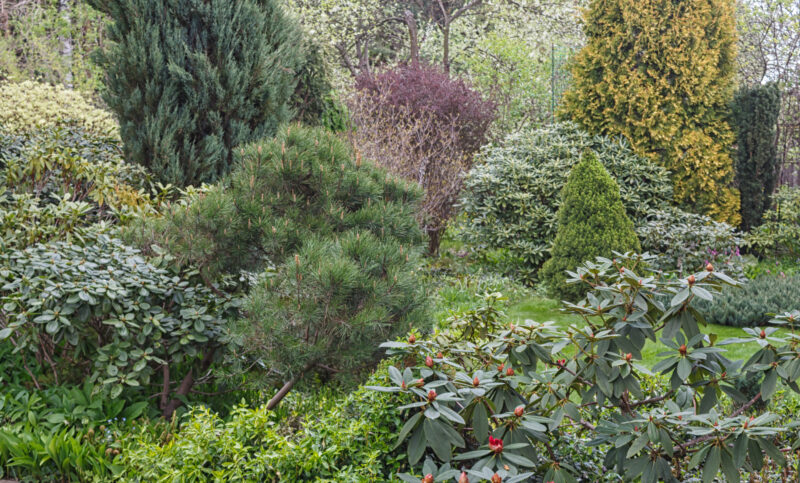
Tall Grasses: Fast-growing grasses like switchgrass, pampas grass, or reed grass are excellent choices for adding a wind buffer around smaller grow operations. They also bring aesthetic value and encourage wildlife diversity.
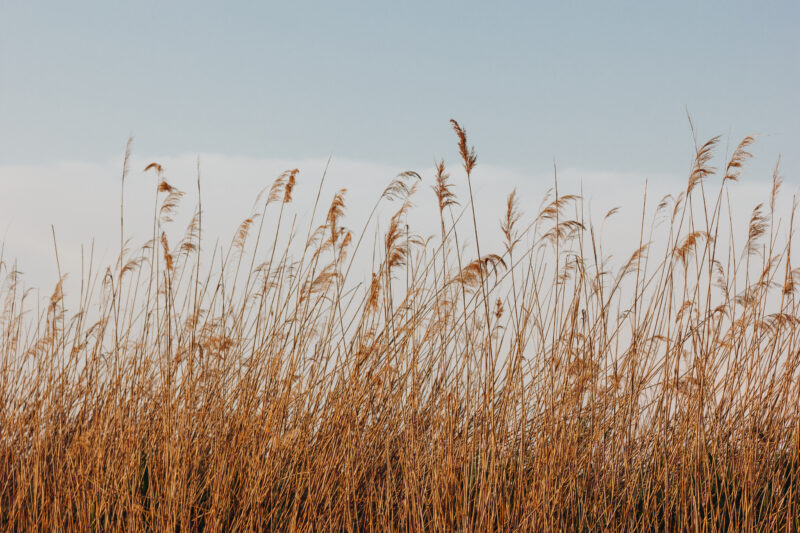
Straw Mulch: Straw mulch is a simple yet effective addition to any outdoor cannabis grow, especially in smaller, low-impact operations. When applied around the base of your plants, it helps regulate soil temperature, retain moisture, and suppress weed growth, all essential for healthy root development. Additionally, straw mulch protects the soil from erosion caused by wind or heavy rain, and prevents water splash that could spread soil-borne pathogens onto your plants. Combined with natural windbreaks like shrubs and tall grasses, straw mulch completes a holistic, low-maintenance strategy for protecting your grow from environmental stress.
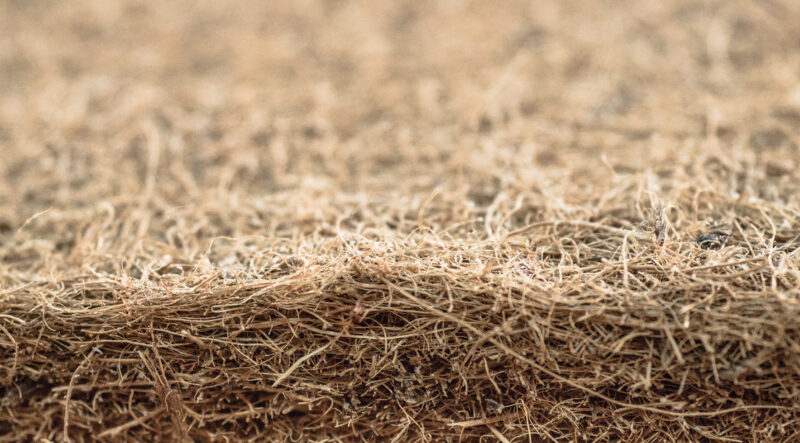
Artificial Windbreaks (Man-Made Barriers)
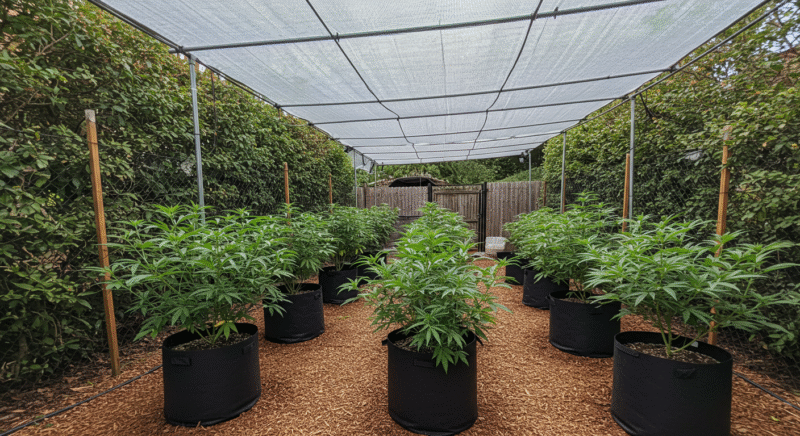
If you need immediate protection or a flexible solution, artificial windbreaks provide a practical and effective method for reducing wind. These barriers can be adjusted, moved, or even reinforced over time depending on your grow’s needs.
- Mesh Screens: Lightweight, UV-resistant mesh is a popular choice for quick and effective wind protection. It comes in various densities, allowing you to control the amount of wind you want to block. Screens are easy to install and don’t require as much maintenance as living windbreaks.
- Slatted Fences: Wooden or plastic slatted fences work well for blocking wind while still allowing air circulation. They are often used in areas with high winds because they can withstand stronger gusts without creating damaging air pressure zones.
- Shade Cloth: While often used to provide protection from excessive sunlight, shade cloth can also serve as a windbreak. Choose a cloth with a wind-reduction rating of around 50% for optimal results.
Shelter from Extreme Weather
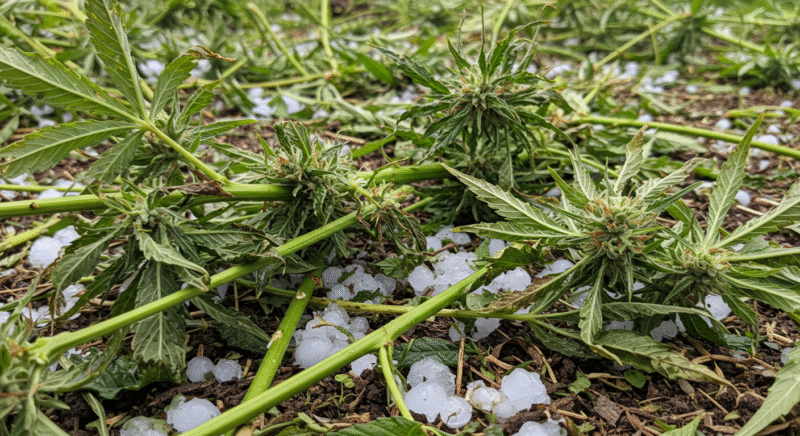
Beyond the wind, outdoor cannabis growers need to think about protection from other weather conditions, including heavy rain, hail, intense sunlight, and even early frosts. Different sheltering techniques can help mitigate the risk posed by these elements.
Rain and Hail Protection
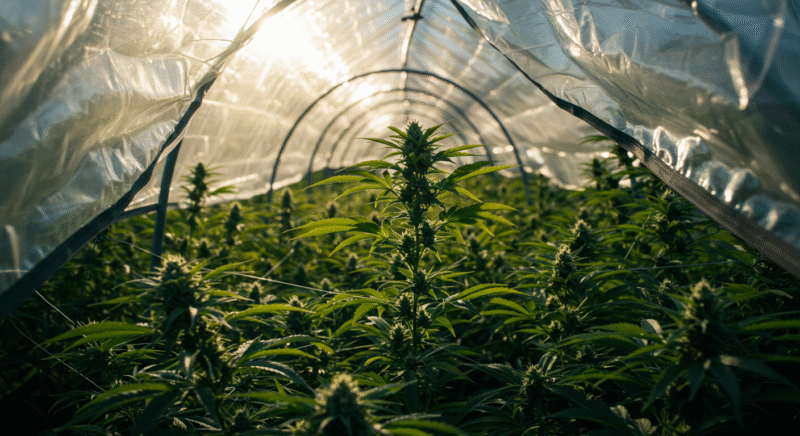
While rain is generally beneficial for outdoor cannabis, heavy downpours can saturate the soil, suffocate roots, and increase the likelihood of mold, mildew, or nutrient leaching. Worse, hail can devastate a garden in a matter of minutes by shredding leaves, breaking stems, and damaging buds.
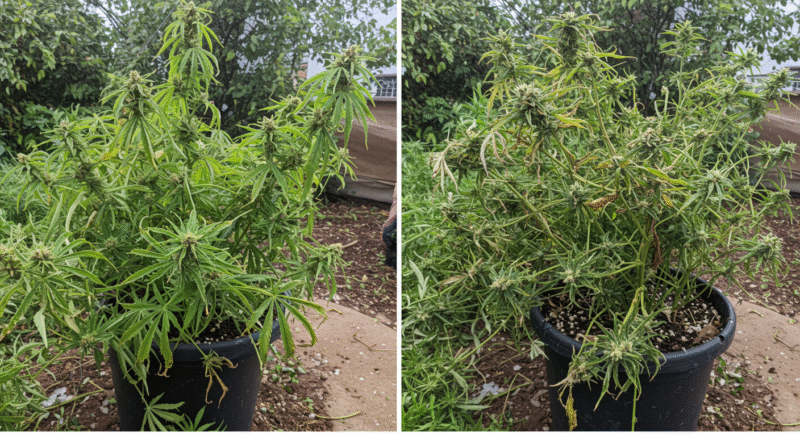
Tarp Covers and Hoop Houses: Temporary structures like tarps or hoop houses made from PVC pipes and plastic sheeting offer quick, flexible protection from rain and hail. These shelters can be easily put up during a storm and taken down when the weather clears.
Pro Tip: When using tarps, make sure they are angled to allow proper water runoff. Accumulating water can cause tarps to sag and collapse, which could damage your plants.
Greenhouses: A greenhouse or polytunnel is an excellent investment for long-term protection. These structures shield your plants from rain, hail, wind, and pests while still allowing full-spectrum sunlight to reach your crop. Greenhouses also extend your growing season by trapping heat during colder months.
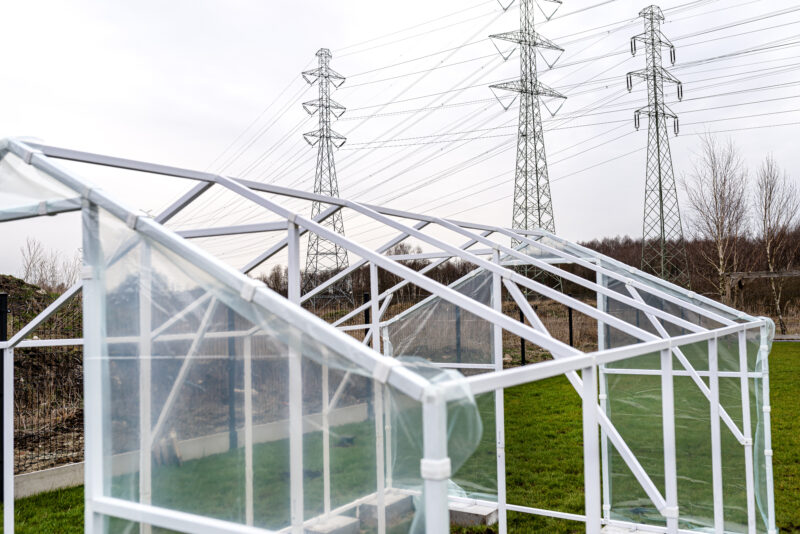
Ventilation is Key: In warm weather, greenhouses can overheat, so ensure that you have proper ventilation—either through roll-up sides, vents, or fans—to maintain optimal temperatures and humidity levels.
Netting and Covers for Hail Protection: Hail can cause sudden damage to an outdoor cannabis crop, and installing hail netting over your plants is a smart precaution. This netting can be draped over structures or fastened to stakes around your grow area to catch and disperse hail before it hits your plants.
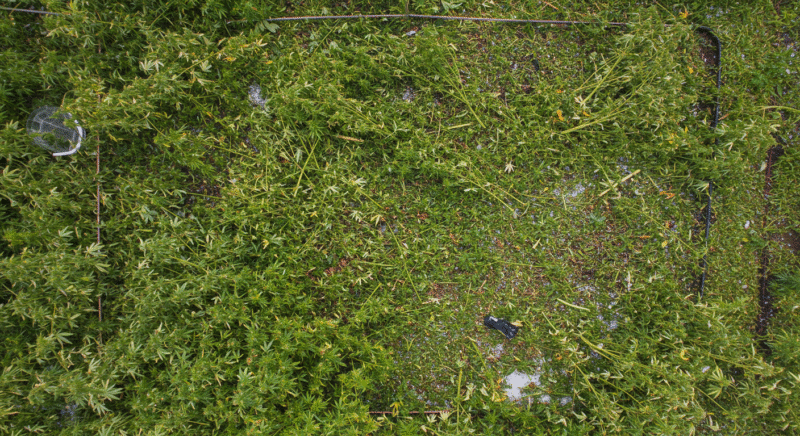
Managing Excessive Sun Exposure
While cannabis loves sunlight, intense heat and prolonged exposure to strong sunlight can lead to heat stress and sunburn, especially during peak summer months. Plants may wilt, dry out, or suffer from leaf damage if not properly protected.
Shade Cloth: A simple and effective way to manage excessive sunlight is by using a shade cloth to filter the intensity of the sun’s rays. Cannabis thrives in full sun, but during the hottest part of the day (usually midday), a 20-30% shade cloth can reduce heat stress without depriving your plants of needed light.

Pro Tip: Install shade cloth on a frame that can be easily adjusted or removed to control how much light your plants receive depending on the weather.
Security: Protecting Against Thieves, Animals, and Fire
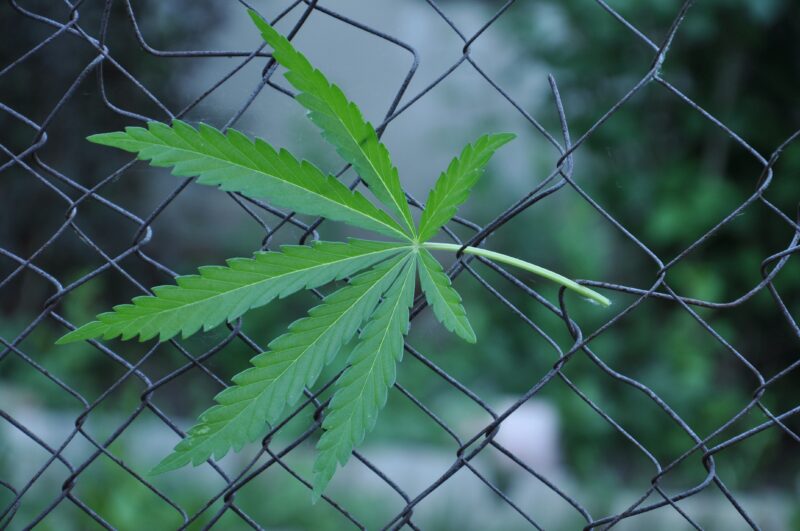
Beyond the elements, outdoor cannabis plants face additional threats such as pests, wild animals, theft, and even fire hazards. The same structures used for wind and weather protection can often serve double duty for security. Let’s explore how to protect your crop from these threats.
Animal Protection
Many animals view your cannabis plants as an attractive food source, especially during the early stages of growth. Depending on your region, threats can range from deer, rabbits, and birds to smaller pests like rodents.

Fencing for Animal Control: A sturdy fence is one of the most reliable ways to keep animals out of your garden. Different animals require different types of fencing:
- For Deer: Install a fence at least 8 feet tall. Deer are strong jumpers, and anything shorter won’t be effective.
- For Small Animals: For rabbits, groundhogs, or raccoons, use wire mesh with openings smaller than 2 inches. Bury the mesh at least 6 inches underground to prevent animals from digging beneath it.
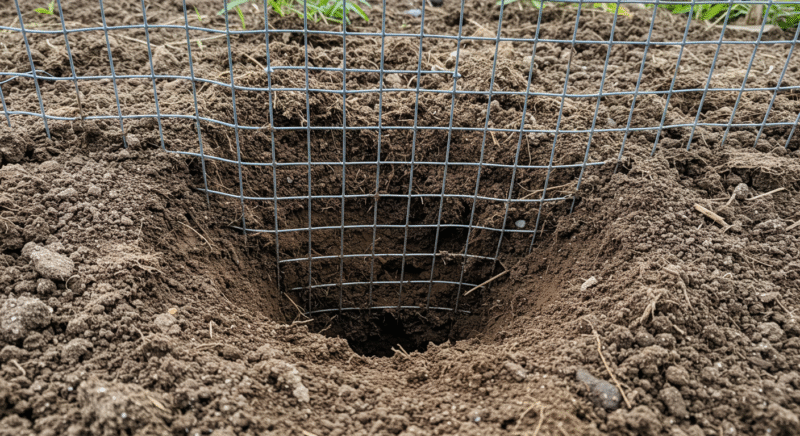
Natural Animal Deterrents:
- Strong-Smelling Herbs: Plant herbs like rosemary, mint, or lavender around the perimeter of your garden. These strong odors act as a natural deterrent for many animals.
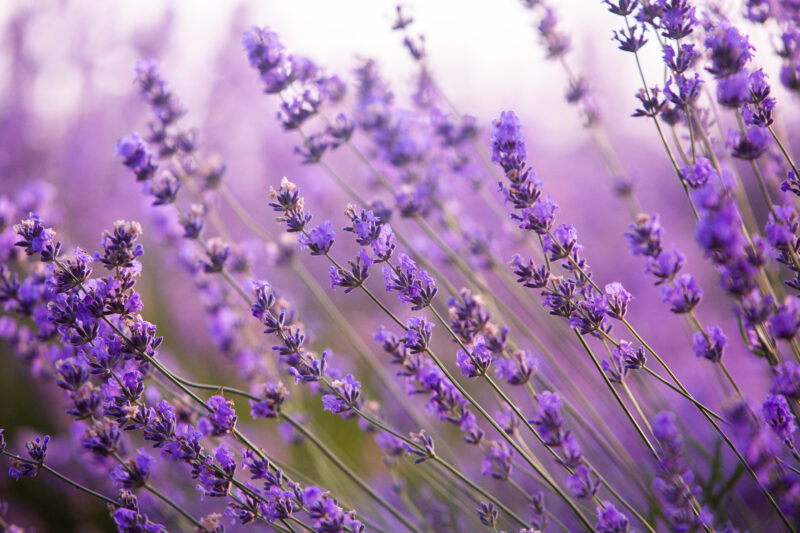
- Motion-Activated Sprinklers: Animals like deer and rabbits can be startled by sudden movement. Motion-activated sprinklers release a burst of water when triggered, scaring away unwanted intruders without harming them.

Bird Protection: Birds, especially during the flowering stage, can peck at your buds, causing significant damage.
- Bird Netting: Drape bird netting over your plants to prevent birds from landing on them.
- Scare Devices: Hanging reflective objects like old CDs, or using commercially available reflective tape, can deter birds from approaching your garden.
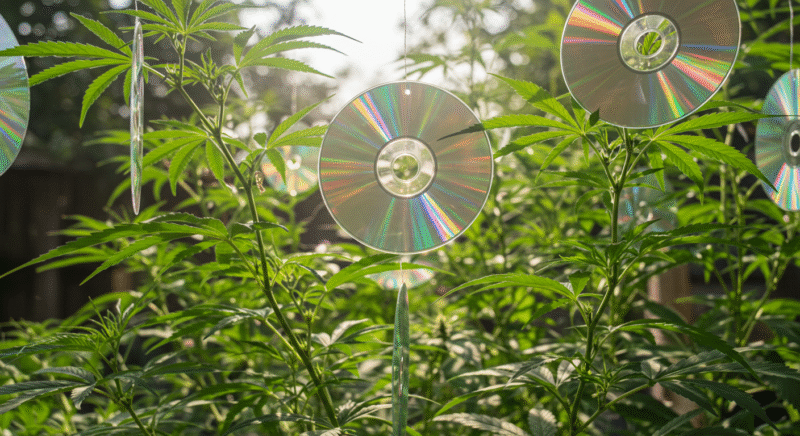
Protecting Against Theft
Outdoor cannabis plants can be tempting for thieves, especially if they are visible from the road or easily accessible. Here are several ways to deter human intruders:
Natural Concealment: The less visible your plants are, the less likely they are to be targeted. Use tall plants, shrubs, or trees as natural cover.
-
- Corn or Sunflowers: Grow corn or sunflowers around the perimeter of your garden. These fast-growing plants reach impressive heights and can conceal your cannabis plants from view.
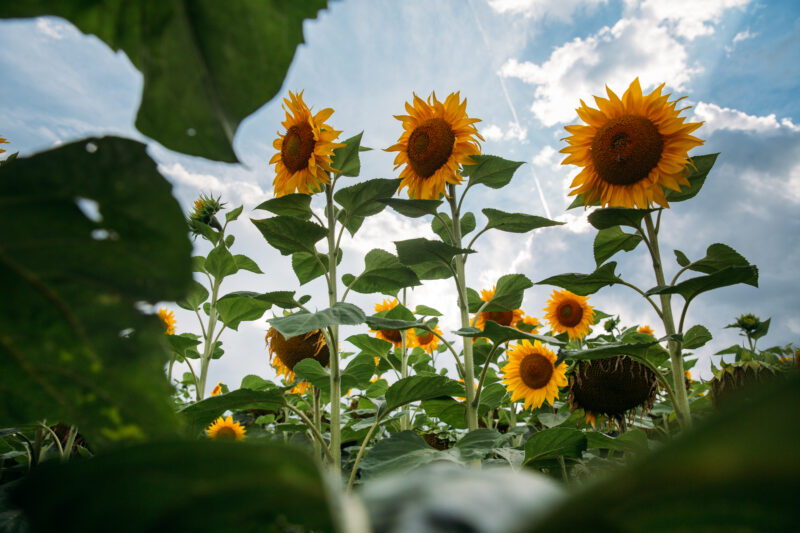
-
- Thorny Plants: Consider planting thorny shrubs like roses or blackberries around the outer edges of your garden. They create a natural barrier and make it harder for intruders to reach your plants without getting scratched.
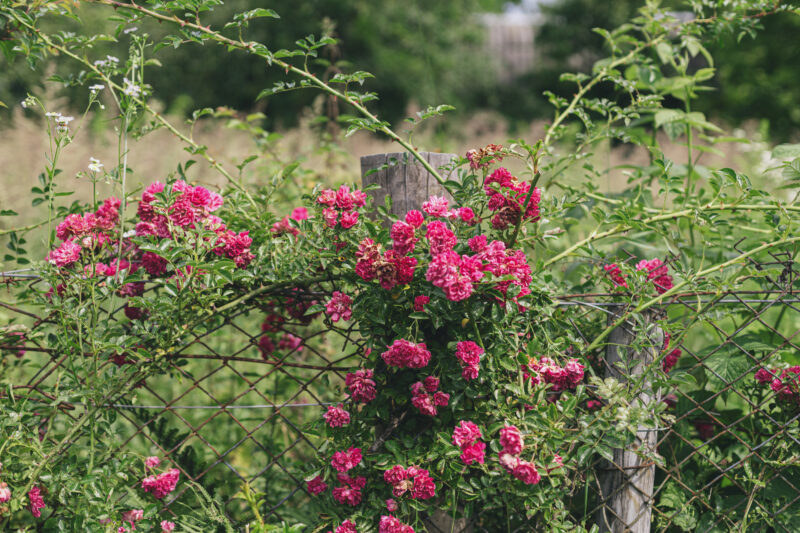
High-Security Fencing: For more serious theft deterrence, a solid, tall fence with a locked gate is your best bet.
-
- Barbed Wire Fencing: Adding barbed wire to the top of a chain-link or privacy fence increases your garden’s security by making it harder to climb or breach. This type of fencing is commonly used in high-security areas and serves as a strong visual and physical deterrent against intruders. Just make sure it complies with local regulations, especially in residential zones.

-
- Privacy Fences: A tall, solid fence that blocks the view into your grow area is ideal for keeping prying eyes away.
- Electric Fencing: If security is a major concern, installing an electric fence around your garden adds an extra layer of protection, though you should ensure it’s compliant with local laws.
Clearly visible security signage indicating surveillance cameras or guard dogs can further enhance the effectiveness of fences by providing an additional deterrent. Even if you don’t actually have guard dogs, the presence of these signs alone can discourage potential intruders.

Surveillance and Alarms: Modern technology offers excellent tools to secure your grow.
-
- Cameras: Install motion-activated cameras around your grow site. Many systems can send real-time alerts to your phone, allowing you to monitor your crop even when you’re not on-site.

-
- Motion Sensors with Lights or Alarms: Intruders are less likely to stick around if they trigger a loud noise or are suddenly bathed in bright light. These systems are inexpensive and highly effective in scaring off potential thieves.
Guard Dogs: If your grow is located on private property, having a dog can serve as both a physical deterrent and an early warning system. Dogs are especially effective at warding off nighttime intruders.
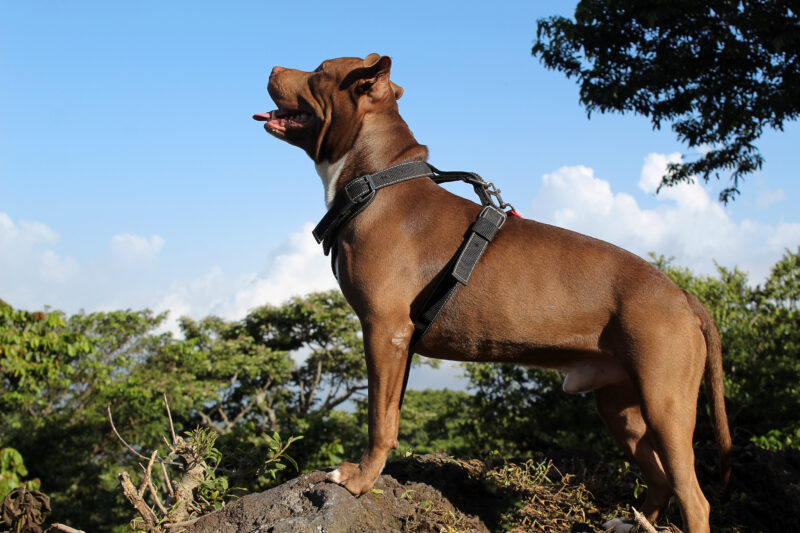
Discretion: The fewer people who know about your grow, the safer it will be. Avoid discussing your garden openly, especially with neighbors or online. Maintaining discretion is one of your strongest security tools.
Fire Safety Precautions
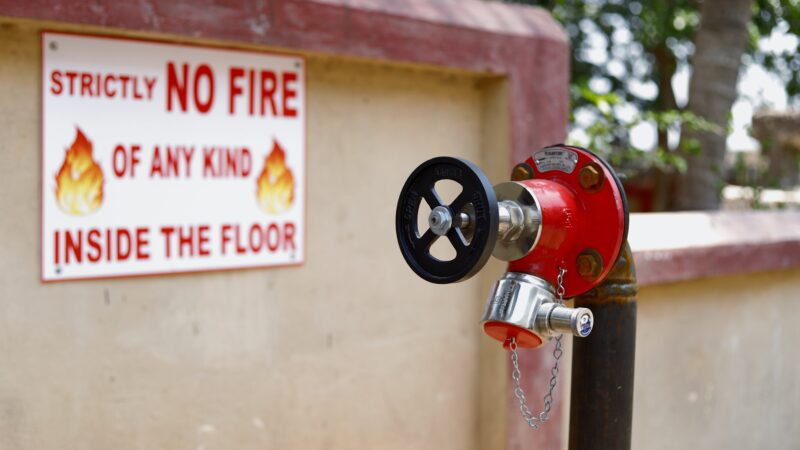
Outdoor grow operations can carry certain fire risks, particularly in dry regions or during drought conditions. Electrical equipment used in surveillance systems, electric fences, and outdoor lighting can potentially spark fires if improperly maintained or installed. Additionally, dried vegetation or improperly stored gardening materials can significantly increase fire hazards. Here are some key fire safety measures to help ensure your outdoor cannabis garden remains safe:
-
Regular Maintenance of Electrical Equipment:
Periodically check surveillance cameras, motion-activated lights, and electric fences for damaged wires, loose connections, or signs of overheating. Replace damaged components promptly. -
Proper Storage of Flammable Materials:
Keep fertilizers, pesticides, and other gardening supplies stored safely in cool, dry, and well-ventilated spaces. Avoid storing flammable liquids or gases near electrical devices or direct sunlight.
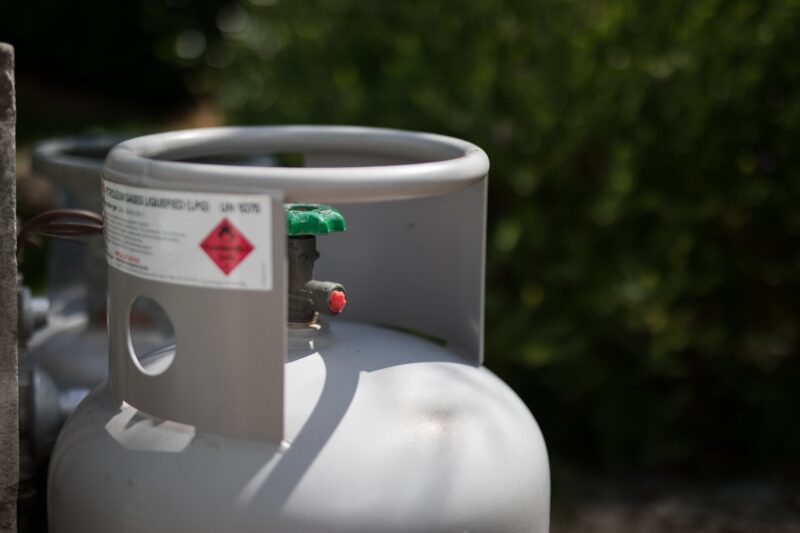
-
Clear Vegetation:
Maintain a clear buffer zone around your garden by regularly removing dead or dried plants, leaves, and branches. A clean garden lowers fire risk and makes it easier to spot security threats.
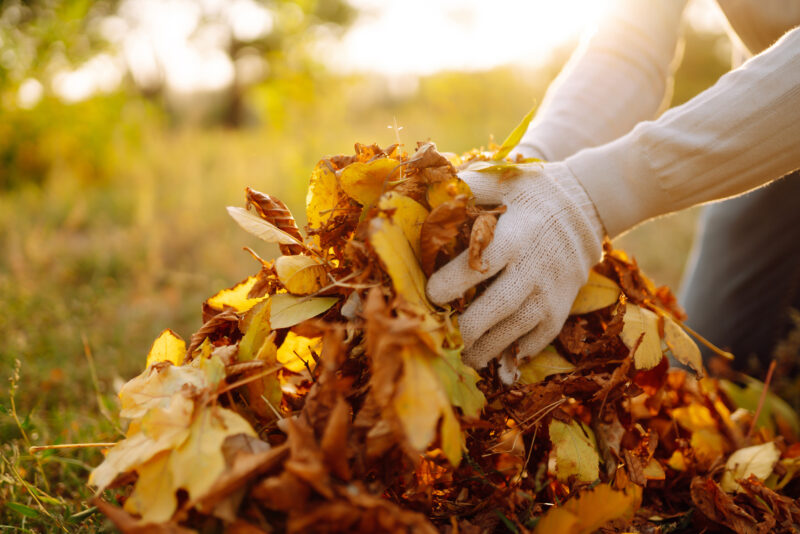
-
Fire Extinguishing Tools:
Keep basic firefighting tools readily available, including fire extinguishers, hoses, or buckets filled with sand or water. Familiarize yourself and anyone else working on your grow site with their locations and proper use.
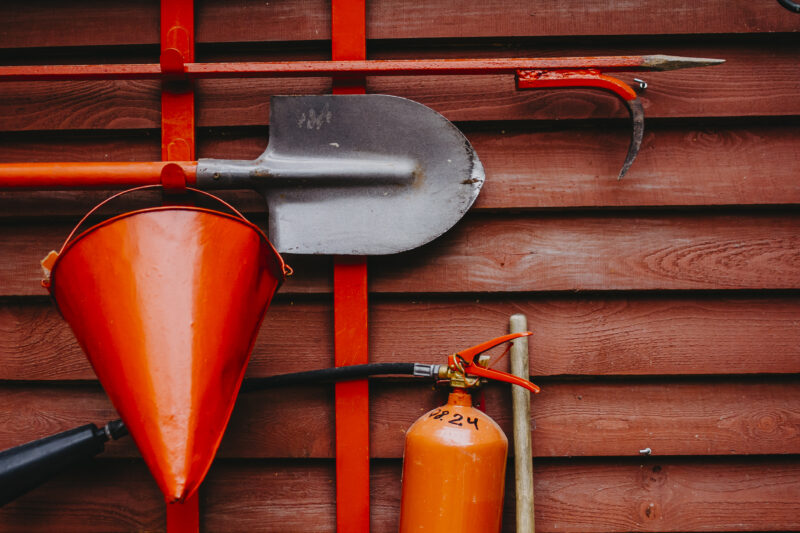
-
Emergency Access:
Ensure clear pathways to your grow area, allowing quick access for emergency responders in case of fire. Clearly mark emergency entrances or exits.
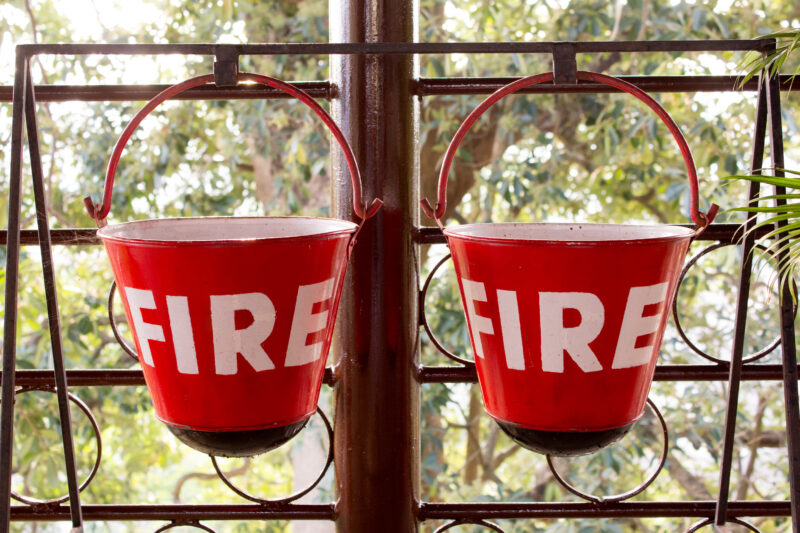
-
Local Fire Regulations:
Stay informed about local fire regulations, especially during high-risk seasons. Adhere strictly to fire bans or restrictions on equipment use issued by local authorities.
Combining Windbreaks, Shelter, and Security
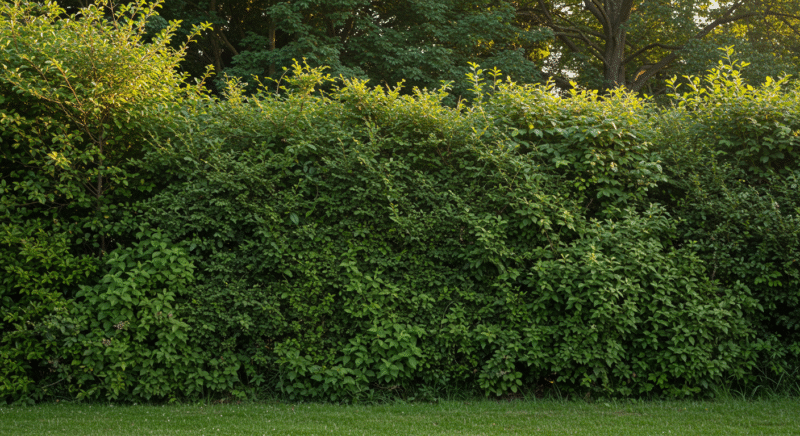
One of the best strategies for outdoor growing is to combine windbreaks, shelters, and security measures into a comprehensive system that protects your plants from the environment and secures them from animals and thieves.
- Fences as Windbreaks: Use privacy fences that double as windbreaks, sheltering your plants from the wind while keeping your garden out of sight.
- Natural Barriers for Concealment and Wind Protection: Shrubs and trees not only block wind but also act as camouflage, making it harder for intruders to spot your plants.
- Raised Beds or Greenhouses: Growing in raised beds or inside a locked greenhouse provides physical protection while allowing you to control environmental factors like wind, rain, and temperature.
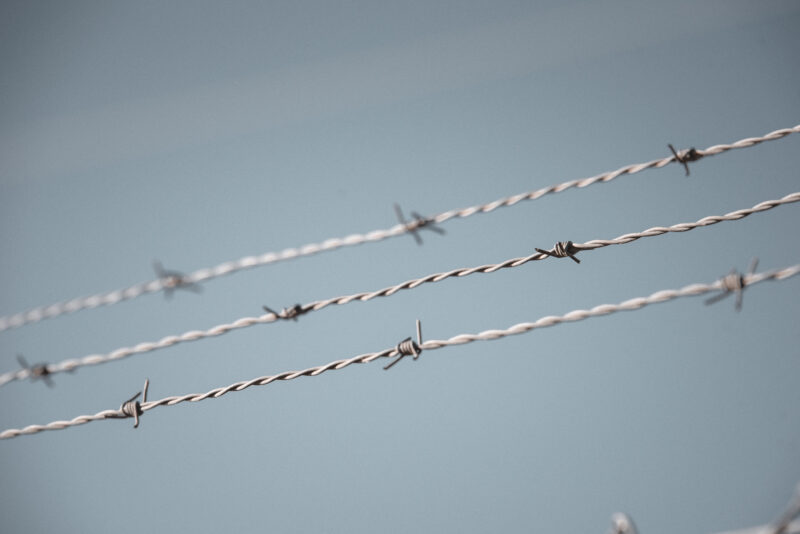
- Barbed Wire for Added Security: For growers in theft-prone or remote areas, installing barbed wire on top of fences adds a strong visual and physical deterrent. It discourages intruders from attempting to climb over and helps protect not just your plants, but also your personal safety, especially if your garden is close to your home or living space. Be sure to check local regulations before installation.
Drainage and Soil
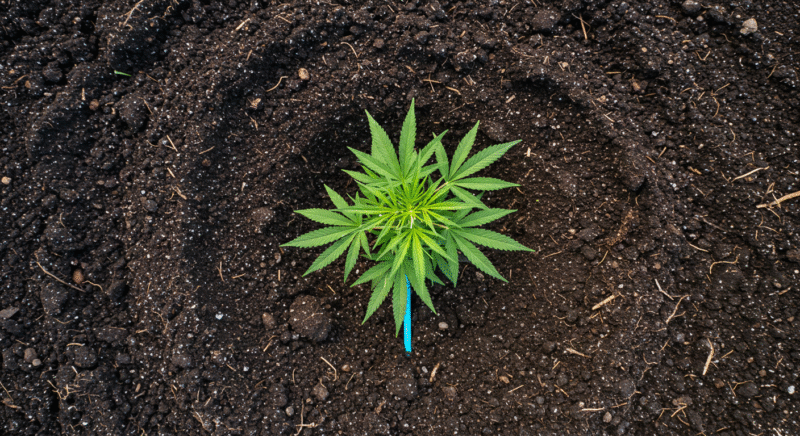
Soil is the foundation of your garden, it’s as important as sunlight and water. The quality of your soil and its ability to manage moisture directly impact your plants’ health, growth, and productivity. Proper soil composition provides essential nutrients, supports root development, and retains moisture, while effective drainage ensures that excess water doesn’t cause root rot, mold, or other moisture-related problems.
We’ll explore how to prepare and manage soil that promotes healthy cannabis growth and how to optimize drainage for different climates and growing conditions. Whether you’re planting directly in the ground, using raised beds, or growing in containers, understanding the right balance of soil structure and drainage is key to a successful outdoor cannabis grow.
Identifying Draining Locations
When cultivating cannabis outdoors, proper drainage is absolutely critical. Without well-draining soil, your plants can suffer from waterlogged roots, which leads to a host of problems such as root rot, fungal infections, and nutrient deficiencies that can kill your crop. Cannabis thrives in soil that strikes the perfect balance between retaining moisture and allowing excess water to escape. Identifying well-draining locations before planting is essential, particularly if you’re growing directly in the ground instead of using containers.
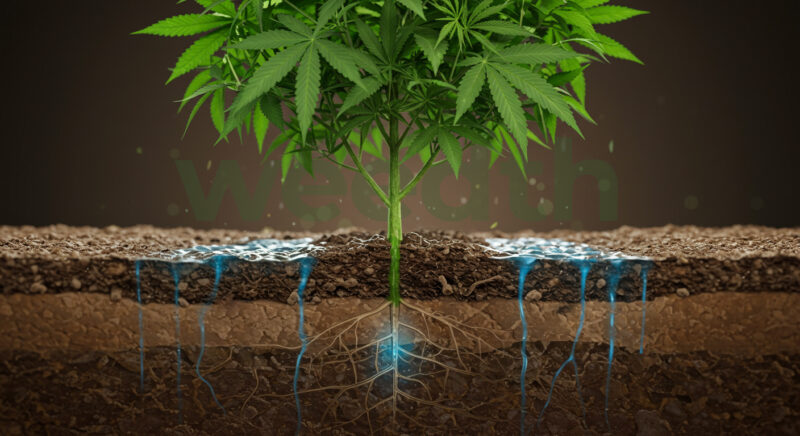
In this section, we’ll break down the key factors for identifying well-draining locations, explain how to assess potential grow sites, and point out red flags to avoid when setting up your outdoor cannabis garden.
Why Drainage Matters for Cannabis Plants
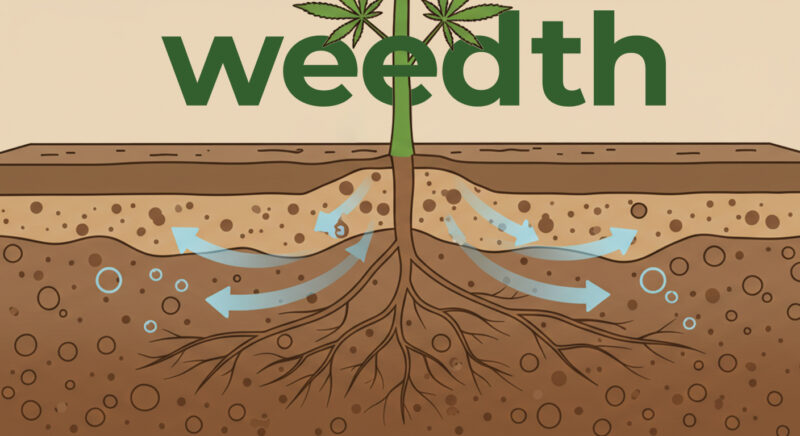
Before diving into how to identify well-draining locations, it’s important to understand why drainage is so essential for cannabis cultivation. Cannabis, while resilient, is particularly sensitive when it comes to root health. The roots need access to both water and oxygen, and proper drainage ensures they get both. If the roots sit in waterlogged soil for too long, they’re deprived of oxygen, leading to root suffocation, stunted growth, and the growth of harmful pathogens like fungi and bacteria.
Good drainage ensures that:
- Excess water is quickly drained away from the root zone, preventing soggy conditions that can suffocate the roots.
- The soil stays aerated, allowing oxygen to reach the roots.
- Nutrient leaching (when water washes nutrients away too quickly) is minimized, ensuring your plants can absorb the nutrients they need.
Key Factors to Identify Well-Draining Locations
Slope and Elevation
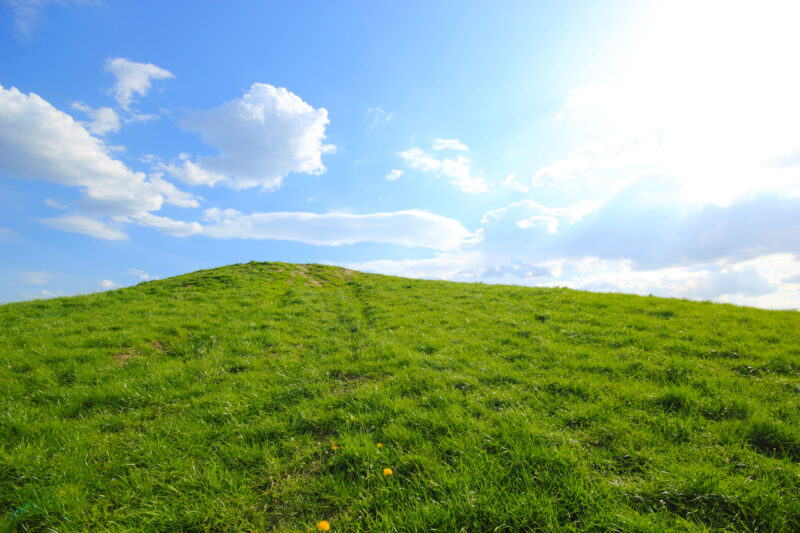
One of the first things to consider when choosing a location for your outdoor grow is the slope and elevation of the land. Water always flows downhill, so areas with a gentle slope typically have better drainage than flat or low-lying spots where water might collect and stagnate.
Gentle Slopes: A slight incline is ideal for outdoor cannabis cultivation. A slope between 2-5% is usually best, as it allows water to drain away without causing erosion or nutrient runoff.
Higher Ground: Higher elevations drain more efficiently than lower areas. If your grow site is located at the base of a hill or in a valley, water is more likely to accumulate there after rain, leading to poor drainage.
Pro Tip: Avoid steep slopes, as water might run off too quickly, taking valuable nutrients and topsoil with it before the plants have a chance to absorb them.
Avoiding Low-Lying Areas and Depressions

Low-lying areas or natural depressions in the landscape are often prone to water accumulation and are not ideal for cannabis cultivation. These spots can stay wet for days after rain or irrigation, leading to soggy roots and an increased risk of fungal diseases.
- Flood-Prone Areas: Stay away from areas that tend to flood after heavy rains. Even if these locations drain well most of the time, flooding can drown your plants or wash them away completely.
- Natural Basins or Valleys: Although valleys can sometimes create a favorable microclimate, they often trap moisture, leading to high humidity levels and poor drainage.
Note: After it rains, visit the location you’re considering for your grow. Observe any areas where water pools or lingers long after the rain has stopped. These are locations you should avoid.
Soil Testing for Drainage

The slope and elevation are important, but the soil itself plays a significant role in drainage. Before choosing a location for your grow, you’ll want to test how well the soil drains.
Here’s an easy test to assess drainage:
- Dig a Hole Test: Dig a hole about 1-2 feet deep and 1 foot wide in your potential grow site. Fill the hole with water and let it drain completely. Then, refill the hole and monitor how long it takes for the water to drain. Ideally, the water should drain within 30 minutes to an hour. If it takes several hours or longer, the soil is likely too compacted or rich in clay, and you may need to amend it or find a different location.
Pro Tip: If your soil doesn’t drain well, consider raised beds or mounds. These can significantly improve drainage by raising the plants above the poorly draining ground.
Vegetation and Ground Cover Indicators
The vegetation that grows naturally in an area can offer important clues about the drainage capabilities of the soil. Certain types of plants thrive in well-drained soils, while others prefer more water-retentive conditions.
Well-Drained Areas: Areas with grasses, wildflowers, and drought-tolerant plants like clover or dandelions typically indicate good drainage.

Poor Drainage Indicators: Moisture-loving plants like moss, ferns, or cattails suggest the area may be too wet and prone to poor drainage.
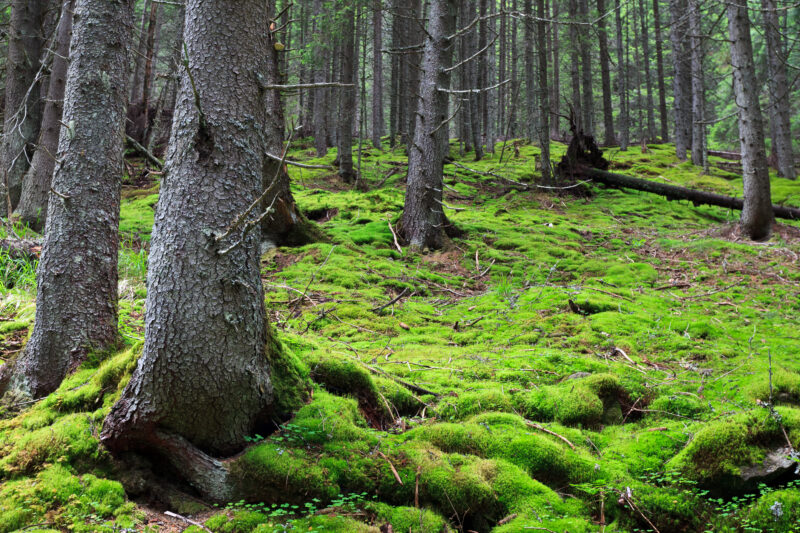
Pro Tip: In dry climates, you might need to irrigate more frequently, even in well-draining areas. Monitor soil moisture closely and adjust your watering schedule as needed to maintain the right balance.
Wind and Sun Exposure
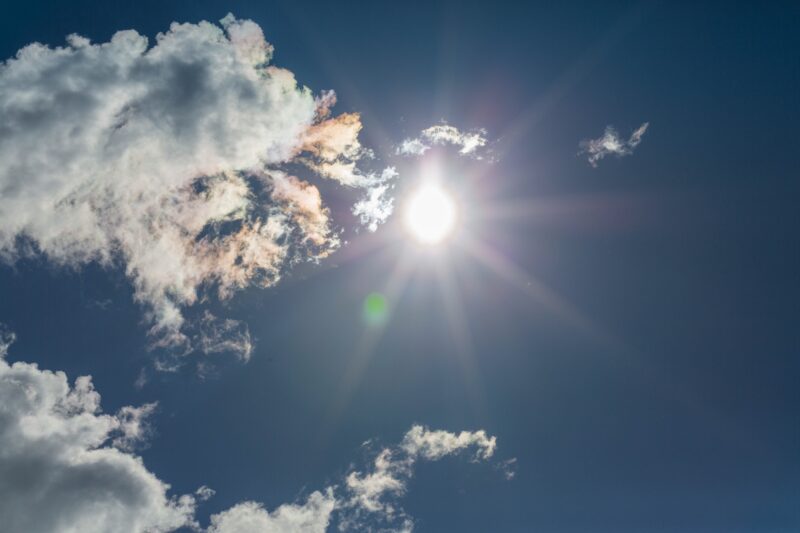
Drainage is closely tied to other environmental factors such as wind and sunlight. Sites that receive ample sunlight will naturally dry out faster after rain, promoting better drainage. Moderate wind can also help evaporate excess moisture from the soil surface.
- Full Sun Exposure: Choose a location that receives at least 6-8 hours of direct sunlight per day. Full sun helps dry out the soil and prevents water from lingering too long.
- Wind Protection: While moderate wind helps with drying, too much exposure to wind can dry out the soil too quickly or cause erosion. It’s important to find a balance between sunlight and wind protection when selecting your grow site.
Adjusting Drainage in Less-Than-Ideal Locations
If your grow site doesn’t have perfect drainage, don’t worry. There are several ways to improve drainage and make a less-than-ideal location work for cannabis cultivation.
Raised Beds
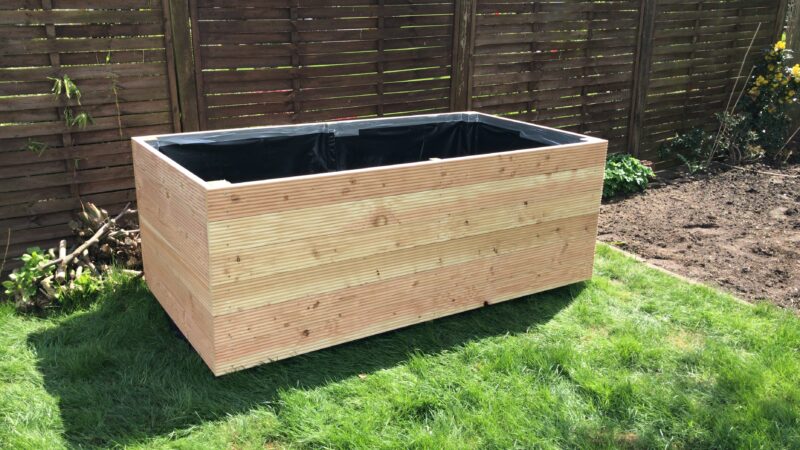
One of the most effective ways to improve drainage is by using raised beds. These beds elevate the plants above ground level, allowing water to drain away from the root zone more efficiently. You can also fill raised beds with a custom soil mix that provides the perfect balance of drainage and moisture retention.
Soil Amendments
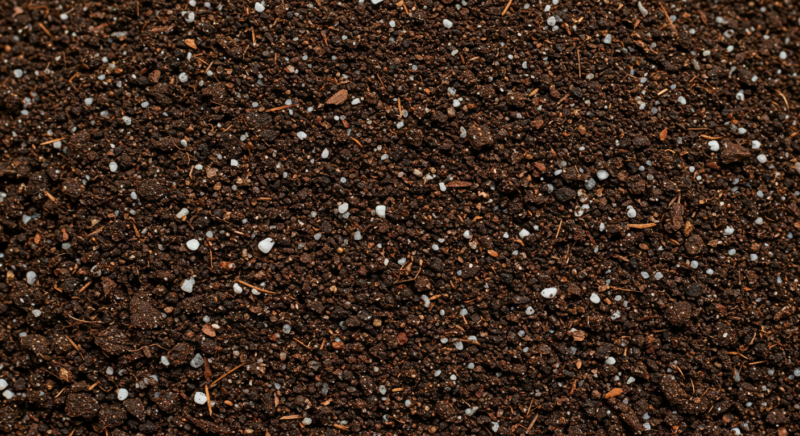
If your soil is heavy with clay or compacts easily, amending it with organic matter can improve its structure and drainage capabilities. Adding compost, perlite, or peat moss can help break up dense soils, increase aeration, and create a more hospitable environment for your cannabis roots.
French Drains or Swales
Installing drainage systems like French drains or swales can significantly improve water flow and prevent waterlogging for larger grow operations. A French drain consists of a perforated pipe buried in a gravel-filled trench, which helps channel excess water away from your grow area. Swales are shallow ditches that divert water away from your plants, ensuring they don’t sit in soggy soil.
Assessing Natural Soil Quality and Texture
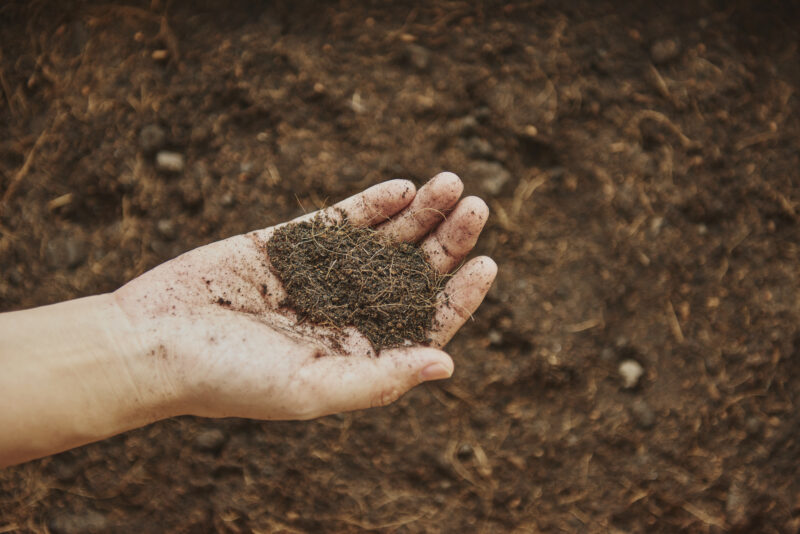
When growing cannabis outdoors, the soil you choose can make or break your crop. The health and productivity of your cannabis plants largely depend on the quality of the soil, which acts as the primary medium through which they receive water, nutrients, and oxygen. The texture of the soil whether it’s sandy, loamy, or clay-heavy also plays a crucial role in water retention, drainage, and root development. In this article, we’ll dive deep into how to assess the natural soil quality and texture at your grow site, ensuring that your cannabis plants are rooted in the best possible environment.
Why Soil Quality Matters for Cannabis
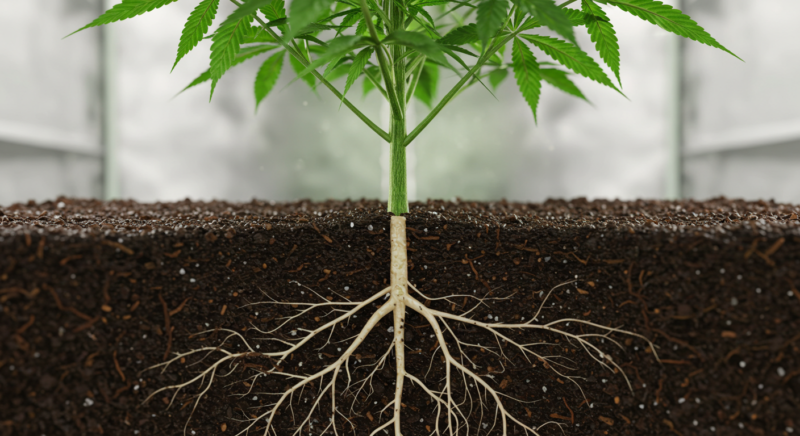
Cannabis is a versatile plant, but it thrives best in soil that offers a delicate balance of nutrients, moisture, and aeration. The right soil can support healthy root growth, provide essential nutrients, and retain moisture without becoming waterlogged. On the other hand, poor-quality soil can lead to a host of issues, including nutrient deficiencies, root rot, and stunted growth.
Healthy, well-structured soil allows cannabis plants to develop strong, extensive root systems, which in turn help support vigorous vegetative growth and maximize yields. Understanding your soil’s natural quality and texture will help you decide whether any amendments are needed before planting and what kind of maintenance your outdoor grow may require throughout the season.
Basic Components of Soil

Before assessing soil quality, it’s essential to understand the three primary components of soil:
Sand: This is the coarsest soil type, with large particles that allow for good drainage and aeration but poor nutrient retention. Sandy soils are fast-draining but often require more frequent watering and fertilization to keep cannabis plants thriving.

Silt: Finer than sand but coarser than clay, silt has moderate drainage and moisture retention. It is rich in nutrients and is considered fertile but may compact easily, limiting root aeration.
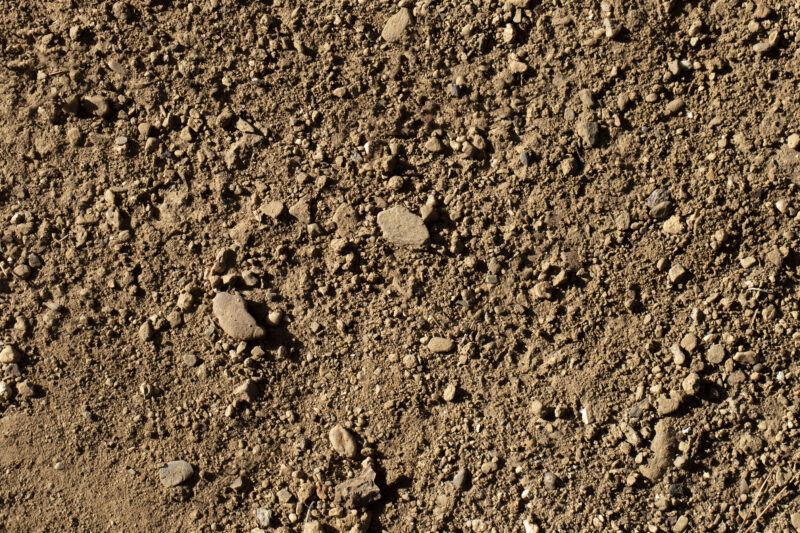
Clay: The smallest soil particles are found in clay. It holds water and nutrients well but can easily become compacted, leading to poor drainage and insufficient oxygen supply for roots.

Loam is considered the ideal soil for cannabis cultivation. It’s a balanced mix of sand, silt, and clay that offers good drainage, nutrient retention, and root aeration. The goal is to find or amend your natural soil to create a loamy texture for optimal cannabis growth.
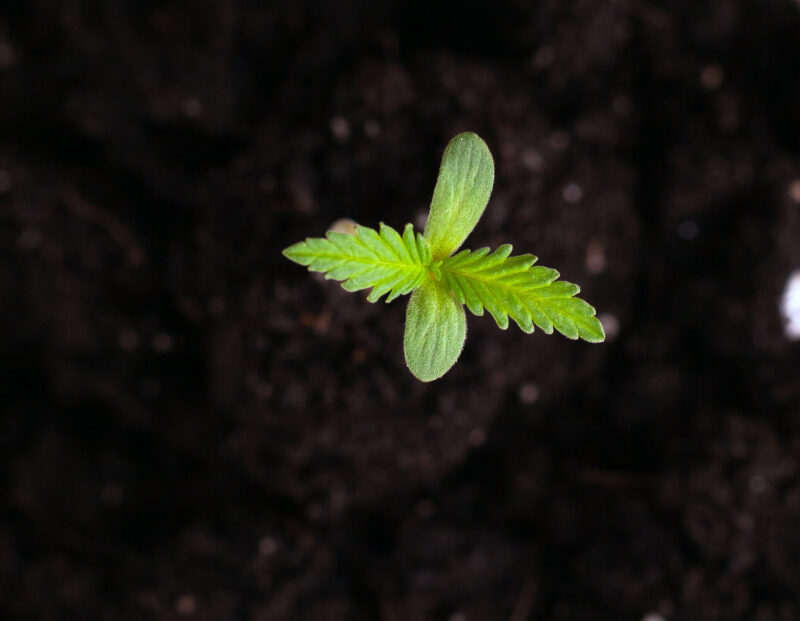
Simple Soil Tests You Can Do
The best way to determine the quality and texture of your soil is by getting your hands dirty, literally. Here are a few simple tests you can do to assess the natural soil quality and texture at your outdoor grow site:
Soil Texture Test
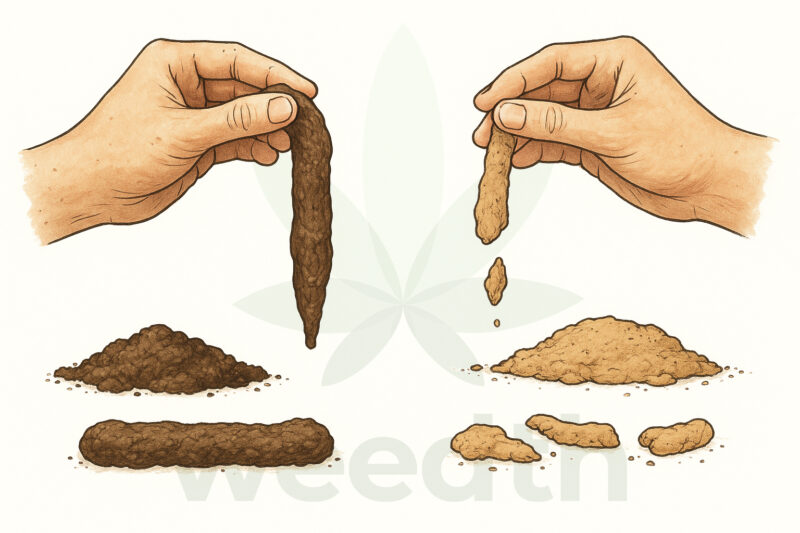
To get a quick sense of your soil’s composition, take a handful of soil, moisten it with a little water, and rub it between your fingers.
- Sandy soil feels gritty and won’t hold its shape when squeezed.
- Silty soil feels smooth or slippery and may form a loose, crumbly ball when pressed.
- Clay soil feels sticky or heavy, forming a firm ball when pressed.
The texture test will give you a general idea of whether you’re working with predominantly sandy, silty, or clay soil. Ideally, you want a soil that feels somewhat gritty yet can hold its shape when squeezed, indicating a loamy composition with a good balance of drainage and moisture retention.
Organic Matter: The Key to Nutrient-Rich Soil
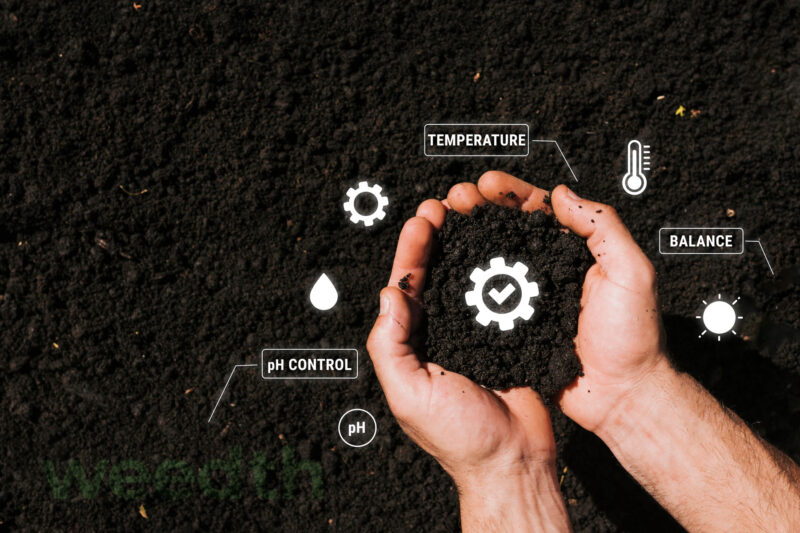
Healthy soil is rich in organic matter, composed of decomposed plant material, microbes, and other organisms. Organic matter improves soil structure, helps retain moisture, and provides a slow-release source of nutrients as it breaks down. Compost, humus, and manure are all examples of organic matter that can boost soil fertility.
Signs of high organic matter content include:
Dark color: Soil rich in organic matter tends to be dark brown or black.
Crumbly texture: Well-structured soil with lots of organic matter will feel loose and crumbly, making it easy for roots to spread.
Earthworms: If you see earthworms in your soil, that’s a great sign! They indicate a healthy, living soil ecosystem full of beneficial organisms that improve fertility.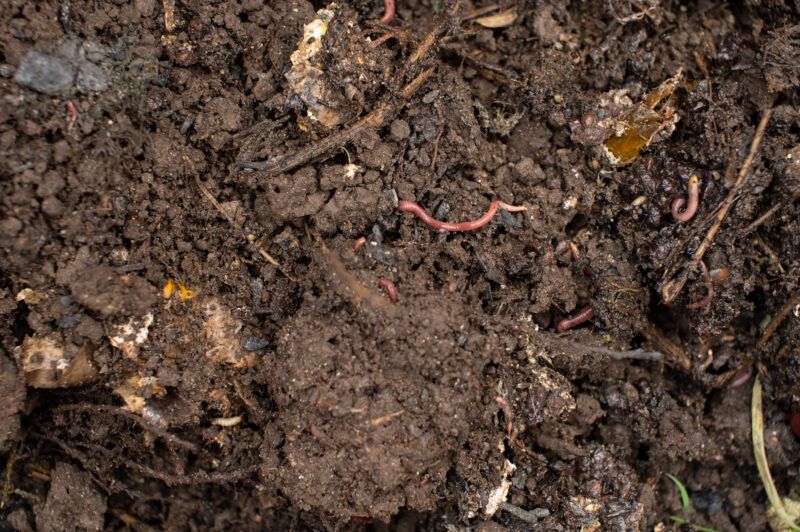
The Ribbon Test
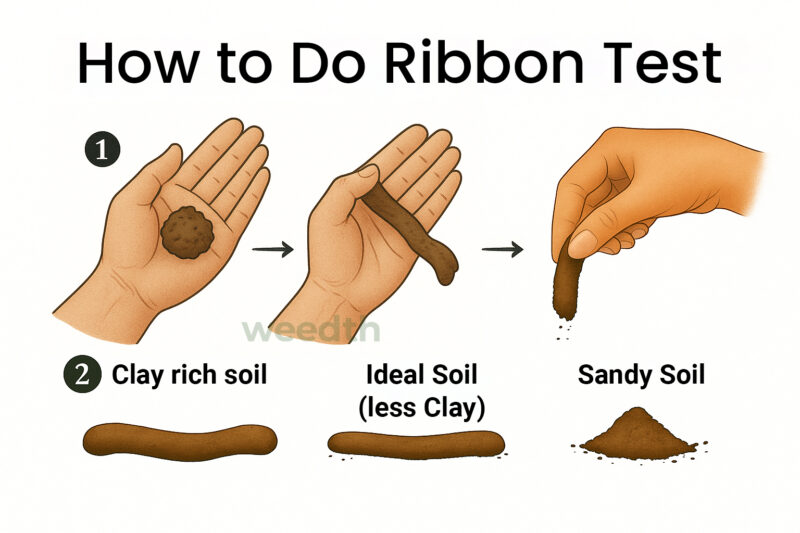
The ribbon test is another way to evaluate the clay content in your soil. Take a small amount of moist soil and roll it between your palms to form a ribbon or rope shape.
- If you can easily form a ribbon longer than 2 inches before it breaks, your soil has a high clay content.
- If the ribbon breaks before reaching 2 inches, your soil contains less clay, which is generally better for cannabis.
Clay-heavy soil is dense and retains water, which can suffocate the roots of cannabis plants, making them more susceptible to root rot and fungal issues. On the other hand, sandy soils may not hold together at all, meaning they’ll drain too quickly, potentially leading to dehydration and nutrient leaching.
Drainage Test
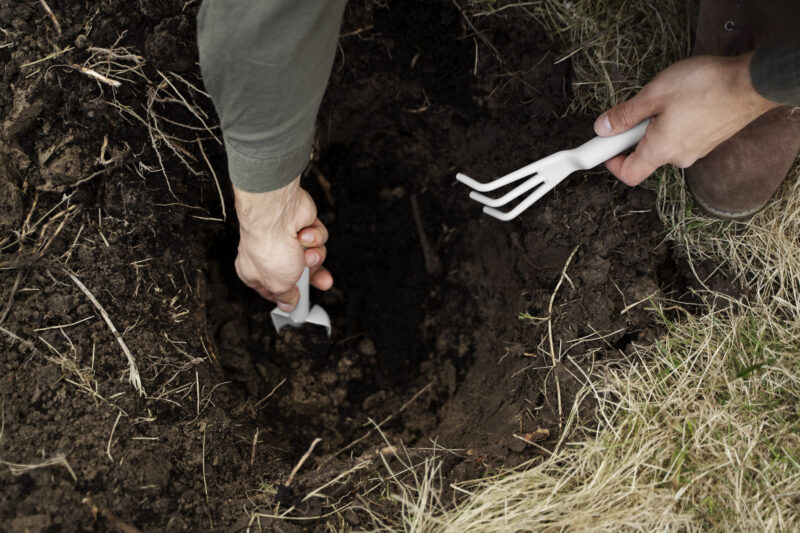
Drainage is crucial when growing cannabis outdoors, as poor drainage can lead to waterlogged roots, which can severely stunt growth or kill your plants. To test your soil’s drainage:
- Dig a hole approximately 1-2 feet deep and 1 foot wide in your prospective grow area.
- Fill the hole with water and let it drain completely.
- Refill the hole and time how long it takes for the water to drain.
If the water drains within 30 minutes to an hour, you have well-draining soil. If it takes several hours or more, the soil may be too compacted or clay-heavy. In this case, you might need to improve the drainage by adding organic matter or sand to the soil, or consider using raised beds.
Compaction Test
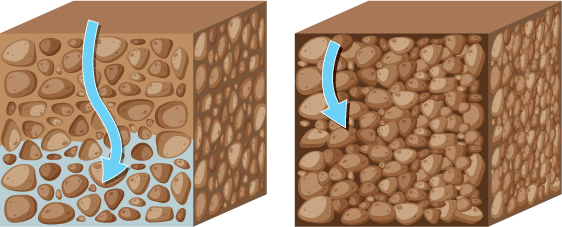
Soil compaction limits root growth and reduces aeration, making it harder for cannabis plants to access water and nutrients. You can test your soil for compaction by simply pushing a stick or shovel into the soil. If the stick easily sinks in, the soil is loose and well-aerated. If it’s difficult to penetrate, the soil is compacted and may require loosening or amendment before planting.
Soil pH Test
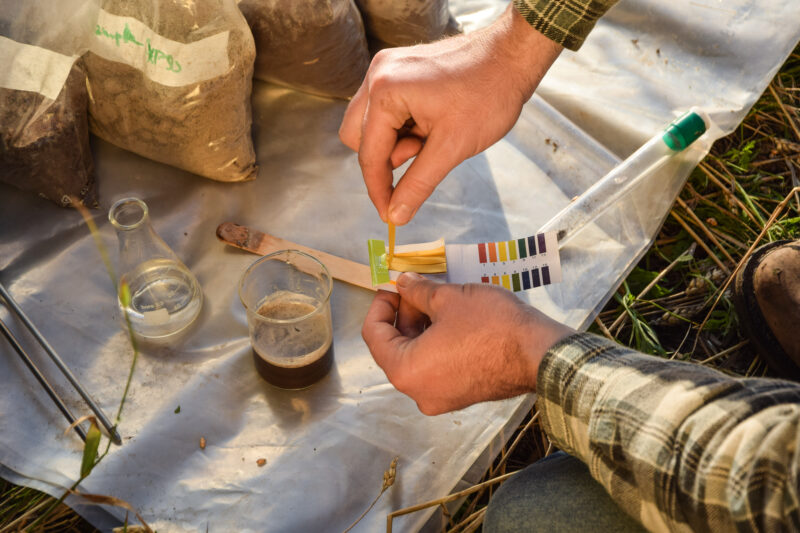
The pH of your soil is just as important as its nutrient content. Cannabis plants prefer a slightly acidic pH, between 6.0 and 7.0. If the soil is too acidic (below 6.0) or too alkaline (above 7.0), your plants will struggle to absorb the nutrients they need, even if those nutrients are present in the soil.
To test your soil’s pH:
Soil pH test kits: These are simple to use and can give you an accurate reading of your soil’s acidity or alkalinity.
pH meters: For a more precise reading, a digital pH meter is a great tool, especially if you plan to monitor the soil throughout the grow season.
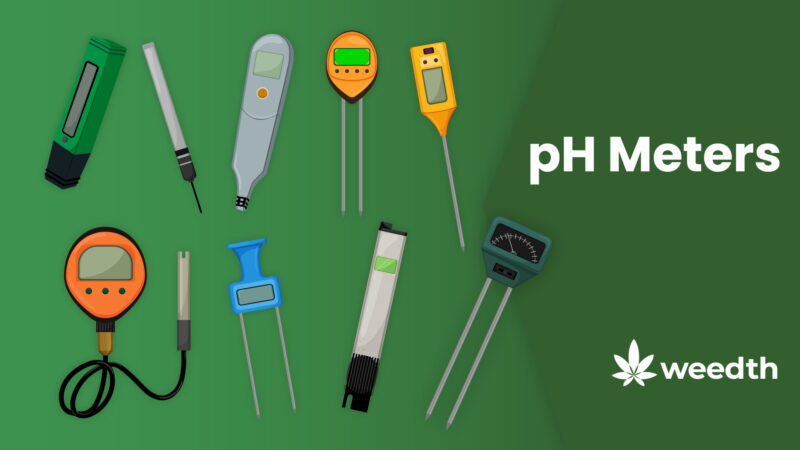
Adjusting pH
If your soil’s pH is out of range, here’s how to adjust it:
- To raise pH (for more alkaline soil): Add dolomitic lime or wood ash. These materials are best applied in the fall so they have time to adjust the soil before planting in the spring.
- To lower pH (for more acidic soil): Add sulfur, peat moss, or pine needles. Be cautious with sulfur, as it can take time to work, and adding too much too quickly can overshoot your target pH.
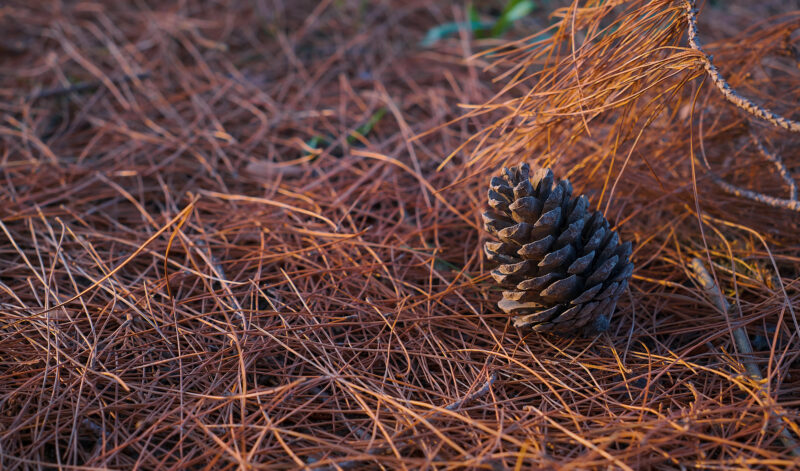
Pro Tip: Adjust pH gradually. Extreme swings in pH can shock your plants, leading to nutrient lockout or stress. It’s better to adjust in small increments and re-test regularly.
Testing for Nutrients
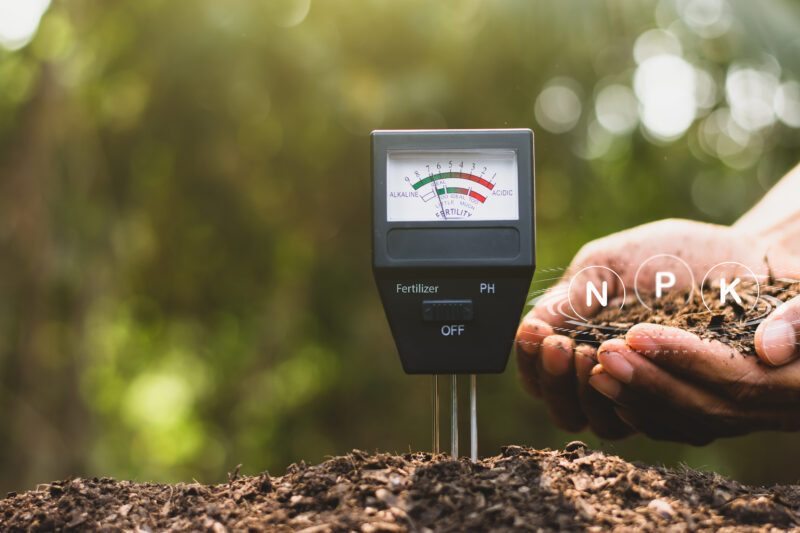
Cannabis plants need a balance of three primary nutrients: nitrogen (N), phosphorus (P), and potassium (K)—often referred to as NPK. These nutrients, along with secondary elements like calcium, magnesium, and sulfur, support different stages of plant growth. Nitrogen promotes leafy growth, phosphorus supports root development and flowering, and potassium aids in overall plant health and resilience.
While you can visually inspect your soil, the best way to know what nutrients are present is through soil testing kits. These kits are available at garden centers or online and give you a basic reading of the soil’s nutrient levels.
- Nitrogen Deficiency: If the leaves of your cannabis plants are yellowing from the bottom up, your soil might be low in nitrogen.
- Phosphorus Deficiency: A lack of phosphorus often shows up as purple or dark discoloration in the stems and leaves.
- Potassium Deficiency: Potassium deficiency may cause yellowing along the edges of leaves or brown spots, especially on older foliage.
Observing the Natural Vegetation
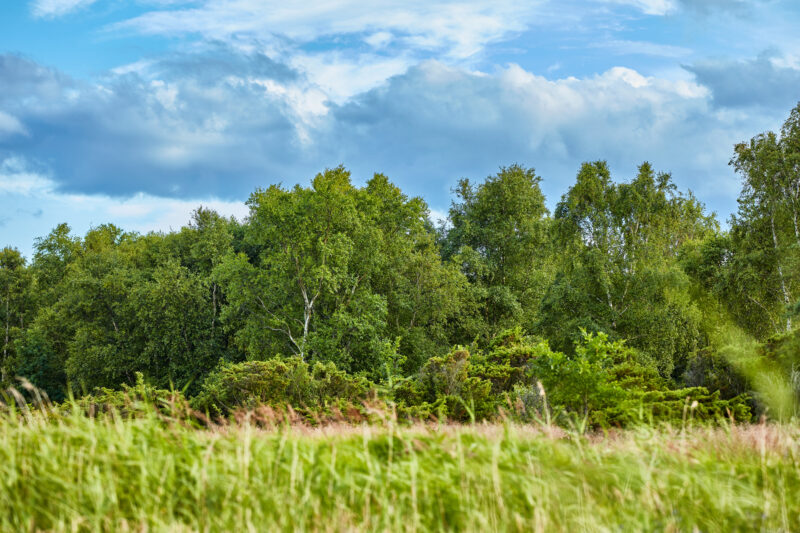
Another excellent way to assess soil quality is by observing the types of plants already growing in your potential grow area. The presence of certain plants can give you clues about the soil’s fertility and drainage capabilities.
Remember:
Healthy native grasses and wildflowers: These are good indicators of well-draining, fertile soil.
Moss, ferns, or other moisture-loving plants: These suggest the area may have poor drainage or be too wet for cannabis.
Additionally, check for signs of soil erosion or compaction. Soil that erodes easily is often too loose or sandy, while soil with a crusted surface may be compacted and difficult for roots to penetrate.
Amending Soil for Optimal Texture and Quality
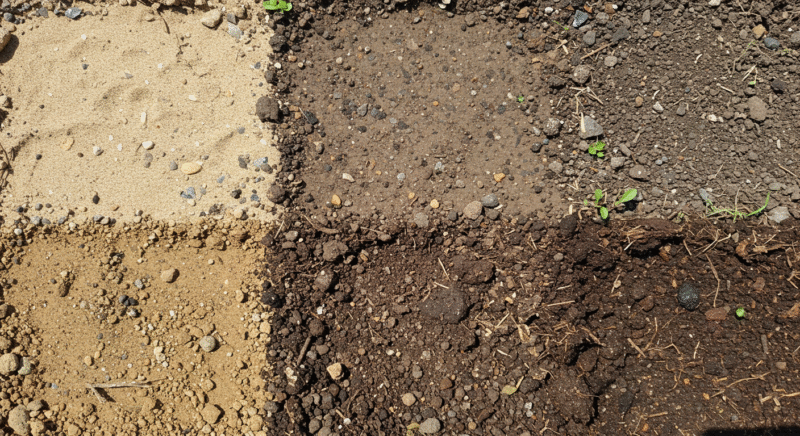
If your soil doesn’t quite meet the ideal conditions for growing cannabis, don’t worry most soil can be amended to suit your plants’ needs. Here are some common amendments to improve soil texture and quality:
Improving Soil Texture
- Clay Soils: If your soil is too clay-heavy, amend it with organic matter like compost or well-rotted manure, which will improve aeration and drainage. Adding perlite or sand can also help loosen the soil, making it easier for water to drain and roots to breathe.
- Sandy Soils: Sandy soils drain too quickly and often lack nutrients. Adding organic matter like compost, coconut coir, or peat moss helps sandy soils retain moisture and nutrients. You can also mix in vermiculite to increase water-holding capacity.
- Silty Soils: These soils are usually pretty good for cannabis but can benefit from the addition of compost or well-rotted manure to further improve fertility and structure. Silty soils can compact easily, so keep an eye on soil aeration.
Boosting Organic Matter and Nutrients
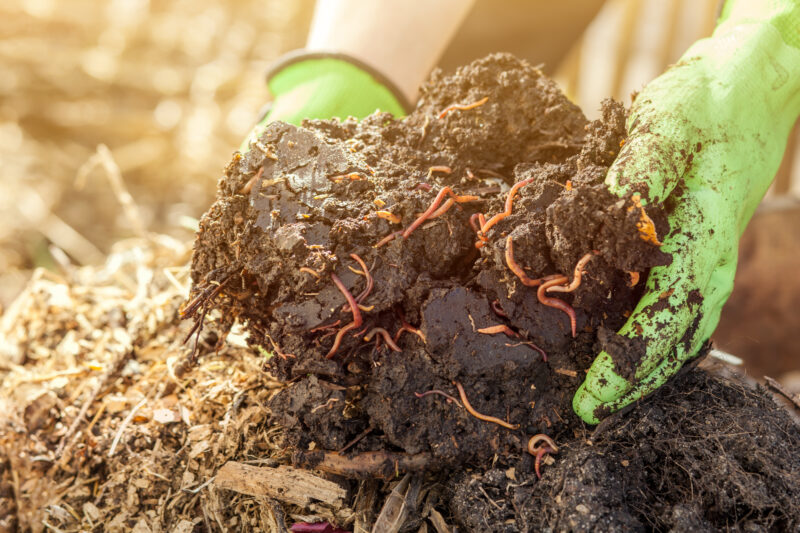
- Compost: Rich in nutrients and beneficial microbes, compost is one of the best soil amendments. It improves soil structure, moisture retention, and nutrient availability. Apply a generous layer of compost and mix it into the top 6-12 inches of soil.
- Manure: Well-aged manure (from cows, horses, or chickens) is another excellent source of organic matter and nutrients. Just make sure it’s fully composted to avoid burning your plants with excess nitrogen.
- Worm Castings: Worm castings are packed with nutrients and beneficial microbes that boost soil health and plant growth. They can be mixed into the soil or applied as a top dressing.
Preparing the Soil

Healthy, nutrient-rich soil ensures your plants develop strong roots, absorb essential nutrients, and thrive throughout their life cycle. Whether you’re working with natural soil in your backyard, a remote guerrilla growing location, or a custom-built raised bed, preparing the soil properly will set the stage for a bountiful harvest. Your plants will have everything they need with the right preparation to flourish under the sun.
What is Soil Composition?
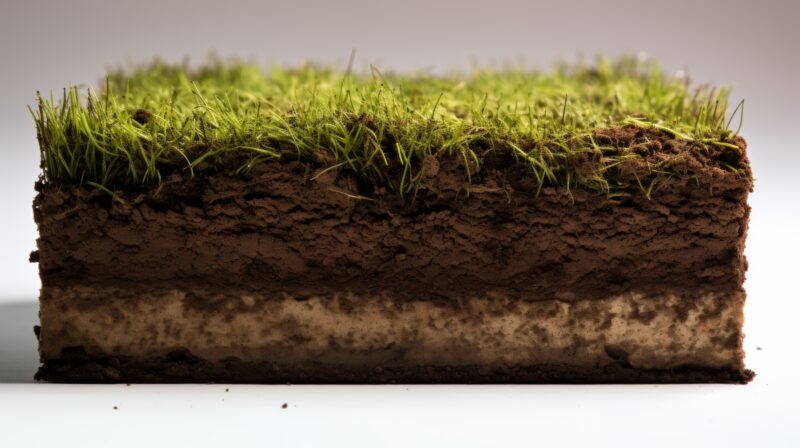
Soil composition refers to the proportion of minerals, organic matter, air, and water in the soil. The ideal soil has a balance of all these components, each playing a vital role in plant health:
- Mineral Content: The mineral particles in soil(sand, silt, and clay)determine the soil’s texture, structure, and drainage ability.
- Organic Matter: Composed of decomposed plant material, animal waste, and microorganisms, organic matter is essential for nutrient availability, water retention, and soil structure.
- Air: Roots need oxygen to absorb nutrients and grow. Good soil has enough air spaces, or pores, to prevent compaction and encourage healthy root development.
- Water: Proper moisture retention is critical for cannabis, as it allows nutrients to be accessible to the roots without waterlogging the soil.
Each soil type(sandy, clayey, or loamy)has a unique mix of these elements, impacting drainage, nutrient retention, and root growth.
Building the Perfect Growing Medium

Before diving into specific soil types, it’s essential to understand the components that make up healthy soil. Soil comprises three primary particles: sand, silt, and clay. These particles’ proportions define the soil’s texture affecting drainage, nutrient retention, and aeration. Each particle type has distinct properties:
- Sand: The largest soil particles. Sandy soil is gritty to the touch, and it drains water quickly, which helps prevent waterlogging and can lead to nutrient leaching. Sandy soils tend to be low in nutrients unless amended.
- Silt: Medium-sized particles. Silt feels smooth and powdery when dry. It retains more moisture than sand and is more fertile, making it a good balance for drainage and water retention. However, silty soils can become compacted, reducing aeration.
- Clay: The smallest particles. Clay is sticky and retains water exceptionally well, but it often drains poorly and compacts easily, limiting root growth and oxygen availability. While clay is nutrient-rich, its poor structure can make those nutrients less accessible to plants.
What Makes Loam Soil Ideal for Cannabis?
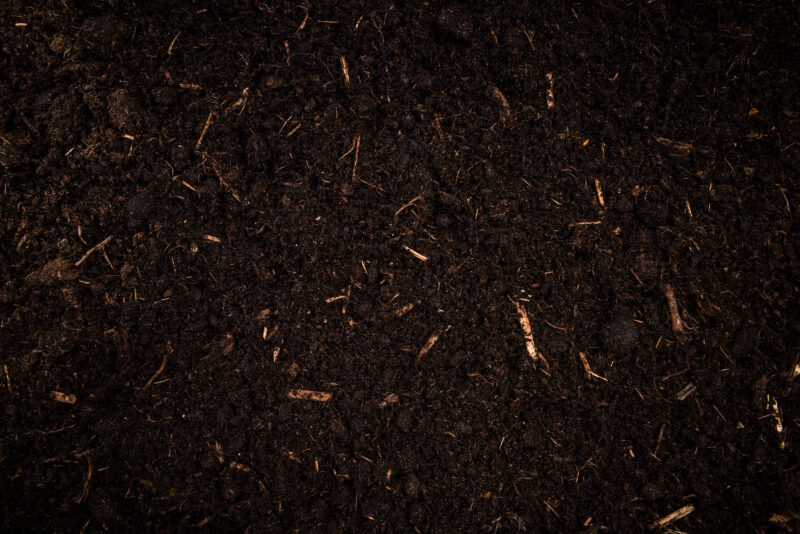
When growing cannabis outdoors, the ideal soil type is often called loam. Loam soil is a well-balanced blend of sand, silt, and clay, typically composed of about 40% sand, 40% silt, and 20% clay. This combination provides the best of all worlds—excellent drainage, moisture retention, and nutrient availability—while maintaining proper aeration for healthy root development.
Let’s explore why loam is so effective for cannabis grow:
Balanced Drainage and Water Retention
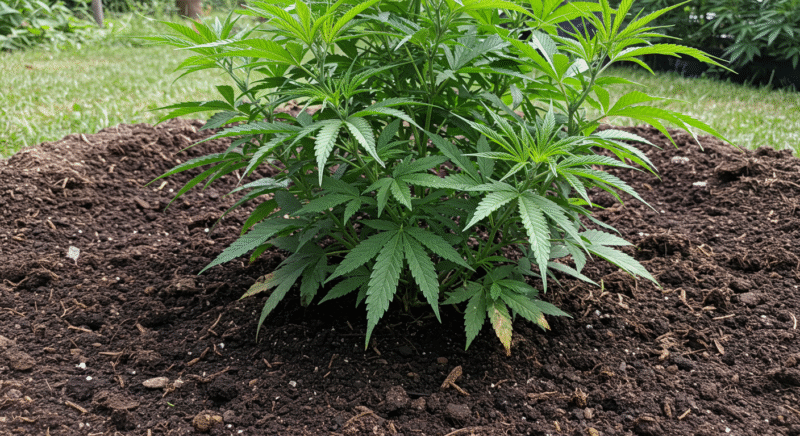
Cannabis plants are sensitive to both under-watering and over-watering. Loam soil strikes the perfect balance between holding enough moisture to keep your plants hydrated while allowing excess water to drain away efficiently. This prevents the roots from sitting in water for too long, which can lead to root rot or fungal infections.
- Sandy content in loam provides quick drainage, ensuring that water doesn’t stagnate in the soil.
- Clay content retains enough moisture to keep the plants hydrated during dry spells.
- Silt improves moisture retention without compromising drainage, making loam soil particularly well-suited to cannabis, which needs consistent but not excessive watering.
Nutrient Retention and Availability
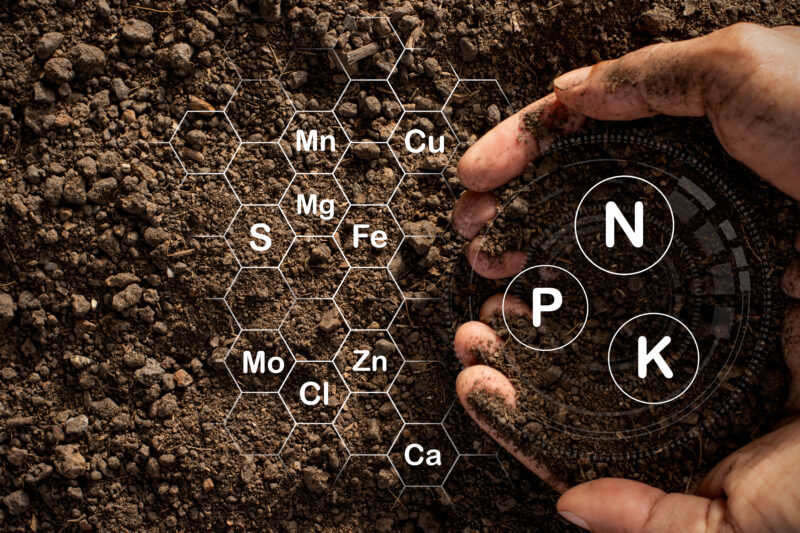
Loam soil is naturally fertile because its combination of silt and clay particles retains nutrients well. The clay and silt particles have a higher cation exchange capacity (CEC), meaning they hold onto essential nutrients like nitrogen, phosphorus, and potassium and slowly release them to the plant as needed.
- Clay particles have a high capacity to bind with nutrients, ensuring that essential elements don’t leach away with water.
- Silt particles help make these nutrients more available to the roots.
This slow release of nutrients is ideal for cannabis plants, which require different amounts of nutrients at various stages of growth. Loamy soils can maintain a steady supply of nutrients, reducing the need for constant fertilization.
Good Aeration and Root Penetration
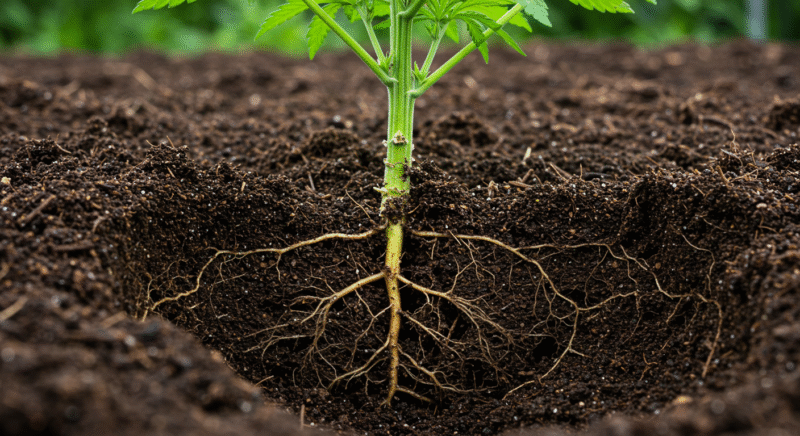
Cannabis plants need well-aerated soil for healthy root growth. Roots require oxygen to absorb nutrients and water effectively, and compacted soil can suffocate the roots by limiting air flow. The balance of sand and silt in loam provides loose, aerated soil that allows roots to grow deep and access nutrients and water more efficiently.
- Sand creates space between soil particles, allowing air to circulate.
- Silt ensures that the soil doesn’t become too dense, which is crucial for root development and oxygen absorption.
With well-aerated loam soil, roots can expand quickly, supporting vigorous plant growth and larger yields.
Microbial Life and Organic Matter
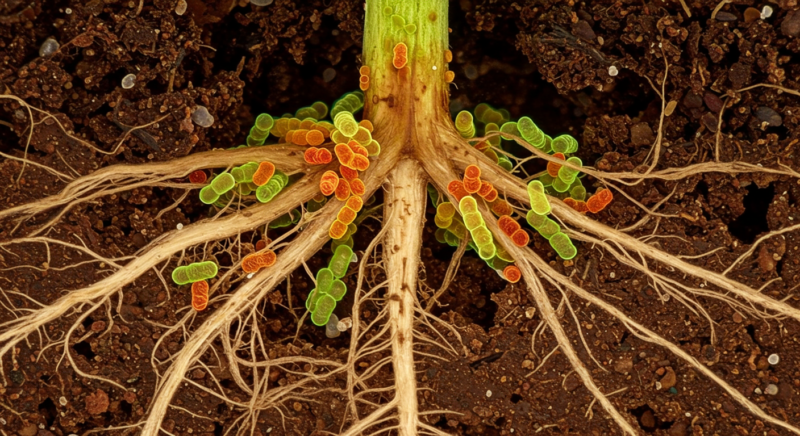
Healthy soil is teeming with beneficial microbes—bacteria, fungi, and other microorganisms—that help break down organic material and convert it into nutrients that cannabis plants can absorb. Loamy soil, with its balanced structure, provides the perfect environment for these microorganisms to thrive.
Adding organic matter such as compost, humus, or worm castings to loam soil can further enhance its fertility by introducing beneficial microbes and increasing nutrient availability. This rich ecosystem supports not just the plants but also the soil itself, leading to healthier, more resilient cannabis plants.
Soil Types
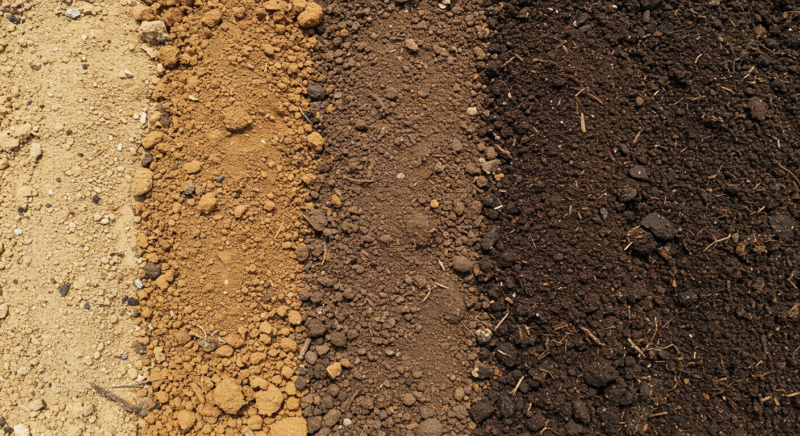
While loam is considered the ideal soil for cannabis but not every grower is lucky enough to start with it. Depending on your location, you might be dealing with sandy, clayey, or a different type of soil altogether. Understanding the characteristics of these different soil types(and how to amend them)can help you make the most of what’s available.
Sandy Soil

Sandy soil is composed mostly of large particles and has a gritty texture. It’s quick-draining, meaning it doesn’t hold water well, which can be a double-edged sword for cannabis cultivation.
Advantages of Sandy Soil:
- Fast Drainage: Sandy soils prevent water from accumulating around the roots, reducing the risk of root rot.
- Easy to Work: It’s light and easy to dig, which makes planting and working with it less labor-intensive.
Disadvantages of Sandy Soil:
- Poor Water Retention: Because it drains so quickly, sandy soil doesn’t hold onto water or nutrients. This can lead to your plants drying out too quickly, especially in hot weather.
- Low Nutrient Content: Sandy soil has a low CEC, meaning it doesn’t retain nutrients well. You’ll need to supplement sandy soils with regular fertilization to ensure your plants get the necessary nutrients.
Improving Sandy Soil for Cannabis:
- Add Organic Matter: Incorporating compost, well-rotted manure, or worm castings will help sandy soil retain moisture and nutrients.
- Mulching: Mulching around your plants’ base helps reduce evaporation and keep the soil cooler, which is particularly important in sandy soils that dry out quickly.
- Amend with Peat or Coco Coir: Both peat and coconut coir hold water well and can help balance out the quick-draining nature of sandy soils.
Clayey Soil
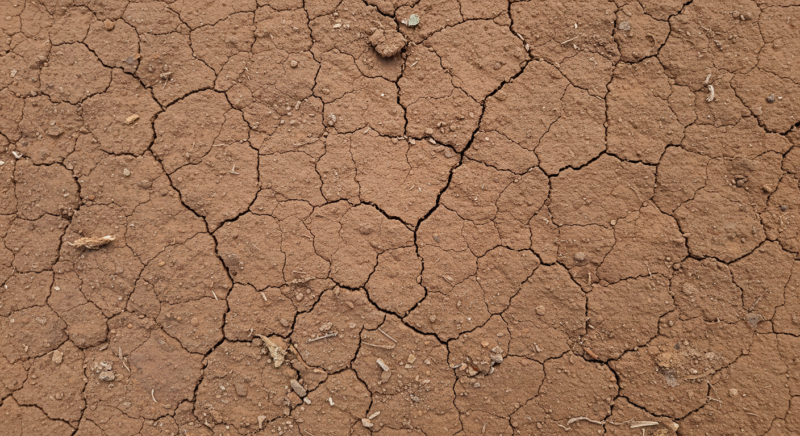
Clayey soil contains perfect particles that compact easily, making it dense and heavy. It feels sticky when wet and hard when dry. While clay soils are rich in nutrients, they often suffer from poor drainage and aeration.
Advantages of Clayey Soil:
- High Nutrient Retention: Clay soils have a high CEC, meaning they hold onto nutrients well and can provide a rich growing environment.
- Water Retention: Clay soil holds water for long periods, which can be beneficial in dry climates.
Disadvantages of Clayey Soil:
- Poor Drainage: Because it holds water so well, clay soil often becomes waterlogged, leading to root rot and oxygen deprivation.
- Compaction: Clay soils can become compacted, making it difficult for roots to penetrate and for oxygen to reach the root zone. This can stunt plant growth and reduce yields.
Improving Clayey Soil for Cannabis:
- Amend with Organic Matter: Organic matter like compost or aged manure helps break up compacted clay soils and improves their structure, making them easier to work with and improving drainage.
- Perlite or Sand: Adding perlite or coarse sand to clay soils improves aeration and helps water drain more freely.
- Raised Beds: Growing in raised beds filled with a custom soil mix can help avoid the issues associated with planting directly in heavy clay soils.
Loamy Soil
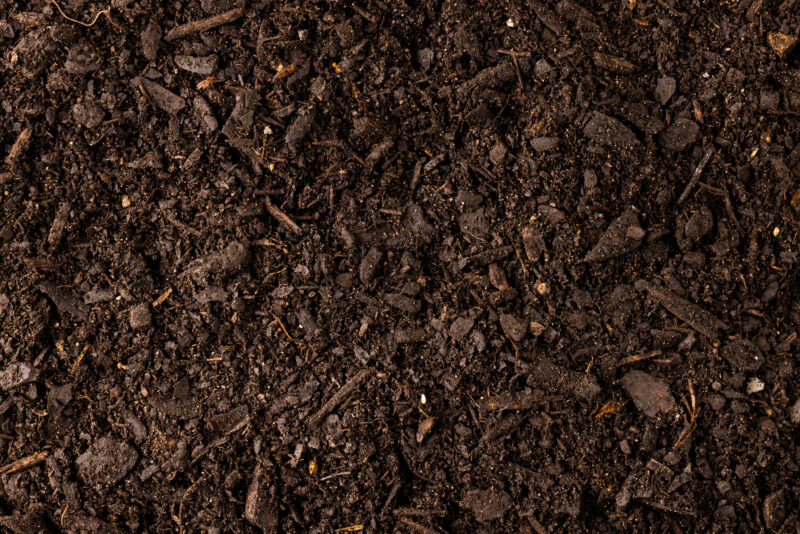
As mentioned earlier, loamy soil is the ideal medium for cannabis cultivation because it offers a balanced mix of sand, silt, and clay. It drains well but retains enough moisture, holds nutrients, and provides good aeration for roots.
Advantages of Loamy Soil:
- Perfect Balance: Loamy soils provide excellent drainage, moisture retention, and nutrient availability. They are easy to work with and provide a fertile growing environment for cannabis.
- Supports Healthy Root Growth: Loam’s balanced structure allows roots to grow deep and wide, supporting vigorous plant growth.
- Good for Microbial Life: Loam supports a rich community of beneficial microorganisms that enhance nutrient cycling and soil fertility.
Disadvantages of Loamy Soil:
- Maintenance: While loamy soils are ideal, they still require regular maintenance, such as adding organic matter, monitoring pH, and managing nutrient levels to remain productive over time.
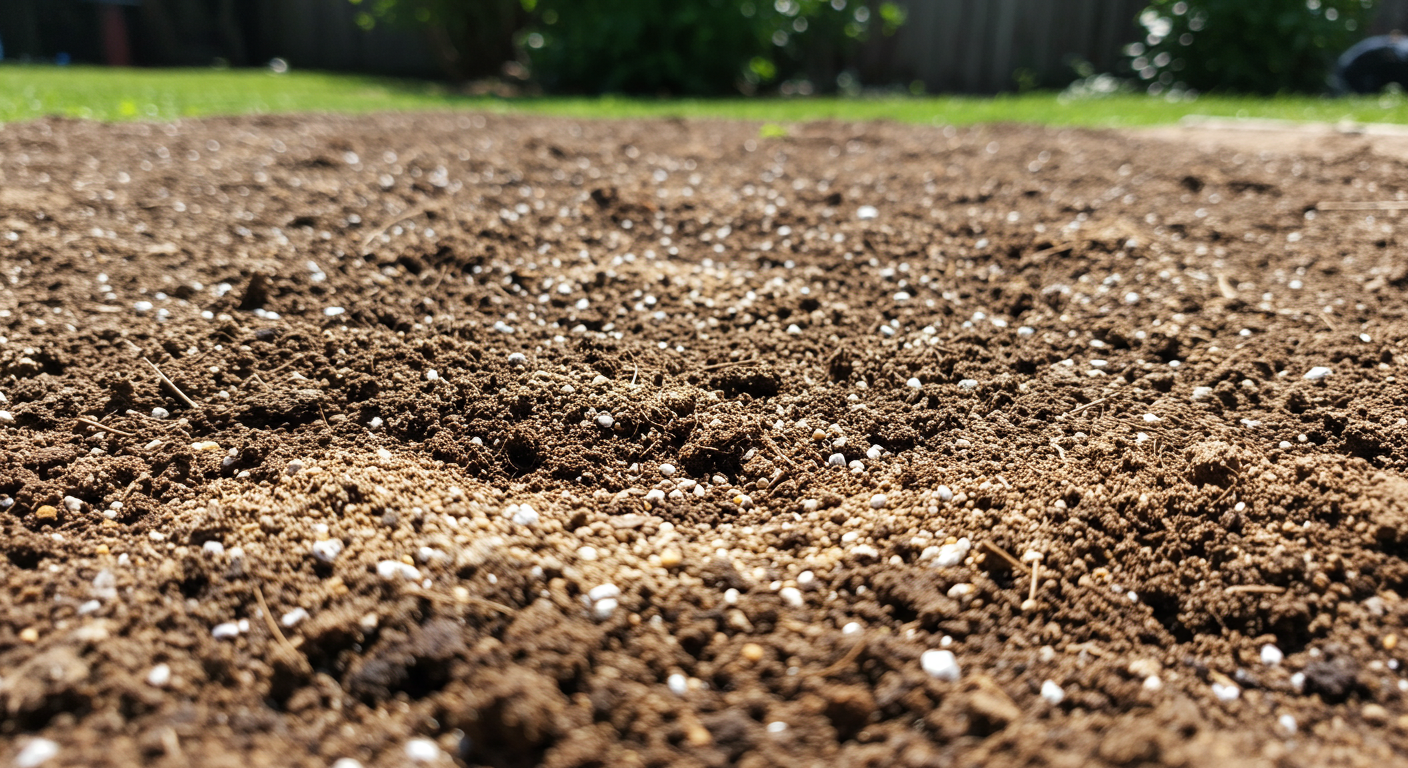
Maintaining Loamy Soil for Cannabis:
- Regularly Add Organic Matter: Even in loamy soil, adding compost or other organic amendments each growing season will help maintain its structure and fertility.
- Monitor pH: Cannabis thrives in slightly acidic soil. Regularly test the pH of your loam soil and adjust as needed with lime (to raise pH) or sulfur (to lower pH).
Preparing Your Soil Step-by-Step
- Assess Your Native Soil: Use the texture test (hand squeeze or jar test) to determine your soil type and assess any amendments needed.
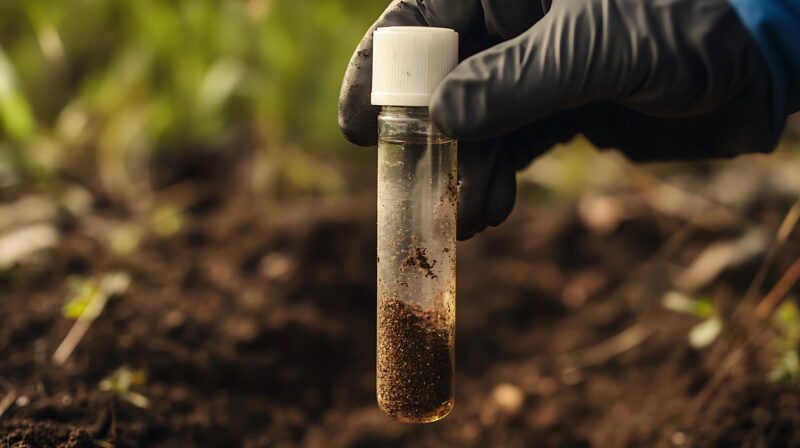
- Amend Based on Soil Type:
- For sandy soil, add compost, coconut coir, and peat moss.
- For clay soil, add perlite, coarse sand, and gypsum.
- For loamy soil, a light compost amendment should be enough to maintain fertilit
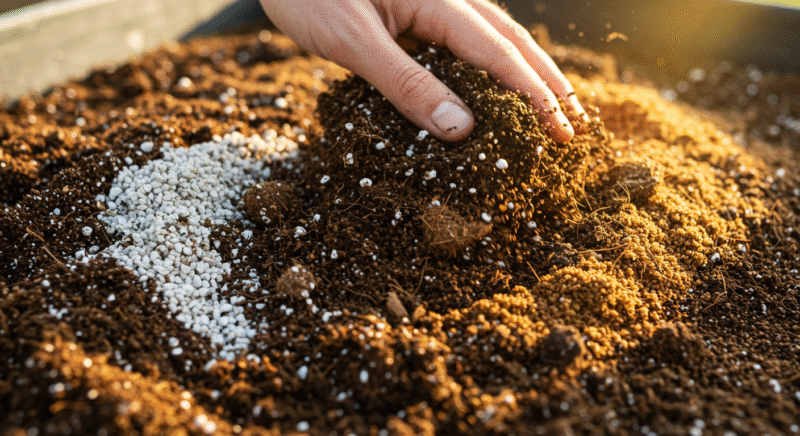
- Adjust pH: Use a soil pH test to ensure your soil is in the 6.0–7.0 range. If not, adjust with lime (to raise pH) or sulfur (to lower pH)
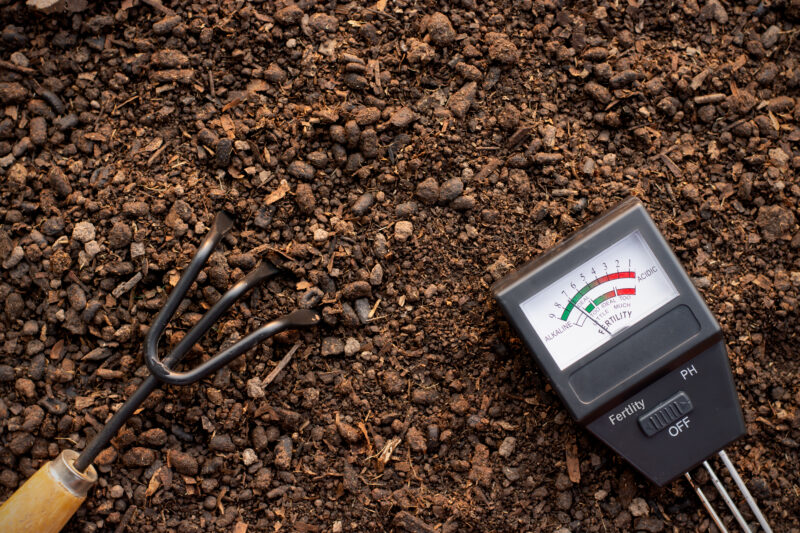
- Add Organic Matter: Incorporate compost, well-aged manure, or worm castings to improve soil structure and introduce beneficial microbes.
- Turn and Aerate the Soil: Loosen the top 12–18 inches of soil to improve aeration, especially if dealing with compacted clay.
- Test for Drainage: Before planting, test your soil’s drainage by filling a small hole with water and timing how long it takes to drain. Aim for water to disappear within 30 minutes to 1 hour.
Amending Soil for Outdoor Cannabis: Creating the Perfect Growing Medium
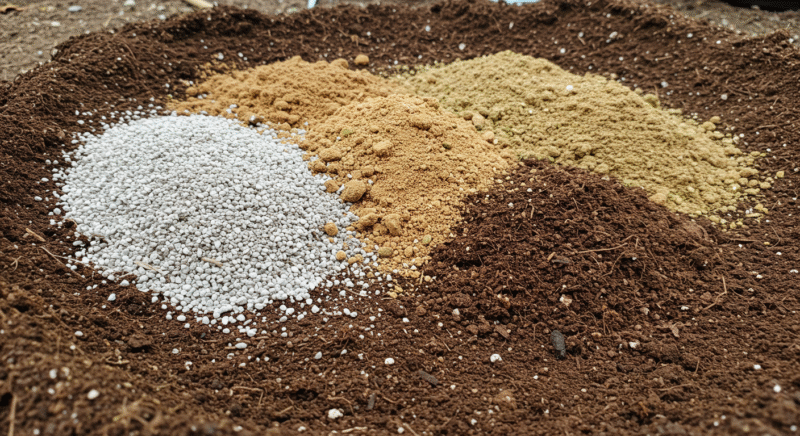
Amending soil is a critical step in preparing your outdoor cannabis garden, ensuring that your plants have the right nutrients, drainage, and pH balance for optimal growth. While cannabis is a resilient plant, its full potential can only be unlocked when grown in a well-prepared soil environment that supports healthy roots, strong stems, and lush foliage. Beginners and seasoned growers must understand how to amend soil and balance pH levels providing a solid foundation for robust cannabis plants.
Why Soil Amendments Are Important
Soil amendments enhance the natural composition of your soil, improving drainage, nutrient retention, and the overall health of the soil ecosystem. Adding organic matter, minerals, and other amendments is especially beneficial if your native soil has heavy clay or is overly sandy, as these soils can pose challenges for cannabis cultivation:
- Improving Drainage: Heavy soils retain too much water, which can suffocate roots and promote fungal growth. Sandy soils, drain too quickly and don’t retain moisture or nutrients effectively. Amendments help create a balanced environment for root health and moisture control.
- Increasing Nutrient Content: Cannabis requires a range of nutrients, including nitrogen, phosphorus, potassium, and trace minerals. Amending the soil with organic compost and mineral-rich additives ensures plants have a steady supply of essential nutrients.
- Enhancing Soil Structure: Soil structure refers to the arrangement of soil particles and pores. Healthy soil should be loose and friable, allowing roots to grow freely and access oxygen. Amendments like perlite and vermiculite help create this ideal structure, encouraging better root development and nutrient uptake.
Key Soil Amendments
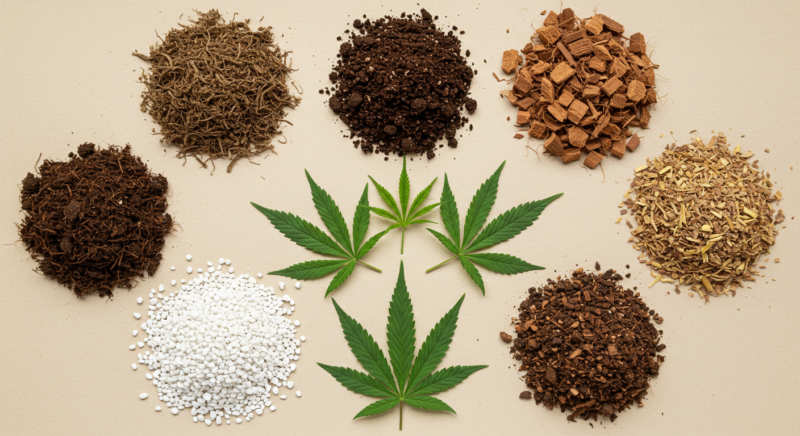
Now let’s explore the various soil amendments that are most beneficial for cannabis cultivation. These include organic compost, perlite, and various other materials that improve soil fertility, texture, and structure.
Organic Compost
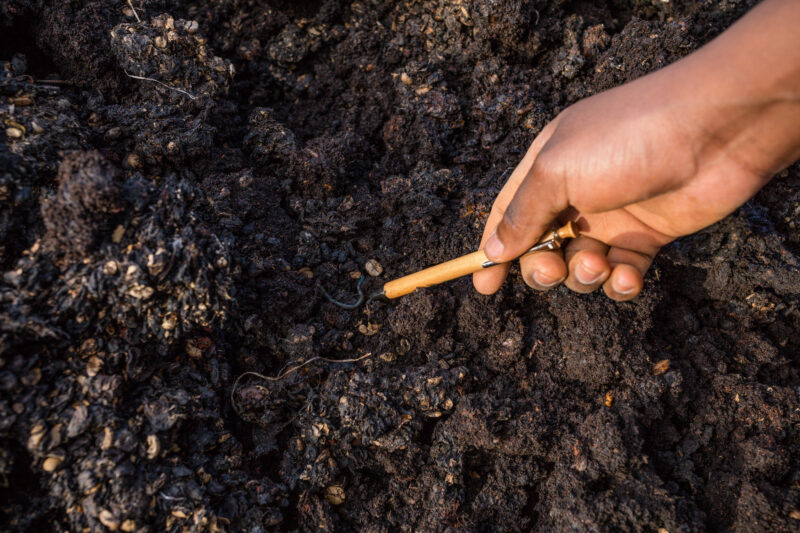
Compost is perhaps the single most important amendment you can add to your soil. Rich in organic matter, compost improves your soil’s structure, moisture retention, and fertility by providing a steady supply of nutrients that are slowly released over time.
What is Compost?
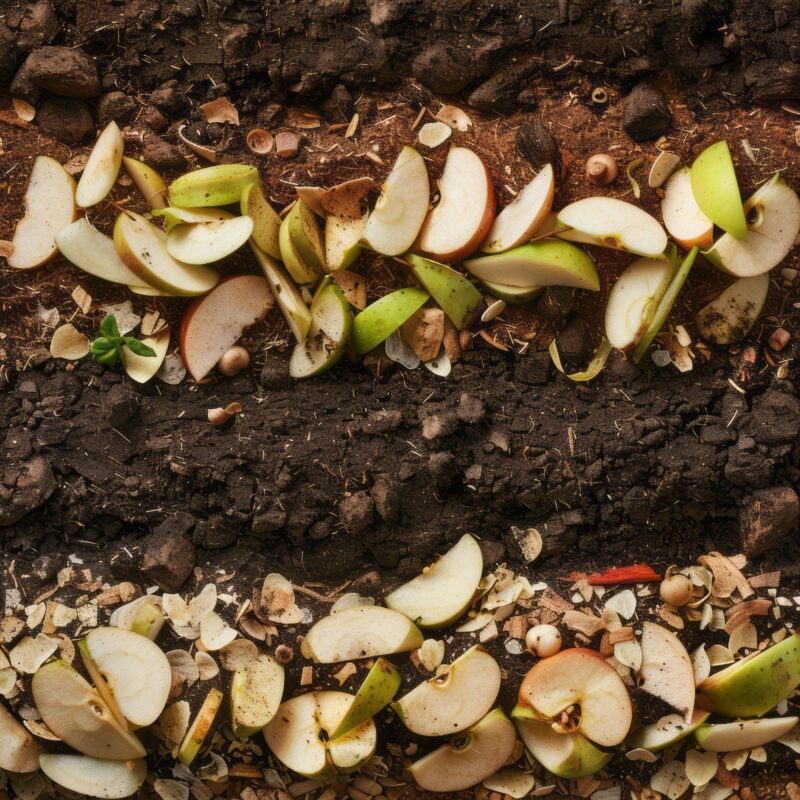
Compost is decomposed organic material, typically made from plant matter (like leaves, grass clippings, and food waste) and sometimes animal manure. It’s teeming with beneficial microbes that help break down complex organic matter into nutrients that your plants can absorb. Compost also enhances the soil’s ability to retain moisture while promoting proper drainage.
Benefits of Compost for Cannabis:
- Nutrient-Rich: Compost contains nitrogen, phosphorus, potassium, and trace elements like calcium, magnesium, and sulfur, all essential for cannabis growth.
- Improves Water Retention: Compost helps sandy soils hold onto moisture and nutrients while improving the drainage of heavy clay soils.
- Promotes Microbial Life: Compost provides a habitat for beneficial microorganisms like bacteria, fungi, and earthworms, which help break down organic material into a form that cannabis plants can easily absorb.
- Boosts Aeration: The organic matter in compost improves soil aeration, preventing compaction and ensuring that plant roots can access oxygen.
How to Add Compost:
- Mix it in: Incorporate compost into the top 6-12 inches of soil before planting. Use a shovel or a garden fork to work the compost into the soil, ensuring that it’s evenly distributed.
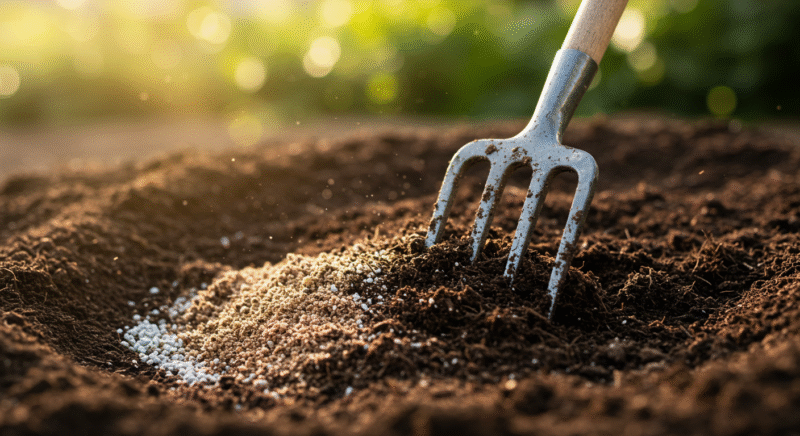
- Top-dressing: You can also add compost as a top-dressing around the base of your plants during the growing season. This method allows the nutrients to slowly leach into the soil with each watering, feeding your plants over time.
Pro Tip: Aim for about 20-30% of your soil mix to be compost for cannabis. Too much compost can make the soil too dense and rich, potentially causing nutrient burn.
Perlite
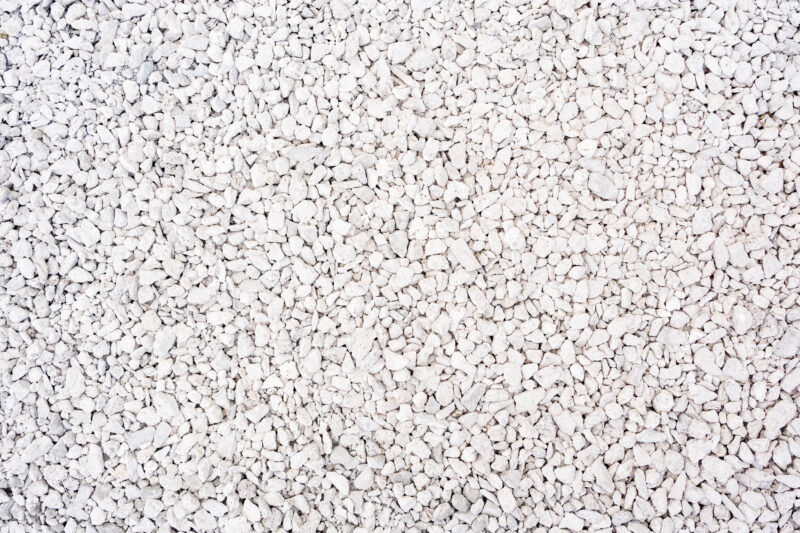
Perlite is a lightweight, porous material made from volcanic glass that’s been superheated. It’s often used in gardening to improve soil drainage and aeration, making it an essential amendment for cannabis growers, especially those dealing with heavy soils.
Why Perlite is Important for Cannabis:
- Improves Drainage: Perlite allows excess water to drain quickly through the soil, which helps prevent waterlogged roots and root rot, a common issue in compacted or clay-heavy soils.
- Enhances Aeration: By creating air pockets in the soil, perlite ensures that plant roots have access to oxygen. This is critical for nutrient uptake and healthy root development.
- Reduces Compaction: Perlite’s porous nature helps prevent soil from becoming too compacted, which is especially beneficial for plants with dense root systems like cannabis.
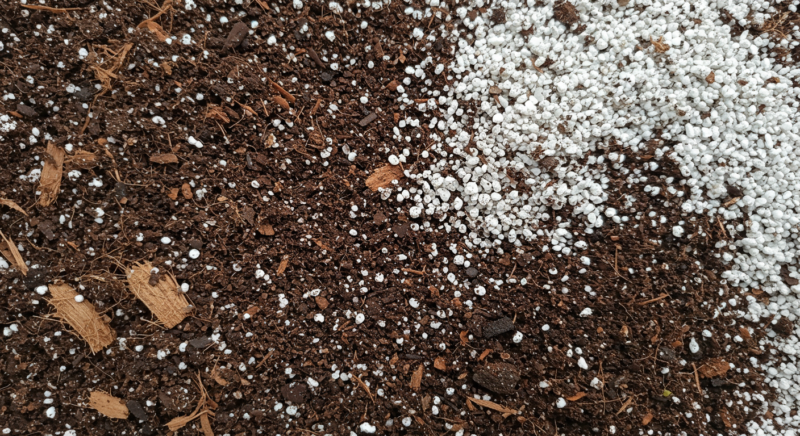
How to Use Perlite:
- Mix into Soil: For cannabis, perlite should make up about 10-20% of your soil mix, depending on how well your soil drains naturally. For heavy clay soils, you might need closer to 30% perlite to ensure good aeration and drainage.
- Raised Beds or Containers: Perlite is particularly useful in raised beds or containers, where soil compaction and drainage issues are more common. It helps keep the growing medium light and well-aerated.
Note: Don’t overdo it with perlite. While it improves drainage, too much can cause the soil to dry out too quickly, especially in hot arid climates. Balance is important.
Vermiculite
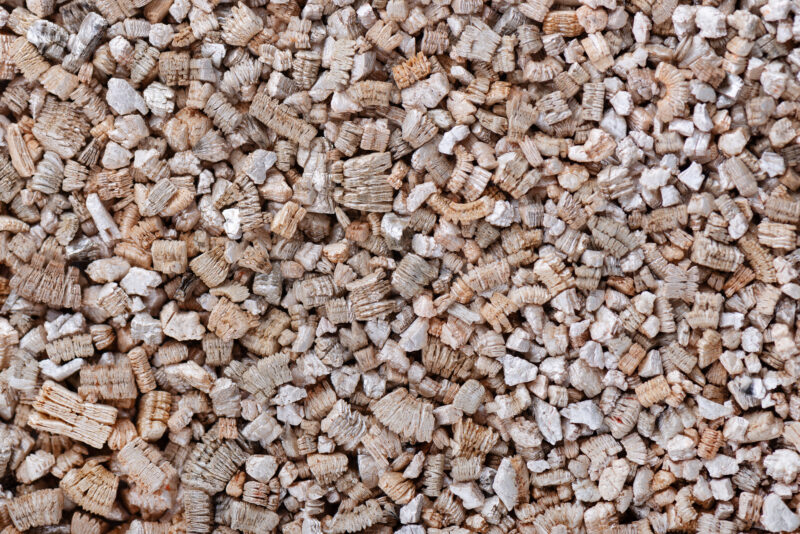
Vermiculite is another mineral amendment that, like perlite, is often used to improve soil structure. However, vermiculite retains more moisture than perlite, making it a better choice for growers in dry climates or those using particularly sandy soils.
Why Vermiculite is Beneficial for Cannabis:
- Water Retention: Vermiculite holds water in the soil, which helps plants stay hydrated between waterings. This is especially useful for sandy soils that drain too quickly.
- Increases CEC (Cation Exchange Capacity): Vermiculite has a high CEC, meaning it holds onto nutrients and makes them available to the plant roots over time. This helps prevent nutrient leaching and ensures a steady supply of essential minerals.
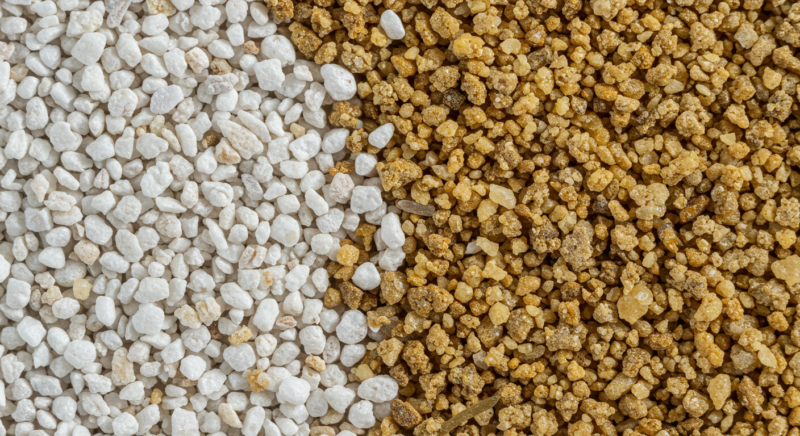
How to Use Vermiculite:
- Mix into Soil: Similar to perlite, vermiculite should be mixed into your soil at a ratio of about 10-20%. It’s particularly effective when used alongside compost and perlite, as the combination provides both water retention and good aeration.
Pro Tip: Use vermiculite in areas with dry, hot climates where water conservation is critical. It can help reduce watering frequency, especially during droughts or intense heat.
Worm Castings
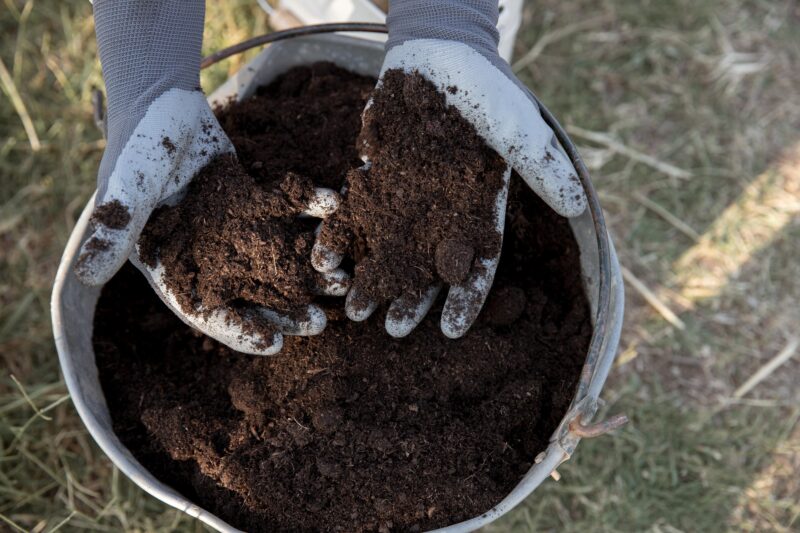
Worm castings, also known as vermicompost, are the nutrient-rich waste produced by earthworms. They are an incredibly potent soil amendment that boosts soil fertility, encourages microbial life, and improves soil structure.
Benefits of Worm Castings:
- Nutrient-Dense: Worm castings are packed with essential nutrients like nitrogen, phosphorus, potassium, and a wide range of micronutrients. These nutrients are released slowly over time, ensuring that your plants are fed consistently throughout their growth cycle.
- Promotes Beneficial Microorganisms: Worm castings introduce and support beneficial bacteria and fungi that help break down organic matter and release nutrients in a form that your plants can absorb easily.
- Improves Soil Texture: Worm castings help improve soil structure, boosting aeration and moisture retention without causing compaction.
How to Use Worm Castings:
- Mix into Soil: Worm castings can be mixed directly into your soil at a ratio of about 10-15%. They work best when combined with other organic matter like compost.
- Top-Dressing: Apply a layer of worm castings around the base of your plants as a slow-release fertilizer. Each time you water, nutrients will leach into the soil and feed the roots.
Note: Worm castings are gentle and won’t burn your plants, making them ideal for use throughout the entire growing cycle, from seedling to flowering.
Balancing Soil pH for cannabis (6.0-7.0)

Along with texture and nutrients, pH balance is one of the most important factors in soil health. Cannabis plants prefer a slightly acidic soil, with a pH range of 6.0 to 7.0. If the soil is too acidic (below 6.0) or too alkaline (above 7.0), the plant’s ability to absorb nutrients is impaired, even if those nutrients are present in the soil. This leads to nutrient lockout, where your plants display signs of deficiency despite nutrient-rich soil.
Why pH Matters
The pH level of your soil directly impacts the availability of nutrients. Different nutrients are more or less available to plants at specific pH levels. In cannabis, the sweet spot is between 6.0 and 7.0, where most macro and micronutrients are readily available for uptake.
For example:
- Nitrogen, phosphorus, and potassium—the key nutrients in cannabis growing—are most available in soil with a pH of 6.0-7.0.
- If the pH drops below 6.0, important nutrients like calcium and magnesium become less available, leading to deficiencies.
- Similarly, if the pH climbs above 7.0, nutrients like iron, zinc, and manganese are less accessible, which can stunt plant growth.
How to Test Soil pH
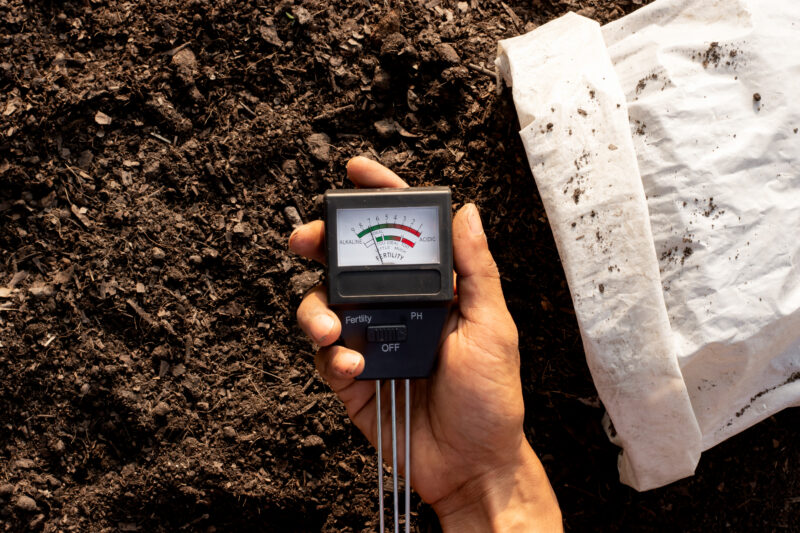
Testing Soil pH
To maintain the optimal pH range, it’s essential to regularly test your soil. You can do this using:
- Soil pH Test Kits: These simple kits are widely available and offer a quick, reasonably accurate way to test your soil’s pH.
- Digital pH Meters: For more precise readings, invest in a digital pH meter. This tool gives you an accurate measurement and is reusable, making it a great investment for long-term cannabis cultivation.
Note: Always test your soil pH both before planting and periodically throughout the growing season. Fluctuations can happen over time due to watering, nutrient amendments, or environmental changes.
Cannabis Plant Biology: Indica, Sativa, and Hybrids
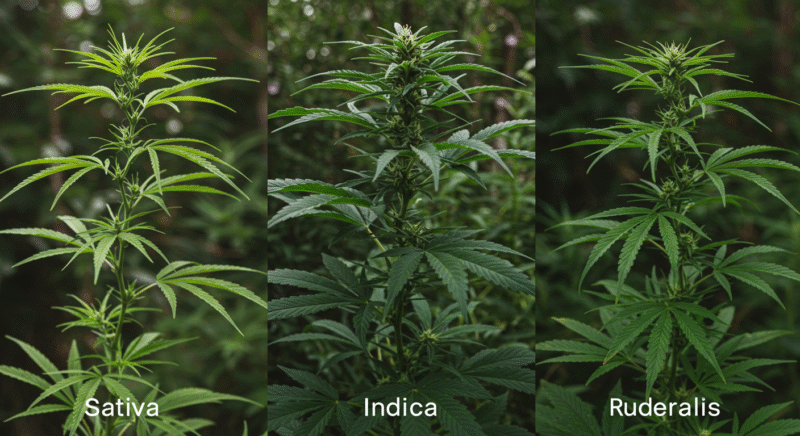
Cannabis comes in a variety of forms, but the two primary species that most growers and users are familiar with are Cannabis sativa and Cannabis indica. Each of these species has distinct characteristics, and hybrids of the two combine various aspects of both. Understanding the differences between these varieties can help you choose the best strain for your needs, whether you’re growing for personal use, medicinal purposes, or commercial cultivation.
Indica
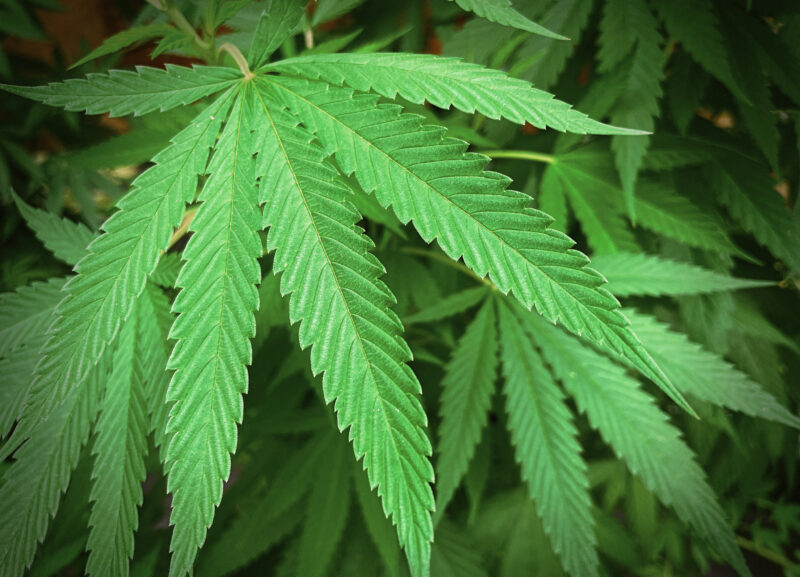
Cannabis Indica is a shorter, bushy plant that typically has broad, dark green leaves and a faster flowering cycle than Sativa varieties. Indica plants originate from the mountainous regions of Afghanistan, Pakistan, and India, where they evolved to withstand harsher, cooler climates. These plants are well-adapted for indoor grows, thanks to their compact structure, dense foliage, and shorter stature.
Growth Habits and Structure: Indica plants are compact and robust, with sturdy branches and dense foliage. Their structure supports heavy bud production, which often results in thick, resinous colas that pack tightly along each branch. The thick, broad leaves help capture sunlight efficiently, making these plants ideal for regions with shorter growing seasons.
Flowering Time: Indica strains have a relatively short flowering time, often ranging from 6 to 9 weeks. This rapid growth cycle benefits growers in cooler climates with limited frost-free days. Indica plants can mature before temperatures drop significantly.
Yields: Due to their dense bud structure and heavy branching, Indicas typically produce high yields. Their compact size allows for multiple plants in smaller spaces, making them ideal for both indoor and outdoor growers seeking substantial harvests. However, the dense structure also requires careful humidity management to avoid mold issues.
Effects and Uses: Indica strains are typically described as delivering a “body high,” known for their relaxing and sedative effects. These properties make Indicas ideal for nighttime use or for individuals seeking relief from pain, insomnia, or anxiety. Indica strains are also popular for medicinal use due to their higher CBD (cannabidiol) content, which offers therapeutic benefits without the intense psychoactive effects of THC.
Sativa
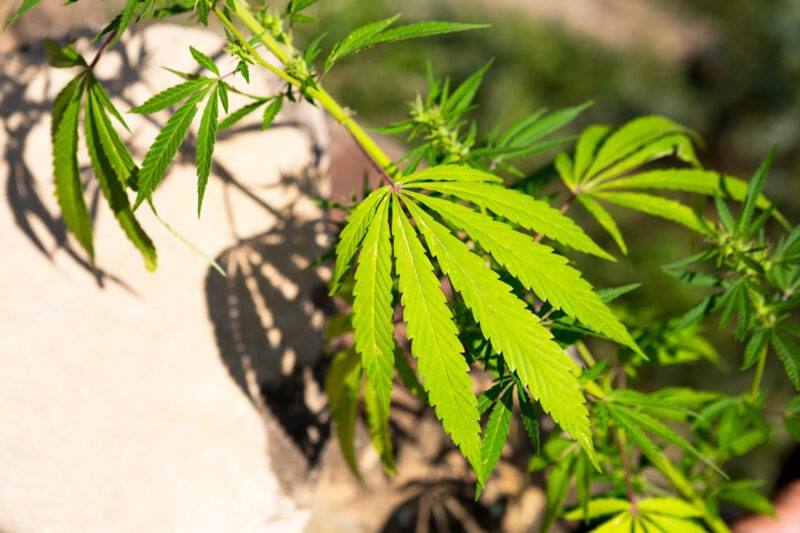
Cannabis Sativa is known for its tall, lanky growth and lighter green, thin-fingered leaves. These plants naturally thrive in tropical and equatorial regions, including Southeast Asia, Central America, and Africa, where longer daylight hours and warmer climates provide an ideal environment for extended growth. Sativas have a more extended flowering period than Indicas, but they reward growers with higher yields and potent effects.
Growth Habits and Structure: Sativa plants have a tall, open structure, often reaching heights over 12 feet in optimal conditions. The long, sparse branches provide excellent airflow, which reduces the risk of mold and pests. This growth pattern is better suited to outdoor cultivation, where there’s ample space for vertical expansion.
Flowering Time: Sativa strains generally have a long flowering period, ranging from 10 to 16 weeks. This extended cycle can be challenging for growers in regions with shorter summers, as Sativas require a full season to reach their peak. However, warm, sunny climates with extended summers enable Sativas to flourish and fully develop their complex cannabinoid profiles.
Yields: Sativa plants can deliver substantial yields, particularly when grown outdoors. Although individual buds may be lighter and less compact than those of Indicas, the sheer number of bud sites compensates, resulting in a generous harvest. Proper support for tall, heavy plants is essential to prevent branches from breaking under the weight of mature buds.
Effects and Uses: Sativa strains are known for producing a “head high,” with cerebral, uplifting effects that are perfect for daytime use. Many users report enhanced creativity, focus, and sociability, making Sativas a popular choice for recreational and therapeutic purposes. Sativas often have higher THC levels, contributing to their energizing effects, which are sought after by those looking to improve mood or concentration.
Hybrids
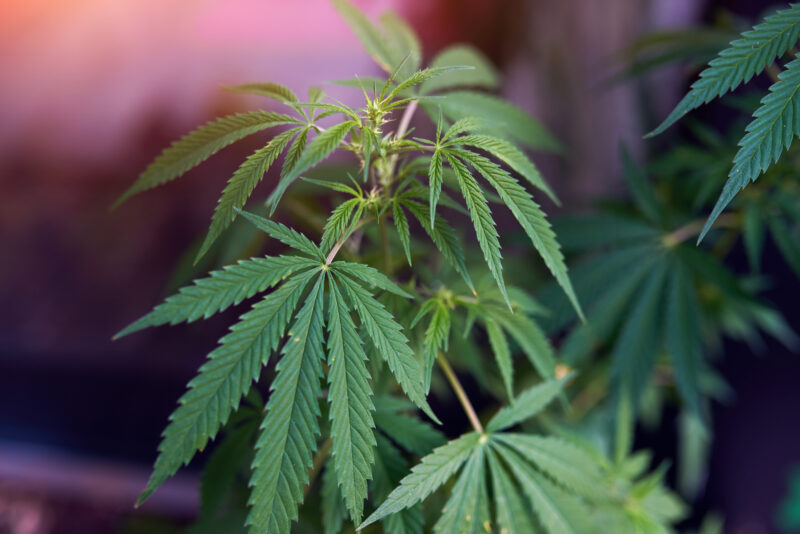
In today’s cannabis market, pure Indica or Sativa strains are becoming rare. Most plants are hybrids, combining traits from both Indica and Sativa. Breeders create hybrids to develop plants that exhibit the best qualities of each parent species, including faster flowering times, enhanced resilience, and unique cannabinoid profiles. Hybrids allow growers to match specific growth patterns to their unique environments, achieving desired effects and structure.
Growth Habits and Structure: Hybrid plants vary widely in their structure, depending on the dominant genetic traits. Indica-dominant hybrids tend to be shorter and bushier, while Sativa-dominant hybrids often have a taller, more open structure. Balanced hybrids typically offer a mix, resulting in plants with moderate height, strong lateral branches, and a well-rounded shape ideal for indoor and outdoor setups alike.
Flowering Time: Hybrids are bred to balance the quick flowering of Indicas with the potency and yield potential of Sativas. Flowering times for hybrids usually range between 8 and 12 weeks, providing growers with flexibility and reliability, particularly in regions with varying climates.
Yields: Yields for hybrids depend on their specific genetic makeup. Indica-dominant hybrids typically produce dense buds and high yields in smaller spaces, while Sativa-dominant hybrids can generate impressive outdoor yields with larger plant sizes. Many hybrids are bred for high productivity, making them popular choices among commercial cultivators.
Effects and Uses: Hybrids offer a range of effects depending on their Indica-to-Sativa ratio. Indica-dominant hybrids generally deliver relaxing, physical effects with a touch of cerebral stimulation, while Sativa-dominant hybrids offer a balanced mental and physical experience. The versatility of hybrids makes them suitable for growers and consumers seeking customizable effects, cannabinoid profiles, and growth traits.
Differences Between Male, Female, and Hermaphrodite Plants
Cannabis is a dioecious plant, meaning it has distinct male and female individuals, though hermaphroditic plants—those that contain both male and female reproductive organs—can also occur. Identifying the sex of your plants is crucial for cultivation, especially if your goal is to produce potent, resinous buds, as only female plants produce the flowers desired for consumption. Let’s break down the differences between these plant types.
Male Plants
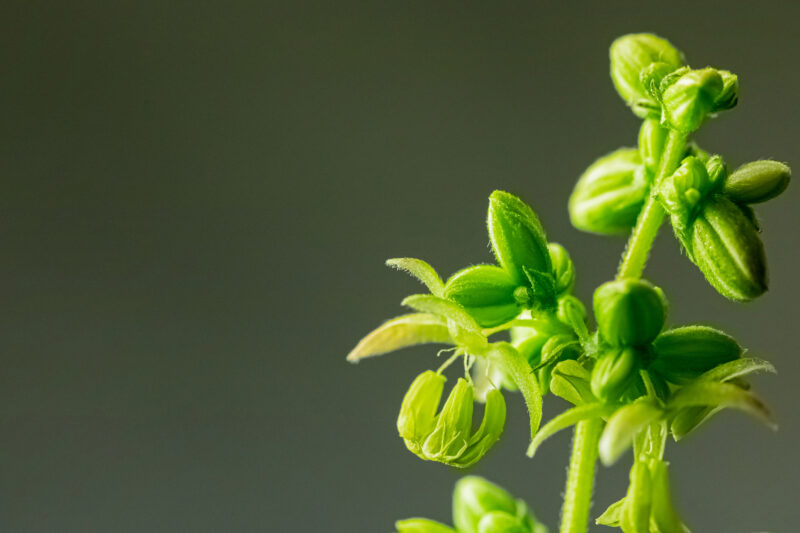
Male cannabis plants are essential for reproduction, but they are not sought after by most growers looking to cultivate cannabis for consumption. Male plants produce pollen sacs that, when mature, open up to release pollen into the air. If pollen reaches a female plant, it will fertilize the buds producing seeds instead of the resin-rich, seedless flowers (known as sinsemilla) that most growers are after. Because of this, male plants are usually removed from the grow area as soon as they’re identified to prevent them from pollinating the females. They are often taller and more sparsely branched than female plants and typically show their sex earlier, with small pollen sacs forming at the nodes between the branches and main stem.
Female Plants
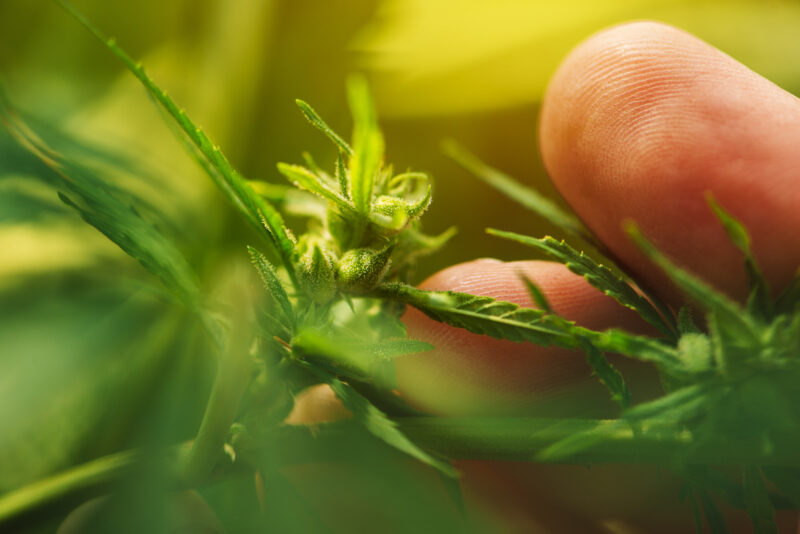
Female cannabis plants are the real stars of the show. They produce the large, resin-covered flowers that are harvested for consumption. The female plant’s flowers contain high concentrations of cannabinoids, like THC and CBD, which are sought after for both recreational and medicinal use.
In an ideal scenario, female plants are kept far away from males to prevent pollination, ensuring they focus their energy on producing resin, not seeds. If left unpollinated, the female plant will continue producing large, seedless buds rich in cannabinoids—this is the highly desired sinsemilla.
Female plants are typically shorter and bushier than their male counterparts, with dense foliage and the formation of calyxes, which grow into the buds we harvest. You can identify female plants by the appearance of white, hair-like pistils at the nodes. These pistils will eventually turn red or brown as the plant matures.
Hermaphrodite Plants
Hermaphrodite cannabis plants contain both male and female reproductive organs. This can occur naturally, but it is more commonly the result of environmental stressors like extreme temperature changes, inconsistent light cycles, or physical damage to the plant. When a plant becomes hermaphroditic, it can self-pollinate, which leads to the production of seeds in your otherwise resinous buds.
There are two types of hermaphrodites:
- True Hermaphrodites develop both male and female sex organs simultaneously, producing pollen sacs alongside pistils.
- Nanners produce small, banana-shaped pollen sacs within their flowers late in the flowering cycle.
Hermaphrodites are undesirable in most cultivation environments because they can pollinate themselves and neighboring female plants, ruining your harvest. The best action is to remove any hermaphroditic plants immediately to prevent pollination.
When choosing a strain, start by understanding your climate. Each climate type presents unique challenges and advantages for cannabis growers:
Choosing Strains Based on Climate
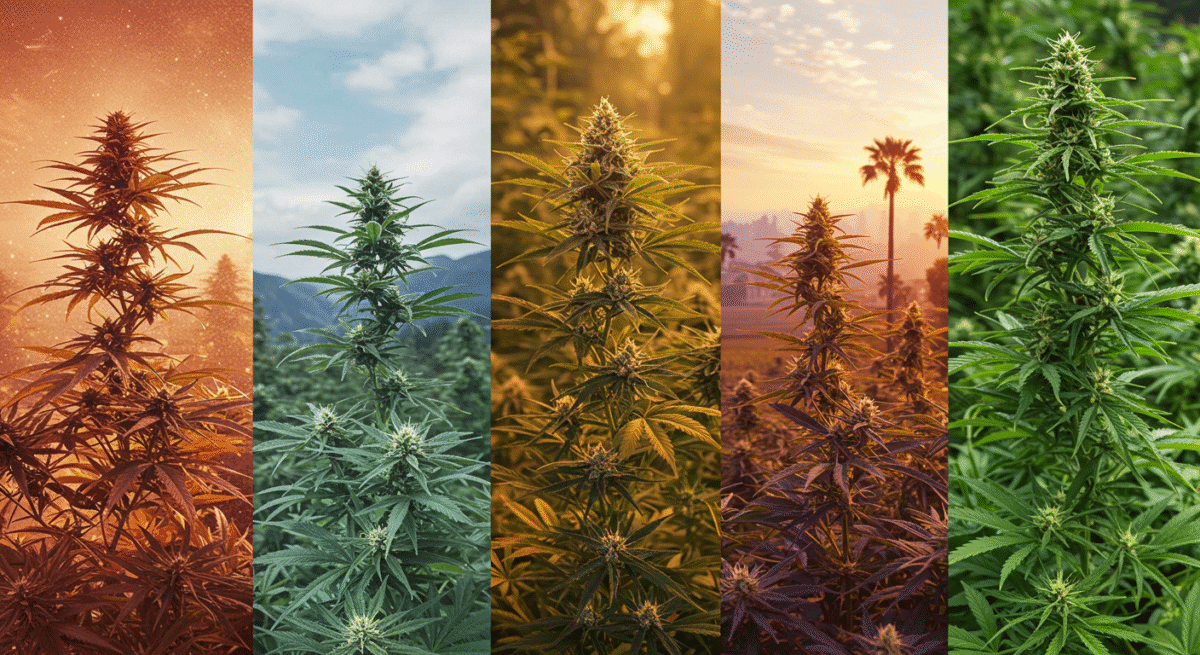
Cannabis plants come in various strains, each with unique characteristics influenced by their genetic lineage. Broadly, cannabis is divided into three types: Indica, Sativa, and Hybrid strains. Each type has adapted to different climates, allowing growers to select strains suited to their local environment. Here’s a breakdown of each type and how they perform outdoors:
Indica: Indicas are typically shorter, bushier plants with broad leaves. Originally from cooler, mountainous regions like the Hindu Kush mountains, Indicas are well-suited to shorter growing seasons and can tolerate lower temperatures. They tend to mature faster than Sativas, making them ideal for cooler climates where frost may set in earlier.
Sativa: Sativa strains come from warmer, equatorial regions, including parts of Africa, Southeast Asia, and Central America. These plants grow tall with narrow leaves and tend to take longer to mature, often requiring a full season to reach peak harvest. Sativas thrive in warm to hot climates with long summers, where they have ample time to grow to their full potential.
Hybrid: Hybrids are crossbreeds of Indica and Sativa strains, designed to capture desirable traits from both types. Hybrids can vary widely in their resilience, growth patterns, and climate adaptability, depending on their specific genetics. Some hybrids are created to be more mold-resistant, drought-tolerant, or pest-resistant, making them suitable for a broader range of environments.
Cooler Regions
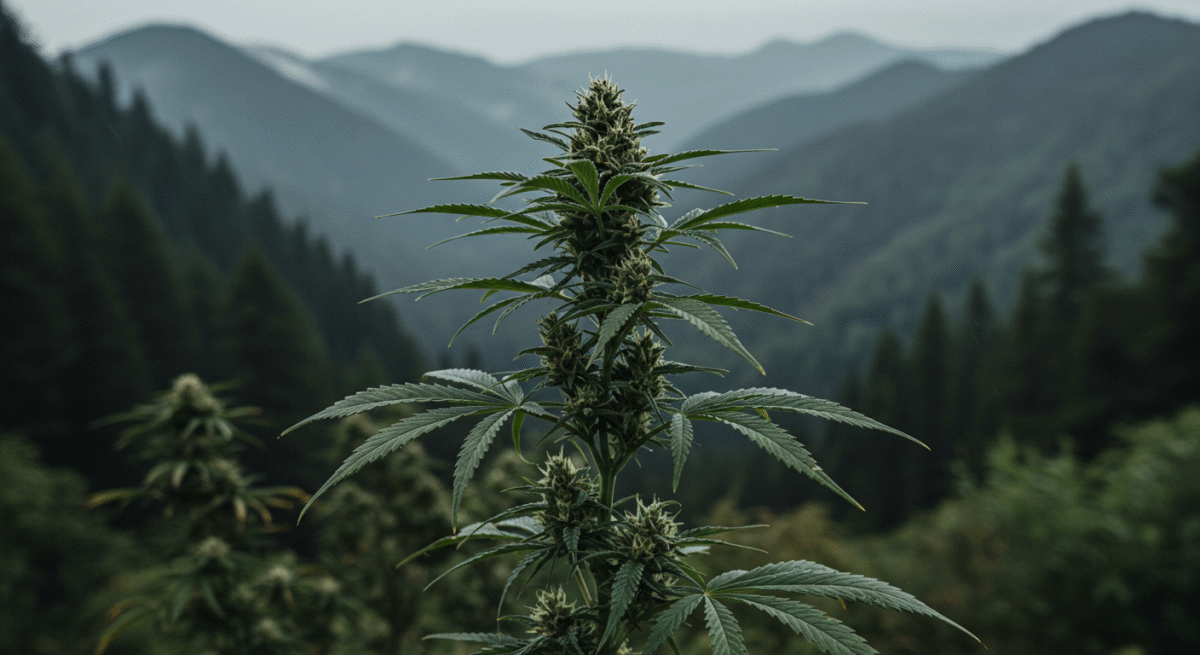
In cooler climates, outdoor growing requires strains that can handle lower temperatures and shorter growing seasons. The best strains for these areas are typically Indica-dominant or fast-maturing hybrids, which can complete their life cycle before the first frost.
- Characteristics to Look For:
- Early finishing times to avoid frost
- High resistance to mold, as cooler climates often come with increased humidity
- Tolerance to fluctuating temperatures, especially if nights are significantly cooler than days
- Examples of Strains for Cooler Regions:
- Northern Lights: Known for its high resilience, Northern Lights is a classic strain that finishes early and is very mold-resistant. It’s a popular choice among growers in cooler regions.
- Hindu Kush: An Indica strain with origins in the mountainous Hindu Kush region, it’s accustomed to cooler conditions and has a quick flowering period.
- Durban Poison: A Sativa with a unique ability to finish early, making it suitable for climates with shorter summers. It’s also quite mold-resistant.
Hot Climates
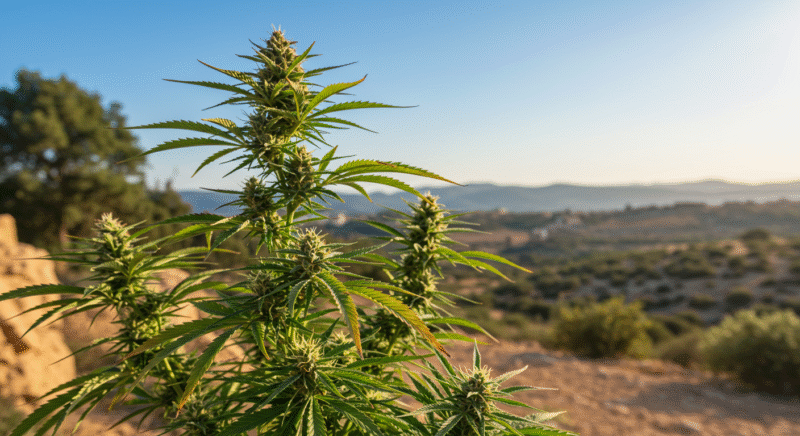
Choosing a strain that can handle prolonged heat and abundant sunshine is key for growers in warmer climates. Sativa-dominant strains tend to excel in hot climates, as they are adapted to long seasons and ample light.
- Characteristics to Look For:
- Heat tolerance and high sunlight requirements
- Long flowering periods to take advantage of extended growing seasons
- Ability to handle low humidity without drying out too quickly
- Examples of Strains for Hot Climates:
- Amnesia Haze: This Sativa-heavy hybrid thrives in hot climates and has a long flowering period that benefits from extended seasons.
- Super Silver Haze: Another Sativa-leaning strain that performs well in warm climates. It’s resilient to high light intensity and can reach impressive heights outdoors.
- Acapulco Gold: Originating from the warm climates of Central America, this Sativa is well-suited for hot environments and can handle strong sunlight.
Specialized Strains for Challenging Conditions
In addition to temperature and sunlight requirements, it’s also important to consider strains that resist common outdoor challenges like mold, drought, and pests. These specialized strains are often hybrid varieties bred to combine desirable traits from both Indica and Sativa genetics, making them well-equipped to handle various environmental stresses.
Mold-Resistant Strains
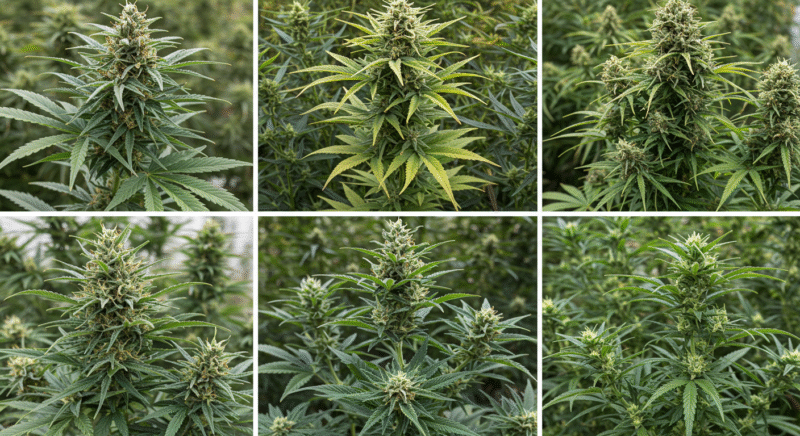
Mold can be one of the biggest threats to outdoor cannabis, particularly in humid climates or during rainy periods. Strains that are naturally mold-resistant have been bred to withstand these conditions, minimizing the risk of bud rot and powdery mildew.
- Characteristics of Mold-Resistant Strains:
- Dense buds with good airflow to discourage mold growth
- Fast flowering times to avoid prolonged exposure to damp conditions
- Genetic resilience to common molds like botrytis
- Examples of Mold-Resistant Strains:
- Gorilla Glue #4: This popular hybrid is known for its resilience and mold-resistant qualities, making it a good choice for humid climates.
- Pineapple Express: With dense but airy buds, Pineapple Express is naturally resistant to mold and performs well in both warm and cool climates.
- Blue Dream: A versatile hybrid that’s both mold and mildew-resistant, ideal for regions with unpredictable weather.
Drought-Tolerant Strains
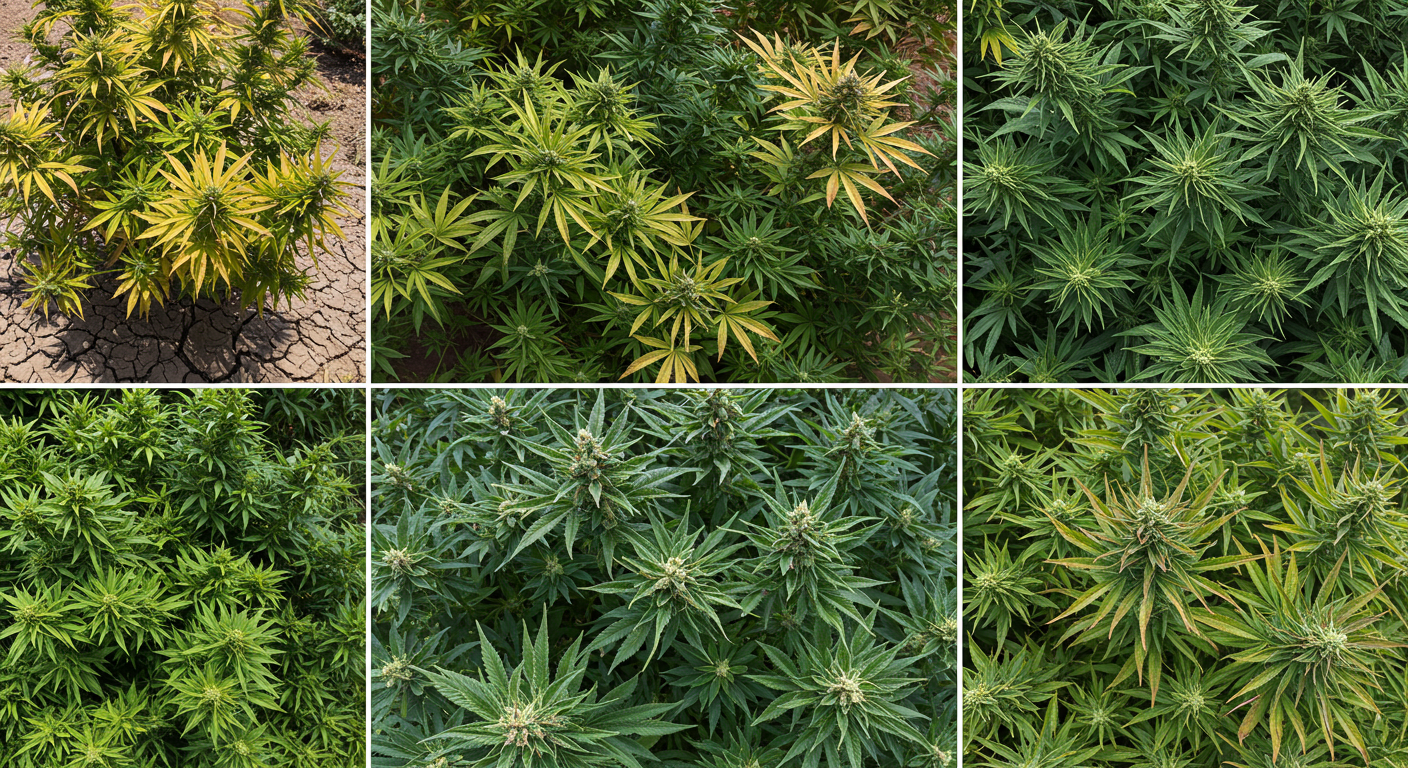
In arid climates, drought tolerance is essential. Drought-tolerant strains require less frequent watering and are better adapted to retain moisture, which is beneficial in areas with limited water access or during dry spells.
- Characteristics of Drought-Tolerant Strains:
- Deep root systems that can access lower water levels in the soil
- Efficient water retention capabilities to survive with minimal hydration
- Leaves with thicker cuticles to reduce water loss through transpiration
- Examples of Drought-Tolerant Strains:
- Afghan Kush: This strain has deep roots and can withstand dry conditions. Its origins in arid regions make it a natural choice for drought-prone areas.
- Durban Poison: Known for its resilience, this strain handles dry conditions well and can grow vigorously even in low-humidity environments.
- Critical Mass: A high-yielding strain that performs well with limited water, Critical Mass is a solid choice for arid climates.
Pest-Resistant Strains
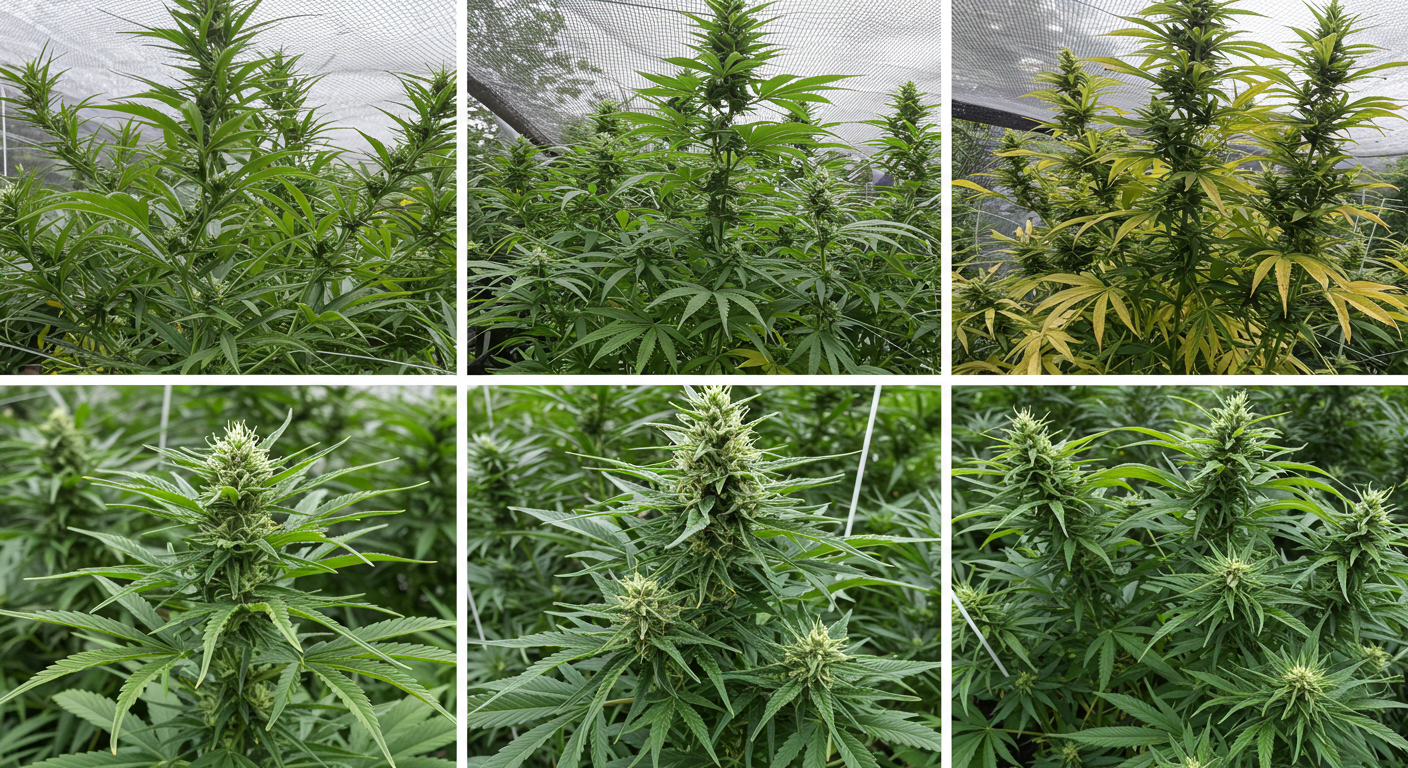
Pests are an inevitable part of outdoor growing, and certain strains are naturally more resistant to insects and pathogens. Pest-resistant strains are usually hardier and less susceptible to damage, which can save you time and effort in pest management.
- Characteristics of Pest-Resistant Strains:
- Thicker stalks and stems to withstand insect bites
- Strong aromas that naturally repel insects and herbivores
- Enhanced resilience against common pests like aphids and spider mites
- Examples of Pest-Resistant Strains:
- Jack Herer: This Sativa-dominant hybrid is known for its pest resilience and is a great option for regions where insects are a concern.
- White Widow: White Widow has strong aromatic qualities that deter pests, and it is a good choice for areas with heavy insect activity.
- Sour Diesel: Its pungent odor and tough foliage make it naturally resistant to many types of pests, making it a reliable outdoor strain.
Tips for Selecting the Right Strain for Your Garden
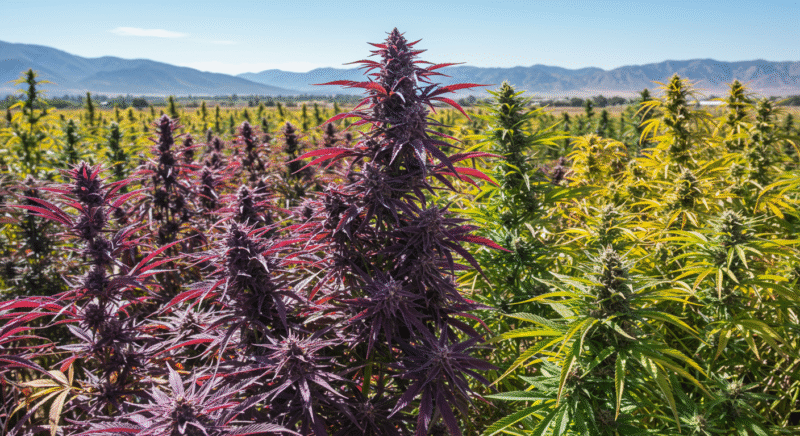
- Understand Your Local Climate: Research your region’s growing season, average temperature range, and humidity levels to choose strains that will thrive in those conditions.
- Consider Harvest Timing: If you live in a region with an early frost, prioritize strains with shorter flowering periods. If you’re in a warm climate with a long season, you can take advantage of longer-flowering Sativas.
- Match Strain Characteristics to Environment: Look for traits that align with your growing challenges. For example, if you’re in a humid area, focus on mold-resistant strains. In dry areas, drought tolerance is key.
- Source Seeds from Reputable Breeders: Quality genetics make all the difference in outdoor growing. Purchase seeds from breeders known for their environmental specialization, so you’re more likely to get strains that genuinely match your climate needs.
- Experiment with Different Strains: If you’re new to outdoor growing, try a few different strains to see which ones perform best in your specific environment. Taking notes on each strain’s growth and resistance characteristics can help refine your choices for future grows.
THC vs. CBD in Cannabis
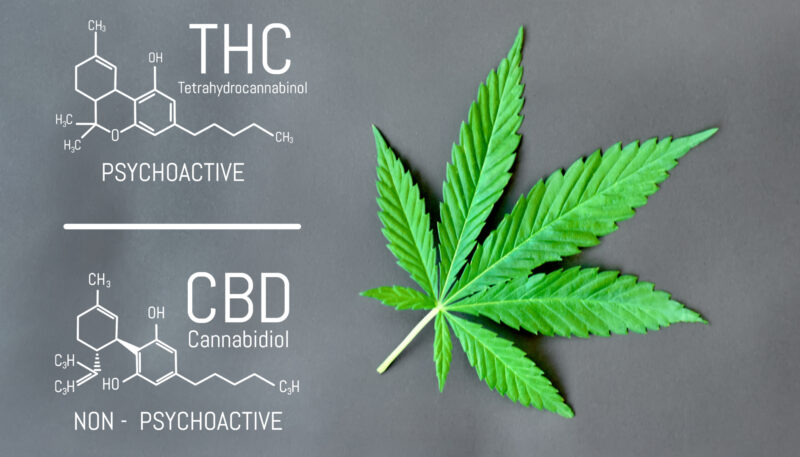
Cannabis is made up of hundreds of compounds, but two of the most well-known are THC (tetrahydrocannabinol) and CBD (cannabidiol). These cannabinoids interact with the body in unique ways, producing distinct effects that can cater to different needs, whether they’re medicinal or recreational. Understanding the differences between THC and CBD, as well as their roles in various cannabis strains, can help you select the best strain for your intended experience.
THC (Tetrahydrocannabinol)
THC is the primary psychoactive compound in cannabis, responsible for the euphoric “high” that users often experience. THC binds directly to the CB1 receptors in the brain, affecting regions related to memory, thinking, coordination, pleasure, and time perception. This compound is largely associated with Sativa strains, but it’s present in varying amounts across all cannabis varieties.
Effects of THC

THC produces a range of effects, depending on the strain, dosage, and individual tolerance. Here’s what you can typically expect:
- Euphoria and relaxation: THC often creates feelings of joy or relaxation, which is why it’s popular for social settings and creative activities.
- Heightened sensory perception: Many users report intensified senses, with colors appearing more vivid, sounds more pronounced, and tastes more intense.
- Appetite stimulation: Known as the “munchies,” THC tends to increase appetite, which can benefit those with eating disorders or undergoing treatments that suppress appetite.
- Pain relief: THC is also known for its analgesic (pain-relieving) properties, making it popular among those with chronic pain conditions.
Potential Downsides of THC
THC can also have some unwanted effects, especially at higher doses:
- Anxiety and paranoia: High THC levels can cause anxiety or paranoia, particularly for users sensitive to this compound.
- Short-term memory issues: THC may impair short-term memory and make it harder to focus, though this effect typically subsides after the high fades.
- Increased heart rate: THC can cause a temporary increase in heart rate, which may be uncomfortable for some users.
CBD (Cannabidiol)
CBD is a non-psychoactive cannabinoid meaning it doesn’t produce the “high” associated with cannabis. CBD works primarily by influencing the CB2 receptors in the body, which are involved in managing immune responses, inflammation, and pain. As a result, CBD is often favored by users seeking medicinal benefits without psychoactive effects.
Effects of CBD
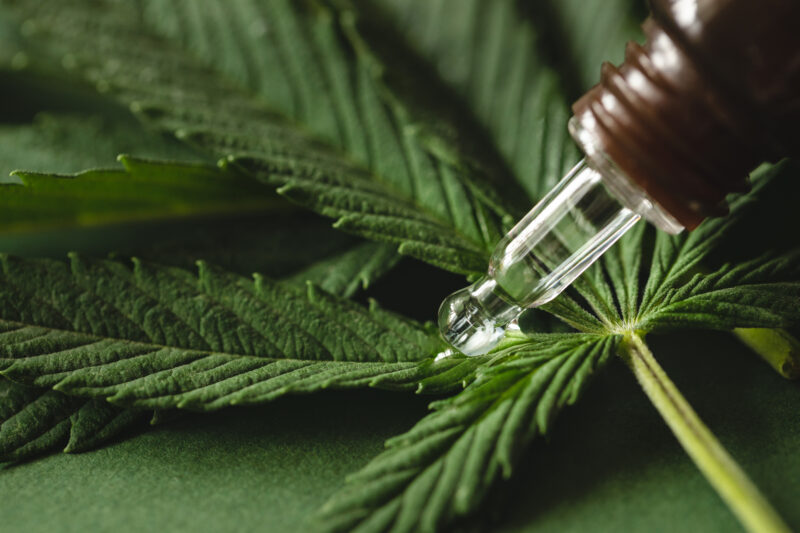
CBD has gained popularity due to its numerous therapeutic applications and minimal side effects. Common effects include:
- Relaxation without intoxication: CBD promotes relaxation and calm without the high, making it a great option for users who need to stay clear-headed.
- Anti-inflammatory properties: CBD is known for reducing inflammation, which can be beneficial for conditions like arthritis, chronic pain, and sports injuries.
- Anxiety and stress relief: CBD has anxiolytic properties, meaning it can help reduce anxiety and promote a sense of calm without the risk of paranoia.
- Neuroprotective benefits: Studies suggest CBD may help protect nerve cells, making it promising for conditions like epilepsy, Alzheimer’s, and Parkinson’s disease.
Potential Downsides of CBD
While CBD is generally well-tolerated, it can interact with other medications, and some users report minor side effects:
- Dry mouth: CBD can reduce saliva production, leading to dry mouth in some users.
- Drowsiness: In higher doses, CBD may cause drowsiness, which can be beneficial at night but may interfere with daily activities if taken during the day.
- Digestive issues: Occasionally, CBD can cause mild digestive upset, especially if taken in large amounts or on an empty stomach.
Strain Selection Based on Cannabinoid Profile
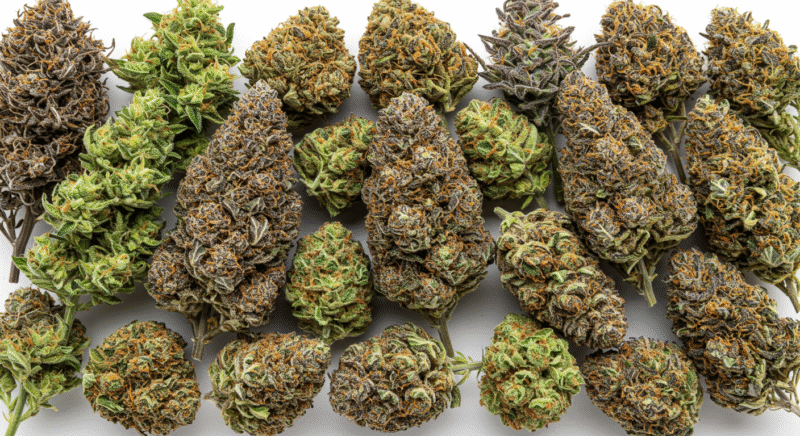
Choosing a cannabis strain based on its THC and CBD content is essential to meet specific needs and desired effects. Understanding the cannabinoid profile of each strain allows consumers to select strains that deliver the most beneficial effects, whether for medical or recreational use.
High-THC Strains
High-THC strains are popular among recreational users and medical patients who need relief from intense pain or nausea.
- Examples: Strains like Girl Scout Cookies, OG Kush, and Sour Diesel are known for high THC levels, often exceeding 20%.
- Uses: High-THC strains are commonly chosen for their euphoric, relaxing effects, which can relieve pain, stimulate appetite, and elevate mood.
- Considerations: High-THC strains can be overwhelming for beginners or those with low tolerance and may cause anxiety in sensitive users. For those needing relief from severe pain or chronic nausea, however, high-THC strains can be invaluable.
High-CBD Strains
High-CBD strains are ideal for medical users who seek the therapeutic benefits of cannabis without the high associated with THC.
- Examples: Strains like Charlotte’s Web, ACDC, and Harlequin are bred specifically for high CBD levels with minimal THC content.
- Uses: High-CBD strains are widely used for managing conditions such as epilepsy, anxiety, and inflammation without any psychoactive effects. These strains are ideal for individuals who wish to remain clear-headed while benefiting from cannabis.
- Considerations: High-CBD strains are generally mild and well-tolerated, making them suitable for all users, including beginners and individuals sensitive to THC.
Balanced THC-CBD Strains
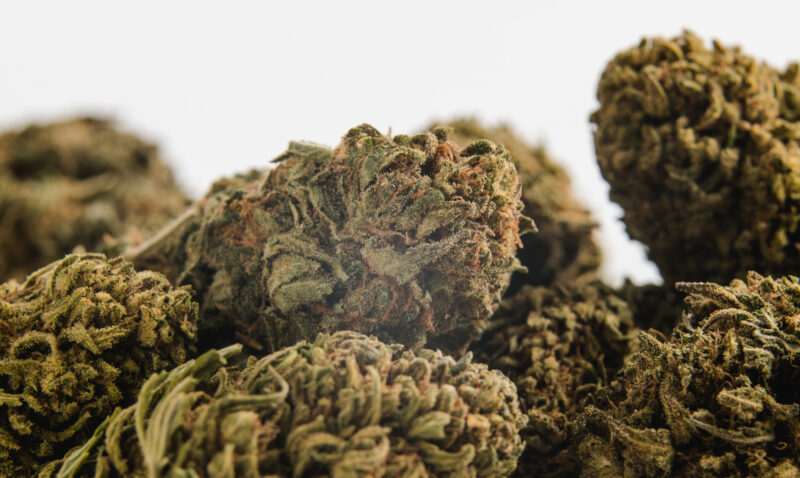
Balanced strains contain a roughly equal ratio of THC to CBD, offering a balanced experience that combines mild psychoactivity with therapeutic effects.
- Examples: Cannatonic, Pennywise, and Dancehall are popular balanced strains with a 1:1 THC-CBD ratio.
- Uses: These strains are beneficial for users looking for relief from pain, anxiety, and other symptoms without the intense high of THC-dominant strains. They provide a gentle, manageable psychoactive experience that enhances relaxation and mood while also delivering medicinal effects.
- Considerations: Balanced strains are ideal for users who enjoy mild psychoactivity along with therapeutic effects. They are also beneficial for users new to cannabis, as the CBD helps to moderate the psychoactive effects of THC.
Medical vs. Recreational Purposes
Cannabis can be used for both medical and recreational purposes, but the choice of strains, cannabinoid profiles, and methods of consumption may vary widely depending on the goal of use.
Medical Use of Cannabis
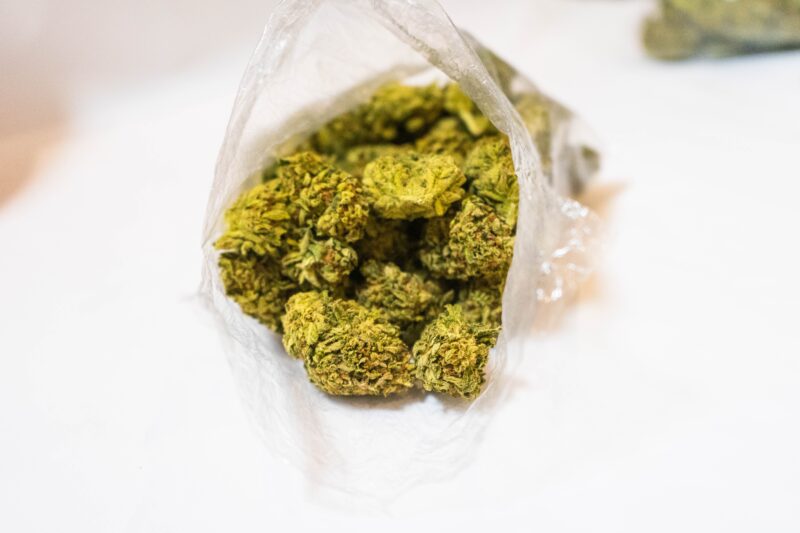
Before using cannabis for medicinal purposes, consult with a healthcare professional to ensure it’s safe and suitable for your condition. Medical cannabis can interact with certain medications and may not be appropriate for everyone. Consulting with a professional helps your approach, ensuring the most effective and safe use of cannabis.
Medical cannabis is chosen for its therapeutic properties and is often recommended or prescribed for specific symptoms and conditions.
Pain Relief: Many medical cannabis users seek strains high in THC for pain relief, as THC interacts with pain receptors in the brain to provide effective relief. Indica-dominant strains like Northern Lights or hybrids like Blue Dream are popular for this purpose.
Anti-Inflammatory Benefits: CBD-dominant strains such as Harlequin or ACDC are favored for their anti-inflammatory properties, making them effective for autoimmune conditions, arthritis, and other inflammatory issues.
Anxiety and Stress Reduction: For those seeking anxiety relief, high-CBD strains like Charlotte’s Web or balanced strains like Cannatonic provide calm without the risk of THC-induced anxiety.
Sleep Aid: High-THC Indica strains are typically recommended for individuals with insomnia due to their sedative effects. Strains like Granddaddy Purple or Bubba Kush can promote relaxation and help induce sleep.
Anti-Seizure Properties: High-CBD strains have shown great promise in managing seizures, particularly in children with treatment-resistant epilepsy. Charlotte’s Web, developed specifically for epilepsy, is one of the most well-known strains for this purpose.
Recreational Use of Cannabis
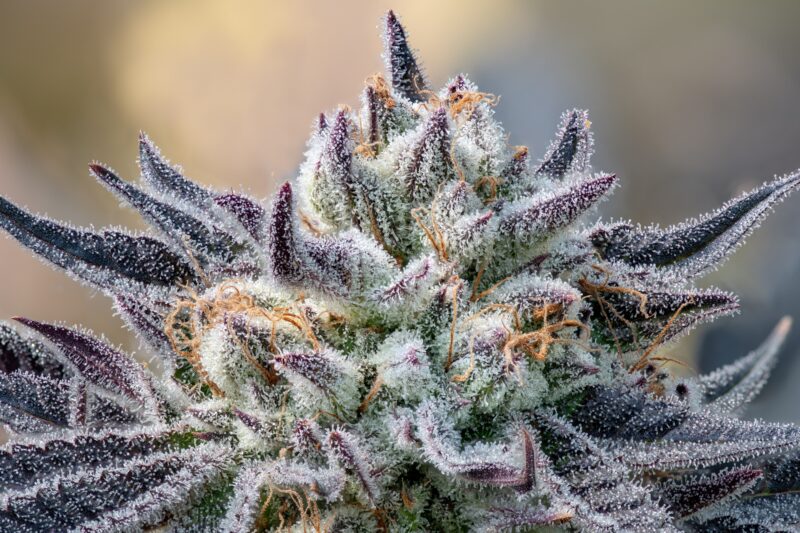
Recreational cannabis use focuses primarily on the psychoactive effects of THC, though CBD also plays a role for those seeking a more balanced or manageable experience.
Euphoria and Mood Enhancement: High-THC Sativa strains like Sour Diesel and Jack Herer are popular among recreational users for their uplifting effects, which can enhance mood, creativity, and sociability.
Relaxation and Body High: Many recreational users turn to high-THC Indica strains like Gorilla Glue #4 or Afghan Kush for their deep relaxation effects. These strains provide a calming body high, making them popular for unwinding at the end of the day.
Balanced Experiences: For users looking to enjoy cannabis without overpowering high, balanced THC-CBD strains are ideal. They offer a mild euphoria coupled with relaxation, providing a more controlled experience. Strains like Pennywise and Cannatonic offer this balance and are popular among social users.
Enhanced Sensory Experience: Cannabis has been known to heighten sensory perceptions, and certain strains are particularly well-suited for this. Sativa strains are favored for their ability to amplify colors, sounds, and tastes, making them popular for artistic endeavors or social gatherings.
Tips for Decide Strain Selection Your Needs
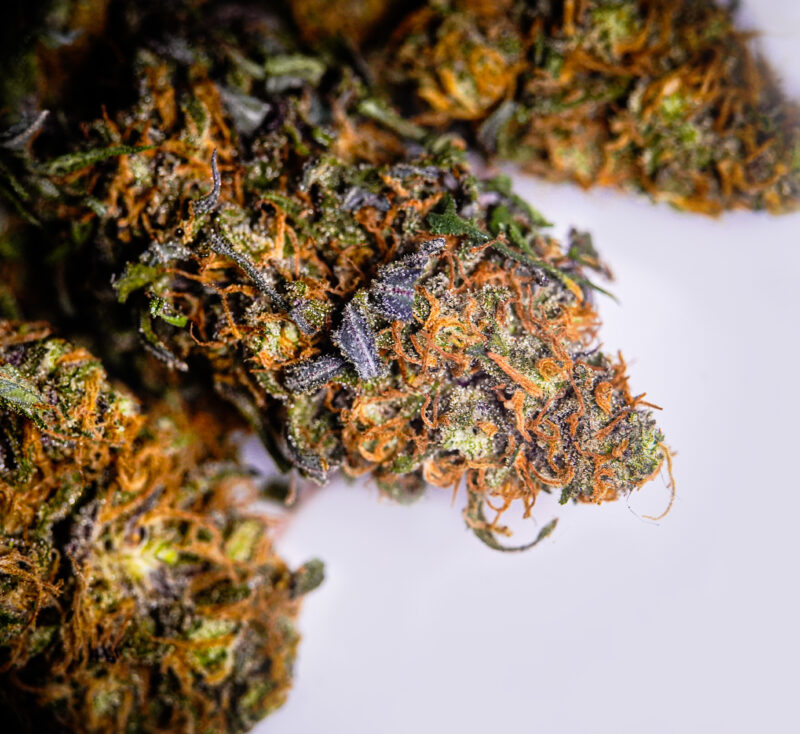
Choosing the right strain goes beyond just THC or CBD content. Here are a few factors to keep in mind:
Know Your Goals: Are you using cannabis for pain relief, anxiety reduction, or recreational enjoyment? Identifying your goals helps narrow down your choices.
Tolerance Levels: Beginners or individuals with low tolerance may prefer high-CBD or balanced strains to avoid potential anxiety or overwhelming psychoactivity.
Medical History: For those with a medical history of anxiety or sensitivity to THC, CBD-dominant or balanced strains are generally more suitable.
Test Different Strains: Experimenting with different strains allows you to find the cannabinoid profile that works best for your specific needs. Keep track of each strain’s effects and adjust accordingly.
Consider Terpenes: Terpenes, the aromatic compounds found in cannabis, play a role in modulating the effects of THC and CBD. Some terpenes, like myrcene, enhance relaxation, while others, like limonene, are more uplifting. Considering terpene profiles along with cannabinoid content can provide a more tailored experience.
Germination and Seedling Care
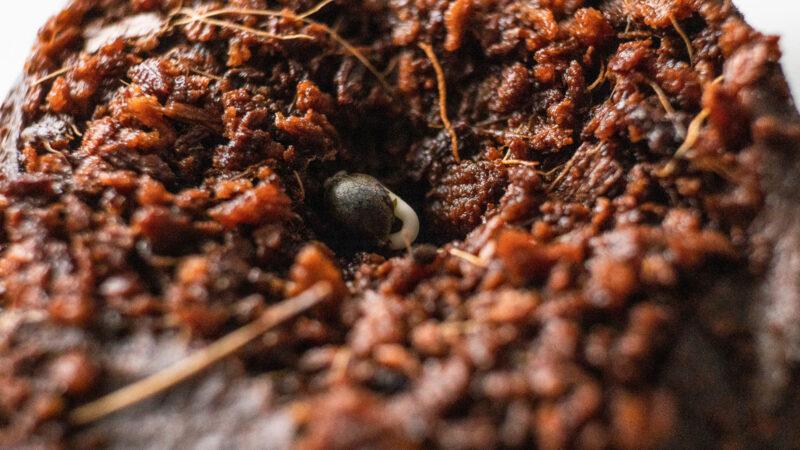
Germination and early seedling care are foundational steps, where each choice impacts the plant’s overall health, structure, and potential yield. Successful germination leads to a vigorous start, and proper care ensures seedlings develop the strength to thrive in outdoor conditions.
Understanding Germination
Germination is the initial phase where life awakens from within the seed. This process typically begins when the seed is exposed to moisture and warmth, activating enzymes that break down stored energy and allow the embryo to emerge. Germination is not just the first step but a defining moment in cannabis cultivation, as it sets the tone for the plant’s health and growth trajectory. Poor germination can lead to weak plants, while a robust germination phase produces seedlings with strong, resilient structures.
Starting Indoors

Never plant your cannabis seeds directly into outdoor soil. Instead, germinate your seeds indoors and transplant the seedlings once they’re strong enough. One favored method is to use small plastic pots to start your seeds inside. Once the seedlings have developed enough, carefully cut the bottoms off the pots and replace them with a small piece of cardboard or a shoebox bottom. When you’re ready to transplant them outdoors, dig a small hole at your grow site, remove the cardboard, and carefully place the plant into the hole. This method ensures the seedlings are well-established before going into the ground, greatly increasing their chances of survival.
Cloning is another excellent option for those who want to guarantee all-female plants outdoors. You can clone your females indoors and then transplant the clones using the same method described above. This way, you avoid the hassle of weeding out males later in the season—plus, all of your plants will be guaranteed to produce buds.
Note: Using a commercially available transplant chemical can help your plants overcome the initial shock of being moved outdoors, giving them a smoother transition and a better chance of thriving.
Seed Germination Techniques
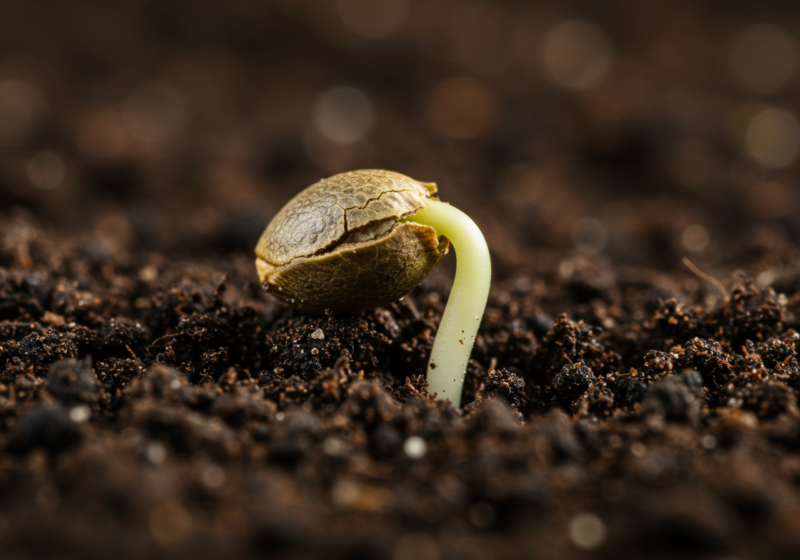
Germination is the initial phase of a seed’s life, where it begins to sprout roots and shoot growth. It’s a delicate period requiring the right mix of moisture, warmth, and air.
Two primary germination techniques dominate: the paper towel method and direct sowing into the soil. Each has its own benefits and best-use cases, depending on the grower’s objectives, environmental factors, and resources. While both techniques aim to produce a healthy seedling, understanding each method’s nuances can help growers make informed decisions.
Paper Towel Method
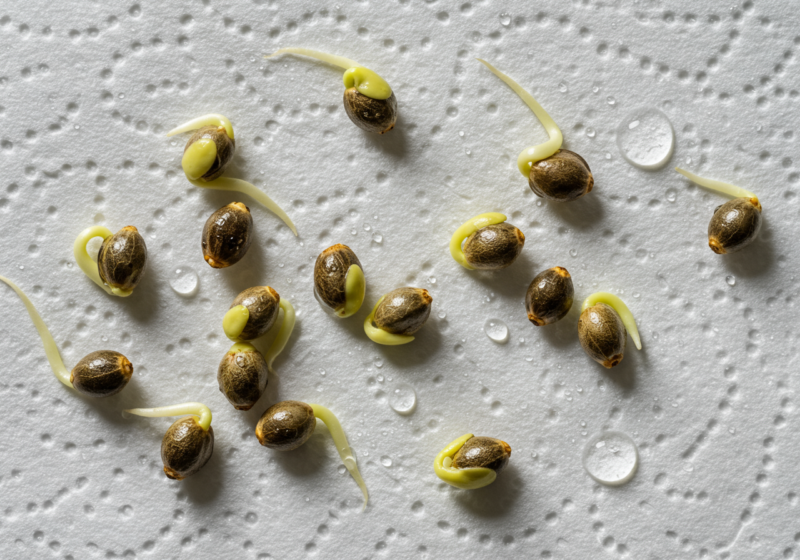
The paper towel method is a simple, effective way to germinate seeds with minimal equipment. This technique allows growers to monitor the progress closely and ensures that only viable seeds are planted.
- Materials: You’ll need a few paper towels, a plate, water, and a plastic cover or ziplock bag.
- Steps:
- Moisten two sheets of paper towel with distilled water, making sure they are damp but not soaking.
- Place the seeds on one of the moist towels and cover with the second towel.
- Place the setup on a plate and cover with another plate or inside a plastic bag to maintain moisture.
- Store in a warm, dark place—ideally, between 70°F and 85°F (21°C - 29°C). Check daily for moisture, adding water if needed.
- Germination Timeline: Cannabis seeds usually sprout within 2-7 days. The seed is ready for transplanting once the root emerges and reaches around ¼ inch (0.6 cm) long.
- Transplanting: The seeds can be carefully transferred to their growing medium once sprouted. Handle gently to avoid damaging the delicate root.
Direct Sowing in Soil
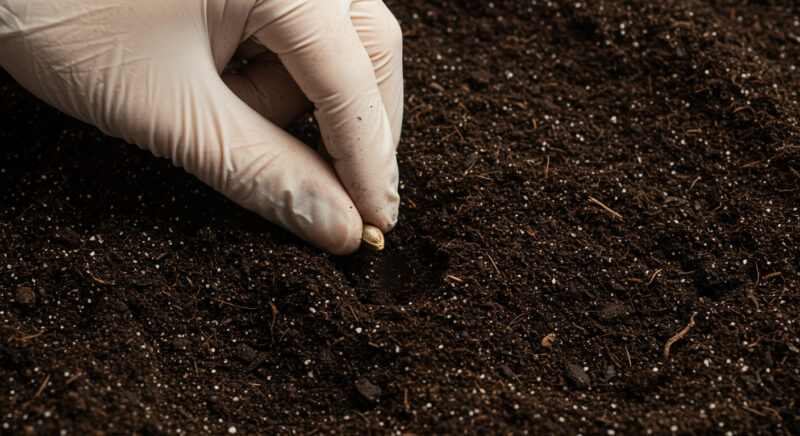
Directly planting seeds in soil is another viable option, especially for growers who want to avoid the risk of damaging roots during transplanting. However, this method can have a slower germination rate than the paper towel technique.
- Choose a Suitable Soil: Use a light, airy soil blend with good drainage. Adding perlite or vermiculite can improve aeration and water retention.
- Planting the Seeds:
- Make a small hole about ¼ inch (0.6 cm) deep in the soil.
- Place the seed root-side down (pointed end facing down) and cover it lightly with soil.
- Moisten the soil gently using a spray bottle, ensuring it’s damp but not saturated.
- Environment: Keep the soil warm, ideally between 70°F and 80°F (21°C - 27°C), and provide indirect sunlight or grow lights. For outdoor setups, wait until the soil temperature is stable above 60°F (15°C) to avoid cold shock.
- Germination Timeline: Seeds will generally sprout within 7-10 days. Maintain consistent moisture and avoid disturbing the soil during this period.
Transitioning Your Seedlings
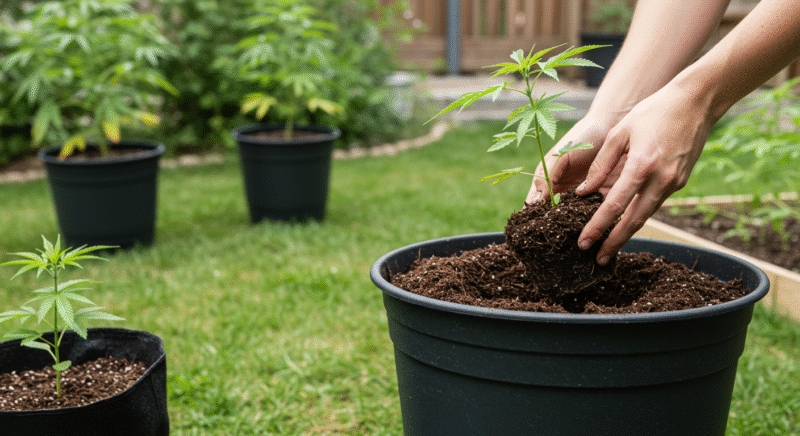
Moving vegetative starts to your outdoor grow area can be one of the trickiest parts of outdoor cultivation. Germinating seeds directly in the soil outdoors is not recommended because they’re vulnerable to pests, weather, and poor conditions. Instead, germinate your seeds at home and keep the seedlings indoors or in your garden until they are strong enough for transport. It’s also a good idea to wait until the seedlings are showing their sex before you transplant them outdoors so you don’t waste time and effort on male plants that won’t produce buds.
Since you can’t tell the difference between male and female seeds just by looking at them, you’ll have to wait for the seedlings to develop before you can identify their sex. Once you’ve separated the males from the females, you can transport only the female plants to your grow site.
Another efficient method for transporting seedlings is to start them in 3-inch rockwool cubes. You can place up to 20 cubes in a litter pan, cover it with another pan for protection, and transport them to your outdoor grow area. Once at the grow site, the rock wool cubes can be planted directly into the soil, providing an easy and efficient method for transplantation.
Starting your plants indoors and ensuring they’re well-established before moving them outdoors, you set yourself up for a successful outdoor grow. Plan ahead and take care during the transplant process, and your marijuana plants will reward you with a plentiful harvest.
Setting the Depth and Planting the Seedling
Transplanting depth and spacing are crucial for the cannabis plant’s development, affecting root spread, nutrient uptake, and ultimately plant size and yield.
Depth: Finding the Right Planting Depth
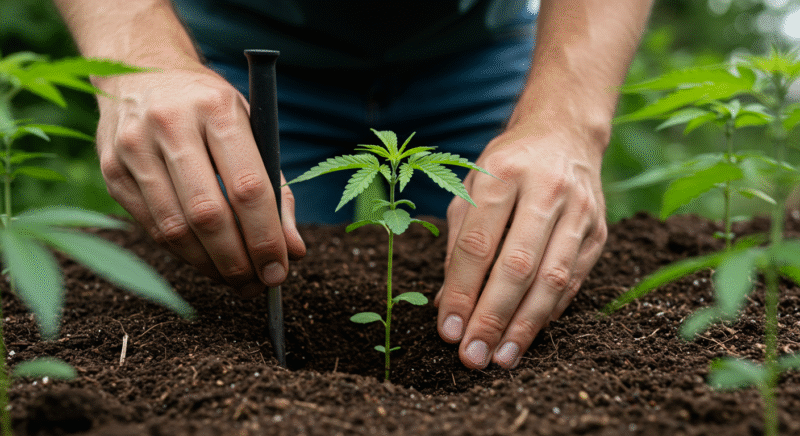
Proper planting depth gives the roots access to moisture and nutrients and stabilizes the plant against wind and other elements.
- Plant Level with Ground Surface: Place the seedling in the hole so that the soil line on the seedling’s stem aligns with the soil surface in the planting site.
- Avoid Burying the Stem: Planting too deep can encourage stem rot. Cover only the root ball and leave the stem exposed to prevent moisture buildup around the base.
Spacing for Optimal Growth
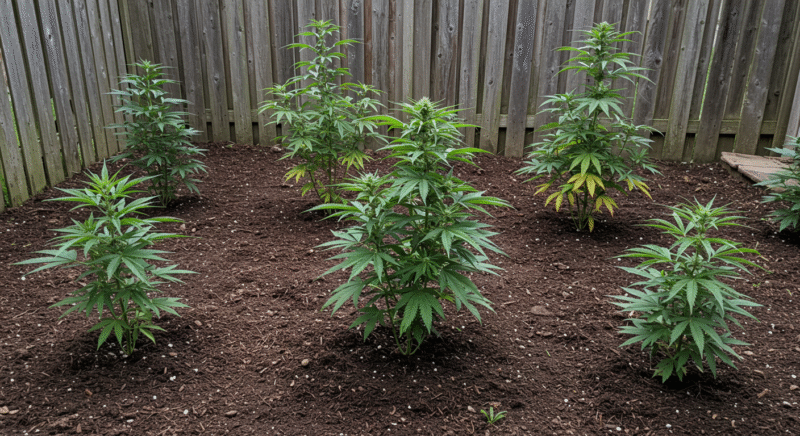
Space each plant to give the root system ample room to expand. Crowding plants restricts airflow, limits sunlight access, and can increase the risk of pests and diseases.
Outdoor Plants: For outdoor grows, spacing can range from 3 to 6 feet between plants, depending on the strain. Indica strains typically grow shorter and bushier, so 3-4 feet might suffice. Sativa strains, on the other hand, can grow taller and may require up to 6 feet of space.
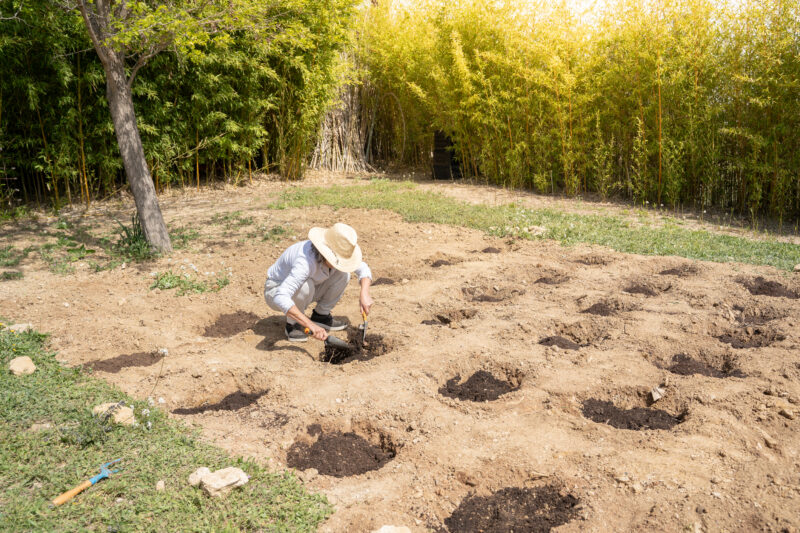
Container Grows: For container-grown plants, use pots large enough to accommodate the plant’s full growth potential. A minimum of 5 gallons is recommended, but for larger outdoor plants, 10-gallon or larger containers will yield better results.
Common Mistakes to Avoid
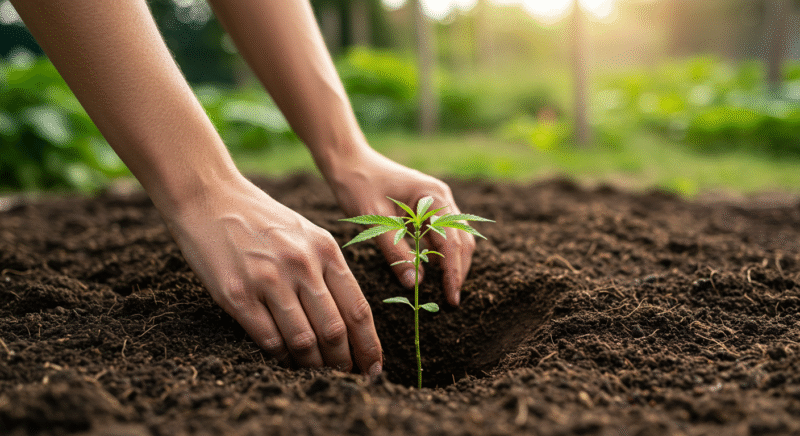
Transplanting is straightforward, but a few common mistakes can set back your plants. Avoid these pitfalls for a successful transplant:
- Transplanting Too Early or Late: Seedlings need a stable root system before transplanting. Avoid moving them too early, as they might not have the strength to adapt to new conditions.
- Inadequate Spacing: Crowding can cause problems later, especially outdoors. Make sure to space plants according to their growth habits to prevent overlapping and shading issues.
- Overwatering: Newly transplanted seedlings require careful watering, but overdoing it can suffocate roots. Watering should be thorough but not excessive.
The Vegetative Stage of Outdoor Grow
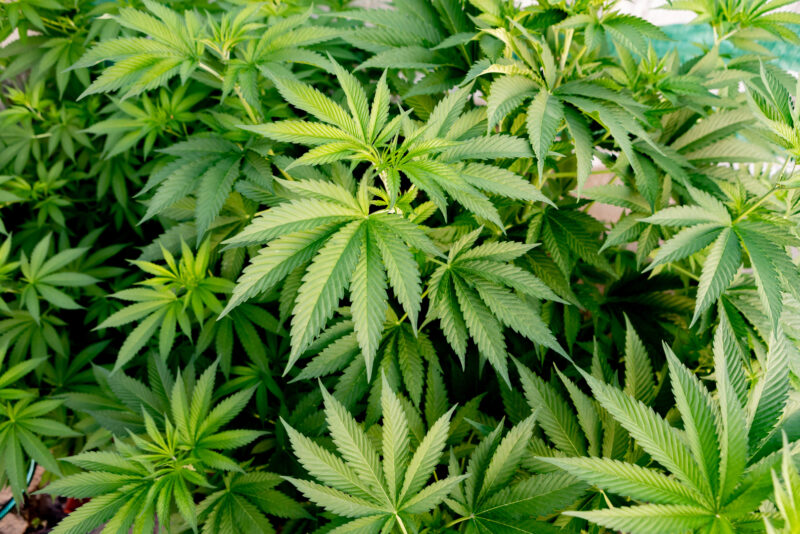
The vegetative stage is a pivotal period in the life cycle of a cannabis plant, where it undergoes vigorous growth and prepares for the flowering phase. This stage begins after the plant has established itself as a sturdy seedling and is the building block for a successful outdoor grow. During this phase, the plant concentrates on developing robust structures—strong roots, thick stems, and abundant leaves—all of which contribute to supporting heavy flowers later in its cycle. For outdoor growers, understanding the vegetative stage and recognizing its signs is essential for fostering healthy, productive plants.
Transition to the Vegetative Stage
The vegetative stage officially begins when the seedling phase ends, typically a few weeks after germination. At this point, the plant has developed its first few sets of true leaves and has established a foundational root system. During this stage, the plant shifts from establishing itself to intensifying its growth in preparation for flowering.
In outdoor environments, cannabis plants transition naturally to the vegetative stage as they respond to increasing daylight hours in spring and early summer. This period of rapid growth can span several months, depending on the local climate and day length, making it a crucial time to closely monitor the plant’s development.
Importance of the Vegetative Stage
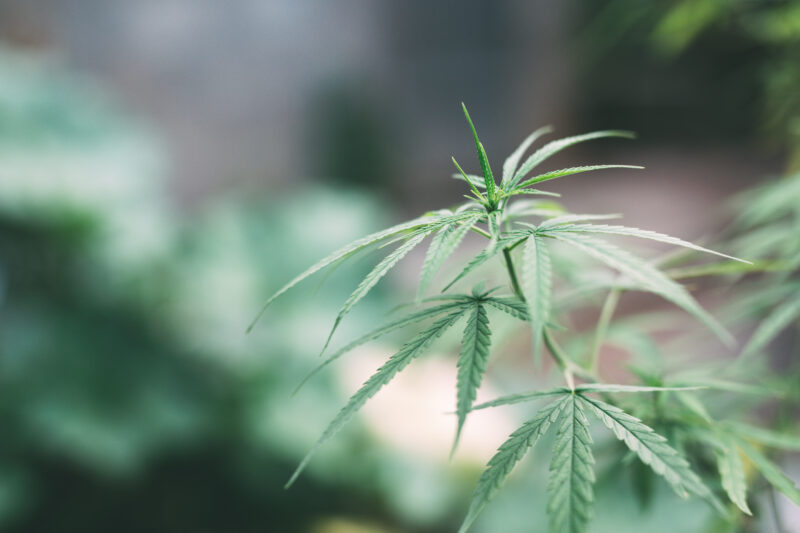
The vegetative stage lays the groundwork for a productive flowering phase. During this time, the plant’s main focus is to build strong, resilient structures that will support heavy, resinous buds later on. This stage is essential for:
- Establishing Root Depth: Healthy root systems developed during the vegetative stage provide the plant with stability and ensure optimal nutrient and water absorption throughout its lifecycle.
- Developing Foliage: Leaf growth during this stage maximizes the plant’s photosynthetic ability, enabling it to capture more sunlight and produce energy required for the rest of its growth.
- Building Stalks and Branches: Sturdy stalks and well-developed branches will be essential for holding the weight of the plant’s flowers during the flowering phase, especially in outdoor settings where wind and weather can be factors.
- Increasing Plant Size: The larger a plant becomes in the vegetative stage, the greater its potential yield in the flowering stage. Outdoor plants often have a longer vegetative period than indoor plants, allowing them to grow much larger.
In short, a successful vegetative stage is the foundation of a high-yielding outdoor cannabis plant, making it an essential phase to monitor and support carefully.
During the vegetative stage, cannabis plants exhibit specific growth patterns and physical signs that distinguish this period from other stages of development. Knowing what to look for can help growers confirm that their plants are on the right track.
Key Signs of the Vegetative Stage:
- Rapid Growth: In the vegetative stage, cannabis plants grow rapidly, often doubling in size over a few weeks. Stems elongate, new nodes form, and the plant expands both vertically and horizontally.
- Larger Leaf Formation: During this period, the plant produces large, fan-like leaves with multiple “fingers” characteristic of mature cannabis foliage. The leaves are crucial for photosynthesis and help the plant absorb more sunlight.
- Development of Branches and Nodes: Nodes, the points on the stem where leaves and branches grow, become more numerous and closely spaced. As the plant grows, these nodes prepare to support future bud sites.
- Absence of Preflowers: While the vegetative stage is a time of intense growth, it’s also a non-reproductive period. No signs of flowering (pistils or pollen sacs) should be visible at this stage.
Signs of a Healthy Vegetative Stage
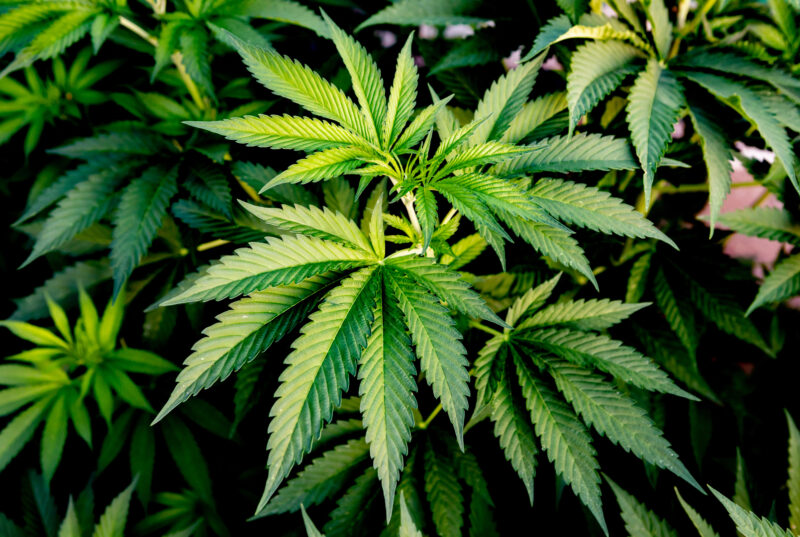
Several visual cues and overall plant vitality characterize a healthy vegetative stage. Growers should regularly inspect their plants to ensure they’re thriving and free of signs of stress or disease. Here are some indicators of a vigorous vegetative phase:
Vibrant Green Foliage: Healthy cannabis plants display a rich, vibrant green color. Pale or yellowing leaves can signal issues that need addressing, such as nutrient imbalances or environmental stress.
Thick, Strong Stems: The main stalk and branches should be firm and sturdy, capable of supporting the plant as it continues to grow. Weak, thin stems may suggest a lack of sunlight or other issues.
Symmetrical Growth: In a well-balanced vegetative stage, branches grow symmetrically from the main stem. This symmetry indicates that the plant is receiving even light distribution and is experiencing optimal growth.
Rapid Leaf Production: Healthy plants will continue producing large fan leaves throughout the vegetative stage. The more foliage a plant has, the more energy it can create for itself through photosynthesis.
Uniform Node Development: Nodes should be spaced evenly along the main stem, supporting balanced branching and setting up a well-structured plant for future flowering.
What to Monitor During the Vegetative Stage
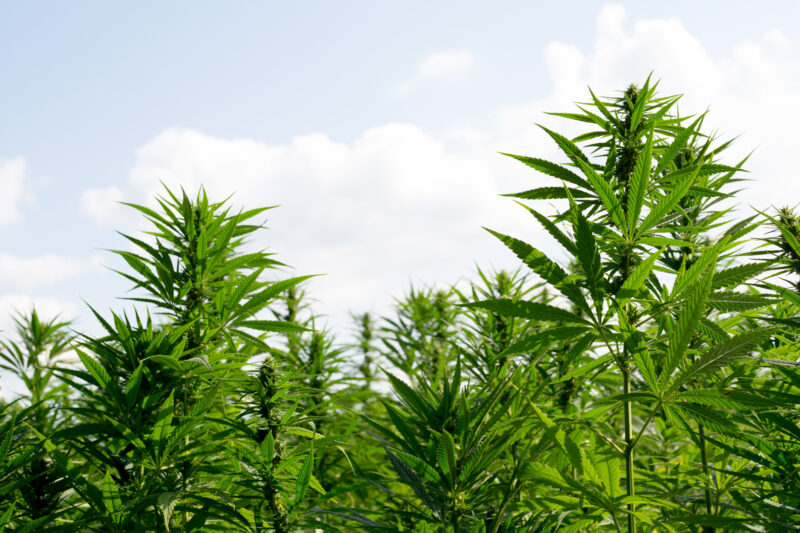
Keeping an eye on specific aspects of plant health will help you identify potential problems early and ensure your plants continue growing vigorously throughout the vegetative stage. Here’s what to look out for:
- Leaf Health: Leaves should be consistently green and free from discoloration or spots. Any yellowing, curling, or spotting on the leaves could indicate issues such as pest infestations, nutrient deficiencies, or environmental stress.
- Stem and Branch Strength: The stems and branches should feel solid, not flimsy. If the stems are weak, it might signal a need for better support or adjustments in the growing environment.
- Growth Rate: Healthy cannabis plants in the vegetative stage grow noticeably day by day. A slowdown in growth could indicate a lack of water, nutrients, or sunlight.
- Environmental Stress Signs: Outdoor plants may be subjected to weather fluctuations, wind, and pests. Regularly inspect for signs of damage caused by these external factors to address any potential issues early.
Maintaining Plant Health in the Vegetative Stage
Ensuring your plants stay healthy throughout the vegetative phase involves consistent observation and preventive care. By paying attention to details and responding to your plants’ needs, you set the stage for a productive flowering period. Here are a few key practices:
- Regular Inspections: Check your plants at least a few times weekly to monitor their progress and promptly address any emerging issues.
- Protection Against Pests: As your plants grow, they may attract various pests. Look for signs of insect damage on leaves and stems, and consider organic pest management options if necessary.
- Physical Support: As plants grow larger, they may require extra support to handle their increasing height and weight. Consider tying branches gently or using stakes if necessary to keep them upright.
- Encouraging Structural Strength: Lightly brushing or gently bending branches can help strengthen the plant’s structure, preparing it to support heavier flowers in the future. However, avoid overly aggressive training techniques in the early vegetative stage to prevent stress.
Nutrient Requirements for Vegetative Plants
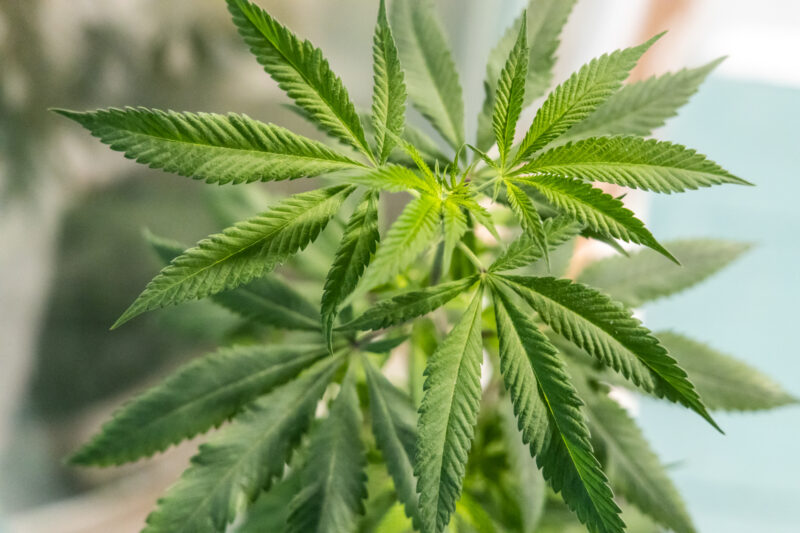
Cannabis plants have specific nutrient needs at each growth stage, and the vegetative stage is no exception. During vegetative growth, cannabis focuses on developing a robust root system, thick stems, and large, broad leaves, which together enable the plant to photosynthesize efficiently and store the energy needed for the flowering stage. This vigorous growth requires a balanced mix of macronutrients—primarily nitrogen (N), phosphorus (P), and potassium (K)—as well as micronutrients like calcium, magnesium, and iron. However, nitrogen is the most critical nutrient during the vegetative phase, playing a vital role in leaf and stem production.
Nitrogen: The Key Nutrient for Vegetative Growth
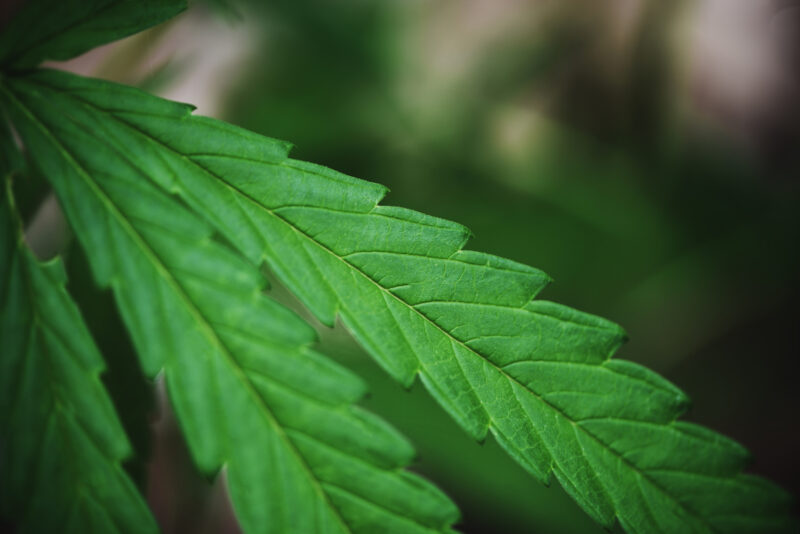
Nitrogen is the primary building block of chlorophyll, the molecule responsible for photosynthesis, as well as amino acids and proteins. During vegetative growth, cannabis plants need a continuous supply of nitrogen to fuel the production of new leaves and stems. The more nitrogen available, the more effectively the plant can carry out photosynthesis, producing the energy needed to grow strong and resilient.
When cannabis plants receive adequate nitrogen, they exhibit rapid growth and develop lush, dark green foliage. Nitrogen deficiencies, on the other hand, are quickly visible in the form of yellowing leaves (a condition known as chlorosis), stunted growth, and weak stems. In outdoor grows, nitrogen is particularly important because plants are exposed to environmental stressors, including temperature fluctuations, wind, and pest pressure, all of which require a strong, resilient structure to withstand.
While nitrogen is critical, it’s essential to monitor the amount carefully, as overfeeding can lead to nutrient toxicity. Signs of nitrogen toxicity include dark green, claw-like leaves and slowed root development, which can negatively impact the plant’s ability to support heavy buds in the flowering stage. Moderation and balance are key to successful nitrogen management.
Role of Phosphorus and Potassium in Vegetative Growth
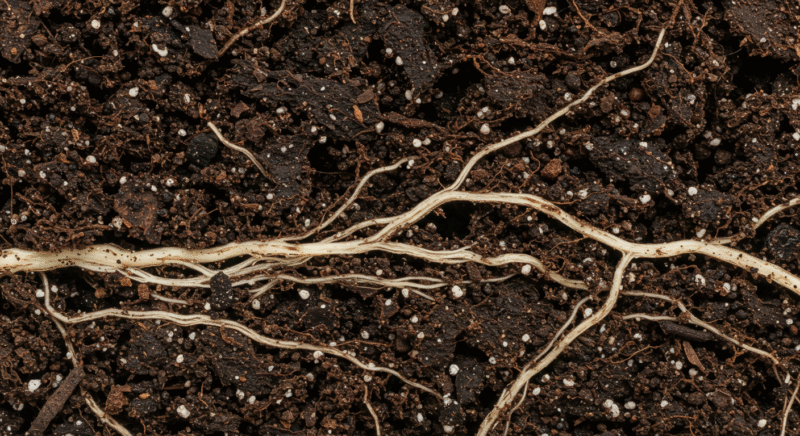
While nitrogen takes center stage during vegetative growth, phosphorus and potassium play important supporting roles. Phosphorus aids in root development and energy transfer within the plant. Healthy root systems allow the plant to absorb nutrients and water more efficiently, enabling it to sustain faster growth rates. Phosphorus also contributes to energy transfer through ATP (adenosine triphosphate) production, a molecule crucial for cell division and overall vitality.
Potassium, on the other hand, supports stem strength and disease resistance. This nutrient helps plants regulate water usage, withstand drought conditions, and handle environmental stressors. In outdoor environments where conditions are less controlled, potassium is especially valuable, as it enhances the plant’s natural defenses against diseases and pests, creating a sturdier, more resilient structure.
Summarize, while nitrogen is the primary nutrient in vegetative growth, the ideal macronutrient balance for cannabis in this phase is typically a higher nitrogen level, with moderate amounts of phosphorus and potassium to support root strength and structural resilience.
Nitrogen-Heavy Feeding Schedules
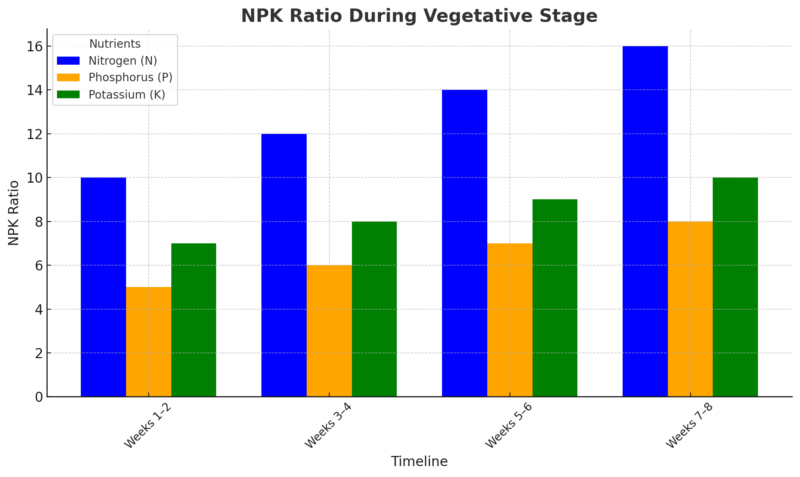
Creating a nitrogen-heavy feeding schedule is essential for optimizing growth during the vegetative stage. Outdoor cannabis plants can benefit from a feeding schedule that gradually increases nitrogen levels as the plants grow, particularly in environments with rich, organic soil. A well-timed nutrient regimen will provide a consistent supply of nitrogen without overloading the plant, which can lead to nutrient toxicity.
Early Vegetative Feeding Schedule
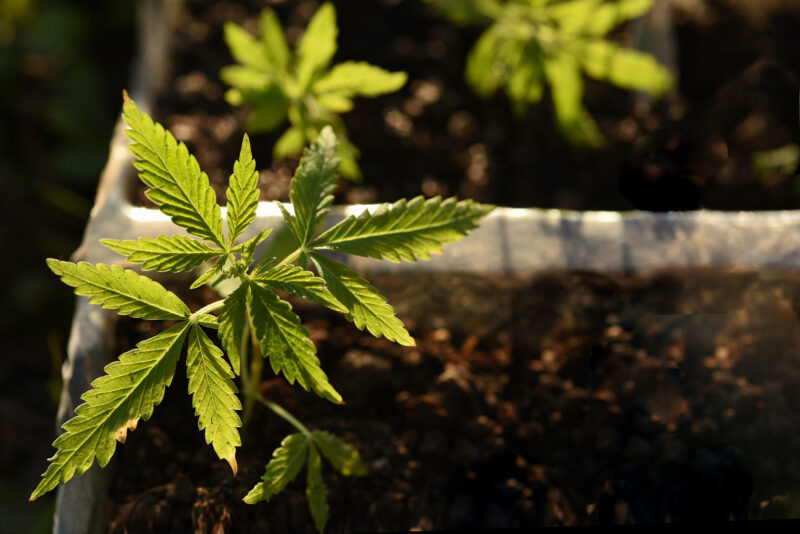
In the early vegetative stage, plants are establishing their root systems and beginning to develop their first sets of true leaves. At this point, they don’t need a heavy dose of nutrients, but a balanced feeding schedule with a nitrogen-forward approach will set them on the right path. Many growers start with a 3-1-2 N-P-K ratio at this stage, which gives the plant a strong dose of nitrogen while still providing the phosphorus needed for root expansion and potassium for overall strength.
At this stage, incorporating organic matter such as compost or worm castings into the soil can provide a slow, natural release of nitrogen and other nutrients, reducing the need for frequent feeding and promoting healthy soil microbial life.
Mid to Late Vegetative Feeding Schedule
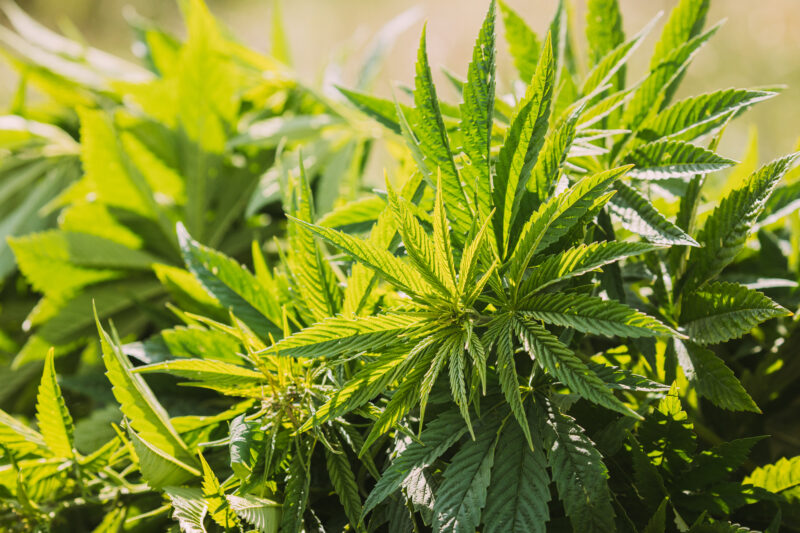
As plants mature and the vegetative stage progresses, they’ll enter a phase of rapid growth. This period typically lasts from four to eight weeks for outdoor plants, depending on the strain and growing conditions. During this stage, cannabis plants will need a higher concentration of nitrogen to support the development of large, healthy fan leaves, which are essential for photosynthesis. Many growers increase the N-P-K ratio to 5-1-3 or even 7-1-3 during the mid-vegetative phase to sustain this vigorous growth.
In the later stages of vegetative growth, as the plants prepare to enter flowering, it’s beneficial to start gradually reducing nitrogen levels and increasing phosphorus and potassium. This shift allows the plant to prepare for flowering, focusing energy on producing bud sites and improving structural integrity. Reducing nitrogen helps to prevent nutrient burn or toxicity, which can hinder bud production in the flowering stage.
Monitoring and Adjusting the Feeding Schedule
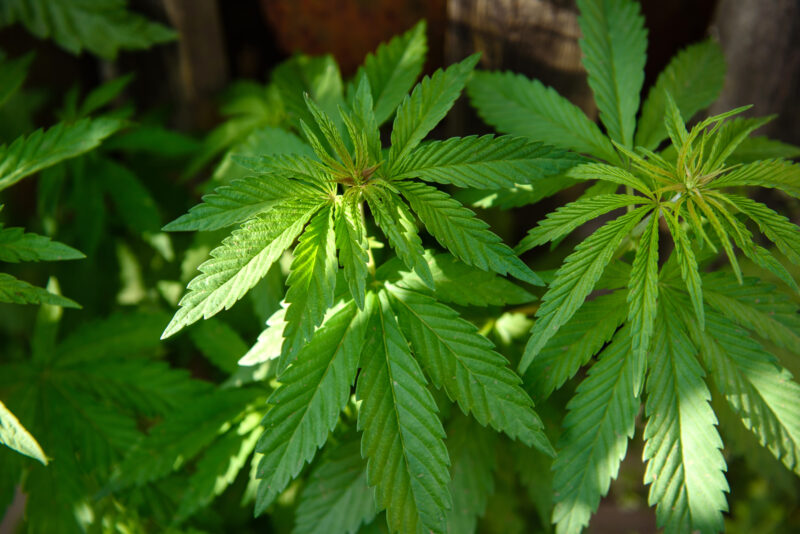
Outdoor conditions vary widely based on climate, soil quality, and weather, so it’s essential to monitor plant health closely and adjust the feeding schedule as needed. If you notice yellowing or stunted growth, your plants may be lacking nitrogen, while dark green leaves and claw-like shapes indicate excess nitrogen. Adjusting the nutrient ratio as you observe these signs will help maintain optimal health.
Additionally, soil testing can be invaluable for outdoor growers, as it reveals the current nutrient levels and pH, allowing for more precise adjustments. Outdoor soil can vary significantly in nutrient content depending on previous use, soil type, and organic matter content. Regular testing can guide your feeding approach, ensuring you’re not overloading or underfeeding your plants.
Organic Fertilizers vs. Synthetic Fertilizers: Pros and Cons
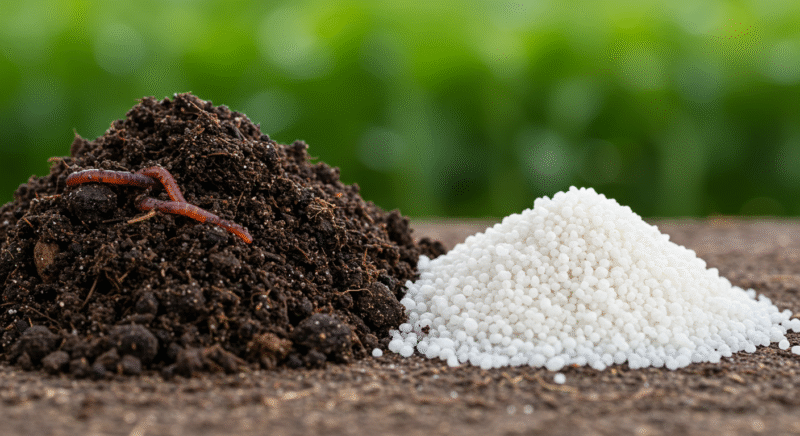
Choosing between organic and synthetic fertilizers is a major decision in cannabis cultivation, and each approach has its own benefits and challenges. Organic fertilizers are derived from natural sources like compost, manure, and plant material, while synthetic fertilizers are manufactured from chemical compounds and designed for quick nutrient delivery. Both options can be effective in promoting healthy vegetative growth, but they offer distinct advantages and disadvantages, particularly in outdoor growing environments.
Organic Fertilizers
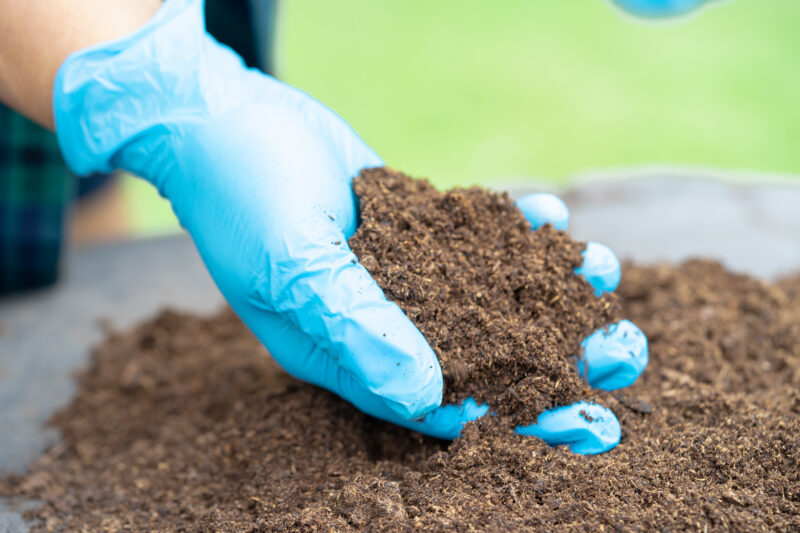
Organic fertilizers work by enriching the soil with nutrients as they break down, releasing nitrogen, phosphorus, and potassium slowly over time. Organic amendments, such as compost, bone meal, and blood meal, not only provide essential nutrients but also improve soil structure, encourage beneficial microbial life, and enhance water retention. This natural approach aligns well with outdoor growing, where the soil ecosystem plays a crucial role in plant health.
Pros of Organic Fertilizers:
- Improved Soil Health: Organic fertilizers promote soil biodiversity, encouraging beneficial microorganisms that aid in nutrient cycling and plant health. Healthy soil reduces the risk of disease and creates a more resilient growing environment.
- Sustainable and Environmentally Friendly: Organic fertilizers are typically biodegradable and do not contain synthetic chemicals, reducing their environmental impact. Many organic amendments are byproducts of agriculture and other industries, making them a sustainable choice.
- Slow, Balanced Nutrient Release: Organic fertilizers break down gradually, providing a steady nutrient supply that minimizes the risk of nutrient burn. This slow release is ideal for the vegetative stage, allowing plants to access nutrients as needed.
Cons of Organic Fertilizers:
- Slow Nutrient Release: Organic fertilizers require time to decompose, which can delay nutrient availability. This may be a disadvantage if plants show signs of deficiency and require immediate nutrient correction.
- Less Precise Control: Organic fertilizers often have variable nutrient content, making it harder to achieve exact N-P-K ratios. For some growers, this unpredictability requires extra attention to soil health and plant monitoring.
- Higher Maintenance: Organic growing can require additional maintenance, including soil amendments and regular monitoring of soil pH, as the decomposition process can sometimes lead to acidity.
Synthetic Fertilizers
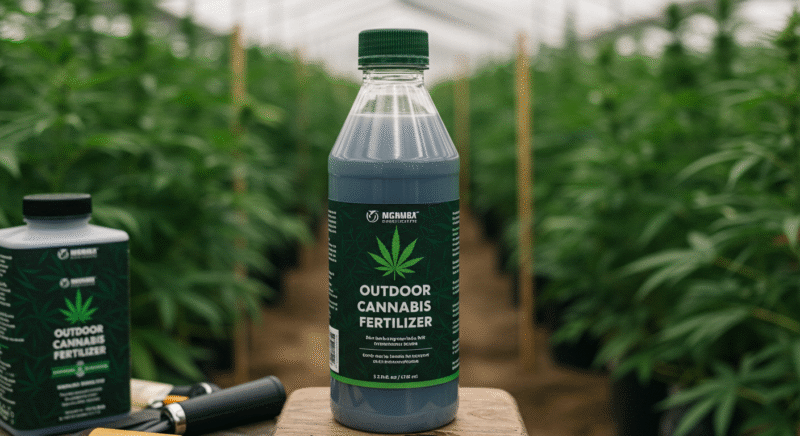
Synthetic fertilizers are formulated from mineral salts and chemical compounds that deliver specific nutrient ratios, making them easy to control and adjust. They are water-soluble, providing nutrients directly to the plant roots for rapid uptake. In outdoor grows, synthetic fertilizers offer convenience and can be particularly useful for addressing acute nutrient deficiencies quickly.
Pros of Synthetic Fertilizers:
- Fast-Acting: Synthetic fertilizers provide nutrients immediately, allowing plants to absorb them quickly. This can be highly beneficial for plants showing signs of nutrient deficiency, as it allows for rapid correction.
- Precision and Control: Synthetic fertilizers offer exact N-P-K ratios, making it easier for growers to customize nutrient regimens according to the plant’s specific needs. This precision can help prevent nutrient imbalances and streamline feeding schedules.
- Lower Maintenance: Synthetic fertilizers are simple to apply and require minimal preparation compared to organic amendments. Many synthetic products are premixed and can be easily measured for accurate dosing.
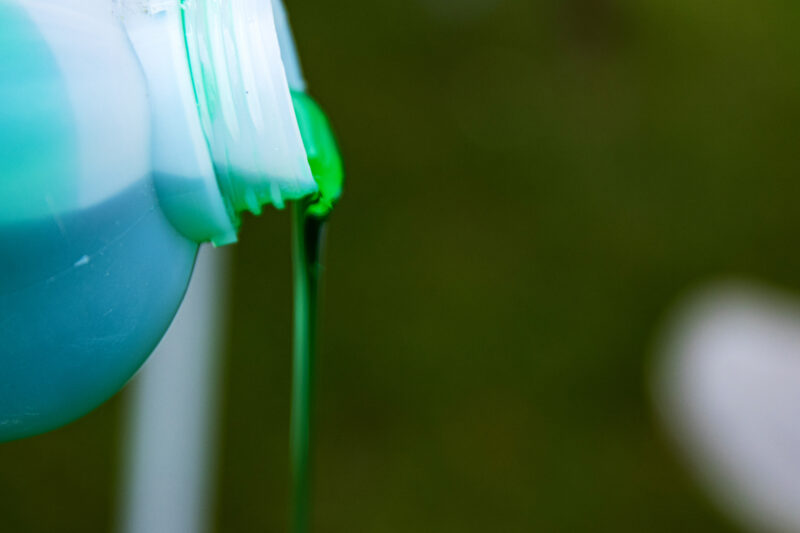
Cons of Synthetic Fertilizers:
- Risk of Nutrient Burn: Synthetic fertilizers are highly concentrated, and overuse can lead to nutrient burn that causes damaging roots and stunting growth. This is a common issue with synthetic feeding, particularly for beginner growers.
- Soil Degradation: Over time, synthetic fertilizers can degrade soil structure, as they do not contribute to soil organic matter. This can lead to soil compaction and reduced microbial activity, ultimately impacting plant health.
- Environmental Concerns: Synthetic fertilizers can contribute to environmental pollution through runoff, impacting nearby water sources and disrupting local ecosystems. Additionally, the production of synthetic fertilizers relies on nonrenewable resources, making them less environmentally sustainable.
Pruning and Training Techniques
Novice and experienced growers can benefit from understanding these methods, as they allow you to shape your plants, increase light exposure, and enhance airflow—all of which lead to healthier, more productive plants.
Why Pruning and Training Are Important
Cannabis like many plants has a natural growth pattern that typically produces one central main stem with a dominant cola (the main bud site at the top of the plant). This main stem gets most of the light, often shading lower branches and bud sites, resulting in an uneven distribution of resources. Pruning and training help you manipulate your plants to:
- Enhance light exposure: By adjusting the shape of your plant, you allow light to penetrate deeper, reaching more bud sites.
- Improve airflow: Pruning helps increase airflow within the canopy, reducing the risk of mold and pests.
- Encourage more bud sites: Topping and training stimulate side growth, allowing more branches to develop, which translates to more buds.
- Increase yield and potency: A more even canopy and better resource distribution allow the plant to focus energy on multiple large buds rather than just one main cola.
Topping
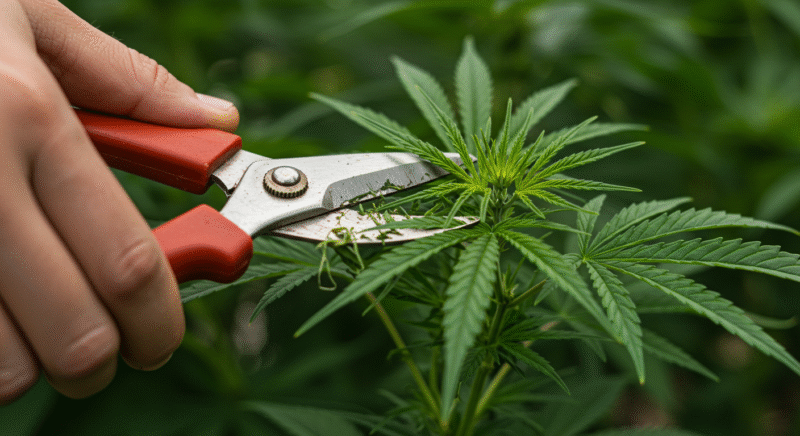
Topping is one of the most common techniques used by cannabis growers to encourage bushier, fuller plants with multiple main colas. The method involves cutting off the top of the main stem, redirecting growth hormones to side branches and encouraging them to grow more vigorously.
How to Top a Cannabis Plant
- When to Start: Topping should be done early in the vegetative stage, ideally when the plant has developed at least 4-6 nodes (sets of leaves on the main stem). Waiting until this point ensures the plant is strong enough to handle the stress.
- Finding the Right Spot: Locate the highest node on the main stem. The ideal point to cut is right above the fourth or fifth node, leaving the lower branches intact.
- Making the Cut: Use sterilized scissors or pruning shears to make a clean cut just above a node. This cut stops the upward growth of the main stem and diverts energy to the side branches.
What Happens After Topping?
After topping, two new growth tips will develop just below the cut, leading to two new main colas rather than one. This encourages the plant to grow outward rather than upward, creating a more even canopy that allows for better light distribution across the plant. Topping can be repeated multiple times throughout the vegetative stage, each time doubling the number of main colas.

Benefits and Drawbacks of Topping
Benefits: Increases the number of main colas, improves light distribution, and creates a bushier structure. Topping is especially effective for plants with strong apical dominance (tendency to grow a central main cola).
Drawbacks: Topping is a high-stress technique and can slow growth temporarily. It’s not recommended late in the vegetative stage or during flowering, as it can reduce final yields if done too close to harvest.
FIMing (F**uck I Missed)
FIMing is similar to topping but involves removing a smaller portion of the top growth, often resulting in four main colas instead of two. The term “FIM” stands for “F**uck I Missed,” referring to a grower’s accidental cut that led to multiple colas—a happy accident that has since become a popular technique.
How to FIM a Cannabis Plant
- When to Start: Like topping, FIMing is best done early in the vegetative stage after the plant has developed 4-6 nodes.
- Making the Cut: Instead of cutting cleanly above a node, FIMing involves cutting about 75% of the new growth at the top of the plant. This often creates a jagged cut rather than a straight one.
- Post-FIM Growth: After FIMing, you may see four or more new shoots develop from the cut site.
Benefits and Drawbacks of FIMing
Benefits: FIMing creates multiple colas without as severe an impact on upward growth, allowing plants to keep a somewhat taller profile than topping.
Drawbacks: The cut is less precise than topping, and results can be inconsistent. Some plants may produce two, three, or four new colas, and the cut can sometimes cause slight asymmetry.
Low-Stress Training (LST)
Low-stress training (LST) involves bending and tying down branches to create a more horizontal growth pattern. Unlike topping and FIMing, LST does not involve cutting the plant, making it a gentle technique that minimizes stress and allows for continual growth without interruption.
How to Perform Low-Stress Training
- Start Early: Begin LST when the plant is still young and flexible, around 3-4 weeks into the vegetative stage.
- Bend the Main Stem: Gently bend the main stem or any tall branches downward aiming to create a flat, even canopy. Secure each bent branch with soft plant ties, tape, or garden wire.
- Continue Training: As the plant grows, continue bending and securing new growth. The goal is to keep the plant’s structure flat, allowing light to reach all parts of the plant evenly.
- Maintaining the Canopy: Periodically adjust the ties and monitor growth to maintain an even canopy.
Benefits and Drawbacks of LST
Benefits: LST increases light exposure without stressing the plant or stalling growth. It’s ideal for growing in limited vertical spaces and can be easily combined with topping or FIMing for even greater yield potential.
Drawbacks: LST requires more frequent maintenance, as you’ll need to adjust the ties regularly as new growth appears.
Supercropping
Supercropping is a high-stress training technique that involves bending branches in a way that partially damages the inner tissue but keeps the outer layer intact. This controlled damage encourages the plant to repair itself, strengthening the branch and enhancing its ability to support heavy buds.
How to Supercrop a Cannabis Plant
- Choosing the Branches: Supercropping can be done on branches that have become long or dominant, particularly in taller plants.
- Gently Crush the Stem: Locate the spot on the branch where you want to bend it. Use your thumb and forefinger to gently squeeze and roll the stem until it softens.
- Bend Carefully: Once the stem has softened, carefully bend the branch at a 90-degree angle. The outer skin should remain intact, even though the inside of the branch feels bruised.
- Support the Bent Branch: If the branch seems unstable, consider supporting it with soft ties or garden stakes until it strengthens.
What to Expect After Supercropping
After supercropping, the bent area will develop a knuckle-like bump as the plant repairs itself. This strengthened area will make the branch more resilient and capable of supporting larger buds, increasing your overall yield potential.
Benefits and Drawbacks of Supercropping
Benefits: Supercropping strengthens branches and increases light exposure to lower bud sites. It can also increase trichome production, which may enhance potency.
Drawbacks: This technique requires caution; bending too forcefully can cause breaks. Supercropping can be stressful for the plant, so it’s best done early in the vegetative stage.
Combining Techniques for Maximum Yield
Many growers combine these techniques for optimal results. For example:
- Topping or FIMing early in the vegetative stage creates multiple main colas.
- LST can then be used to spread these colas outward, maximizing light exposure.
- Supercropping can further strengthen main branches, allowing for a denser, higher-yielding canopy.
Each plant is different, so consider experimenting with these combinations to determine which techniques work best for your specific strain and environment.
When to Avoid Pruning and Training
While these techniques are beneficial, there are certain times in the plant’s life cycle when they should be avoided:
- Late Vegetative Stage: For high-stress methods like topping and supercropping, avoid applying them in the late vegetative stage to prevent delaying the flowering process.
- Flowering Stage: Avoid topping, FIMing, and supercropping during flowering. The plant’s energy should be focused on bud development rather than recovery from stress.
- Weak or Stressed Plants: Avoid high-stress techniques on plants showing signs of poor health, pest infestations, or nutrient deficiencies.
Tips for Success with Pruning and Training
- Use Clean Tools: Always use sterilized tools to prevent infections. Even slight contamination can introduce pathogens.
- Know Your Strain: Some strains respond better to training than others. Sativas often respond well to LST, while Indicas handle supercropping effectively.
- Patience and Observation: Training requires patience and regular monitoring. Watch how your plants respond to each technique, and adjust your approach as needed.
The Flowering Stage
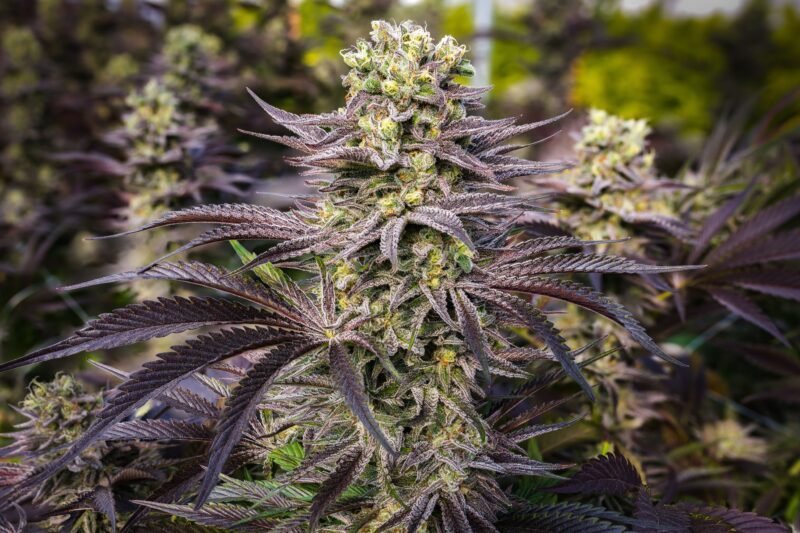
Understanding the signs of this stage is crucial for producing healthy, resinous flowers with optimal potency and yield. Outdoor flowering is influenced by natural cues, primarily the change in sunlight hours, which signals to the plant that it’s time to reproduce. This stage varies based on strain, climate, and geographical location, so tailoring care to your unique environment will enhance your chances of a bountiful harvest.
Recognizing the Start of the Flowering Stage
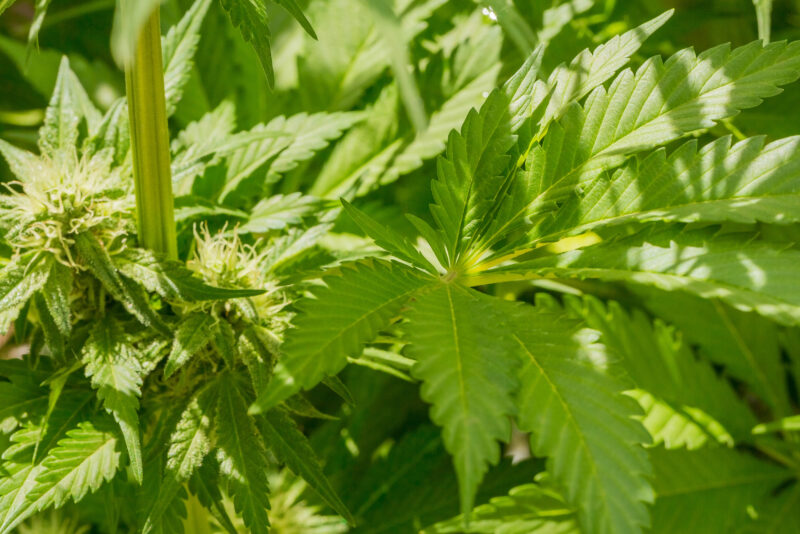
The flowering phase typically begins when the plant experiences a reduction in daylight hours as summer transitions to fall. Outdoor growers should pay close attention to the seasonal sunlight patterns, as well as any visible signs on the plant itself:
- Pre-Flowers and Pistils: The first signs of flowering appear at the plant’s nodes, where pre-flowers form. Female plants display white, hair-like pistils that emerge from small, pear-shaped calyxes, while male plants develop small pollen sacs. For those aiming to produce sinsemilla (seedless) buds, it’s essential to identify and remove any male plants from the grow site at this stage.
- Growth Pattern Change: The plant’s growth pattern changes significantly. It stretches upwards and outwards as it prepares to support budding sites. This ‘flowering stretch’ can increase the plant’s height by up to double its vegetative size, depending on the strain and conditions.
Phases of Flower Development
Cannabis, as a photoperiod-sensitive plant, relies on changes in daylight duration to enter the flowering stage. In nature, this shift usually aligns with the end of summer, when days start to shorten and nights grow longer. For growers in the Northern Hemisphere, this typically means plants start to flower around mid-to-late August, while in the Southern Hemisphere, flowering usually begins in late February to early March.
Cannabis goes through two primary stages: vegetative growth and flowering. During the vegetative stage when days are longer, the plant focuses on developing foliage and structure. However, as the days shorten, cannabis senses these changes through its internal photoreceptors, which help trigger the flowering stage. Let’s break down the timeline and processes involved in outdoor flowering:
Early Flowering (Weeks 1–3)
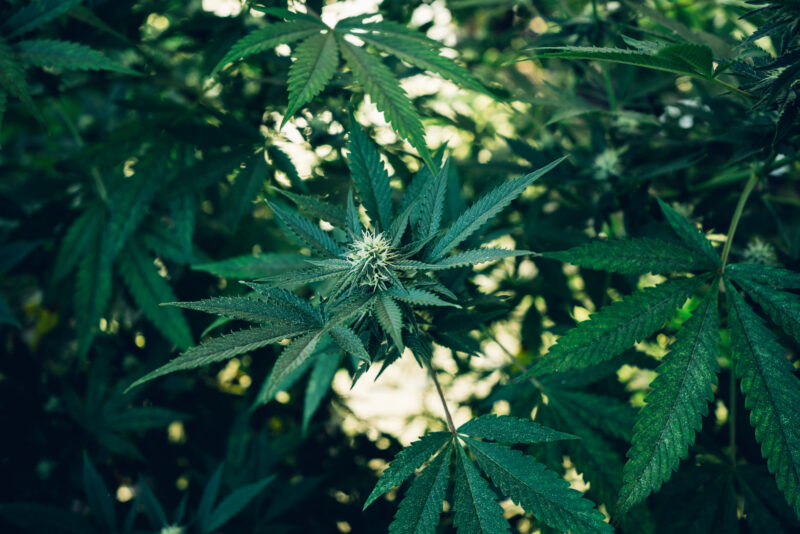
During early flowering, the plant focuses on developing bud sites while still undergoing some stretching. Pistils become more visible, and the plant starts forming tiny, dense clusters at each bud site.
- Stretching: Cannabis plants can experience rapid growth in the first few weeks, seeking additional space and light as they prepare for flower production.
- Formation of Bud Sites: This phase is marked by the development of small white pistils that will eventually become buds. You’ll notice these growing at the tops of branches and main colas, with additional pistils forming along each branch.
Mid-Flowering (Weeks 4–6)
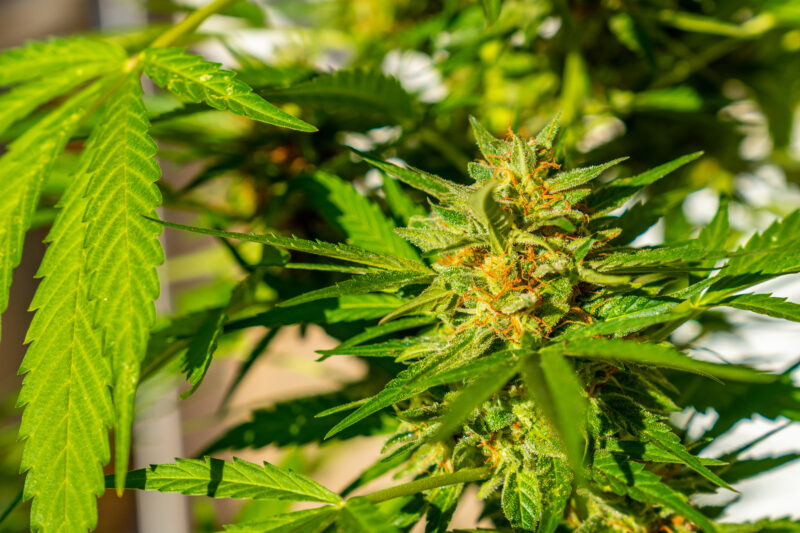
The mid-flowering stage is when the plant begins shifting its energy entirely toward bud production, and the stretching slows. Buds start gaining weight and density as resin glands, known as trichomes, develop to protect the flowers and store cannabinoids and terpenes.
- Pistil and Trichome Production: This is when the pistils become more pronounced, forming dense clusters. Trichomes appear as small, glistening crystals that cover the buds and surrounding leaves.
- Aroma Development: As resin production increases, the plant’s scent becomes more distinct. This aroma is a combination of terpenes, which contribute to each strain’s unique scent and potential effects.
- Color Changes: Pistils remain white at this stage, but you may notice some coloration on the leaves, especially with strains that express vibrant pigments like purples and reds.
Late Flowering (Weeks 7–9 and beyond)
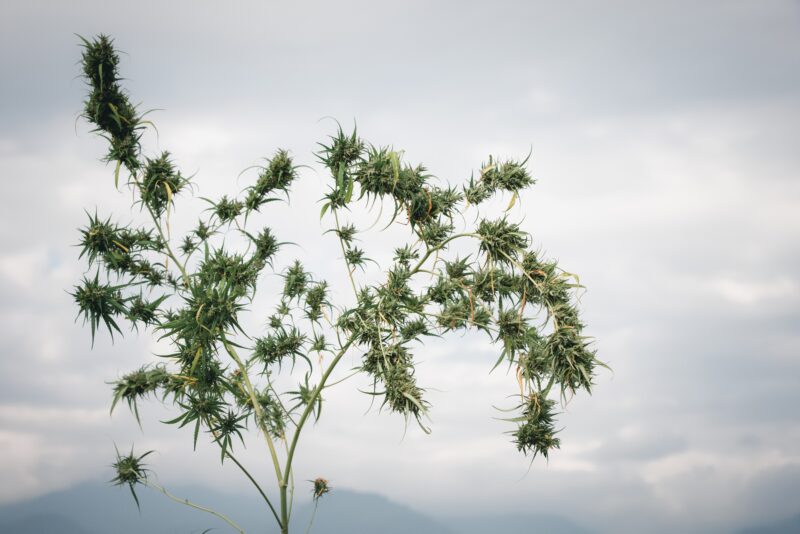
In the final phase, the plant focuses on maturing and ripening the buds, as well as maximizing resin production. The pistils start changing color, typically turning from white to a deeper orange or brown, signaling the plant’s nearing readiness for harvest.
- Pistil Color Change: By late flowering, you’ll notice that the pistils darken, often curling inwards. This shift indicates that the buds are maturing.
- Increased Resin Production: Trichomes become more visible and develop a milky or cloudy appearance. These trichomes contain the cannabinoids including THC and CBD that contribute to the plant’s effects.
- End of Stretching: Growth focuses purely on the buds, as the plant stops vertical stretching and dedicates its energy to fattening and ripening the flowers.
Factors Influencing the Flowering Process Outdoors
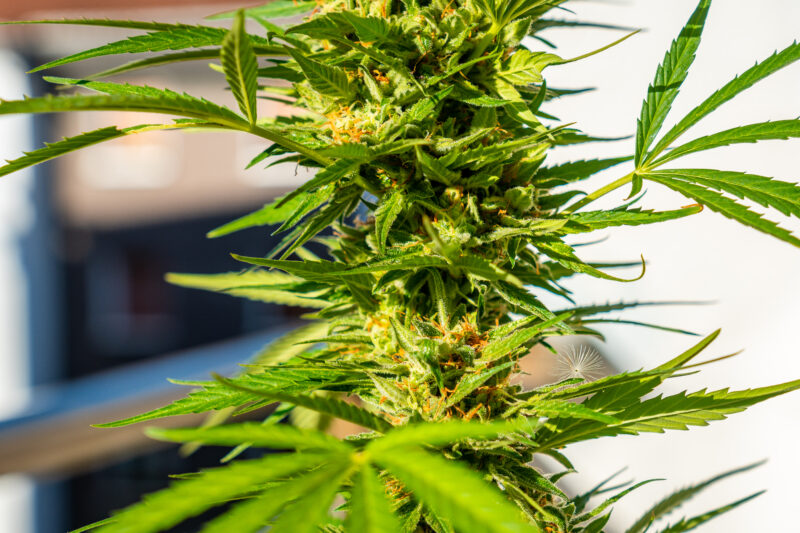
Several environmental factors can impact the flowering process of cannabis outdoors. While photoperiod remains the primary influence, other elements play a supporting role:
- Latitude and Geographic Location
- The closer the growing location is to the equator, the less variation there is in photoperiod across seasons. This can influence the timing and intensity of flowering.
- For growers in northern latitudes, the longer daylight hours in summer lead to a pronounced flowering trigger as days shorten. However, in equatorial regions, where day length remains nearly the same, cannabis may require slight artificial intervention or be grown in shorter daylight cycles to ensure flowering.
- Climate and Weather Patterns
- Temperature shifts can support or hinder flowering, as cannabis thrives in moderate warmth during this stage.
- Cool nights, particularly in early autumn, can help the plant focus on bud development, while sudden frost or extreme temperatures can disrupt flowering altogether.
- Genetics and Photoperiod-Sensitive Strains
- Photoperiod-sensitive strains are naturally inclined to flower based on changes in light duration. However, some strains have been developed to resist early flowering in regions with unpredictable day lengths. Choosing strains suitable for the local climate and daylight cycle is essential for outdoor growers to ensure a smooth flowering period.
Feeding Cannabis During the Flowering Stage in Outdoor Growing
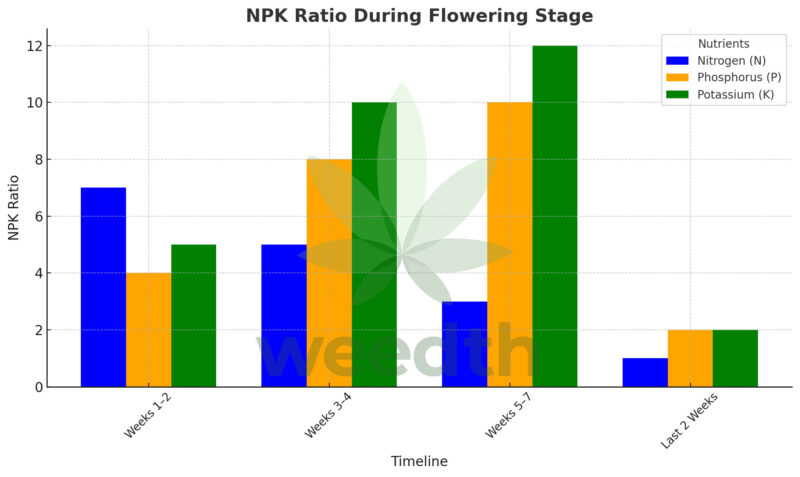
The flowering stage is the culmination of all the hard work that goes into cultivating cannabis. During this phase, plants shift their energy from growing leaves and stems to developing dense, resin-rich buds. Proper nutrition is crucial, as it directly impacts bud formation, potency, and yield. As the plant enters flowering, nutrient requirements change significantly; while nitrogen was the focus in the vegetative stage, flowering plants demand higher levels of phosphorus (P) and potassium (K), with reduced levels of nitrogen (N).
Nutrient Transition from Vegetative to Flowering Stage
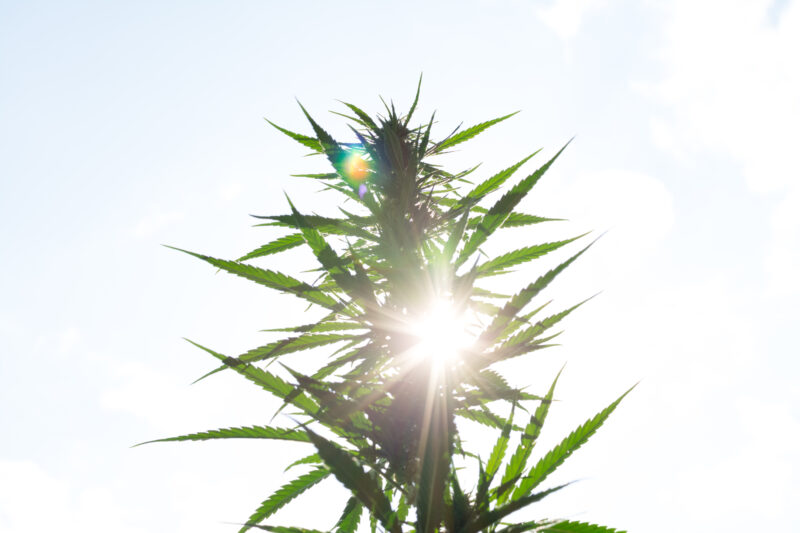
As cannabis shifts from vegetative growth to flowering, its nutrient needs undergo a significant transformation. During the flowering stage, the plant diverts energy from leaf production to flower development. This shift requires a change in nutrient composition to support bud formation, resin production, and structural integrity.
Phosphorus (P): Essential for flower production, phosphorus plays a key role in energy transfer and genetic material synthesis. It supports bud development, increasing the size, density, and potency of the flowers. Phosphorus helps cannabis plants create energy-rich compounds like ATP (adenosine triphosphate), which fuel metabolic processes crucial to flower formation.
Potassium (K): Potassium strengthens plant cell walls, helping plants withstand environmental stresses and supporting overall plant health. In flowering, potassium also contributes to the plant’s water and nutrient regulation abilities, ensuring that flowers develop evenly and achieve their maximum density.
Nitrogen (N): While nitrogen was the star of the vegetative stage, its role diminishes significantly in flowering. Excessive nitrogen during flowering can lead to lush foliage at the expense of flower production. Late-stage nitrogen can also affect the taste and smoothness of the buds. It’s recommended to reduce nitrogen as flowering progresses, eventually phasing it out entirely toward the end of the cycle.
Timing the Nutrient Shift
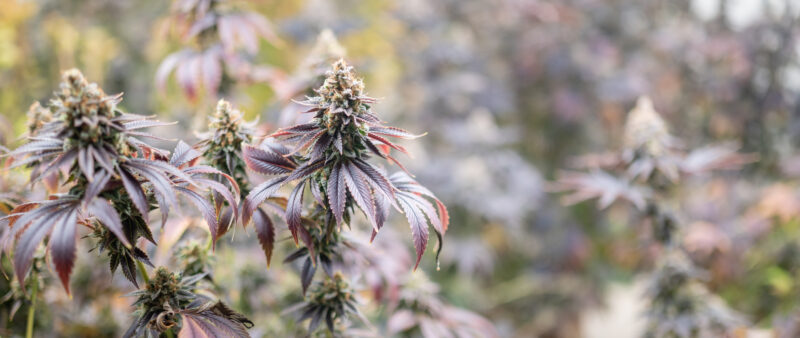
The transition from vegetative to flowering typically takes place as outdoor plants respond to natural changes in daylight hours, often in late summer or early fall. As this change occurs, it’s essential to start adjusting the nutrient balance by gradually increasing phosphorus and potassium while reducing nitrogen. For outdoor growers, this transition should be smooth and gradual to allow the plant time to adjust to the new nutrient composition.
In early flowering, a nutrient ratio with slightly higher phosphorus and potassium than was used in the vegetative stage can be applied—such as 2-3-4 or 3-4-5. As flowering progresses, further increase the phosphorus and potassium to ratios like 1-4-5 or 0-5-7 while minimizing nitrogen.
Importance of Phosphorus and Potassium in Flowering
Phosphorus and potassium are the key macronutrients during flowering, each serving specific roles that contribute to the quality and density of the buds.
Phosphorus: Powering Bud Growth and Resin Production
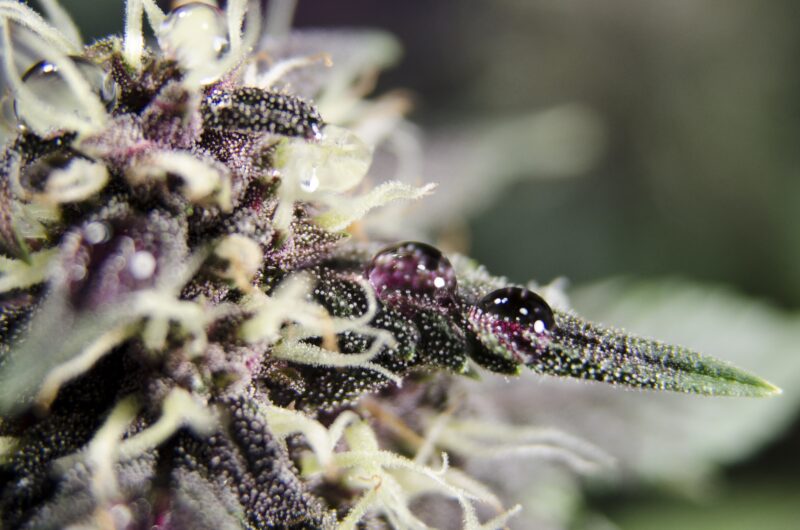
Phosphorus is indispensable during flowering due to its involvement in energy production, cell division, and genetic material synthesis. In the flowering stage, cannabis uses phosphorus to build sturdy flower sites, which then expand and develop resin glands.
- Bud Formation and Density: Phosphorus promotes cell division, a critical process as buds grow larger and denser. Plants with sufficient phosphorus typically produce thicker, heavier flowers, leading to better yields.
- Resin and Cannabinoid Production: High levels of phosphorus encourage resin production, contributing to THC, CBD, and terpene synthesis. This enhances the potency and aroma of the buds, which is essential for both recreational and medicinal quality.
- Stability in Outdoor Conditions: Phosphorus aids in root development and overall plant health, allowing outdoor plants to stabilize against wind, rain, and other environmental factors. This stability is crucial for plants that may face shifting weather patterns.
Potassium: Strengthening and Enhancing Flavor
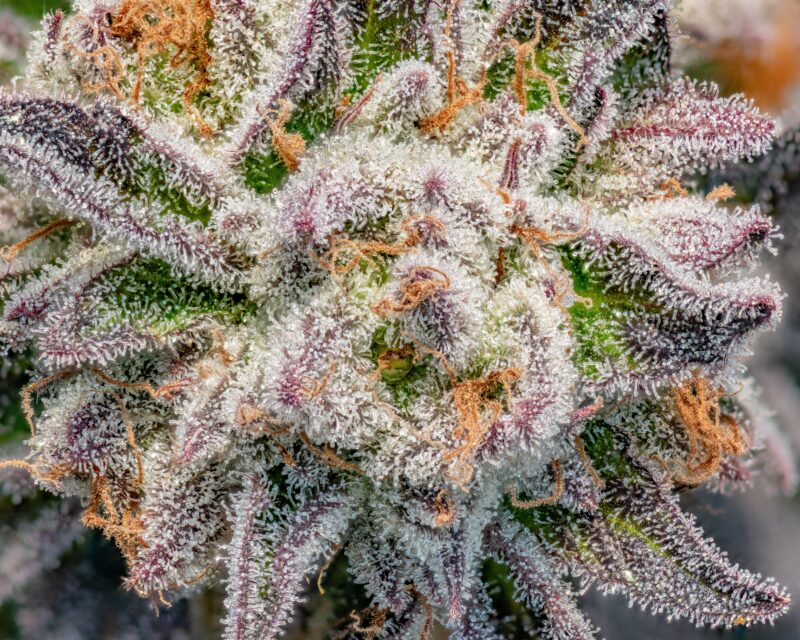
Potassium supports the physical and chemical processes necessary for cannabis plants to maximize bud development. It is essential for cellular strength, water regulation, and disease resistance, all of which contribute to the overall health and quality of flowering cannabis.
- Cell Wall Strength: Potassium strengthens cell walls, making the plant more resilient to physical stress and allowing buds to become dense without collapsing. This structural integrity is particularly valuable for outdoor plants that may be exposed to wind or rainfall.
- Water and Nutrient Regulation: Potassium plays a role in osmoregulation, which helps plants control water intake and release. Proper water management is critical in flowering, as cannabis plants need a balanced environment to prevent bud rot and mold, which can be common in outdoor grows, especially in humid climates.
- Enhanced Flavor and Aroma: Potassium can improve the flavor profile of the final product by enhancing terpene production. Terpenes are responsible for the smell and taste of cannabis, so adequate potassium during flowering is essential for achieving high-quality, aromatic buds.
Avoiding Nitrogen Late in the Flowering Stage
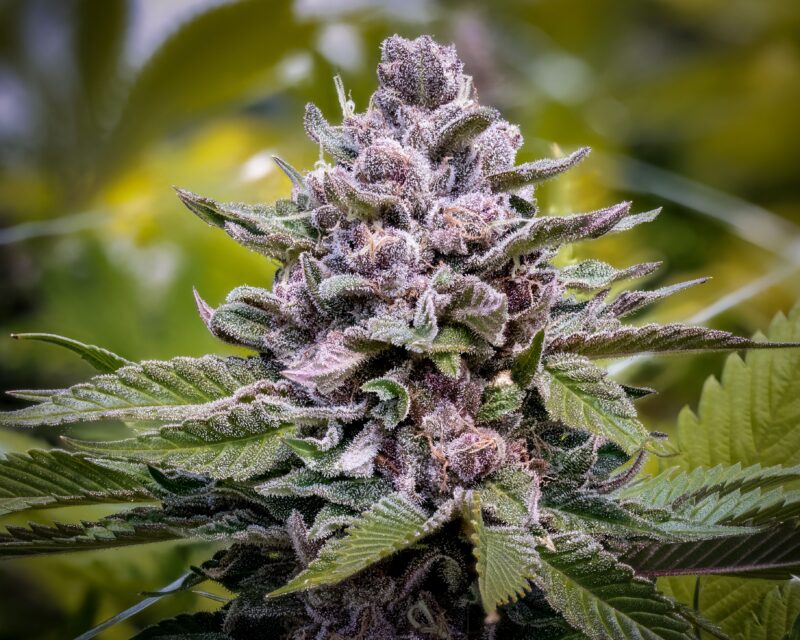
As flowering progresses, nitrogen should be gradually reduced and eventually eliminated. High nitrogen levels can interfere with bud development, resulting in poor-quality buds with a harsh taste. Here’s why it’s essential to avoid nitrogen in the later stages of flowering:
Focus on Flower Production, Not Foliage: Nitrogen promotes leaf and stem growth, which is useful in the vegetative stage but undesirable in flowering. Excess nitrogen can cause “re-vegetation” effects, where the plant starts producing more leaves and smaller flowers, diverting energy away from bud production.
Improved Flavor and Smoothness: High nitrogen levels late in flowering can negatively impact the taste of the buds, creating a harsh smoke that detracts from the natural flavor. By reducing nitrogen, you allow the plant to focus on producing cannabinoids and terpenes, which enhance the final product’s smoothness and taste.
Preventing Nutrient Lockout and Toxicity: Excess nitrogen can lead to nutrient lockout, a condition where plants cannot absorb essential nutrients due to a chemical imbalance in the soil. This can result in nutrient deficiencies that affect bud development and quality. Reducing nitrogen late in flowering prevents nutrient buildup and allows the plant to focus on absorbing phosphorus and potassium.
Timing the Nitrogen Reduction
The process of phasing out nitrogen should begin in mid to late flowering, depending on the strain’s flowering time. For example, if a strain takes about 8 to 10 weeks to flower, start reducing nitrogen after the fourth week. By the final two weeks of flowering, nitrogen should be eliminated entirely, allowing the plant to use up any remaining nitrogen reserves in its tissues. This practice, known as flushing, prepares the plant for harvest by ensuring that excess nutrients are removed, improving the flavor and quality of the buds.
Common Flowering Stage Nutrient Ratios
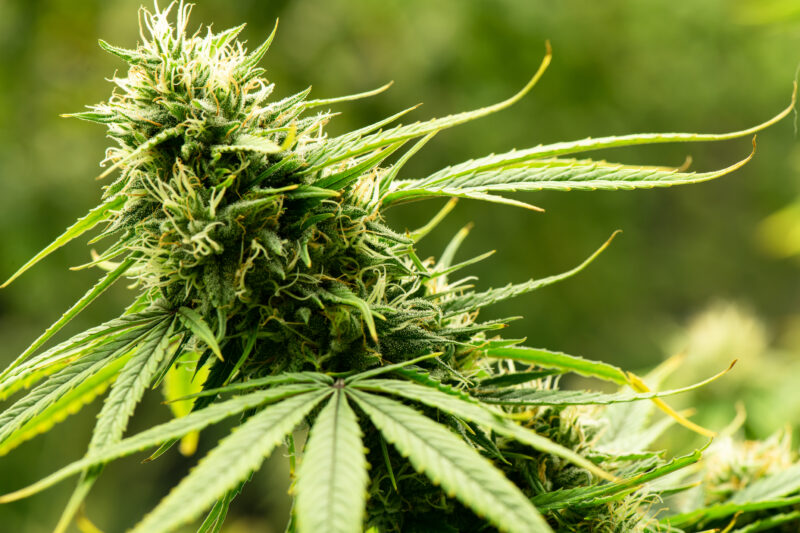
To help growers fine-tune their feeding schedules, here are some suggested nutrient ratios for various stages within flowering:
Early Flowering (Weeks 1-3): This stage is often referred to as the “transition” phase, where plants are adjusting from vegetative growth to flowering. A moderate increase in phosphorus and potassium with slightly reduced nitrogen is ideal. Ratios like 2-3-4 or 3-4-5 help promote early bud site development without overwhelming the plant with nitrogen.
Mid Flowering (Weeks 4-6): During this period, plants are focused on bulking up the flowers. At this point, nitrogen should be minimized, and phosphorus and potassium should dominate the nutrient profile. Ratios like 1-4-5 or 2-5-6 are effective for encouraging dense bud formation and increased resin production.
Late Flowering (Weeks 7-8 and beyond): In the final weeks before harvest, eliminate nitrogen completely and use a phosphorus and potassium-heavy nutrient mix, such as 0-5-7 or 0-6-8. This will help the plant focus exclusively on bud development and resin production, maximizing quality and potency.
By adjusting these ratios throughout flowering, outdoor growers can support healthy bud development without overloading the plant with unnecessary nutrients.
Supporting Heavy Buds in Outdoor Cannabis Cultivation
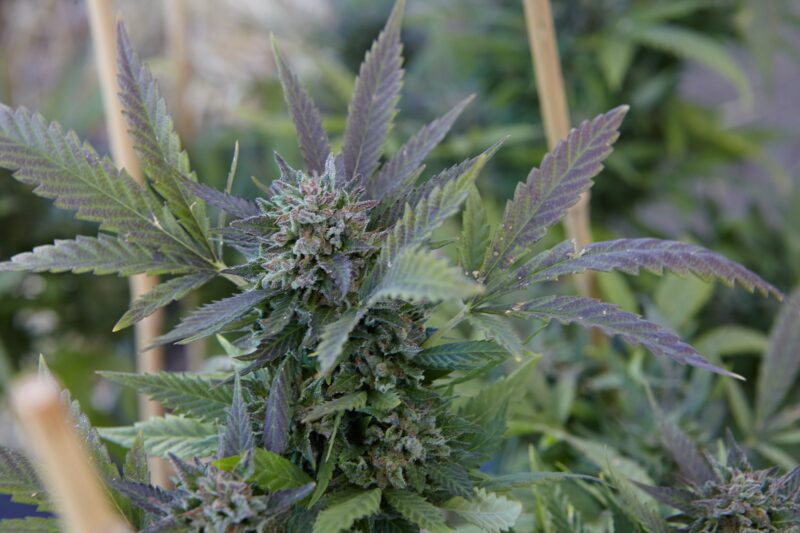
Heavy buds can significantly strain the branches, especially when grown outdoors where plants are exposed to natural elements like wind and rain. Without proper support, branches can snap under the weight, potentially damaging or losing valuable buds. To prevent this, outdoor growers often employ techniques like staking and trellising, which provide essential support and stability throughout the flowering phase.
Why Support Is Essential During Flowering
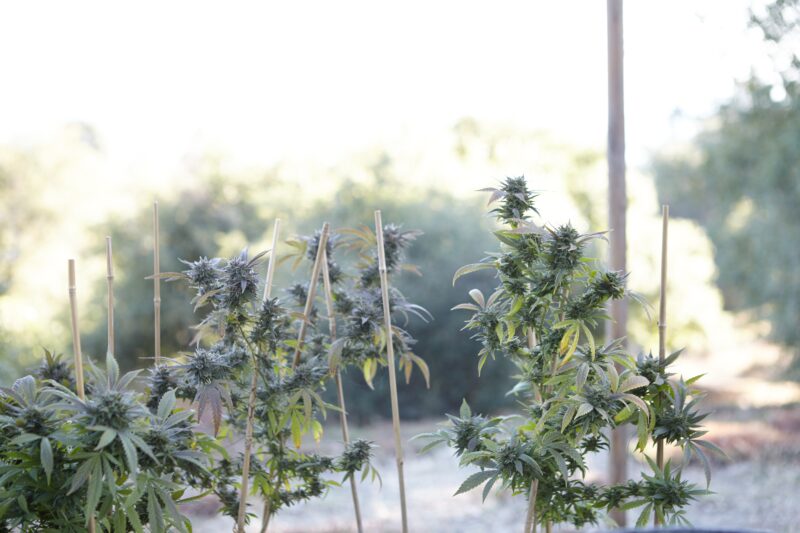
As cannabis plants transition from vegetative growth to flowering, they undergo a period of accelerated bud production, leading to increased weight on each branch. Outdoor plants, which tend to grow taller and larger due to natural light cycles and open space, are particularly susceptible to heavy buds pulling down branches. This can lead to several issues if not managed properly:
- Branch Breakage: Heavy buds can cause branches to bend or break, especially if they’re exposed to strong winds or heavy rain. Broken branches may result in lost buds and leave the plant vulnerable to infections or pests.
- Bud Rot Prevention: Buds resting on the ground or densely packed together can trap moisture, creating a breeding ground for mold and bud rot. By supporting the branches, growers can improve airflow around the buds, reducing the risk of mold.
- Maximizing Light Exposure: Properly supported branches maintain a more open structure, allowing sunlight to penetrate deeper into the plant. This benefits overall bud development and ensures that all parts of the plant receive ample light.
Techniques for Supporting Heavy Buds
Supporting heavy buds is all about reinforcing the plant’s structure to withstand the increased weight and natural elements. The two most common methods for outdoor growers are staking and trellising.
Staking: Individual Branch Support
Staking involves inserting stakes into the ground and tying branches to these stakes to keep them upright and stable. This technique provides targeted support to specific branches, making it ideal for plants with a few large, heavy colas.
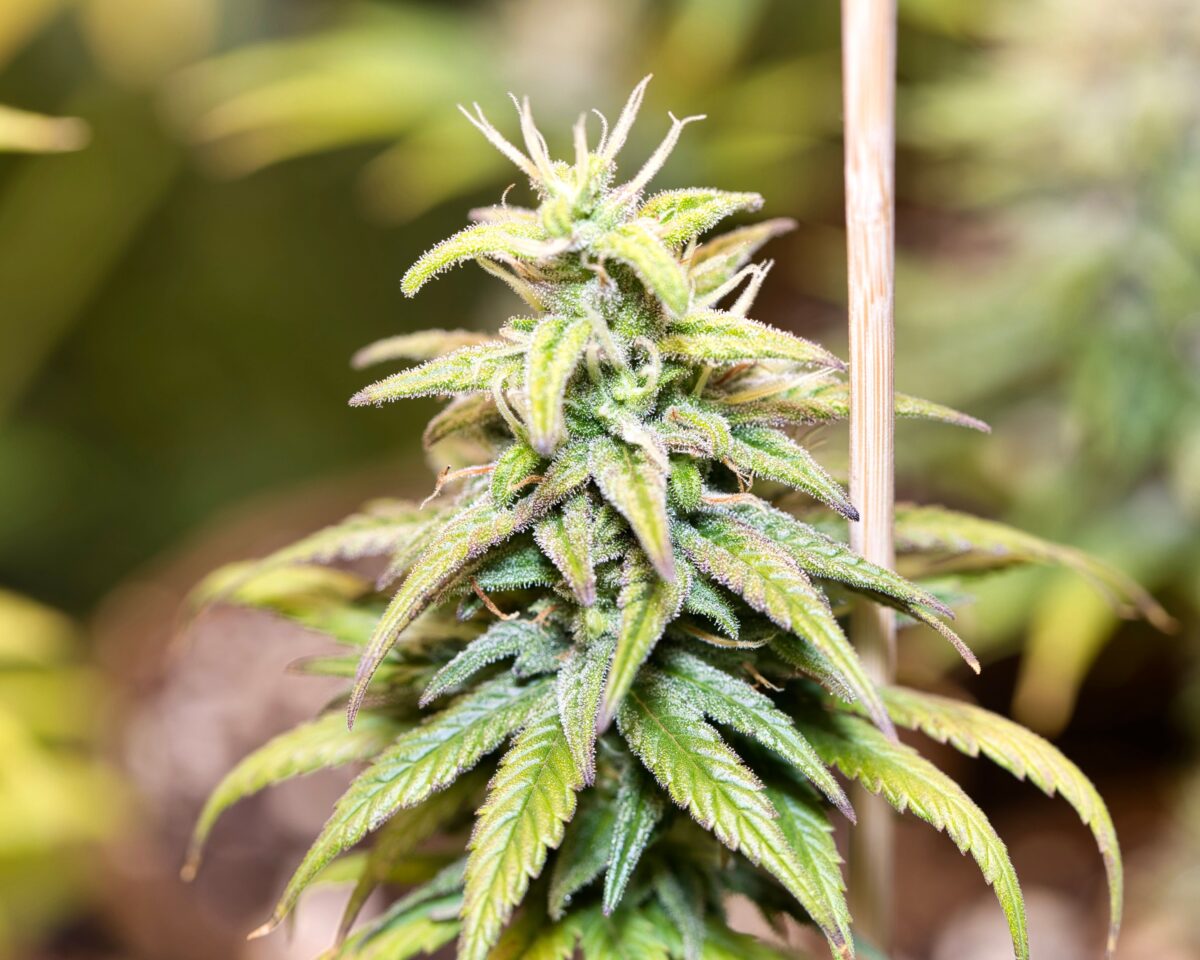
- Materials Needed: Bamboo stakes, metal stakes, or wooden poles are commonly used, as they are sturdy and easy to insert into the ground. Twine or garden tape is used to gently secure branches to the stakes.
- How to Stake:
- Insert a stake into the soil approximately 6–12 inches away from the branch to avoid disturbing the roots.
- Choose a stake height that matches or slightly exceeds the plant’s height to allow for growth.
- Using twine or soft garden tape, loosely tie the branch to the stake, allowing some flexibility. Tying too tightly can restrict growth or damage the branch.
- Place stakes around the plant at different angles for plants with multiple heavy branches, creating a supportive structure.
- Advantages: Staking is straightforward, inexpensive, and effective for plants that don’t require extensive support. It allows individual branches to be supported without obstructing airflow, reducing the chance of mold and bud rot.
- Considerations: While staking is effective for smaller plants or those with a few heavy colas, it may become cumbersome with larger plants that require support for many branches.
Trellising: Comprehensive Plant Support
Trellising is a more extensive support method that involves setting up a frame or net around the entire plant to hold multiple branches in place. This approach distributes the weight of the buds evenly across the entire plant, making it suitable for larger outdoor cannabis plants with many heavy buds.
- Materials Needed: Trellis netting, wire mesh, or other durable, flexible material that can create a supportive frame. Stakes or wooden poles are also required to create the structure.
- How to Trellis:
- Set up a framework around the plant using stakes or wooden poles, positioning them around the plant to create a rectangular or square structure.
- Attach the trellis netting or wire mesh to the framework, ensuring it’s taut and secure.
- As the plant grows, weave branches gently through the trellis netting or place the netting over the top of the plant, allowing the buds to rest on the structure.
- Adjust the netting and position of branches as the buds grow, ensuring that each branch has adequate support and room to expand.
- Advantages: Trellising provides comprehensive support for large plants with multiple heavy branches. By evenly distributing the weight of the buds, trellising prevents branches from snapping and helps maintain an open, airy plant structure.
- Considerations: Trellising requires more setup and is best suited for large outdoor plants that need substantial support. Additionally, once the trellis is in place, adjusting plant positioning can be challenging, so it’s essential to monitor growth regularly to avoid overcrowding.
Harvesting Cannabis
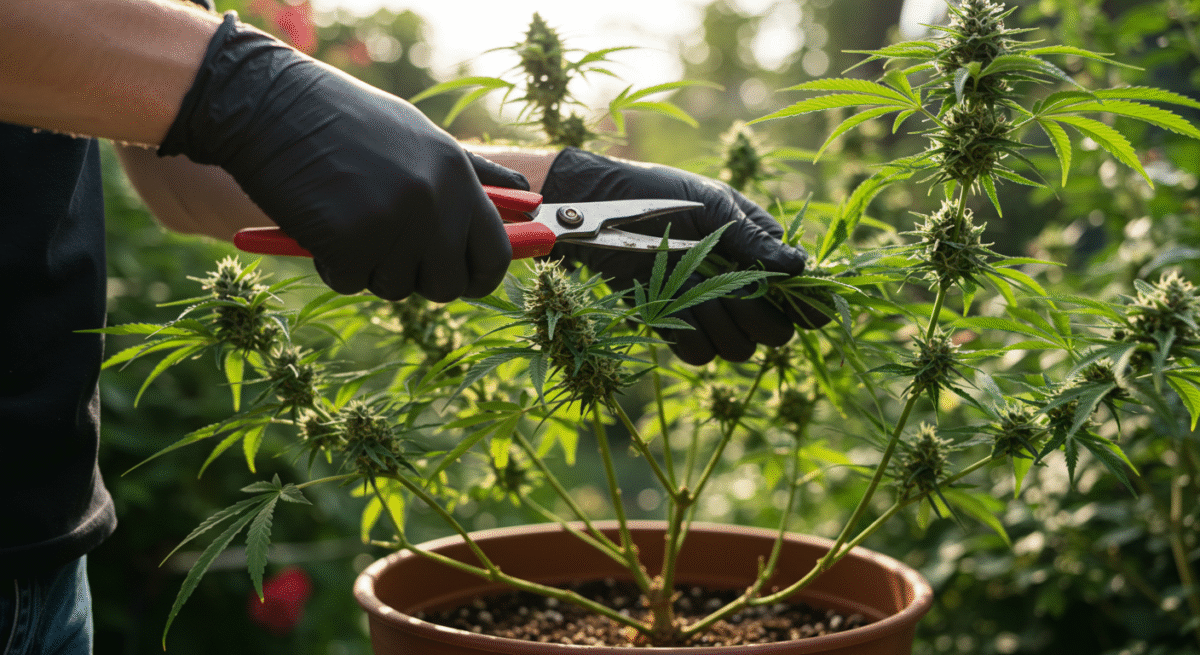
The culmination of months of care and attention, harvesting cannabis is a crucial stage in the cultivation process. Harvesting at the right moment, using the best methods, and handling your plants with care are all essential for maximizing the potency, flavor, and overall quality of your final product. We’ll cover how to recognize the optimal time to harvest by observing trichome color, pistil condition, and the development of cannabinoids and terpenes. We’ll also delve into various harvesting methods, including whole-plant and branch-by-branch techniques, and consider the best time of day for harvesting to preserve terpenes.
When to Harvest
Knowing when to harvest cannabis is an art and a science. Harvesting too early can result in lower potency, while harvesting too late can affect flavor and cannabinoid profiles. For outdoor growers, the timing of harvest is influenced by both the plant’s lifecycle and the surrounding environment, such as temperature changes or the onset of frost.
Trichome Color and Pistil Condition
One of the most reliable ways to determine when a cannabis plant is ready to harvest is by examining the trichomes—the resin glands that produce cannabinoids and terpenes—and the pistils, the hair-like structures that grow from the buds.
Trichome Color: Under a magnifying glass or jeweler’s loupe, trichomes appear as tiny, stalked glands on the buds and leaves. During ripening, trichomes change color, which can indicate the best harvest time:
-
- Clear trichomes: The plant is still developing, and harvesting at this stage will yield lower potency.
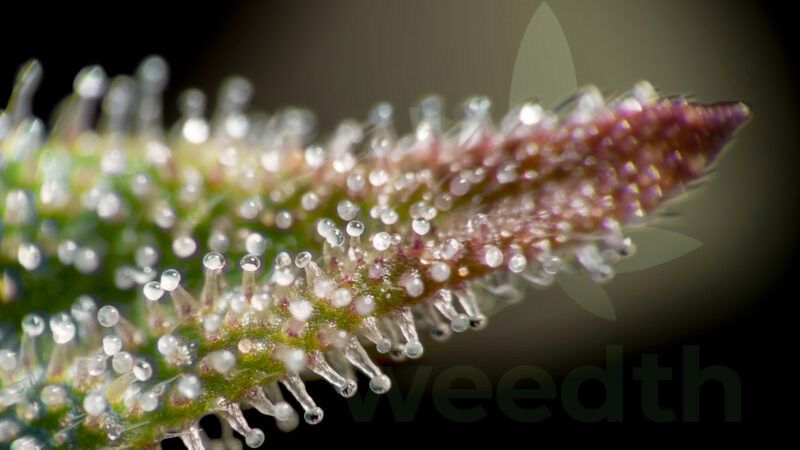
-
- Cloudy or milky trichomes: Peak potency; THC levels are at their highest, producing a strong, cerebral effect.
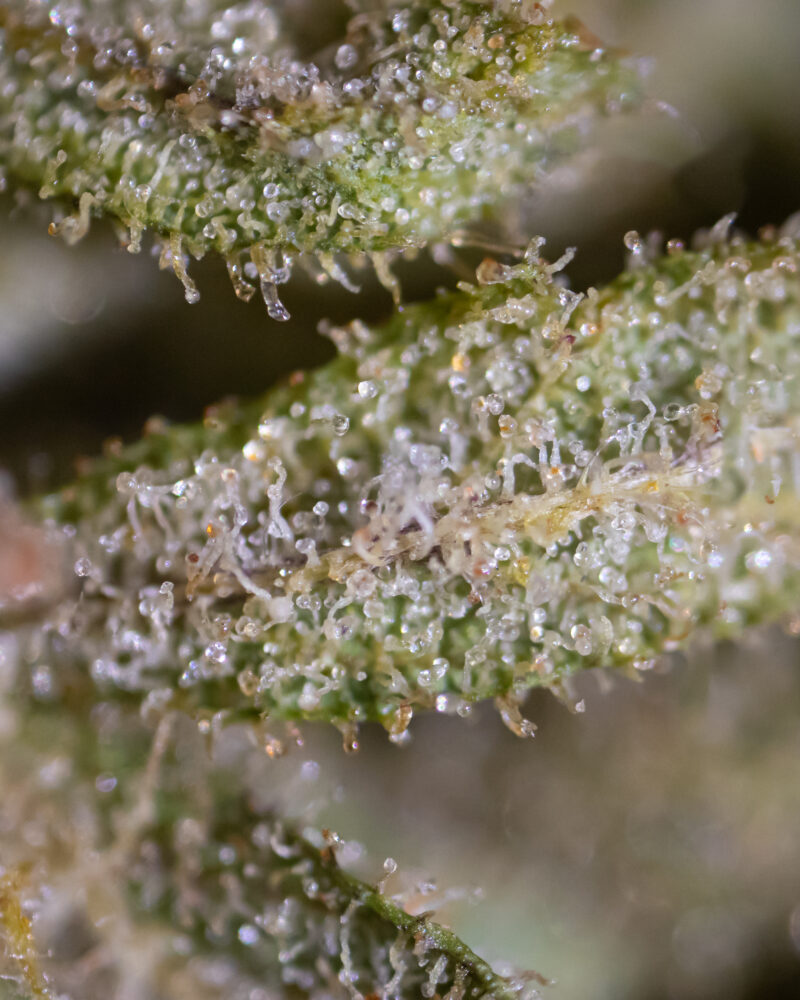
-
- Amber trichomes: Cannabinoids are starting to degrade, resulting in a more relaxed, sedative effect. A small percentage of amber trichomes (10-30%) is ideal for a balanced high, particularly in indica strains.
Pistil Condition: Pistils transition in color and texture as the plant matures:
-
- White pistils indicate that the plant is still developing and not yet ready for harvest.
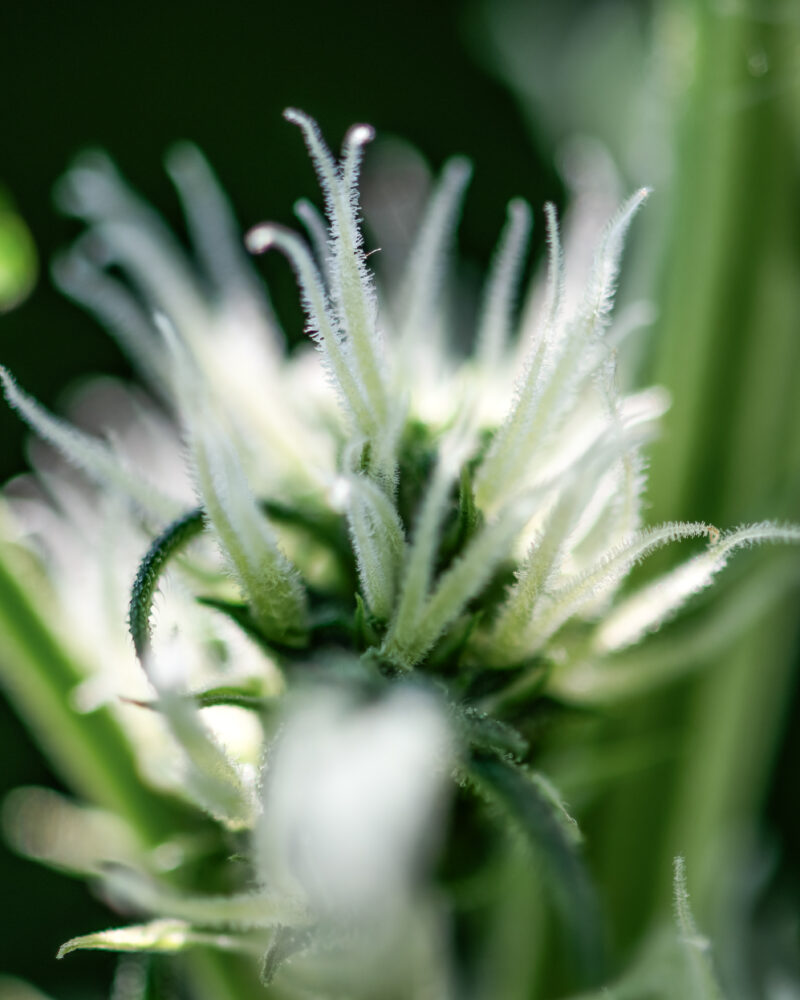
-
- Orange or brown pistils (around 70-90%) show that the plant is reaching full maturity and is nearly ready to be harvested.
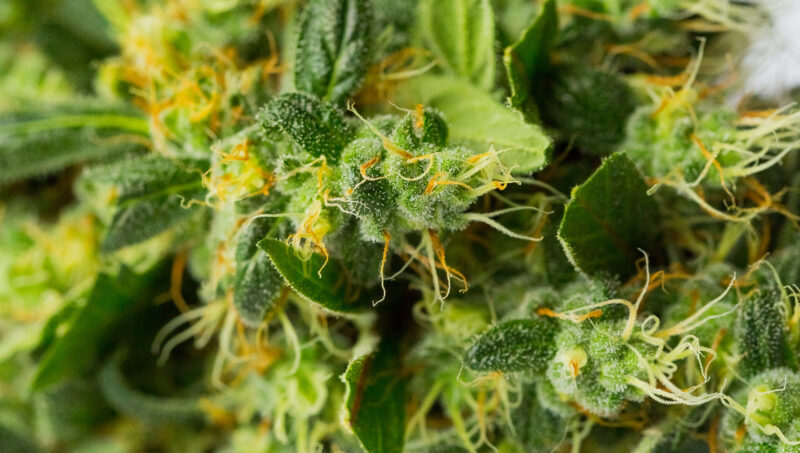
A combination of cloudy trichomes and orange-brown pistils is generally the sweet spot for harvesting cannabis. While trichome inspection is more accurate, observing pistil color can be a useful secondary indicator for those without magnification tools.
Understanding Cannabinoid and Terpene Development During Harvest Time
Timing your harvest carefully allows for optimized cannabinoid and terpene profiles. Cannabinoids like THC and CBD reach their peak potency when trichomes are cloudy, while terpenes—responsible for aroma and flavor—are most abundant right before they start to degrade. Terpenes are volatile compounds and can degrade due to light, heat, and time. Harvesting at peak ripeness preserves these delicate compounds, enhancing the final product's medicinal and recreational qualities.
Harvesting Methods
There are two primary methods for harvesting cannabis: cutting whole plants or harvesting branch-by-branch. The choice depends on plant size, climate, and drying preferences, but each method has unique benefits.
Cutting Whole Plants
The whole-plant harvest method involves cutting the plant at the base and hanging it upside down to dry. This method is particularly beneficial in humid environments or for plants with dense foliage, as it slows down the drying process, enhancing flavor and preventing overdrying.
Advantages: By drying as a whole plant, moisture is distributed more evenly throughout the plant, which reduces the risk of overdrying the buds. Additionally, this method can preserve terpenes as the drying process is more gradual.
Best for: Cooler, humid climates where a slower drying process helps prevent mold while maintaining potency.
Branch-by-Branch Harvest
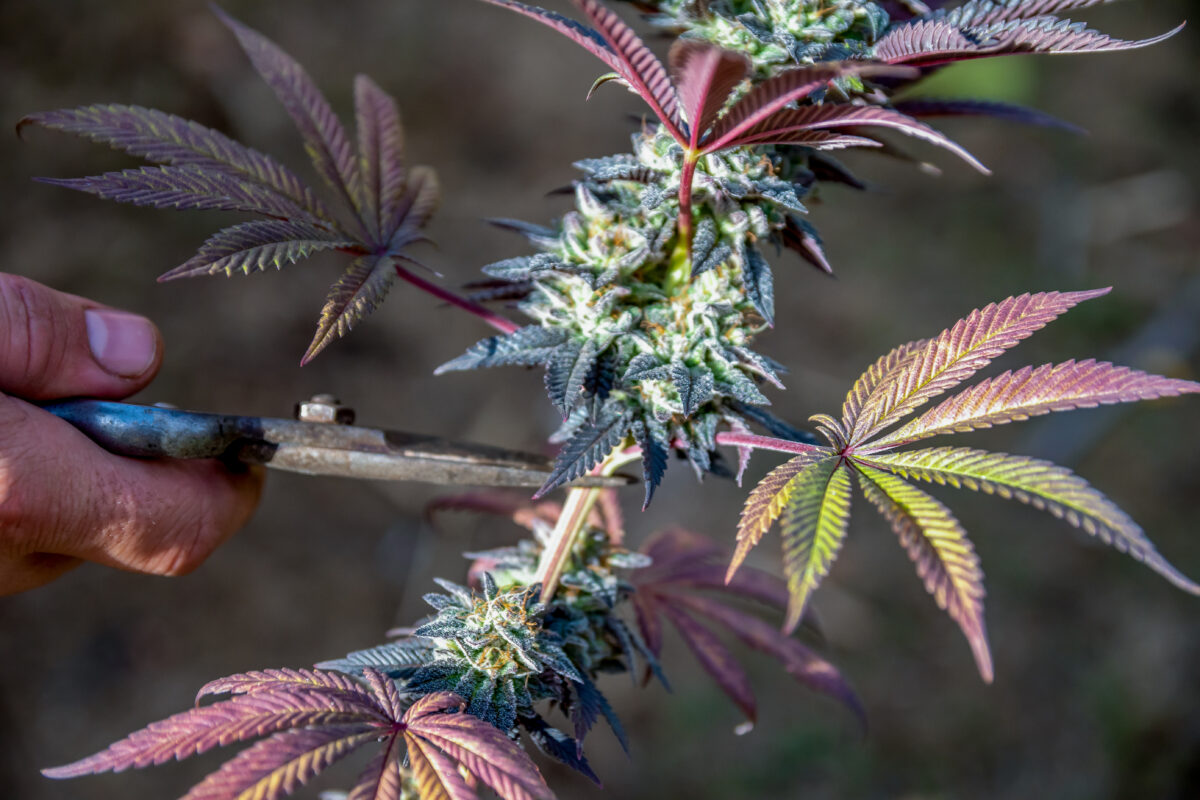
In branch-by-branch harvesting, individual branches or colas are cut and hung separately. This method allows for greater control over drying and can be helpful in warmer or dryer environments where plants are prone to drying too quickly.
- Advantages: Branch-by-branch harvesting allows for easier handling, more even drying, and simpler inspection for mold or pests on each individual branch. This method is also useful if only certain branches are fully ripe while others need more time.
- Best for: Warmer, dryer climates where slower drying can risk overdrying or terpene loss.
Best Time of Day to Harvest: Terpene Preservation
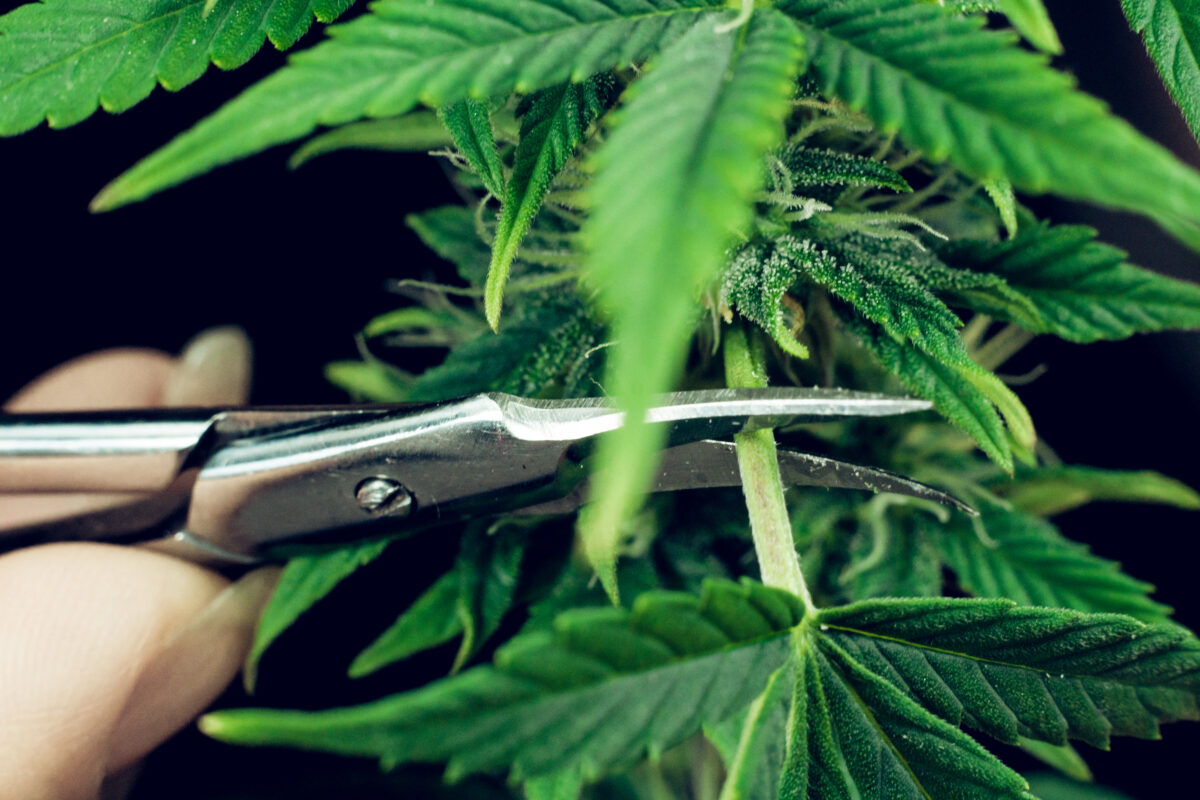
The ideal time of day to harvest cannabis is early morning, just after the dew has dried. At night, plants store sugars and moisture within their root systems, leaving lower concentrations in the foliage. Harvesting in the early morning helps preserve terpenes, as they are less likely to evaporate in cooler temperatures. Midday heat can accelerate terpene degradation, so harvesting early is particularly beneficial for outdoor growers who want to maximize aroma and flavor.
Drying and Curing Cannabis
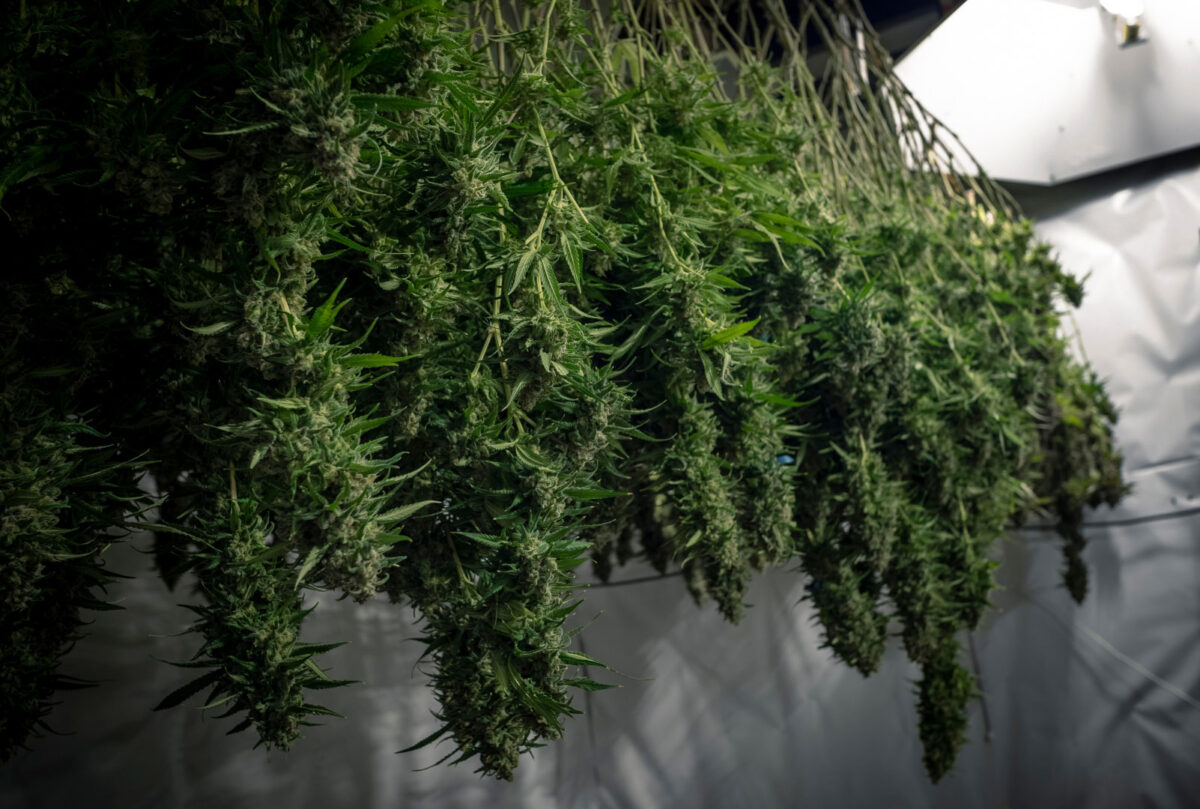
Drying and curing cannabis are just as important as the cultivation process itself. Improper drying can lead to mold or overdrying, while curing is essential for enhancing the flavor, potency, and smoothness of the buds.
Drying Techniques
Drying prepares cannabis for curing by reducing its moisture content, preserving cannabinoids, and stabilizing terpenes. The drying process should be slow and controlled to prevent issues like mold or overdrying, which can negatively impact flavor and potency.
Ideal Temperature and Humidity for Drying Rooms
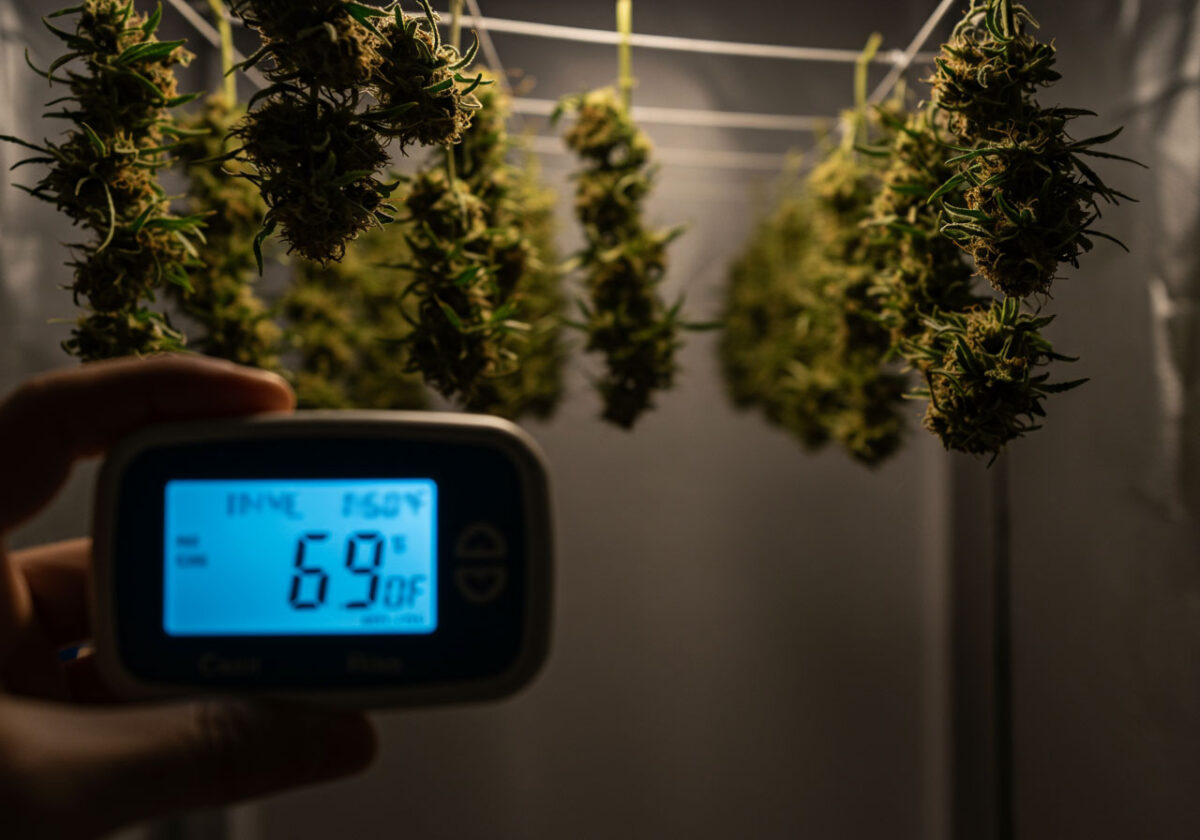
Creating the ideal drying environment is crucial for a successful drying process. The recommended temperature and humidity settings are:
- Temperature: 60-70°F (15-21°C)
- Humidity: 55-65%
These conditions allow for a slow, even drying process. If the temperature is too high, buds can dry too quickly, leading to a loss of flavor and potency. Too much humidity, on the other hand, can encourage mold growth.
Maintaining a gentle airflow in the drying room is also important, as stagnant air can contribute to mold. However, avoid direct airflow on the buds, as this can lead to uneven drying and terpene loss.
Hanging vs. Drying Racks
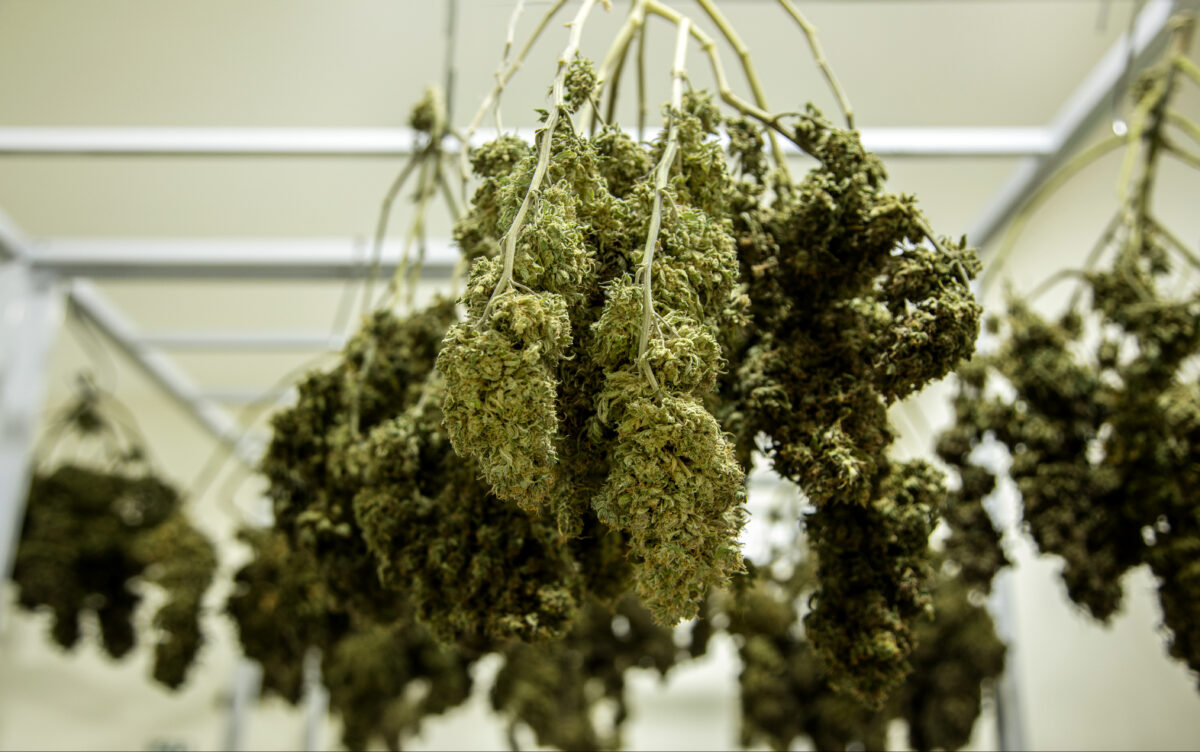
Both hanging and drying racks are effective methods, each with its own set of advantages depending on your space and environmental conditions.
Hanging: Hanging whole plants or individual branches upside down allows for even airflow around each bud. This method is simple and efficient, especially for large harvests.
Drying Racks: Drying racks are ideal for those with limited space. They allow for individual buds to be spaced out evenly, which improves air circulation and reduces the chance of mold. This method works well if the plant material is already broken down, as it maximizes surface area and speeds up the drying process.
Choose the method that best suits your space, volume of harvest, and environmental control capabilities.
The Importance of Curing Cannabis
Curing is the final step in producing high-quality cannabis, enhancing flavor, potency, and smoothness. Proper curing allows cannabinoids and terpenes to stabilize, while chlorophyll and other unwanted compounds break down, creating a smoother and more flavorful smoke.
The Science of Curing: Enhancing Flavor, Potency, and Smoothness
Curing occurs when cannabis is stored in a controlled environment, usually in glass jars, over a period of weeks. This slow process allows moisture within the buds to distribute evenly, preventing overdrying of outer layers and preserving terpenes.
During curing, natural enzymatic processes and microbial activity continue, breaking down residual chlorophyll and sugars that can cause harshness in the smoke. Additionally, terpene profiles mature and stabilize, enhancing both flavor and aroma, while cannabinoids continue to develop, contributing to increased potency.
Curing Methods: Glass Jars, Burping, and Long-Term Storage
Glass Jars: Glass jars are the preferred curing container as they create an airtight seal that prevents contamination and allows for consistent humidity levels. Place the dried buds loosely in the jars, filling them to about 75% capacity to allow for airflow.
Burping: During the first two weeks, open the jars daily for a few minutes to release built-up humidity and allow fresh air to circulate. This “burping” process prevents mold growth and ensures that moisture levels stabilize evenly throughout the buds. After two weeks, burping can be reduced to every few days.
Long-Term Storage: After four to six weeks, most cannabis is fully cured and can be stored long-term. Store jars in a dark, cool location to protect cannabinoids and terpenes from light and heat degradation. Properly cured and stored cannabis can maintain its potency and flavor for six months or longer.
Troubleshooting Drying and Curing Problems
Drying and curing can present challenges, especially for beginners. Here’s how to tackle common issues to ensure a high-quality final product.
Preventing Mold and Overdrying
Mold Prevention: Mold growth is a serious issue typically arising from high humidity or poor airflow. To prevent mold:
- Ensure humidity in the drying room stays between 55-65%.
- Use fans to create gentle airflow in the drying space.
- Burp jars during curing to release excess moisture.
Overdrying: Overdrying can strip buds of flavor, making them brittle and harsh to smoke. To avoid overdrying:
- Monitor temperature and humidity during drying, keeping them at optimal levels.
- Avoid direct airflow on buds as this can cause uneven and accelerated drying.
Flavor Preservation Tips
Temperature Control: Preserve volatile terpenes keep the drying room cool, around 60-70°F (15-21°C). High temperatures can cause terpenes to evaporate, diminishing flavor and aroma.
Gradual Curing: Slow, controlled curing provides a smooth, flavorful final product. The process of burping the jars during curing allows fresh air to reach the buds, stabilizing terpene profiles and enhancing flavor.
Avoid Plastic Containers: Plastic can retain odors and chemicals, affecting flavor. Glass jars are inert and don’t absorb or release chemicals, making them ideal for long-term curing and storage.
Water
Whether you are tapping into a natural water source, collecting rainwater, or setting up irrigation systems, ensuring your plants are adequately hydrated throughout the growing season is one of the key challenges for outdoor growers. Improper watering can lead to stunted growth, poor yields, and even the death of your plants, so getting water access right is crucial to your overall success.
Identifying Reliable Water Sources
The first step in planning your outdoor grow is identifying a reliable source of water. Cannabis plants, especially during their vegetative and flowering stages, are heavy water consumers, and depending on your climate and growing conditions, they may require daily watering. The amount of water needed will depend on your plants’ size, soil type, and local weather conditions.
If you’re growing near your home or a nearby structure, you may be able to tap into an existing water supply, like a garden hose connected to your home’s water system. However, if you are growing in a more remote location, you’ll need to either transport water to your site or rely on a natural water source.
Here are the most common water sources outdoor cannabis growers use:
Natural Water Sources
If you’re lucky enough to have access to a stream, river, lake, or pond, this can be an excellent water source for your plants. Natural water sources are usually reliable, but they may fluctuate with the seasons, especially in dry areas. Be mindful of any environmental regulations regarding water usage, as it may be illegal to divert water in some areas. Additionally, natural water sources can contain impurities or pathogens, so it’s a good idea to test the water quality before use.
Groundwater Wells
In some cases, you may be able to tap into groundwater by digging a well. This is a more permanent solution that provides a consistent water source, but it requires significant upfront investment. Groundwater can also vary in quality, depending on your location. Be prepared to install filtration systems if the water contains minerals, contaminants, or salts that could harm your plants.
Rainwater Collection
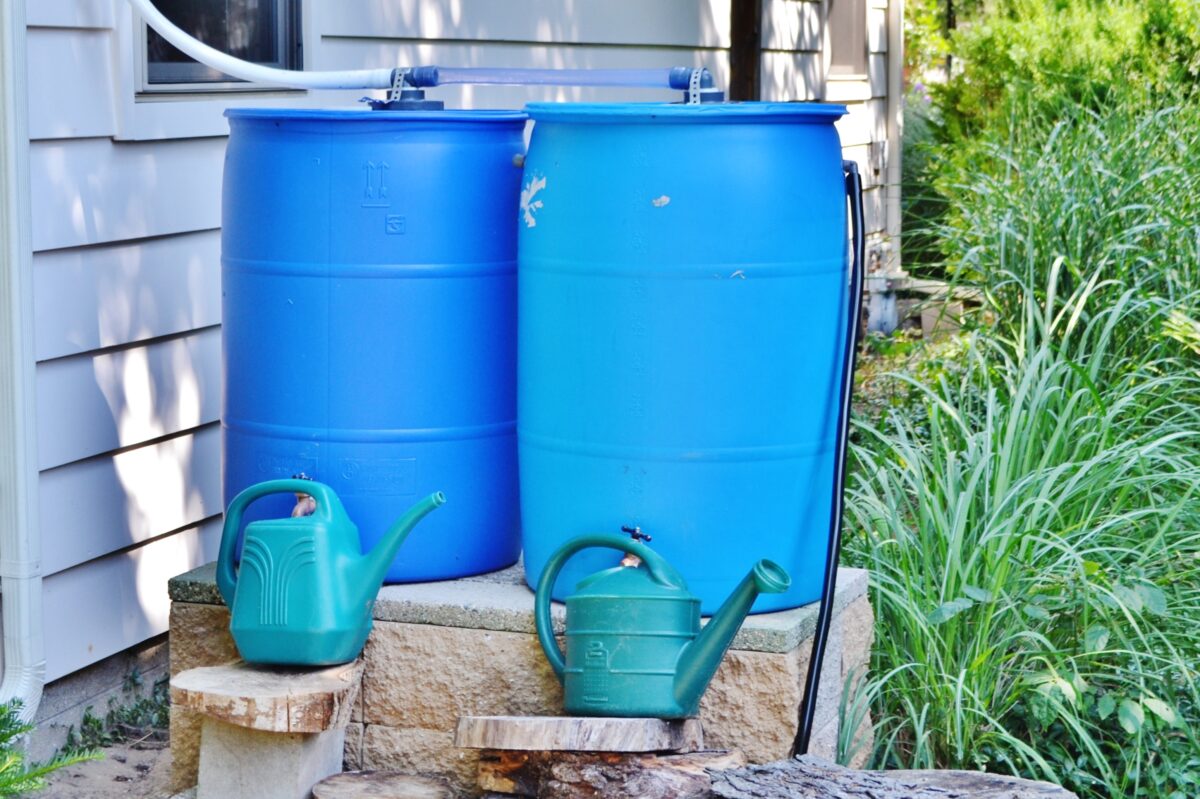
Collecting rainwater is one of the simplest and most sustainable methods of watering your cannabis plants. By setting up rain barrels or other water collection systems, you can capture and store water during wet periods for use during dry spells. This method is particularly useful in areas that receive intermittent rainfall but may suffer from periods of drought. In addition, rainwater is free from the chemicals typically found in tap water, such as chlorine or fluoride, making it an excellent option for cannabis cultivation.
Transporting Water
If you are growing in a remote location without access to natural water sources, you may need to transport water to your site. This can be physically demanding, especially if you’re growing multiple plants. Backpack sprayers or portable water containers can make transporting water easier. If you choose this method, try to visit your grow site early in the morning or late in the evening to avoid drawing attention and to minimize water loss through evaporation.
Rainwater Collection and Irrigation
Rainwater collection can be a game-changer for outdoor cannabis growers, especially in areas that experience seasonal rainfall. Setting up a rainwater harvesting system allows you to store water during rainy periods and use it during dry spells, ensuring a steady supply of water throughout the growing season.
Here’s how you can set up an effective rainwater collection system:
Rain Barrels
One of the simplest ways to collect rainwater is by using rain barrels. These containers are placed under gutters or other surfaces where water runs off during rainstorms. The water is then stored in the barrel for future use. You can add a mesh screen on top to keep debris and insects out of the water, and install a spigot at the bottom to make it easy to access the water.
Gravity-fed Systems
If your grow site is on a slope, you can use a gravity-fed irrigation system to distribute the collected rainwater to your plants. Set your rain barrels or water tanks at a higher elevation than your garden, and run hoses or pipes downhill to deliver the water. Gravity will do the work for you, eliminating the need for pumps or electricity.
Gutter Systems
Consider setting up a series of gutters for larger-scale grows on nearby buildings, greenhouses, or sheds to direct rainwater into storage tanks. These systems can collect large amounts of water in a short time and provide a more consistent water supply during the growing season. Some growers also build rain catchment shelters near their grow sites to funnel rainwater into barrels or tanks.
Drip Irrigation
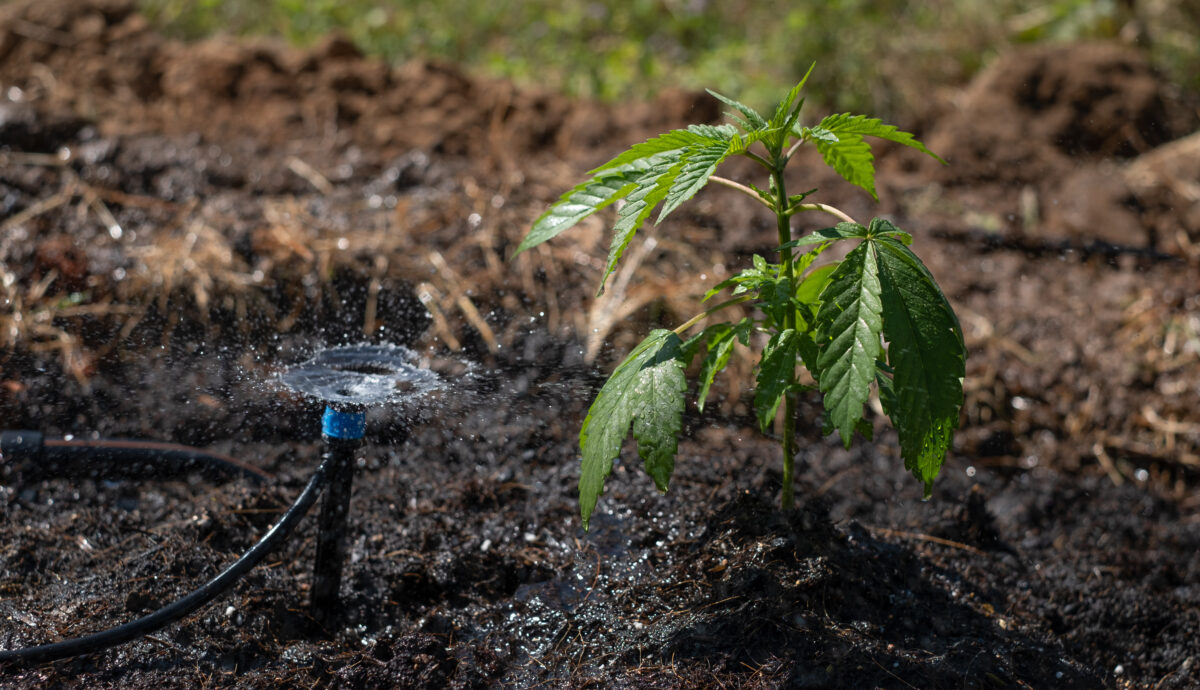
Drip irrigation is one of the most efficient ways to water your plants. It slowly delivers water directly to the roots of your plants, reducing evaporation and waste. Once you’ve collected rainwater, you can use it in your drip irrigation system to ensure your cannabis plants are getting a consistent supply of water. Drip lines or soaker hoses can be placed along rows of plants, delivering water right where it’s needed. This method conserves water and ensures that your plants are not overwatered, which can lead to root rot or nutrient deficiencies.
Conservation Strategies
Conserving water is essential, especially in arid regions or during periods of drought. Here are some strategies to help you maximize water efficiency:
Mulching
One of the simplest ways to reduce water usage is by applying a thick layer of mulch around the base of your plants. Mulch helps retain soil moisture by reducing evaporation. It also helps regulate soil temperature, keeping roots cool during hot periods and warm during cooler nights. Organic mulches, such as straw, wood chips, or leaves, can also break down over time, enriching the soil and providing additional nutrients to your plants.
Watering Schedule
Water your plants early in the morning or late in the evening to minimize water loss due to evaporation. During the hottest part of the day, the sun’s intensity will cause water to evaporate more quickly, leaving less for your plants. Watering during the cooler parts of the day ensures that the water has time to soak into the soil and reach the plant roots.
Deep Watering
Instead of shallow, frequent watering, practice deep watering. This method encourages your plants’ roots to grow deeper into the soil, where they can access moisture that’s stored deeper underground. Deep watering also reduces the need for frequent watering and helps your plants become more drought-resistant.
Greywater Systems
In some areas, you may be able to use greywater (recycled water from sinks, showers, or washing machines) to irrigate your cannabis plants. Just be sure that any greywater used is free from harmful chemicals, detergents, or salts that could damage your plants. Greywater can be an excellent supplement to your water supply, especially during dry periods.
Water-storing Crystals or Gels
Consider adding water-storing crystals or gels to your soil mix for regions where water is scarce. These polymers absorb water when the soil is wet and release it slowly as the soil dries out. This can help reduce the watering frequency and ensure your plants can access moisture even in dry conditions.
Guerrilla Growing
Guerrilla growing involves cultivating cannabis in locations away from your own property or in remote areas of your land where people rarely venture. It’s all about discretion—choosing a spot that’s difficult to access or hidden from public view. Many successful guerrilla growers select places that are either too remote or are privately owned but seldom visited.
Security
When you’re growing guerrilla style, security is critical. The goal is to keep your plants out of sight and out of mind. Never create a visible trail leading to your grow site. Instead, use different routes each time you visit, and be careful to cover any evidence of your movements. You can make cutbacks in the trail so that it’s harder to detect from the main path. Avoid parking in obvious locations; find somewhere hidden where your vehicle won’t arouse suspicion. Always have a plausible reason to be in the area—whether it’s hiking, birdwatching, or something else—and carry the necessary items to make your story believable.
When planting, aim to place your cannabis under trees, next to bushes, or anywhere that provides natural cover. Avoid planting too many in one spot; a few scattered plants are much less likely to draw attention.
Additionally, you can train or top the plants to reduce their classic Christmas tree shape, which can easily give away their identity. Tying the plant tops down to the ground encourages the branches to grow upward, increasing the yield over time, especially if you have a long growing season.
If sunlight is limited by tree cover, your plants can still grow well if the sun reaches them at an angle for several hours each day. Always take precautions to minimize your impact on the area—wear shoes that you can dispose of later, cover your tracks, and leave no obvious signs of human activity.
Water
Water is one of the most important factors in a guerrilla grow, right after security. The amount of cannabis you can cultivate directly depends on how much water is available. If you must pack water in, use a backpack so you don’t draw unwanted attention—people will think you’re just a regular hiker, not a grower. However, the ideal situation is to plant your crop near a water source or in soil with a high water table.
Transporting water to a remote grow site is heavy work, and finding a location near a reliable water source can save you a lot of effort. If your grow site is near high-altitude water, you can get creative by routing the water downhill to your plot. This setup can even provide enough pressure to run a drip irrigation system, allowing for continuous, automatic watering of your plants.
Here’s a simple method: Take a 5-gallon gas can punch small holes in it, and run a hose out of the main opening. Bury the can in a stream or river, weighted down by rocks so it’s hidden and submerged. Then, bury the hose and run it downhill to your grow site. This small investment in time and engineering can save you endless hours of hauling water, and the system can be reused year after year.
Fencing
Protecting your crop from animals is essential. Deer, squirrels, chipmunks, and other critters will gladly munch on your cannabis if left unchecked. A simple yet effective solution is to put up a fence. Green wire mesh or nylon chicken fencing works great and can be discreetly wrapped around trees to create a barrier. Be sure to check and repair the fence regularly during each visit.
For added protection against deer, you can set up a fishing line barrier—one line at 18 inches and another at 3 feet high. This is often enough to keep most deer away. However, no fence will stop rats from getting to your plants. Rat infestations can be particularly challenging, but setting up poison grain in feeders that only small rodents can access can help control the problem. Make sure to set out the poison early in the season, even before planting, as the rats need to consume it over several days before it takes effect. If rats persist, you might find it easier to grow in a backyard greenhouse or shed where you have more control over the environment instead of battling with rodents in an outdoor plot.
Harvesting
When the time finally comes to harvest your crop, discretion is key. The best time to transport your precious buds back home is early morning, preferably before sunrise. This helps you avoid any prying eyes or unwanted attention, ensuring that you can safely enjoy the fruits of your labor.
With the right planning and precautions, guerrilla growing can be a rewarding way to cultivate cannabis in locations where growing at home may not be feasible. Just remember to stay safe, keep your grow hidden, and always be prepared to adapt to the challenges of outdoor cultivation.

